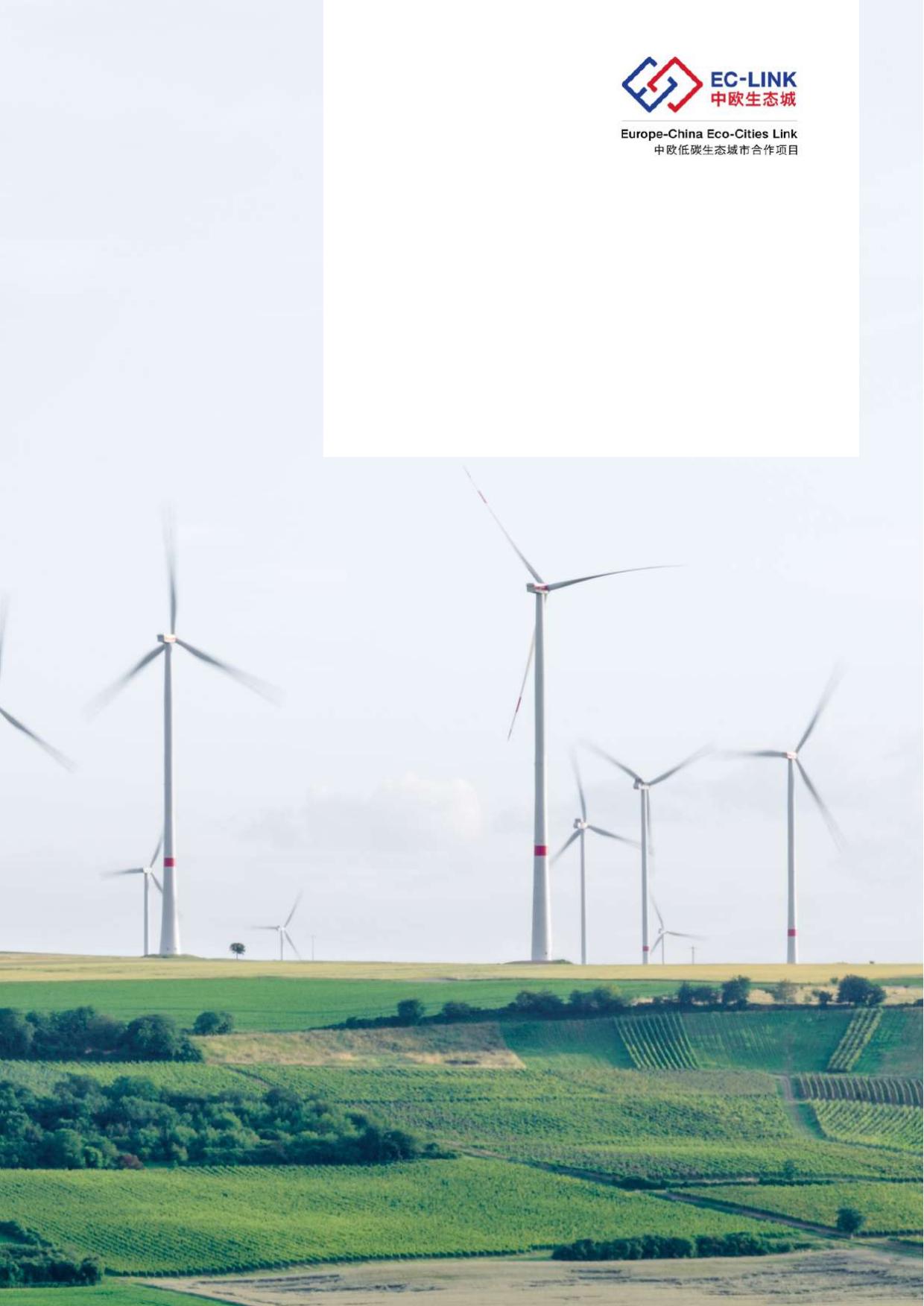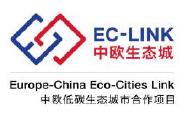清洁能源中欧生态城意见书2018年,1月CleanEnergy–ECLinkWorkingPapers-DraftVersion1.52WhatisEC-Link?Europe-ChinaEcocitieslinkproject(EC-LINK,)isaEuropeanUnionfoundedproject,akeyelementoftheEU-ChinaPartnershiponSustainableUrbanisation,whichwassignedbytheEuropeanCommissionandtheChinesegovernmentinMay2012.ItaimstoassistChinesecitiesinimplementingenergyandresource-efficientmeasuresbysharingEuropeancities’experiencesinsustainableurbanisation.Meanwhile,EC-LinkhascreatedaplatformofexperienceforeasyaccessibleexchangebetweenChineseandEuropeancitiesonlowcarbon/ecocitydevelopmentissues.EnhancingcommunicationandprovidingtrainingtoChineserelatedorganizationsandits’staffonpolicymaking,givingtechnicaladvicesonspecificsustainableurbandevelopmentprojectswillcontributealottoChinasustainableurbanization.EC-LinkhasproducedEcocitytoolboxes,aKnowledgeplatformandisorganisingcity-to-citycooperationintheframeofCityNetworkUnits’activities(CNUs).CNUsactivitiesarefocussedonpilotactionsimplementationbasedonthejointworkofChineseandEUexpertsforacommonobjective,chosenintheframeofsustainableurbanisationissues.OuraimistoincreaselearningcurvefromEuropeancities’goodexamples&techniques,strategyandmethods.TheseactivitiesenhancedthecommunicationbetweenChinesecitiesandEuropeancities,whichformedasolidbaseforthefurthercooperation.http://eclink.org/en/CleanEnergyEC-LinkPositionPaper–January2018Authoredby:FlorianSteinbergandLiChunyanCleanEnergy–ECLinkWorkingPapers-DraftVersion1.53PREFACEChina’sCommitmenttoMitigateClimateChangeIn2015,ChinawasoneofthefirstAsiancountries–besidesJapanandSouthKorea–tocomeoutstronglywithacommitmenttocombatclimatechange,andtoadapttoeventualfutureimpacts.Context.Withitspopulationofabout1,300millionpeople,Chinaisoneoftheworld’smajoremittersofgreenhousegases(GHG),andatthesametimeitisalsooneofthemostvulnerablecountriestothenegativeimpactsofclimatechange.Commitment.Inpreparationforthe2015UnitedNationsClimateChangeMeeting(COP21)inParis,thegovernmentofChinahasannouncedthatitsGHGemissionswillpeakin2030.Equally,itiscommittedtoreduceby2030by60-65%theintensityofitscarbonusageinrelationshiptoitsgrossdomesticproduct(GDP),comparedto2005levels.Itwilltakeontheresponsibilitytoincreasesubstantiallyitsforestcover,andwillensurethatby2030some20%ofitsenergyrequirementswillbecoveredbyrenewableenergy.Actions.Thecountry’smeasureswillincludemitigationofitscontributionstoGHGemissions,anditwillintroduceadaptationsmeasurestocopewithnegativeimpactsofclimatechangeinfoodproduction,protectionofitspopulation,andinclimate-proofinfrastructure.ChinaaimsatbidingclimatechangeagreementsundertheCOP21.Theinternationalcommunityseestheproposedmeasuresasambitiousbutachievable.Sinceseveralyears,Chinahasstartedwithlow-carbondevelopment.Todayitisworkingtowardsafull-fledgedprogramofgreendevelopmentofitseconomy.Eco-CitiesandClimateChangeChina’sactivitiestocreateeco-citiesmustbeseenaspartofitscontributionstolow-carbondevelopmentwithaimtomitigateclimatechange.Amongthevarioussupportmechanismswhichexist,tosupportlow-carbondevelopment,theMinistryofHousing,andUrban-RuralDevelopment(MoHURD),isbeingsupportedbytheEuropeanUnion(EU)throughtheEurope-ChinaEco-CitiesLinkProject(ECLink).Background.ThemainobjectiveoftheECLinkprojectistoserveasasupportmechanismtotheMinistryofHousingandUrban-RuralDevelopmenttoimplementitssustainablelow-carbonurbanisationagenda.TheprojectwillsupporttheMinistryin4strategicareas:1)Demonstratebestapproachestoimplementlowcarbonsolutionsbyintroducingappropriateurbanplanningtools.BestpracticelowcarbonplanningwillbeidentifiedinbothEuropeandChinaandmadeavailablenation-widetomunicipalgovernments.Advancedplanningtoolswillbedeployedatthelocallevelwiththesupportoftheproject,withaviewtorefiningproposedlow-carbonplanningmodelsandtoscalingthemupacrossChineseprovinces.CleanEnergy–ECLinkWorkingPapers-DraftVersion1.542)Serveastestinggroundforinnovationsinspecificlow-carbonpolicies(e.g.energyperformancelabellingforbuildings,intelligenttransportsystems,smartcities,GISplanningtools,ecocitylabellingschemes)andtechnologies(inthe9sectorsselectedbytheproject:compacturbandevelopment,cleanenergy,greenbuildings,greentransportation,watermanagement,solidwastetreatment,urbanrenewalandrevitalization,municipalfinancing,greenindustries).3)ImproveChineseMunicipalities'potentialtofinancelowcarbonsolutionsandnotablytheirabilitytoattractprivatesectorfinancingintheformofpublicprivatepartnerships.TheECLinkwillsupportMoHURDtodefineinnovativefinancialschemes,supportfeasibilitystudiesandtheformulationoffinanceandinvestmentproposals,bettercoordinateandleverageinvestmentsundertakenbyEUMemberStates,ortolinkprojectstoEuropeanfinancinginstitutions(e.g.EuropeanInvestmentBank)andtoEuropeancompanies.4)Establishknowledgenetworksandtestthefunctionalityofthesupportmechanismbyleveraging,scalingup,andintegratingtransformativeactionssupportedbythepolicyandtechnologytoolsdevelopedundertheproject.TheKnowledgePlatformwilldemonstratehowstrategicobjectiveshavebeentranslatedatlocallevelandhowresultshavebeenintegratedatnationallevelforthedefinitionoflong-termbestpractices.Resultswillbesharedviatrainingandcapacitybuildingatlocallevel,andviatheknowledgeplatformset-upbytheprojectatnationalandinternationallevel.TheECLinkPositionPapers.MoHURDandtheECLinkTechnicalAssistanceTeam(TAT)haveidentified9specificsectorsforthedeploymentoftechnologybasedtoolboxes.Inallofthese,EuropehasalotofknowledgeandbestpracticetocontributetosupportthedeploymentofthesesolutionsinChina.These9sectorsinclude:•compacturbandevelopment,•cleanenergy,•greenbuildings,•greentransportation,•watermanagement,•solidwastetreatment,•urbanrenewalandrevitalization,•municipalfinancing,•greenindustries.MoHURD’sDepartmentofScienceandTechnology,ECLink’sdirectcounterpart,hasissuedtargetedobjectivesforthedeploymentofpolicy,researchanddevelopmentandengineeringagendas.UsersandTargetGroupsofPositionPapers.TheECLinkPositionPaperswillbeutilizedbypersonnelofthecitieswhicharecoveredbyMoHURD’seco-cityprogramme.Thiscoverstechnicalandmanagerialstaffofthesecities.Additionally,atcentralgovernmentlevel,MoHURDandotherministriesmayalsomakeuseofthesepositionpapersforthepurposeofstafftrainingandbriefing.CleanEnergy–ECLinkWorkingPapers-DraftVersion1.55SincethesepositionpapersarealsogoingtobepublishedintheECLinkwebsite(www.eclink.org),alsothegeneralpublicisinvitedtomakeuseofthesepositionpapers.ContentofPositionPapersSectoroverview:TheEC-Linkpositionpapersprovideanoverviewofeachthematicsector(compacturbandevelopment,cleanenergy,greenbuildings,greentransportation,watermanagement,solidwastetreatment,urbanrenewalandrevitalization,municipalfinancing,greenindustries).Itbeginswithastate-of-the-artreviewofthesector,andpresentssectorchallengesasdevelopmentobjectives.Sectorpolicyanalysis:Aspartofthesectoroverview,theEC-Linkpositionpapersprovidesectorpolicyanalysis,andacomparisonofEUandChinesesectorpolicies.ComparisonofEuropeanandChineseexperiences:Thecomparisonofreal-lifeEUandChineseprojectexperiencesareusedtoillustrateinnovationsandprogressintherespectivesector.BothforEUandChinesecases,thereisanoverviewofgoodpractices,technologiesandproducts,performanceindicators,technicalstandards,verificationmethods,andlessonslearntfrombesteco-citypractices.Tools:Thispositionpapercontainsthreeprimarytools.Throughoutthetextofthispositionpaperthereareflagsprovidedtopointouttheseprimarytools(àToolCE1,àToolCE2,àToolCE3).AttheendofthepositionpaperthereisanAnnexwithshortsummarydescriptionsoftheseprimarytools.TheprimarytoolsforCleanEnergy(CE)are:•àToolCE1:Technologyoptionsfordecentralizednewenergysupply.•àToolCE2:Decentralisedmicro-grids.•àToolCE3:Sustainableenergyactionplans(SEAPs).Itisunderstoodthattheseprimarytools,docontainnumeroussecondarytoolswhichcannotbeelaboratedinthecontextofthispositionpaper.PositionPaper-alivingdocument:Thispositionpaperwillbeupdatedbasedoncity-levelreal-lifeprojectexperiencesintheEC-Linkpilotcities.Possiblemisconceptions:Thesepositionpapersshallnotbemistakenfor‘cookbooks’,or‘howtodo’-manualslikeweknowthemfromothersubjectfields(carrepair,computerservicing,etc.).Urbandevelopmentistoocomplexforsuchanapproach.CleanEnergy–ECLinkWorkingPapers-DraftVersion1.56UponrequestofMoHURDthesepositionpapersareaddressinggoodpracticesandseektoprovidetoolsforcomplexissuesofgreenurbandevelopment.DISCLAIMERTheillustrationofECLinkPositionPaperswasonlypossiblethroughtheuseofawiderangeofpublishedmaterials,mostoftheseavailableonline.Thepositionpapers’authorshaveutilizedillustrationswhichoriginatefrominternetsources,andthesearereproducedherewithpropercitationandreference.Theuseofthesematerialsissolelyforthepurposeofknowledgesharing,withoutanycommercialuseorintentions.CleanEnergy–ECLinkWorkingPapers-DraftVersion1.57CONTENTSAbbreviations.............................................................................................................9Listofcases............................................................................................................10Listofillustrations....................................................................................................11Listoftables............................................................................................................11Glossaryofterms....................................................................................................111.THEMATICBACKGROUND...........................................................................................12ContentandDelineationofthisPositionpaper.......................................................131.1.1Cleanenergytechnologies,sourcesandoptionsintheservicedeliverychain161.1.2Integratedcommunity(thermal)energyconcepts......................................201.1.3Comprehensivemultisectorurbanlow-carbonconcepts...........................21Roleofmunicipalityandotherstakeholders,policyoptionsandfinancing.............261.2.1Stakeholdersandurbancleanenergyprojectorganisation........................261.2.2Institutions,organizationalstructure,processorganizationandparticipationmechanisms............................................................................................................271.2.3Financingofprojectpreparationandimplementationbyprojects..............27CompetenceandPolicyOptions.............................................................................281.3.1Policymechanisms.....................................................................................281.3.2Policyobjectives.........................................................................................28Spatialandtemporalresolutionofurbanenergyconcepts.....................................30Informationanddecisionsupport............................................................................301.5.1Analysis,forecastsandmodeling...............................................................301.5.2ModelingToolsandSoftware.....................................................................322.DEVELOPMENTOBJECTIVES......................................................................................343.KEYISSUES---KEYCONCEPTS.................................................................................374.PERSPECTIVESFROMEUROPE.................................................................................38SectorContextandPolicyAnalysis........................................................................384.1.1Importanceofcleanenergytechnologies...................................................384.1.2Frameworkconditions:REtargetsandobligations....................................404.1.3Otherframeworkconditionsandtrends......................................................454.1.4Europeanurbanenergyprogramsandassociations..................................46Goodpractices........................................................................................................494.2.1Citywidecomprehensiveconcepts.............................................................584.2.2Integratedcommunityenergyconcepts(districtandneighbourhoodrehabilitationandgreenfieldprojects).....................................................................734.2.3Specialcleanenergytechnologyapplications............................................87CleanEnergy–ECLinkWorkingPapers-DraftVersion1.58Technologies,ProductsandStandards,.................................................................93Indicators...............................................................................................................104PlanningModelsandModelingToolsandSoftware.............................................108EvaluationMethodology........................................................................................112LessonsLearntfrompilotprojects........................................................................113Outlook..................................................................................................................1165.PERSPECTIVESFROMCHINA...................................................................................117SectorContextandPolicyAnalysis......................................................................120Objectives,Programs,InstitutionsandSectorOrganization.................................130Examplesofinterventions.....................................................................................135GoodPractices-Illustrations................................................................................148TechnologiesandProducts,Standards................................................................149Indicators...............................................................................................................150EvaluationMethodology........................................................................................151LessonsLearntfrompilotprojects........................................................................153Outlook..................................................................................................................1576.VALUEADDEDandCROSSCUTTINGTHEMES.......................................................1637.AVAILABLERESOURCESANDTOOLS....................................................................1648.RECOMMENDEDREADING........................................................................................167ANNEXES...........................................................................................................................168Annex1:ToolCE1-Technologyoptionsfordecentralizednewenergysupply..168Annex2:ToolCE2-Decentralisedmicro-grids...................................................170Annex3:ToolCE3-Sustainableenergyactionplans(SEAPs)..........................174CleanEnergy–ECLinkWorkingPapers-DraftVersion1.59AbbreviationsBIPVbuildingintegratedphotovoltaicCASChineseAcademyofSciencesCCHPCombinedCooling,HeatandPowercCRcarbonnClimateRegistryCCSCarbonCaptureandStorageCBDCChinaDevelopmentBankCapitalCHPcombinedheatandpowerCNRECChinaNationalRenewableEnergyCentreCOP21UnitedNationsClimateChangeMeetingCSUSChineseSocietyforUrbanStudiesDEMaPDecentralisedEnergyMasterPlanningECLinkEurope-ChinaEco-CitiesLinkProjectEEAEuropeanEnvironmentAgencyEIBEuropeanInvestmentBankELENAEuropeanLocalEnergyAssistanceEPCEnergyPerformanceCertificateEUEuropeanUnionEUETSEUEmissionsTradingSystemGDPgrossdomesticproductGEFGlobalEnvironmentFundGFECgrossfinalenergyconsumptionGHGgreenhousegasesHDDheatingdegreedaysHRBEEHeatReformandBuildingEnergyEfficiencyIEEInstituteofElectricalEngineeringINDCIntendedNationallyDeterminedContributionsIPCCIntergovernmentalPanelonClimateChangeISEPInstituteforSustainableEnergyPoliciesKPIsKeyPerformanceIndicatorsLDALondonDevelopmentAgencyLIPLocalInvestmentProgramLCOELevelizedUnitCostsofElectricityMEPMinistryofEnvironmentalProtectionMoHURDMinistryofHousing,andUrban-RuralDevelopmentPVPhotovoltaicSEAPsSustainableEnergyActionPlansCleanEnergy–ECLinkWorkingPapers-DraftVersion1.510ListofcasesCase1Denmark:ThreelessonsforcitiesinDenmark’sclean-energyrevolution................50Case2Germany:GermanyOverhaulsitsFlagshipEnergyPolicy.......................................54Case3Stockholm,Sweden:EnergyConceptofStockholm................................................58Case4Växjö,Sweden:FossilFreeVäxjö............................................................................60Case5Aarhus,Denmark:theClimatePlant.......................................................................61Case6London,UnitedKingdom:DecentralisedEnergyMasterPlanning(DEMaP)Program..................................................................................................................63Case7Woking,UnitedKingdom:RenewableEnergyatCityLevel....................................65Case8Tilburg,theNetherlands:Multi-SectorNetwork.......................................................65Case9Freiburg,Germany:“ClimateChangeActionScenario”until2030..........................66Case10Nantes,France:ClimatePlan................................................................................68Case11Barcelona,Spain:Energy,ClimateChangeandAirQualityPlan(PECQ2011-2020).............................................................................................................69Case12Almada,Portugal...................................................................................................72Case13Helsinki,Finland:Eco-efficientrenewalandrevitalizationofPeltosaarineighbourhood.......................................................................................................73Case14MalmöSweden:WesternHarbour(VästraHamnen)Revitalisation.......................75Case15Scotland:SetsWindRecord,ProvidesEnoughElectricityfor3.3MillionHomes....................................................................................................................76Case16Aarhus,Denmark:Low-EnergyNeighborhoodProjectinLystrup..........................77Case17StadvandeZon,theNetherlands:NewDistrictofHeerhugowaard.....................78Case18BerlinGermany:ScienceandCommercialParkAdlershof2020+........................79Case19Hamburg,Germany:IntegratedEnergyNetworkWilhelmsburgMitte(ofCitiesandClimateChangeProgramme)..........................................................................79Case20Grenoble,France:RevitalizationofUnutilizedMilitaryBaracks“ZACdeBonne”..................................................................................................................81Case21Toulouse,France:GreenfieldDevelopment,ZACAndromède..............................83Case22Salzburg,Austria:RevitalizationandHeatSupplyofLehenDistrict......................85Case23Linz,Austria:SolarCityPichling............................................................................86Case24Wieringmeer,TheNetherlands:Windpower..........................................................87Case25Leicester,UnitedKingdom:Reductioninenergyusageofmunicipalbuildings.....88Case26MannheimGermany:e-energymodelcityMOMA..................................................89Case27Heidelberg,Germany:OldGasometertobeTransformedintoCentreforRenewableEnergy.................................................................................................89Case28Lille,France:Busespoweredbybiogasofthemunicipalwastewater...................90Case29Bristol,UnitedKingdom:Busesrunningonbiomethanegas..................................91Case30Tianjin:anEmergingEco-City.............................................................................135Case31Anshan,LiaoningProvince:Restructuringdistrictheatingwithheatrecovery.....135Case32MinhangDistrict,Shanghai:AntingNewTownwithinnovativeenergyandwastemanagement..............................................................................................137Case33Hohhot,InnerMongolia:variousinitiatives...........................................................138Case34Dunhuang,GansuProvince:solarpower.............................................................139Case35Datong,ShanxiProvince:Solar-PV,drivenbymanufacturerinacoalminingcity........................................................................................................................140Case36Huainan,AnhuiProvince:Theworld’slargestfloatingsolarpowerplantwentonline....................................................................................................................140Case37Hami,XinjiangAutonomousRegion:Changingenergymix.................................141Case38Rizhao,ShandongProvince:SolarheatandPVUtilization.................................142Case39Dezhou,ShandongProvince:SolarCity..............................................................143Case40Rongcheng,ShandongProvince:Windenergycity.............................................143Case41Wuxi,JiangsuProvince:China´sFirstZeroEnergyBuilding...............................145CleanEnergy–ECLinkWorkingPapers-DraftVersion1.511Case42ShanxiProvince:SpecialCompensationFundforEliminatingInefficientCapacity................................................................................................................145Case43Shanghai:Aninnovativegreenpricingmechanisms-theShanghaiGreenElectricityScheme................................................................................................146Case44:Shenzhen:World’sLargestWastetoEnergyPowerPlant.................................146ListofillustrationsFigure1:Deliverychainforthermalcomfortserviceforthecaseofdistrictheating.............15Figure2:ConceptualOverview:Sectorsofurbanenergy....................................................22Figure4:ConceptualOverview:SectorsofUrbanEnergy...................................................40Figure5:Self-RegulatingEnergysystems..........................................................................111Figure6:EnergySectorInvestmentDemandEstimateinthe13thFiveYearPlan(2016-2020)..........................................................................................................125ListoftablesTable1:RelationshipbetweenSmartandGreenGuidelines.............................................127Table2:China’sRenewableEnergyTargetsOverview......................................................130Table3:EnergySector:KeyPerformanceIndicatorsforTianjinEcoCity..........................150Table4:AdditionalQuantitativeObjectivesofSSTEC´sEnergySectorPlan....................151Table5:ProposedCleanEnergyKPIs..............................................................................152GlossaryoftermsCarbonemissionsEmissionsofCO2=greenhousegas(GHG).CleanenergyEnergygeneratedfromcleansources(hydro,wind,sea,earthheat,solar,bIogas,methanegas,photo-voltaic,etc.).Districtheating(andcooling)Neighbourhoodbasedheating(and/orcooling)stationswhicharemoreenergyefficientthandecentralizedsystems.Energy-efficiencyEnergy-efficiencydescribesthedifferenceinperformanceofconventionalcarbon-basedsystemsandnewenergytechnologies(hydro,wind,sea,earthheat,solar,etc.).CleanEnergy–ECLinkWorkingPapers-DraftVersion1.5121.THEMATICBACKGROUNDCarbonemissions.Themajorportion(81%in2011)ofthecarbonemissionsinEuropeisrelatedtoenergyuseinresidentialbuildings,transport,industryandothersectorsandtoenergytransformation,whileinChinathatproportionwas80%in2011.1InChina,thegenerationofelectricityandheatemittedapproximately40%ofallcarbonwhileinEuropeitwas33%.InChina,industrieshavebeenresponsiblefor23%ofallemissions.TheCOP21Image:AFPSource:Gray,A.2016.5ChartsthatexplaintheParisClimateAgreement.WorldEconomicForum4November.https://www.weforum.org/agenda/2016/11/5-charts-that-explain-the-paris-climate-agreement/1AccordingtoWorldResourcesInstitutetheGHGemissions2011(latestavailableoverallnumbersallinMtCO2equivalent)forEU28were3688forenergy(includingenergysectorandenergyuse)of4541(total)andforChina8392of10552(energyrelated);http://cait.wri.org/CleanEnergy–ECLinkWorkingPapers-DraftVersion1.513InEurope,transportandresidentialenergyuseemissionsaremuchmoreimportant.ThetrendsinChinashowthatcarbonimpactofindividualtransportandhigherlivingcomfortareincreasing,asdotherespectiveenergyuseemissionshares.Citiesandcarbonemissions.Energyuseandrelatedcarbonemissionsareconcentratedincities.InChina,citiesconcentrateenergyusesandcarbonemissionsevenmorethanpopulation.2Thatmakesurbanenergyaprincipleconcerninlow-carbonstrategies,inparticularforChina’scities,andgivesenergyanoutstandingpositioninthesustainablelow-carbonagendaofMoHURD.Chinesecitiesarecarbon-intensive.Onedrivingfactorforhigherenergyuseandcarbonemissionsincitiesistheactivitylevel,i.e.thehigherdegreeofagglomerationofproductiveandconsumptiveactivitiesincitiescomparedtoruralareas.Anotherfactoristhelocationofpowergenerationandenergyintensiveindustrialproductionwithincities,whichisparticularlyfrequentinChina.Thisraisestherelativecarbonemission(measuredpercapita)intensityofChinesecitiescomparedtosimilarsizedcitiesinothercountries,3wherelargepowerstationsandbasicindustriesareonlyexceptionallysituatedwithinmajorcities.Butalsobuildingandtransportenergyuse,andrelatedcarbonemissionsinlargeChinesecitiesarealreadyonasimilarlevelpercapitacomparedtocitiestoEuropeinsimilarclimaticzones.ContentandDelineationofthisPositionPaperUrbancarbonemissions.Inthecarbonstatistics,4theenergyemissionsareaccountedwheretheCO2andothergreen-housegas(GHG)emissionsactuallytakeplacewhenenergyistransformed.Thus,apartfromtheenergysupplyingindustries,alsotheenergytransformationGHGemissionsoftheenergyusesectorsareclassifiedundertheenergycategory,specifying(i)manufacturingandconstruction,(ii)transportation,and(iii)otherfuelcombustionincludingresidential,commercial,publicandothersmallsectors,5mainlyinbuildings.Towardslow-carbonurbandevelopment.Withrespecttolow-carbonurbandevelopment,manufacturing,construction,transportation,andbuildingsmeritattentionnotonlyassourceofGHGemissionsfromfossilfuelcombustionbutalsoasauserofsecondaryenergysuchaselectricity,heatandcold,whichareproducedon-siteorbytheenergysupplysectormoreorlesscarbonintensively.6Scopeofcleanenergy.Cleanenergycoversawidescopeincludingtheenergyuseaswellastheenergysupplysectorsaccordingtothepervasivenessofenergyandtheenergy-relatedGHGemissions.Thisisnecessarytocapturethecomprehensivenatureofurbanlow-carbon2“The35largestcitiesinChina,whichcontain18%ofthepopulation,contribute40%ofChina'senergyusesandCO2emissions”,S.Dhakal,UrbanenergyuseandcarbonemissionsfromcitiesinChinaandpolicyimplications,in:EnergyPolicy,Volume37,Issue11,November2009,Pages4208–4219,3IndustryandPowerDominateCO2EmissionsperCapitainChineseCities,accordingtoWangX.etal,Low-CarbonCitiesinChina:Characteristics,Roadmap,andIndicators,in:Baeumler,A.,Ijjasz-Vasquez,E.,Mehndiratte,S.(Eds.).2012.SustainableLow-CarbonCityDevelopmentinChina,DirectionsinDevelopment–CountriesandRegions.WorldBankWashingtonDC2012.4TheIPCCCommonReportingFrameworkusedbytheUNFCCCsubsumesunderEnergy(Category1)allenergytransformationemissionsfrom5subsectors(Category1A),i.e.EnergyIndustries,Manufacturing&Construction,Transportation,OtherSectors(CO2emissions)andEnergy-other(CH4,N2O)aswellasFugitiveEmissions(Category1B,fromgasventing&flaring,pipelines,etc.)seeIPCC.1996.IPCCGuidelinesforNationalGreenhouseGasInventories.UnderstandingtheCommonReportingFramework.Availableathttp://www.ipcc-nggip.iges.or.jp/public/gl/guidelin/ch1ri.pdf5Intheenergystatistics,theoveralltermforthesesectorsisGrossFinalEnergyConsumption.Theenergytransformationintheenergy(supply)industryisreportedinthetransformationpartoftheenergystatistics.6Therefore,thesethreesectorsaregivenparticularattentionin(other)ECLinkpositionpapers:GreenTransportation,GreenBuildings,andGreenIndustries.InadditionspecificpositionpapersarealsoavailableforwatermanagementandsoldwastemanagementwhichisanimportantuserofenergyandalsoholdsspecificoptionsforcleanenergytechnologiesforreducingGHGemissionsuchasland-fillgas.CleanEnergy–ECLinkWorkingPapers-DraftVersion1.514concepts,whichfollowtheenergyflowsandincludetheenergyusesectors.Inaddition,cleanerenergytechnologiesareincreasinglyappliedonsite.Consideringtheenergyinterrelationships,citieshavedevelopedcomprehensivelow-carbondevelopmentconcepts,coveringallsectorswhichentailGHGemissions.Insuchacomprehensiveapproach,citiespulltogetheralleffortsrelatedtoreduceGHGemissionsinaconcertedandrationalway.Overlapwithotherpositionpapers.Toavoidduplication,thispositionpaperdefersfordetailstothegreentransportation,buildings,industrial,waterandwastemanagementpositionpapers,whichdelvedeeperintothespecificaspectsandtherespectivelow-carbonmeasures.Complexityoflow-carbondevelopment.Low-carbonoptionsmaybesomeofthelow-carbonurbanenergysolutions,e.g.districtsystemsforthermalcomfortandotherthermalservices,arecomplexandconsistsofseveralsuccessiveandinterrelatedelements(seeFigurebelow).Adistrictthermalsystemalsoinvolvesnumeroususerswithinreachofthegrid.Toconceivesuchsystemsinwhicheconomiesofcoalitionoperate,anintegratedcommunityenergyconceptisrequired.Suchintegratedcommunityconceptsforthermalenergyencompassmanybuildingsandotherusersaswellasvarioussources,andprovidestheinformationformakingrationaluseofthemultitudeofcleanenergyoptions.Cleanoptionsincludeefficientbuildings,decentralizedgenerationandstorage,districtgridandheatsources,foreachofwhichtherearetechnicalalternativeswithdifferenteconomic,financialandenvironmentalimplications.Tobeabletoidentifypreferableoptionsforthelow-carbonagenda,manycitieshavetakenanintegratedperspectiveanddevelopedaverydetailedviewandmodelofthethermalenergysystem,whendistrictsorurbanareasarerehabilitatedornewurbandevelopmentsareplanned.CleanEnergy–ECLinkWorkingPapers-DraftVersion1.515Figure1:DeliverychainforthermalcomfortserviceforthecaseofdistrictheatingSource:ChevronNote:bluearrowindicatesthestepswherecleanenergytechnologiesareapplied;redillustratesthestepsofbuildingtechnologies.Energyefficiencyprinciplesapplyalongthewholechain.Therecentriseofdecentralizedgenerationandminigridsforelectricityisanotherexampleofthegrowingcomplexityandcompetingsolutionsinurbanenergy(decentralizedandcentralized)whicharebetterunderstoodandchosenonthebasisofcommunityconcepts.FocusofPositionPaper.Thispositionpaperobviouslyalsoneedstoaddressindividualcleanenergytechnologyandsources.Itregards,however,theenergytechnologyorsourcealwaysaspartofadeliverychainforaservice,beitthermalcomfort,foodpreparation,transport,processingofaproductorotherservicesforwhichenergyisrequired.Summingup,thispositionpaperaddressesthreelevelsoflow-carboncleanenergyconceptsforcities:•comprehensivemulti-sectorurbanenergy/low-carbonconcepts;•integratedcommunityenergyconcepts;and•cleanenergytechnologiesandsources.Belowexplanationsoftheseconceptsstartsfromthedetailedlevelofindividualtechnologiesandmovesfromupwardstocityleveltechnologiesandapproaches.Centraltransfor-mation•Poly-generation(combinedheatandpower(CHP)stations,orcombinedheatcoldandpower[CCHP]),heatpumps,solarthermal,geothermal,wasteheatthermalstorageehergydelivery•Districtthermalgrid(steam,hotwater,lowtemperature)•GasgridandelectricitygridConversionn/exchange•Thermalconversion(boiler,microCHP)orexchanger(deliveredheat,heatpump,solarthermal)andstorageThermalDistribution•Hotwater(radiators,floor,ceiling)orairtemperatureBuilding•OrientationandEnvelope(includingpassivesolar)Service•Thermalcomfort(tobeprovidedwhereandwhenneeded)CleanEnergy–ECLinkWorkingPapers-DraftVersion1.516Cleanenergytechnologies,sourcesandoptionsintheservicedeliverychainDefinition.Thereisanofficialgloballyaccepteddefinitionofcleanenergy.Intheframeworkoftheurbansustainablelow-carbonagenda,“clean”isunderstoodas“low-carbon”.Carbonemissionsarealsoagoodindicatorforotherairemissions,andthereforelow-carbonalsocorrespondstolowairemissionsingeneral.Cleanenergy.Againstthisbackground,cleanenergyisthelow-carbonsubsetoftheenergytechnologiesandsources.Ofthemanyindividualtechnologiesandcombinationswhichareemployedtodeliverenergyservicesweconsiderthoseascleanenergy,whicharecharacterisedbylow-carbonemissionsoverthewholedeliverychain.Thisdeliverychaincanbeverylongandinvolveallthestepsfromprimaryproductionandtransport,centraltransformation,transmissionanddistributiontotheenduser,orshortandinvolveonlyadecentralisedprovisionoftherespectiveenergyserviceusingambientsources,orinterimsolutions.Terminologyoflow-carbon.Low-carbonisarelativeterm.Therefore,weconsiderascleanenergyinadditiontozerocarbontechnologiesalsothosewhichreducesignificantlytheoverallGHGemissionscomparedtothealternativeof¨BusinessasUsual¨(BAU).Ifforinstancethealternativeofacombinedheatandpower(CHP)station,firedbybiomass,iselectricityfromacoalfiredpowerstationanddecentralisedfossil-basedheatgeneration,thisCHPisconsideredlow-carbon,i.e.cleanenergy.Cleanenergytechnologies.Inpracticalterms,weconsiderascleanenergyallthosetechnologieswhichreducefossilfuel,combustionandGHGemissions7,makinguseof•renewableenergysources,includinghydro,solar,wind,geothermalandbioenergywithexceptionofbioenergywhichinducesasmuchcarbonemissionsinthedeliverychainasthemainalternativefuel;butalso•passivesolarenergy;•ambientenergy,inparticularwithheatpumps;•land-fillandsewagegases;•solidwaste(providedthecombustioncompliestolowemissionstandards);and•wasteheat.àToolCE1Wealsoincludepoly-generationtechnologies(combinedheatandpower[CHP]andcombinedheatcoldandpower[CCHP]),evenwhenfiredbyafossilfuelwithspecificcarbonemissionscoefficientsonthelowersidesuchasnaturalgas,providedthatitreplacespowerandthermalenergyfromhighemittingplants,andprovidedtheoverallcarbonreductionisclearlypositive.Poly-generationplantswillbecomecomplementarycornerstonesforenergysystemswithhighrenewableenergyshares.Thus,districtthermal(heatingand/orcooling)systemsarepartofthecleanenergytechnologies;providedtheyaretheyarefedfromcleanenergytechnologies.Energyefficiency.Energyefficiencyisanothercategorywhichfulfilsthecriteria,reducingcarbonemission,thatcanbeconsideredcleanenergytechnology.Energyefficiencyreducesenergyinputinrelationtotherespectiveoutput.Energyefficiencyisratheraprinciplethanasetofspecifictechnologiesandcanbeappliedinallstages,technologiesandprocessesoftheenergyuseandsupplychainwhichcanbedemonstratedalsoalongthelinks.Reducingcarbonemissionsactuallybeginswithfittingprovisionofanenergyserviceexactlytorequirement,providethermalcomfortwhereandwhenneeded,andavoidsquanderingofheat.Intransportationavoidtravelwhenpossible,possiblysubstituteitbycommunication.7SometimesCarbonCaptureandStorage(CCS)isincludedundercleanenergy,althoughthecarboncapturedisstoredandleakageisarisk.Inanycase,theCCSdevelopmenthoweverisstalledanditisbasicallyatechnologyrelatedtolargepowerstationsorenergyproduction.Thisisnotthefocusofthispositionpaper.Forsimilarreasons,nuclearenergyisnotincludedincleanenergy.CleanEnergy–ECLinkWorkingPapers-DraftVersion1.517Insomeenergyusesectors,itispossibletoapplydifferentmodesfortheservicewhichinvolvesverydifferentenergyintensities.Intransportation,shiftingofmodesfromindividualtomasstransportoreventobikingareverywellestablishedwaysofreducingfossilenergyconsumptionandrelatedemissions.Inthermalservicesofbuildings,thechoiceofbuildingtypesanddensity(urbanmorphology)canalsobeconsideredasamodalshift.Thenextareawithmanyoptionsforreducingfinalenergyconsumptionisthesectorspecifictechnologywhichisincorporatedinbuildings(orientation,compactnessandenvelope),appliances,vehicles,industrialequipmentandprocesses.Inotherwords,energyefficiencyisanimportantfeatureofbuildingtechnology,transportationtechnology,industrialprocesstechnologyandothertechnologieswhicharenotgenuineenergytechnologies.8Transformationsinenergyneeds.In-situenergytransformationtechnologyneedstobeconceptionallydistinguishedalso.Forexampleforthermalcomfort,theoptionsincludeaheatexchanger,aboiler,aheatpump,asolarwaterheater,micro-CHPorothertechnology.Incaseoftransportationtheoptionsincludedifferentengineswhichforelectricvehiclesinvolvechargingstationsandbatteries.Incaseofindustrialprocessheatlargerboilersandcogenerationplantsarethemainchoices.Inthesenseoflow-carbon,allthisenergytransformationtechnologyshouldbecomemoreefficient,orusenonfossilenergy.Energysupply.Nextelementupstreamistheenergysupplynetwork,incaseofthermal,gasandelectricityactuallyinformofgridsconsistingofpipesandlines.Intermsoflow-carbon,theimperativeistoreduceenergylosses.Thethermalorelectricalenergylostinthegridswouldneedtobeproduced,additionallycausingrespectiveadditionalCO2andairemissions.Incaseofnaturalgaslossesmeanareleaseintotheatmosphereofmethanewithhighglobalwarmingpotential(GWP).Energygeneration.Thenextupstreamstep,thegenerationofthermalenergyandelectricity,istheeffectivestepinthechainintermsofalow-carbonstrategy.Poly-generationisanefficienttechnology,andlow-carbonifcomparedtoseparatefossilfuelledgenerationofheatandpower.Herethechoiceoffuelisanotherkeymeasuretoreducecarbonemission,withnaturalgasemittingapproximatelylessthanhalfCO2perunitenergygeneratedthancoal.Incaseofbiomassthelifecycleoftherespectivefuelmustbeconsideredforclassifyingitlow-carbon.Recently,localgridshavebecomelessunidirectional.Incaseofthermalgrids,low-carbonsourceshavebeenaddedatdifferentpointsandcausedmultidirectionalflows.Thisistrueforboth,thermalandelectricitygridsandhasallowedtoincorporatecleanenergytechnologiesatthegridlevel.Incaseofthermalgrids,solarwaterheaters,heatpumps,shallowgeothermalsourcesmaycontribute,andinparticularwasteheatfromindustryorsurplusfromcommercialusersandbuildings.Incaseofelectricity,distributedgenerationsituatedattheconsumerplantfeedsintothegrid.Insomecaseslocalmicro-gridsareestablishedbelowthelevelofthecustomarylowvoltagedistributionlevel.Poly-generationplantsaresituatedwithinornearcityboundariestoreducecapitalintensivepipelineinvestmentandenergylosses,whereaspowerplantswithoutextractionofthermalenergyareonlyoccasionallylocatedwithincities.àToolCE1Renewableenergy.However,inadditiontothetraditionalhydropower,otherrenewableenergytechnologiesonutilityscaleincludingwindandsolarhavebecomeavailablealsoforenergygenerationtobefedintothemediumvoltageandevenhighvoltagelevels,and8End-useenergyefficiencywhichisachievedbybuilding,transport,orindustrialtechnologyisratheraddressedinthepositionpapersofthosesectors,althoughthedelineationisnotalwaysstrictandoverlapisacceptable.CleanEnergy–ECLinkWorkingPapers-DraftVersion1.518replacingfossil-generatedelectricity,atincreasinglycompetitiveconditions.Worldwide,oneisobservingarapiddeclineofthecostofrenewableenergycosts.9SolarCostHitsWorld'sNewLow,HalfthePriceofCoal“Chileawardedacontracttosellsolarpowerfor$29.10permegawatthour(MWh),thelowesteveracrosstheplanet.ThissurpassestherecordsetinMayofa$29.90perMWhbidinDubaiforan800megawatt(MW)solarproject.‘Thisisthelowestpriceeverseen,foranyrenewabletechnology,’ananalysttoldBloomberg.Thelowpriceispossibleduetotherapidfallincostofsolartechnologyandthe12MWsolarplant'slocationintheidealconditionsofChile'sAtacamaDesert.”ACERASource:ClimateNexus,22August2016.http://www.ecowatch.com/solar-price-chile-1982242311.html;seealso:Parkinson,G.2016.Solarpricehitsrecordlowof2.42c/kWh,andmayfallfurther.Theneweconomy.20September.http://reneweconomy.com.au/2016/solar-price-hits-record-low-of-2-42ckwh-and-may-fall-further-32358Goingastepfurther,alsoenergystoragetechnologiesmaybeconsideredaspartofcleanenergytechnologies,aboveallsincestoragepermitstobringmorerenewableenergyintothesysteminsteadofdispatchablefossilfuelgeneratedpowerorthermalenergy.10àToolCE19Seealso:AbudheenK.S.2016.ForthecostofaniPhone,youcannowbuyawindturbinethatcanpoweranentirehouseforlifetime.http://educateinspirechange.org/nature/environment/cost-iphone-can-now-buy-wind-turbine-can-power-entire-house-lifetime/10McGrath,M.2016.Renewableenergysurgestorecordlevelsaroundtheworld.1June2016.http://www.bbc.com/news/science-environment-36420750CleanEnergy–ECLinkWorkingPapers-DraftVersion1.519WindEnergy–AnExampleofRenewableEnergyMcGrath,M.2016.Renewableenergysurgestorecordlevelsaroundtheworld.1June2016.http://www.bbc.com/news/science-environment-36420750Availabilityandcosts.Inallthesesectors,energyuseandsupply,theavailabilityandcostofcleanenergytechnologieshasdramaticallyevolvedandfallenrespectivelyinrecentyearsandcontinues.Themostdramaticchangehastakenplaceinpowergeneration,wheresolarpowerfromphotovoltaictechnologyisbecomingcompetitiveandofferstheoptionofconsumersitegeneration,i.e.insideurbanisedareas.Sometimescarboncaptureandstorage(CCS)isalsoincludedundercleanenergy,althoughthecarboncapturedisnotdefinitelyremoved,andleakageisarisk.Inanycase,itisbasicallyatechnologyrelatedtolargepowerstationsorenergyproduction,notforcities.However,thisisnotthefocusofthispositionpaper.Forsimilarreasons,nuclearenergyisnotaddressedinthiscleanenergypositionpaper.CleanEnergy–ECLinkWorkingPapers-DraftVersion1.520Integratedcommunity(thermal)energyconceptsCommunity-levelenergy.Integratedcommunityenergyconceptsareinformation,planninganddecisionsupporttoolsforlocalenergysystems.Thesearepreparedforareasofacity(district,urbanquarter)ortownsattheoccasionofrehabilitationofanexistingquarterorforanewurbanization.Usuallytheseconceptswereestablishedfortheprovisionofthermalenergyserviceswithinadefinedboundaryinordertocapturetheadvantagesofajointconcept,includingtheeconomiesofcoalitionandthereductionofthenumberofstationaryemissionssources,i.e.combustionoffossilfuelsinthebuildings.ModerndistrictheatingsystemssavemoneyandCO2Today,40%oftheenergyconsumedinEuropeisforheating.Allthisenergycanbecomesustainablethroughmoderndistrictheatingsystemscollectingwasteheatfrompowerplantsandindustry,andworkingatlowtemperatureswhichminimisestheheatlossandintegratesmoresourcesofrenewableenergy.…[T]heheatcurrentlybeingwastedinEuropecouldheatallofourbuildingsifitwascollectedinsmartdistrictheatinggrids.…40%ofourenergyusecurrentlyconsistsofheating.Allofthisenergycanbecomesustainablethroughmoderndistrictheatingsystems,whichcollectexcessheatfromcombinedheatandpower(CHP)plantsandindustryandworkatlowtemperatures,whichdecreasestheheatwasteandenablesmorerenewableenergysourcestobeused.“OurresearchshowsthatthereisgreatpotentialforexpandingthedistrictheatinggridinEuropeby30-50%,andthepoliticalwilltomakeithappenisgrowinginoursurroundingcountries,”saysBrianVadMathiesen,ProfessorofEnergyPlanningatAalborgUniversity.Inrecentyears,districtheatinghasgainedsignificantpoliticalfocusine.g.theEU,whichgivesthetechnologyaprominentplaceinitsnewheatingandcoolingstrategy.Districtheatinghasalsobecomeanimportantpartofthe[…]worktoobtainclimateandsustainabilitygoals.Source:ModerndistrictheatingsystemssavemoneyandCO2.StateofGreen.11October2016.https://stateofgreen.com/en/profiles/aau/news/modern-district-heating-systems-save-money-and-co2?utm_source=AddThis+subscriber+list&utm_campaign=ba38965e9d-State+of+Green+Newsletter_newsletter&utm_medium=email&utm_term=0_3997cf0db9-ba38965e9d-273120853Seasonalenergyneeds.Customarilyincitiesinwintercoldregions,householdsorbusinessesusedindividualsolidorliquidfuelfiredboilersorevenstovesforheating.Anenvironmentallypreferablebutcapital-intensiveline-boundsystemsuchasdistrictheatingcouldonlybecomeeconomicallyandfinanciallyfeasiblewithahighloadfactor,thushighdemanddensity,whichinturnrequirestoincludeinthesystemasmanyusersaspossible.Thishasledinmarketeconomiestosomekindofprioritization,incaseswherethejointsupplybydistrictthermalschemelookedeconomicallyfavorable.Frequentlycitieshaveorderedalimitationofchoiceofcompetingsystems,alsocitingcleanairmotives.Suchurbandevelopmentdecisionsneededasystemiccomparisonasadecisionsupporttool,forwhichintegratedurbanthermalenergyconceptsweredeveloped.UsingGIS.Theseintegratedconceptsaremodeledingreatdetailandtheinformationisgeographicallyreferencedingeographicalinformationsystems(GIS).Theyuseindividualbuildings(oreventypifiedusers)asbasicunit,integratingdemandalongstreets,blocks,orquartersaccordingtoinformationneeds.Demandscenariosareelaborated,inparticularforvaryinglevelsofenergyefficiencyinthebuildingsystemandtakingintoaccounttheuserbehavior,andappropriatealternativedeliverychainsaredesignedaccordingly.Thevariousoptionsthenareevaluatedusingecological,economic,financialandalsosocialcriteria,forCleanEnergy–ECLinkWorkingPapers-DraftVersion1.521informationanddecisionmaking,dependingonthecompetenceandparticipationofthestakeholders.Schematically,suchcommunitythermalenergyconceptsincludeamultitudeofdeliverychainspresentedintheFigurebelow.Theseareinterconnectedbygridsupstreamandbeingfedbyoneorseveralsources(seegoodpracticesfromEurope).Integratedcommunityconcepts.Integratedcommunityconceptsaredesignedforlong-termimplementation.Theirtimehorizonofplanning,therefore,correspondstoadevelopmentcycleof10to15years.Withgrowingclimatechangeconcernsontheonehandandincreasingtechnologychoicesontheotherhandtheintegratedcommunityconceptshavebecomeevenmorerelevant,everytimewhenanewurbanizationisdevelopedoranexistingurbanquarterisrehabilitated.Morerecently,withtheriseofdistributedpowergenerationandenabledbyinformationandcommunicationtechnology(smartgrids),suchintegratedconceptsbecomerelevantalsoforthedesignoflocalelectricitysystems.Thedecentralizedgenerationofferscleanenergycontributionstothepowersupply,alternativestocentralgenerationandpossiblyalsogridconfigurationandcost.Again,theadvantagesmaybecapturedbestwhenanintegratedconceptisdevelopedandalternativesareanalyzedsystematically.Distributedrenewableenergypowergeneration,highbuildingenergyefficiencyandambientheatsourcescanbecombinedtonewoptionsofcleanenergy,atthebuildinglevelbutalsoatthelocallevel,inparticularnewurbanizations.Torealizesuchoptions,hybridthermalandpowerenergyconceptsarebeingemployed.Integratedenergyconceptsforcommunitiesmayalsoincludelocaltransportationschemesandconnections,aswellaswaterandwastemanagementandotherlocalconcerns.Objectivesoftenincludemorethanenergyandenvironmentalaspectsandextendtosocio-economicaspectsandqualityoflifeinthesecommunities.Suchconceptsresemblemoreandmorecomprehensiveurbanlow-carbonconcepts.Comprehensivemultisectorurbanlow-carbonconceptsComprehensiveconcepts.Comprehensiveurbanlow-carbonconceptsencompassallurbanactivitieswhichinvolveenergyflowsandentail(orreduce)carbonemissions.Inadditiontothethermalenergyandthelocalelectricitysystemoftheresidential,commercialandpublicenergyusesectors,whicharesubjectsoftheintegratedcommunityconcepts,thecomprehensiveconceptsalsoaddressotherenergyusesnamelytransportationandindustryandthewholeenergyindustrysector,includingsupplyfromoutsidecityboundaries.Italsoincludesthewater,wastewaterandsolidwastesectors.ForacitythewaterandsanitationsectorisanimportantactivityinseveralrespectincludingcarbonsinceitdischargesGHGemissionsandinparticularmethanegas,andmunicipalsolidwastecanbecomesourcesofenergy.Strategyforcomprehensivelow-carbonurbanenergy.Belowgraphvisualizesthemostimportantsectorsofacomprehensivelow-carbonurbanenergystrategy.Itisusefultodistinguish:•Residential,publicandcommercialsectorswithtwosubsectors(buildingandotherenergyservices),includingdistributedgeneration;•Industrialenergysector,includingauto-generation;•Transportationenergysubsector;•Water,wastewaterandwastemanagementsectors;andCleanEnergy–ECLinkWorkingPapers-DraftVersion1.522•Energysupplysector,includingelectricity,heatandCHPplants(publicplantsaswellasauto-producers),andrefineries.àToolCE1Itisimportanttoconsidertheenergyinterrelationsbetweenthesectors.Suchstrategiesalsoincludemoregenericurbanizationaspectssuchasthedensityorcompactnessofurbandevelopmentandurbanrenewalandrevitalization,whichhaveastrongimpactoncarbonemissionsviathetransportandbuildingsectors.ManyEuropeancitieshavestartedtoimplementsuchcomprehensivestrategies(seebelowgoodpracticesfromEurope).Figure2:ConceptualOverview:SectorsofurbanenergySource:PaulSuding,ECLinkconsultantCharacteristics.Thesesectorsmayalsoberegardedasstrata,orverticallayersoftheurbanenergysystem.Intermsofplanningthisviewconnectstospatialconceptualisationintheplanninganddecisiontools.Sectoralinterrelations.Manyinterrelationsbetweenthesesectorsorstrataexist,inparticularbetweentheenergyutilitiesassuppliersofpowerandheatinparticularandtheirrelationshiptothebuildingenergystrata(i.e.residential,commercial,andpublicusers,andindustry).Energyintensiveindustrytraditionallyincludesauto-producersandhasstronginterchangeswithgridoperatorsandpowersector,increasinglyalsowithheatutilities.Gasorpowergeneratedfrommunicipalwastemayaddenergysupplyfortheusesectors.Interchangesbetweenthesestratacurrentlygrowalsobecauseoftheriseofdecentralisedgenerationwithrenewableenergy,andpotentialinterconnectionsmultiply.Thecurrentdisruptivechangeintheelectricitysectorwithhighrenewableenergysharesseeksopportunitiesforstorageorotherflexibilitysolutionsinusesectors,suchasheatstorage,storageinbatteriesofplug-inelectriccars,andtransformationtogas(powertogas)whichcanbestoredorusedinpremiumapplications.Comprehensiveconceptscomprisetheareaofthewholeadministrativecityandmayincludethewidermetropolitanarea.Comprehensiveconceptsusuallyhavealongertimeperspective(upto30years)thantheintegratedcommunityconcepts,butuseintermediatemilestones.TheyarelessdetailedthanLow-carbonCityResidentalcommercial,publicbuildingenergy(thermal)Residentalcommercial,publicotherenergyIndustryenergyTransportationenergyWater,wasteenergyEnergyindustrypower&heatCleanEnergy–ECLinkWorkingPapers-DraftVersion1.523thecommunityconceptsforpartsofthecity,butmayincorporatetheseconcreteconceptsasimplementationstepsormeasures.àToolCE1Cleanenergyapproachesandpackages1.Thermalenergyservicesinresidential,commercialorpublicbuildings:heatingandcooling;hotwaterCharacteristics:•Provisionofthermalenergyservicesaddsuptosignificantenergydemand,andcausessignificantcarbonemissions.Energyrequirementsdependonindoorthermalcomfortpurposesincoldclimatezones(heating),aswellasinhotsummerclimatezones(cooling);•Mayorfossilenergycombustionandcarbonemissions,locallyfeltattheenduserlevel;orindirectlyintheformofpower,heatingorco-generationplants;•Servicedemandisscatteredoverthecity,withvaryingdensityaccordingtobuildingandactivityconcentration;•Energydemanddependsonbehaviourofusers;•Needforactiveenergyinput(deliveredenergycommodities)canbereducedsignificantlybypassivebuildingtechnologies,includingorientation,compactness,insulationandnaturalventilation,whichreduceenergyrequirements.Cleanenergytechnologies:Cleanenergytechnologiesandsources,alternativelyorincombination.Onceenergydemandisreducedbysmartbuildingtechnologies,thedemandmaybemetbyfollowinglow-carbontechnologies:•decentralisedinternalsystems:oheatpumps,geothermal,solarthermalwaterheaters;ohighefficiencyboilersforsolidbiomass,biogas,bioliquids,co-firingwithfossilfuels,odecentralisedcogeneration(microCHP);ouseofaccessoryelectricity,generatedagainbycleantechnologiesincludingphotovoltaics;ohighlyefficientdevicesandsmallairconditioningunitsspecificallyforsmallcoolingseasonaldemand,generatedbycleantechnologies;•gridconnectedexternalsystems,involvingorsuppliedbyoheatexchangers,possiblyheatstorageonthebuildinglevel;ochillers,gas-firedabsorptionorelectriccompressed-vapour,bothsuppliedfromlocalneighbourhoodcombinedheatandpower(CHP)orcombinedheat,coldandpower(CCHP)(bioenergyorfossilco-firing);owasteheat;ocentraldistrictenergynetworksuppliedfromdistrictCHPplants;or•smallefficientgasorelectricitysystemsrequiredforcookingandhotwaterinlaundryandothercleaningpurposes.2.Otherenergyservicesintheresidential,commercialandpublicsectorbuildings:light,communicationandinformation,operationofpumpsforwaterandaircirculationandalsoincludefoodpreservation,dishwashingandlaundry,foodconservationandpreparation,hygiene,laundryandothercleaning,dishwashing.Characteristics:•variouscleaningpurposes;oelectricitydemandreducedbybuildingtechnologies(daylight),byenergyefficiencyofappliances,naturallighting,orbyuserbehavior;oconventionallyremainingelectricitysupply;•thelowvoltagegrid,cleanenergyratherthroughthewayelectricityisproduced;CleanEnergy–ECLinkWorkingPapers-DraftVersion1.524Cleanenergy:•Cleanenergyproducedwithinoroutsidecity;•Distributedenergygenerationatneighbourhoodlevel(localorminigrid;virtualpowerplants);•Renewablesorpoly-generationon-site;storagebyelectricityconsumers(prosumer),inparticularenergyfromsolarphotovoltaicrooftops,andwindenergy.3.Industrialenergy:stationaryandconcentratedhighenergyuseandtransformationindesignatedurbanareas.Characteristics:•Heavyindustries:veryenergyandcarbonemissionintensive,usingsteamandotherformsofprocessheat;•Transformationinsitu;•Useoffuelsorelectricityintheprocessofenergygeneration;•Punctiformconcentrationandpointsourceofemissions•Locationdependentonurbanlanduseplanningandzoning;•Opportunitiesforheatandprocessheattointeractwithdistrictheatingandcoolingsupply,butalsointeractivelinesinmediumandhighvoltage.Cleanenergy:•industrycogeneration;•maygeneratemoreenergythanusedoratothertimessointegrationintoheat,steam,gasorpowergrid;•technologies:energyandresourcesefficiencyintheprocess,heatrecovery,poly-generation.4.Thetransportationenergy:smallnon-stationaryenergyservices,providedonbigscaleformobility,andthefuelforpowerloadingstations.Characteristics:•Quantityoftheseservicesadduptosignificantenergydemand;•Energyuseandemissionsarealloverthecity(andbeyond),buttankfuellingorbatteryloadingisstationary.•Airemissionpolicymayrequireaspatialconcentrationoftransportmodes,butcarbonemissionissuesdonotrequirethis;•Mobilityprovidedwithdifferentenergyintensity,fromzeroincasenon-motorizedtransit(walkingandbicycling),lowintensityinmasstransittohighintensity(individualcar-basedtransport).Thisemphasizedtheneedforgreentransportandcompacturbandevelopmenthighlyrelevantreductionofenergyrelatedcarbonemissionsincities;•Energyuseandemissionscanbereducedbyenergy-efficiencyofspecificequipmentormotors;andalsobybehaviour,whichinturncanbeinfluencedbytransportpolicy.Cleanenergy:•Technologiesincludeelectro-mobility,inparticularifpowerisprovidedfromrenewables;•Intra–urbanrailtransitwhichismostlyelectric;bustransit(electric,orbio-gaspowered);electriccars;•Forplug-inelectro-mobilityloadingstationsarenecessary,whichneedprovisionsfromthecityandpowergrid.•Requiredopportunitiestostoreelectricityinbatteriesandhelpbalancedemandandvariablerenewableenergysupply.Othercleanenergytechnologies:•Blendedfuel(ethanol/gasoline);CleanEnergy–ECLinkWorkingPapers-DraftVersion1.525•Biogas,bio-gasoline,andbiodiesel,providedthatthedeliverychainandlifecycleislow-carbon(andnotcompetingagainstfoodandfodderproduction);intermediatetechnologyisnaturalgas;•Low-carbonfuelsfromcoal(coaltoliquidorgas);and•Fuelcellorhydrogentechnology.5.Urbaninfrastructureservices:watermanagement,wastewaterandmunicipalwaste,streetlightingCharacteristics:•servicesasenergyusers:waterpumping,distributionnetworks;•servicesasenergyproducers:wastewatertreatmentgas,usedforinternalpurposesorforexternalusers(residentialusers,transport).Cleanenergy:•bioenergyfromwastewaterintreatmentplants;biogasusedassuchortransformedtoelectricityinsitu;•municipalsolidwaste:heatandpowerfromincinerators;•landfillgascapture;and•smallsolarapplicationsinlightingofstreets,parkingareas,parkingmeters.6:EnergyutilitiesandcentralenergytransformationCharacteristics:•Highlyconcentratedpunctiformenergytransformation;•Pointsourcesofemissions,importantforlocalemissions,butnotimportantforcarbonemissions;•Cogenerationofheatproductsorcooling.Cleanenergytechnologies:•Centralisedandconnectedtodistributiongridsthroughmiddleorhighvoltagelines;•Cogeneration(poly-generation):combinedheatandpower(CHP)orcombinedheat,coldandpower(CCHP);•Incaseofbioenergyfiredutilities,orbiomassco-firingtofossilfuel,naturalgasispreferable.Note:bioenergyisstorable,transportable;•Concentratedsolarpowertechnologies,inparticularparabolicthroughthermaltechnologyprovidingheatandpower;•Hydropowerorgeothermalasnon-variablerenewableenergyoptionsforpowerdependingonresourcesavailabilityinorneartheurbanarea;•Onshorewindenergy;•Offshorewindenergy;•Tidal,waveandoceanenergyforcoastalcities:variablerenewableenergyoptionsdependingonresourcesavailabilityintherespectivecity);•Solarphotovoltaicincentralsolarparks;•Naturalgas,blendedwithbiogas;•Futureapplicationsofpower-to-heat,power-to-gas,tomakeuseofsurplusrenewableenergypowerduringlowload;useofcentralpowerstoragefacilities.Synchronisationofdemandandrenewableenergysupplymayleadtopower-to-heatorpower-to-gasoptions.CleanEnergy–ECLinkWorkingPapers-DraftVersion1.526Roleofmunicipalityandotherstakeholders,policyoptionsandfinancingStakeholdersandurbancleanenergyprojectorganisationTheconcreteconfigurationoftheurbanenergysystemsaretheresultofamyriadofpastdecisionsbymanyactorsineachcase.Inordertoredirectandimplementthedevelopmenttowardsafuturesustainablelow-carbonsystemseveralgroupsofstakeholdersmustinteract.Thestakeholdersgroupsarecharacterisedbydifferentlevelsofabilityofdecisionmakinganddifferentresponsibilities.Thedistinctionbetweenprivateandpublicorganizationsisofhighestimportance,particularlywithregardtosocialandeconomicresponsibility:11•Thepoliticalleadership,legislatorsandadministrationoftherespectiveauthority:dependingonthelocationincluderegional,metropolitan,municipalorlowerdistrictauthorities;ordepartmentsofpublicadministration,i.e.environmental,energy,urbanplanning,housing,infrastructure,publicspaces,etc.•Fundingandinformationagencies:publicfundingorganizationsandenergyagencies,maintainedentirelyorpartlybynational,state/provincialorlocalgovernments.Theseorganisationsusuallyworkwiththelocalauthorities.•Energysupply,includingenergyserviceorganisations(ESCO)andenergymanagementcompanies:thesemaybemunicipal,privateandmixedownershipcompanies;usually,themunicipalownedutilitiesaremoredirectlycontrolledbythepublicauthorities.•Waterandwastemanagement,transportorganisations:publicorprivatecompanies.•Endusersandauto-producers,andassociations:industry,commerce,residential;owners,tenants,employees,andfacilitymanagers.•Developersandbuildingowners:housingcompanies,socialhousingassociations,otherprivateorpublicdevelopers.•Designandconsultancy:urbanplanning(andarchitectural)firms,transportengineeringcompanies,technicalconsultancyfirms,oruniversities,usuallycontractedtocontributetheirsubjectmatterexpertise.àToolCE111cf.IEA_ECBCSAnnex51-SubtaskA:Descriptionsofstate-of-the-artenergyefficiencyprojectsonthelevelofneighborhoods;Koch,A.,KerstingJ.,EIFERKarlsruhe2011,pp66http://www.annex51.org/media/content/files/casestudies/subtaskA/SubA_report_120405.pdfIEAECBCSAnnex51–Subtask;alsoImmendoerfer,A.WinkelmannM.,StelzerV.,TheInstituteforTechnologyAssessmentandSystemsAnalysis(ITAS),SolutionsforSmartCitiesandCommunities-RecommendationsforPolicyMakersfromthe58PilotsoftheCONCERTOInitiative;ConcertoPremium;KarlsruheInstituteofTechnology;EuropeanUnion.2014.http://concerto.eu/concerto/images/library/concerto_publications/2014-01_concerto_premium_recommendations_for_policy_makers_final.pdfCleanEnergy–ECLinkWorkingPapers-DraftVersion1.527Institutions,organizationalstructure,processorganizationandparticipationmechanismsAdeliberateefforttodevelopandimplementacleanenergyconceptrequiresaspecificprojectorganisation,ledbytheauthorityandinvolvingthestakeholdersconcerned.Fortheinstitutionconcepttherearenumerousoptions.Energyoperatorscanbecreatedwiththeirownlegalstatusandrules,ownbudgetgovernance,andaformalisedparticipationofstakeholdersandhiredmanagement.Alternativelytherecanbetemporaryprojectorganisations(non-institutionalised),withaprofessionalprojectmanagementandvoluntaryparticipationofstakeholders(non-formalised).Organisationalstructuresmayincludegoverningboard,steeringcouncil,consultationgroups,projectmanagement,technicalsupportstructures,andcontractedconsultants.Intheprocess,classicstepsandspecificmechanismsinclude:•Preparationanddecisionmakingphase:objectivesetting,strategyformulation,establishmentoftargets,definitionofdeliverytrajectoryandtasksandoperationalmechanisms,businessplanformulation,guidelinesforsafeguards,mechanismsforstakeholderandcustomerconsultations;•Implementationphase:concreteprojectsneedtheirownorganisations,possiblyapublic-privatepartnershipbody;tenderingandawardofconcessiontoanexistingorneworganisation;•monitoringandsupervision:reviewofperformance,andcontinuousimprovementsandadjustmentswherenecessary;12and•Informationsharing:Internaltraining,externaltraininganddissemination.FinancingofprojectpreparationandimplementationbyprojectsInthecontextofEUcities,comprehensiveenergyconceptsareusuallyfinancedbycitybudgets,withpossiblecontributionsfromregionalandnationalprograms.However,thereisscopeforparticipationfromutilitiesandtheenergyindustryingeneral.Withinthesectorthereexistmanypublic-privateparticipationmodalities.Inthecaseofintegratedlanddevelopmentprojects,newdistrictsorneighbourhoods,creationofenergyutilitiescanbeachievedthroughmixedfinancing,forinstancethroughprivateinvestorswithvestedinterestinaspecificareadevelopment.Theprovisionofpublicinfrastructurecanbesuppliedbytheutilitycompanies.Privatedevelopersmayprefinancemunicipalfacilities,aswellascommercialandhousinginvestments.PublicPrivatePartnershipsforRenewableEnergyInvestmentsHistorically,PPPprogramsandframeworkshavebeenfocusedonprojectsofnationalimportance,whicharepoliticallyrivetingaswellas,oftentimes,costly–involvingcentralgovernmentagenciestoassumeliabilitiesorgivingguarantees.Bycomparison,PPPsatthemunicipalleveltendtobelesssplashy,smallerprojectsthatquietlyimprovecitizens’dailylives:betterstreetlighting,improvedparking,cleanmarkets,andbussheltersthatkeepcommutersoutoftherain.Whiletheseprojectsmaynotcapturenationalattention,theyareworthwhileinfrastructure.12Forenvironmentalmonitoring,realtime(GISsupported)datadisclosureisgoingtobeutilizedinfutureforpublicdatasharing(i.e.citizens’information)likeinairqualitydata.Thisisexpectedtoalsotobeextendedtootherenvironmentalsectorslikethewatersector(forinstancewaterbodies,rivers,lakesetc.)andwastewatermanagement.CleanEnergy–ECLinkWorkingPapers-DraftVersion1.528•Streetlightingenergy-savingagreementsthatgivetheprivatepartnerashareofsavingsonamunicipality’senergybillforstreetlightinginreturnforimprovedandwellmaintainedstreetlighting.•Carparksandon-streetparkingschemes,whereaproviderisgivenashareofrevenuesinreturnforbuildingandmaintainingthecarparkonmunicipallandsandoperatingfarecollection.•Solarpanelsonlocalorstategovernmentbuildingsthatallowthedevelopertogenerateandsellpowertoagovernmentoff-takerorintothegridwithsomebenefittothegovernmentagency.Theseprojectsneedcarefulcraftingasthereareoftenanumberofpublicagenciesinvolved,includingstateorevennational-levelutilities.•Busstationswherethedeveloperfollowsmunicipalspecificationsforlayoutaswellasdevelopingspaceforothercommercialrevenue-generatingactivities.Source:Chao,J.(Delmon,V.R.)2016.Ataleof…cities.https://blogs.worldbank.org/ppps/tale-citiesCompetenceandPolicyOptionsEnergypolicyiswidelyconsideredanationalresponsibilityandcompetence,butcitiesdohavemanyoptionstoinfluenceenergydevelopmentintheirsphereofauthority,withinthenationalframeworkandthecompetencesofprovincesorregions.Dependingonthestatusandroleofcitiesindifferentcountries,citieswieldvaryinginfluenceovertheirenergysystems.Policymechanisms.Thepolicymechanismsavailabletocitiesmaybecategorizedasfollows:Targetsetting•Regulatoryschemes,includingspatialandurbanplanning,contractualagreements,buildingregulation,standardsandlabeling,organizationoflocalmarkets;includingpenalties;•Incentiveschemes,inparticularfinancialincentivessuchastaxreductions,taxcredit,softloans,capitalinvestmentsupport,oroperatinggrantsandsubsidies,feed-intariffs;butalsootherincentives;citiesmaybeintermediatesforinvestmentfinancing,includingguarantees;•Rulesthataffectuseandoperationofcleanenergyequipment,includingmunicipalassets,suchaslow-carbonbuildings,decentralizedfacilitiesforcleanenergygeneration,oralow-carbonvehiclefleet;•Voluntaryactionsbyagenciesandgovernmentservingasarolemodel,promoterand/orfacilitatorofinnovations;and•Capacitydevelopmentincludingawarenessbuilding,knowledgeandinformationsharing,capacitybuilding,training,awards,anddemonstrationprojects.Therearenumerousinnovativepoliciestobefound.13PolicyobjectivesQualityoflifeobjective.Inviewofthepervasivenessofenergyservices,useandtransformationinallproductiveandconsumptiveactivities,evenleisure,energydevelopmentobjectivesrelatecloselytogeneralurbandevelopmentgoals,inparticularinthelongerterm.Onthevisionlevel,objectiveslikequalityoflife,attractiveness,andeconomiccompetitiveness,13ForanoverviewofmunicipalREpoliciesandexamplesseeREN21,InstituteforSustainableEnergyPolicies(ISEP),ICLEI;GlobalStatusReportonLocalRenewableEnergyPolicies,ACollaborativeReport,Workingdraft2011;http://www.ren21.net/Portals/0/documents/Resources/REN21_Local_Renewables_Policies_2011.pdfCleanEnergy–ECLinkWorkingPapers-DraftVersion1.529qualityoftheenvironment,healthiness,andevensocialcohesionaresettoframethecity’sfutureenergysystemintotheoverallvisionfortherespectivecity.Moregenerallyformulated,sustainableenergydevelopmentisseenasapartofeconomic,environmental,socialandevenpoliticalsustainabilityofthecity.Low-carbondevelopmentasobjective.Althoughcarbonemissionsarenotfeltonthelocallevel,citiesallovertheworldhaveembracedlow-carbonasalongtermobjective,withstrongimplicationsfortheenergysystem.Citiesdosobeingcommittedandwantingtoleadintakingonresponsibilitiesinclimatechangemitigation,inviewoftheconcentrationofenergytransactionsandemissionscausedbyurbanactivities.Inaddition,low-carbonassociateswellwithotherurbandevelopmentobjectives.CarbonemissionscorrelatetolocallyfeltairemissionssuchasSO2,NOxandparticles.Althoughtherearespecificmeanstoreduceeachofthese,thegeneralprincipleis,thatreductionofGHGemissions(i)canonlybeachievedthroughsystemicchange;and(ii)bringsreductionofotheremissionsaswell,evennoiseemissions.Additionally,carboncaptureandthereductionofcarbonintheatmospherecanbedonethroughCO2photosynthesisoftheflora.Thus,theglobalobjectiveofmaintainingcarbonconcentrationbelowcertainlimitsassociateswellwithmaintaininggreenareasforqualityoflifeandalsoforbiodiversityincities.Also‘greenness’bodeswellwithmodernity,newtechnologies,hightech,andlifestyle.Finally,low-carbonconstitutesaquiteoperationalobjective,sinceitcanbemeasuredbyascientificindicator(GHGemissions),itcanbescaledovertime,evenattributedtosectorsofsourcesorcauses(i.e.energyservices)whichcanbeprovidedwithvaluechains,i.e.energytechnologiesandsourcesofextremelydifferentcarbonintensity.Energyefficiencyascross-cuttingdimension.Insteadorinadditiontothelow-carbonobjective,citieschooseenergyefficiency,lowenergyintensity,loworzerofossilenergyuse,andcertainrenewableenergyobjectives.Theseobjectivesaregenerallyinlinewiththelow-carbonideaandcorrespondsimilarlytootherobjectives,inparticularlocalatmosphericemissions.14Theseobjectives,however,donotneedajustificationfromtheangleofglobalclimatechangemitigation,butmaybejustifiedbythedevelopmentalinterestsofcities.Classicobjectivesintheenergysectorremainpermanentlyimportantandincludethetwogroups:•availability,sufficiencyandsecurityofenergysupply;and•Costefficiency,priceofenergy,competitiveness,energybudgetsandaffordabilitywhichareeconomicandfinancialconcernsdependingonthestandpoint(overallenergysystem;cityadministrationconcerns;interestsofindustrial,commercialorresidentialusers).Needtobalanceobjectives.Citiesmustnotlosesightoftheseobjectivesandsolvepotentialconflictswithotherambitiousobjectiveswithintheirstrategyandincooperationwithconcernedstakeholders.Thus,theseaspectsmaybeconsideredmorelikeboundaryconditionstobeobservedratherthanobjectives.Costofenergy.Withrespecttotheeconomicandfinancialimplications,itisimportanttonote,thatthepriceoftheenergycommodity(electricity,gasoroilproducts)isnotanymoreasimportant,whenenergyservicesareprovidedatverylowenergyinput.Thecostoftherespectiveenergyserviceisincreasinglydeterminedbycapitalcost,whenhighlyefficient,renewableorotherdistributedgenerationtechnologiesareapplied.Decentralizedsystems.Thesenewmoredecentralizedcleanenergysystemsrequireamorequalifiedlocalworkforceandintelligenceinconstruction,engineeringandoperationsTherefore,qualifiedlocaljobcreationandbusinessdevelopmentbecomeobjectivesinenergyconcepts.Inaddition,smartermanagementsystemsrequirehighereducationlevels,14Peng,X.Low-CarbonElectricityforCities,in:Baeumler,A.,Ijjasz.Vasquez,E.,Mehndiratte,S.(Eds.).2012.SustainableLow-CarbonCityDevelopmentinChina,DirectionsinDevelopment–CountriesandRegions.WorldBank.Washington.pp.131-146.CleanEnergy–ECLinkWorkingPapers-DraftVersion1.530innovationandresearch,andtherefore,couldinfluencecurricularchangesinlocalcapacitybuildingandresearchinstitutions.Developingandimplementingacleanenergyconceptstrengthenslocalenergyinstitutions,andimprovesthequalityofmunicipalservices,bothshortandmediumtermobjectives.SpatialandtemporalresolutionofurbanenergyconceptsChangingurbanenergyconcepts.Obviously,changingtheenergysystemandexploitingthecleanenergypotentialsinacityneedstime,inparticularinanexistingbuiltenvironment,duetothetechnologieslocked-inthecapitalstockofinfrastructure,buildings,andindustrialandpowerplants.Evenwhenimplementedinasmallernewgreenfielddevelopment,thefullimplementationtakesaslongasnewquarteriscompletedandthecleanenergysystemoperates.Thetransformationoftheenergysystemofawholecitytocleanenergyisamatterofdecades.àToolCE1Planningforcleanenergy.Correspondingly,planninghorizonsforacleanenergyconceptareset:Verylongterm,i.e.threetofourdecadesforthecompletionoftransformationofacomplexcity,mediumterm,i.e.approximatelyonedecadeforagreenfieldorrehabilitationareawithinadistrict.Sinceacleanenergyconceptforawholecityalsoconsistsofmanycleanenergyconceptswithin,acomprehensivecityconceptrequiresalsomediumandshortertermintermediateplanningterms.Theintermediatetermsandmilestonesarealsoimportanttodefine,theyneedtobemonitoredtomeasuretheoverallprogress.àToolCE1Establishingcity-levelenergyobjectives.Citiesformulatevision-typeobjectivesfortheverylongterm,withmeasurableindicators.Thevisionistheendpointofthestrategyandprovidesanorientationfortheurbandevelopmentasawholeandincludescleanenergyprominently,iflow-carbonisdeterminedasakeyelementofacity’svision.àToolCE1Tangibletargets.Theobjectivesfortheshortertermaremuchmoreconcreteandtangible.Inpart,theyaremilestonesonthepathtothelongertermvision,buttheyalsoaresubdivisionsdescribedquantitativelywithindicatorsandadduplogicallytothemilestoneatadeterminedpointintime.Toalargeextent,theyincludeconcreteobjectivesforfocalareasofthecityandspecificprojects.àToolCE1Theobjectivesystemisembeddedinastrategy,whichagainismoreconcretefortheshorterterm.InformationanddecisionsupportAnalysis,forecastsandmodelingSituationalanalysis.Acleanenergyconceptobviouslyneedsabaselinestudy,aninventoryofthesituation,levelofuse,mixofenergysources,andtherespectivecarbonemissions.Theenergystatisticofthecity,ifexisting,wouldbeastartingpoint.Thistopdownviewshouldbeshoredupbyabottom-upapproachstartingfromservicedemandandpatternsofusebysectors-buildings(residential,commercial,public),transport,andindustry.Ananalysisshouldbeperformedwhichrelatesittothedrivingfactorssuchaspopulation,income,economicstructure,energyprices,urbanform,builtenvironment,climateconditions,andtheavailabilityofsupply.Additionallyimportantisadescription,analysis,anddiagnosisoftheCleanEnergy–ECLinkWorkingPapers-DraftVersion1.531energysectoritselfandotherutilities.Developingaprofileandunderstandingthecompositepartsaretheinitialstepsofsustainableurbanenergyplanning.15Visionformulation.Thelongtermcleanenergyvisionneedsforecasting,inordertocheckfeasibility,atleastageneralscenarioforecast.Thiscanbebasedontheabovementionedanalysisoftheexistingsystem,thedrivingfactorsandtrendsinparticularlongtermurbandevelopment.Betweenthesetwopoles(baselinestudyandlongtermvision)andintermsofspecificity,therearemanyoptionsfortheinformationanddecisionsupportfromplanning,againdependingonthescopeandtimehorizonoftheenergyconcept.Energyconcept.Aconcretegreenfieldorrehabilitationprojectobviouslyneedsaconcreteenergyconcept,exploringcleanenergyalternativesearlyonintheplanningprocess(pre-feasibilitylevel),andwhenprojectbecomesconcrete(feasibilitystudylevel).Alongertermenergyconceptforacomplexarealikeacityneedsalternativescenarios,takingintoaccountpotentialdifferentdevelopmentsintheexternalfactors.Oncearobustvisionisformulated,theforecastedsituation,sayfor2050,canbebackcastedthroughintermediatestepstotheactualsituation.Thusasetofkeyindicatorscanbedefinedovertimefromthebaselinetothevision.Fortheshortandmediumtermconcreteplanningisappropriate.Short-termplan.Forshortandmediumtermconcreteplanning,modelingisapplied,modelingtheobjectswithinthearea.16Planningandrespectivemodelingshouldbegeo-referencedatleastforthosepartsofthesystem,wherelocaldensityofdemandandlocalavailabilityofenergysourcesplayaroleinthecleanenergydesign,andwhentheconductingofthepotentialenergysourcesinvolvessignificantcost.Thesetwofactors,densityanddistancearecostfactors,andimportantinparticularforfinancialandeconomicanalysis,andoptimization.Localisationofinformationisalsoimportantforothercriteria,inparticularlocalemissions,andtransportissuesalsoneedlocalized(i.e.geo-referenced)considerations.Thus,alreadyplaininformationandinparticularsimulationofurbandevelopmentandchoicesincleanenergyandtransportandotheraregreatlyenhancedbygeo-referenceddata.Demandanalysis.Therefore,ithasbecomecommontomodeltheurbanheatingenergysystemsincludingthedemandfortheheatingservices,thecurrentheatingandenergysupplysystems.Modelingisusedtoprojectfuturedemandbasedontheurbandevelopmentplans.Ittakesintoaccountchangesinbuildingtechnology,supplyoptions,cost,emissionsandotherparameters.Thesemapshavevariouslevelsofresolution:byapartmentunit,building,block,orneighborhood,dependingonthequestionstobeanswered.Efficiencyfordecentralizedsystems.Recenttechnologyandcostdevelopmentsindecentralizedelectricitygeneration,inparticularfromrenewableenergy,modifiedelectricitydemandpatterns.Efficientapplications,heatpumps,coolingsystems,andtheuseofinformationandcommunicationtechnologyhaveledtoradicalchangesintheconfigurationoflowvoltageelectricitysystems.Thisdoesaffectalsothehighervoltagesystems,inparticular,wherecleanenergygenerationtechnologiesfeedintothemediumvoltagegrid.Thesedevelopmentsmaymakeitworthwhile,toalsocreategeo-referencedplanningoftheurbanelectricitysystem.Thisshouldbefarmoredetailedthantheusualelectricitygridplanning,whichassumedademandprofileonthelevelofthedistributionsubstation.Inthefuture,withrenewableenergyfeed-in,storageandotherflexibilitytechnologies,changesofthedemandpatternsattheend-userlevelwillstimulatethecreationofminigridsandsmartgridtechnology.Thelocalelectricitysystemwillbecomemoreimportant.Thus,ageo-referencedenergyplan,onaresolutionlevelofutilityclients(oraddresses)maybecomeusefulforthemanagement15AsianDevelopmentBank.2015.GreenCityDevelopmentToolKit,Manila.http://www.adb.org/sites/default/files/institutional-document/173693/green-city-dev-toolkit.pdf16AresearchbasedoverviewofintegratedurbanenergyplanningoverviewwithsomeexamplesisprovidedinKeirstead,J.Shah,N.(Editors).2013.UrbanEnergySystems:AnIntegratedApproachPaperback.Earthscan.London.seealsohttp://www.imperial.ac.uk/people/j.keirsteadCleanEnergy–ECLinkWorkingPapers-DraftVersion1.532ofalowvoltageelectricitysysteminthecity.Inviewofthemanyinterlinkagesoftheelectricitywiththeheatingandcoolingsystem,geo-referencedhybridorcomprehensiveenergyplansarebecomingrelevant.àToolCE1,àToolCE2Mappingsupplyofheatingenergy.Intheheatingenergymaps,industryandpowerplantsfigureratherassourcesofheatsupply.Transport-relatedneeds.Transportplanningisconsideredinheatingandcoolingenergy,andinelectricityplanningsinceroadsarethemainarteriesfortheheat,cold,gasandelectricityconducts.Whenlocalemissions(CO2,NOxandparticulates)areamainconcern,geo-referencedemissionscadastresfromtrafficaswellasfromstationarysources(allkindsofcombustionboilersorengines)arekeyinformation,andprovideinstrumentsfordecisionmaking,jointlywithemissiondataatvariouspointsinthecity.ModelingToolsandSoftwarePlanningatdifferentlevels.Forurbanenergyplanning,informationanddecisionsupportmanycomputationaldataprocessingtoolsandspecificsoftwarehavebeendeveloped.Thesemaybeappliedforabuilding,foradefinedarea(highdemanddensity),foranadministrativedistrict,orthewholecity.Forlargeprojects,custom-mademodelsaredesignedandrunbytheresearchinstitutesorengineeringconsultantsinvolved.Indevelopingthesemodels,standardsoftwareisapplied.Thevaryingfeaturesofthetoolsincludedataandinformationofvariousdisciplines:engineering,energyflow,andenergypotential,economic,environmentalandotherdata.Thefunctionalfeaturesofthetoolsmaybeinformation,interactive,simulation,oroptimization.Optimizationmayoperateaccordingtoone-dimensionalobjectives,e.g.minimalcost,underboundaryconditions(e.g.aceilingofcarbonemissions),orallowmulti-objectiveoptimization.Optimisation.Optimisationmodelsdeliveradescriptionoftheenergysystemintegratingitstechnical,economicandenvironmentalaspects.Usuallybothdemandandsupplysidedescriptionsareincludedinthemodels.Theresultingequilibriumsystemisthenoptimisedtowardsatargetfunctionusingmathematicalapproachessuchaslinearprogramming.Oftenthetotalcostsofthesystemareusedinobjectivefunction.Consideringthetechnicaldescription,optimisationmodelsareusuallydesignedasbottom-upapproachesusingdetaileddescriptionsoftechnicalcomponentsofthesystem.Inordertodrawarealisticpictureoftheenergysystem,optimisationmodelsincludeanumberofadditionalorboundaryconditionssuchastheavailabilityoftechnologies.Thedefinitionoftheboundaryisofvitalimportancefortherelevanceofthemodellingresults,asistheirdocumentationtothetransparencyoftheoverallmodellingprocess.Simulation.Simulationmodelsusuallyapplyabottom-upapproachtodescribetheenergysystembyaddingsingleprocessestoprocesschainsornetworks.Whileoptimisationmodelstendtofocusonthecostfunction,simulationmodelsareoftenappliedtoquantifythetechnicalortechno-economicpotentialforenergysavingsoremissionreductions.Inthedetaileddescriptionofsimulationmodelsexpertknowledgereplacesthemechanisticapproachpursuedbyoptimisationmodels.Technicalmeasurescanbediscussedonadetailedlevel.Inbothcases,simulationaswellasoptimisationmodels,thequalityandtransparentdocumentationoftheexpertknowledgeastheequivalentoftheboundscanprovetobeamainfactordeterminingthemodel’squality.Dependingonthequestionsandtasks,geo-referencedorsummarizingtoolsmaybeapplied.Inlargeprojects,differentmodelsandtoolsarecombined,dependingonthetasksandthescaleofassessment.Detailedbuildingsimulationtoolsareusedwithothermodelsrepresentingthewidercontextintheassessment.CleanEnergy–ECLinkWorkingPapers-DraftVersion1.533Summarizingortopdowninformationdoesnotneedspecificmodelling,butmaybedoneusingstandardsoftwaresuchasexcel.Someexcelbasedtoolshavebeendeveloped,whichofferauserinterfacewhichallowssimplesimulationsofmainfactorsinacityinordertocalculateoverallimpactsofvariationsonkeyindicators,e.g.forGHGemissions.CleanEnergy–ECLinkWorkingPapers-DraftVersion1.5342.DEVELOPMENTOBJECTIVESFromvisiontoaction.Asdiscussedabove,onthelongtermurbanvisionlevel,longtermobjectiveslikequalityoflife,attractiveness,economiccompetitiveness,qualityoftheenvironment,healthiness,evensocialcohesionarerelevanttosetacity’senergyframework.17Actinglocally–forglobalimpact.Althoughcarbonemissionsarenotfeltonthelocallevel,citiesallovertheworldhaveembracedlow-carbonasalongtermobjective,foritsownimportancebutalsoforitscorrespondencetomanyotherobjectivesandforitspracticaloperationally.Insteadorinadditiontothelow-carbonobjective,citieschooseenergyefficiency,lowenergyintensity,loworzerofossilenergyuse,andhighrenewableenergyobjectives.Forthemediumterm,i.e.adecadeormore,thelow-carbonandenergyintensity,renewableenergyshareobjectivescanbescaledasmilestones.Medium-termgoalsaremoreambitious.Moreconcrete,mid-termobjectivesmayrelatetothecompletionofspecificcleanenergyareaprojects,renewableenergydemonstrationobjects,implementationofcleanenergyinkeyorhighprofileurbanprojects,distributedgenerationandmini-grids,integrationofcleanenergyinsmartcityconcepts,networkofelectriccarchargingstationsandsimilarsmarttechnologies.Whetherthesearenewgreenfieldorrehabilitationprojectsdependsontheprioritiesoftherespectivecity.Inthemedium-term,energygoalsalsoaffectjobcreationandbusinessdevelopment.Germanypublishes30-yearclimatechangestrategyThefinalversionoftheGermanEnvironmentMinistry’sClimateActionPlanhasbeenpublished.18However,“environmentalorganisationshaverespondedtoagovernmentproposaltodecarbonisetheeconomywithoutrage.19TheysaytheClimateActionPlan2050willfallwellshortofmeetingclimatetargets,andaccusetheenvironmentministryofcavingintopressurefromtheeconomicsministryandAngelaMerkel’sChancellerytowaterdownambitiousplansanddropimportantdetails,likeadeadlineforthecoalexit.Butconcretetargetsincludedinpreviousdraftshavebeenremoved,promptingtheGreenPartytodescribethedocumentasan“admissionofgovernmentfailure”.TheClimateActionPlanwasannouncedattheParisClimateSummitasaframeworkforhowGermanywastoreachitsgoalofcuttinggreenhousegasemissionsby80to95percentby2050.Germanyisalreadystrugglingtomeetits2020climatetargets,andisunderadditionalpressureafterChancellorAngelaMerkelrepeatedlysaidshewouldmakeclimatepolicyapriorityofGermany’sG20presidencynextyear.Theenvironmentministry’sfinalversionoftheplanisstilltobecoordinatedwithotherministries.ButcriticssayithadalreadybeenwatereddownunderpressurefromSigmarGabriel’sMinistryforEconomicAffairsandEnergy,whichinsistedontheomissionofadateforthecoalexit.17InternationalEnergyAgency(IEA).2016.EnergyTechnologyperspectives2016–TowardsSustainableUrbanEnergySystems–ExecutiveSummary.Paris.http://www.iea.org/publications/freepublications/publication/EnergyTechnologyPerspectives2016_ExecutiveSummary_EnglishVersion.pdf18BMUB.2016.GermanClimateChangeActionPlan2050.Berlin.19Wettengel,J.,andAmelang,S.2016.GermanministryavoidsconcretetargetsinweakenedClimateActionPlan.ChinaDialogue16September.https://chinadialogue.net/article/show/single/en/9250-German-ministry-avoids-concrete-targets-in-weakened-Climate-Action-Plan?utm_source=Chinadialogue+Update&utm_campaign=2700860e40-A_B_TEST_dam_rhino&utm_medium=email&utm_term=0_5db8c84b96-2700860e40-46656729CleanEnergy–ECLinkWorkingPapers-DraftVersion1.535EnvironmentministerBarbaraHendrickssaidMerkel’sChancelleryaskedforfurtherchangestotheplan.“Ihaveacceptedtheseamendmentstoavoidfurtherdelaystothenecessarydiscussionswithinthefederalgovernment,”Hendrickssaidinastatementpostedontheministry’swebsite.ButtheGreenPartyandenvironmentalorganisationssaidtheClimateActionPlanhaslostallpowerasablueprintfordecarbonisingGermany.”Source:Germanypublishes30-yearclimatechangestrategy.factorco2.com.09September2016.http://www.factorco2.com/en/germany-publishes-30-year-climate-change-strategy/new/468Short-termplansarethe“lower-hangingfruits”.Intheshorterterm,sayin3to5yearsthetargetswithinacomprehensivelongtermprojectsmayberelatedtolayingthegroundworkandhavethestrategyready,andstartthefirstimplementationsteps.Inadditionthecleanenergyconceptmayhavereachedanumberofconcreteagreementswithdevelopers,industryandenergysectorstakeholdersonprojects,includingwholeareas,newplants,plantclosure,fuelswitching,interconnectionsanduseofwasteheat,etc.Asenergyefficiencytargetsorcompactsareestablishedintheshortterm,andsupplycontractsareadjusted,short-termgreenenergysupplytargetsareincluded.Lowhangingfruits,i.e.actionsandprojectswhichareidentifiedintheanalysisasquickwins,arealreadyharvested.HowToAccelerateEnergyEfficiencyCleanEnergy–ECLinkWorkingPapers-DraftVersion1.536Source:https://www.carbontrust.com/news/2016/11/infographic-how-to-accelerate-energy-efficiency/‘ThelatestUnitedNationsreportonenergy-efficiencytechnologies20showsthatlow-carbontechnologiesapparentlyaidcleanair,savewaterandcutlanduse,andcouldreduce25billiontonnesofgreenhousegasemissionsand17milliontonnesofparticulatesayear.“Weareontherighttrack.Weknowthatcleaninguptheairwebreathegivesrisetohugebenefitstobothhumanandenvironmentalhealth,andweknow,too,thatlow-carbonenergyefficiencytechnologiescanhelpusreducedamagingclimatechange”‘2120UNEP.2017.GreenTechnologyChoices:TheEnvironmentalandResourceImplicationsofLow-CarbonTechnologies.https://wedocs.unep.org/bitstream/handle/20.500.11822/20761/green_technology_choices.pdf?sequence=1&isAllowed=y21UNreportassesses‘hugebenefits’andchallengesofgreenenergyrevolution.15May2017.http://www.factorco2.com/en/un-report-assesses-huge-benefits-and-challenges-of-green-energy-revolution/new/1394CleanEnergy–ECLinkWorkingPapers-DraftVersion1.5373.KEYISSUES---KEYCONCEPTSKeyissuestobeaddressedKeyconceptsrecommendedAttractiveness;qualityoflifeEmissionsandairqualityPublichealthClimatechange;carbonemissions;Energyserviceswithlowactiveenergyinputenergyefficientbuilding,appliances,transportandindustrialtechnologiesRetrofittingRecyclingofenergyandmaterialsSufficientenergySecurityofsupplyCostefficiency;Priceandaffordability,energypovertycompetitivenessTechnology&innovationCapacityandjobmarketsRevitalisationandupgradeofurbandistrictsConnectivityurbanplanning;integratedenergyplanningLifecycleanalysisLow-carbonenergy,RenewableenergyPoly-generation(combinedcold,heatandpower-CCHP)wasteenergydistributedgenerationLocalcoalitionsofusersandproducers(Mini-grids)=Prosumersupstreamgridintegration;gridreconfigurationandSmartgridsRegionallow-carbonenergyandflexibilitymarketsTransportelectrificationPerformance-basedfinancialincentivesClimatechangemitigationInternationaltradingschemesGHGinventoryCleanEnergy–ECLinkWorkingPapers-DraftVersion1.5384.PERSPECTIVESFROMEUROPESectorContextandPolicyAnalysisImportanceofcleanenergytechnologiesThegrowthofrenewables.Wind,solar,biomassandotherrenewableenergytechnologiesgrowrapidlyintheEU.AccordingtoEuropeanEnergyAgency(EEA)approximateestimates,theEU-wideshareofrenewablesingrossfinalenergyconsumptioncontinuedtoincreasefrom14.1%in2012to14.9%in2013from8.5%in2005.22Overallstatisticsoftheshareofothercleanenergytechnologiesarenotavailable.AroughcalculationbasedonthepercentageofCHPinpowergeneration-approximately12%23andCHPderivedheat(48Milliontonsofoilequivalent-Mtoe)accordingtoEUROSTAT24-wouldrepresentanother8%cleanenergy,whichmayberegardedasanestimateonthehigherside.ThetotalofcleanenergytechnologiesintheEUhasbeenestimatedat20%in2012.àToolCE150%ofEUResidentsCouldBeGeneratingTheirOwnRenewableEnergyby2050“Apeople-poweredenergyrevolution—anerainwhichpeoplecanproducetheirownelectricity—ispossible,andcouldhappensoon,accordingtoanewreportreleasedMondaybytheenvironmentalgroupFriendsoftheEarthEurope(FOEE).birgstockphoto.comThereport,“ThePotentialofEnergyCitizensintheEuropeanUnion”,findsthatoverhalftheresidentsoftheEUcouldbegeneratingtheirownrenewableelectricityby2050.That's264million"energycitizens"meeting45percentoftheregion'senergydemandthroughademocratized,citizen-ownedsystemthatallowspeopletobetheoperatorsoftheirownutilities—takingpoweraway,inmorewaysthanone,fromamarketmonopolizedbylargecorporations."[People]havethepowertorevolutionizeEurope'senergysystem,reclaimingpowerfrombigenergycompanies,andputtingtheplanetfirst.Weneedtoenshrinetheright22EuropeanEnvironmentAgency(EEA).2015.RenewableenergyinEurope–approximatedrecentgrowthandknock-oneffects.Technicalreport01/2015.Luxembourg.www.eea.europa.eu/publications23Kiss,C.,UpdateoncogenerationinEurope,AviewfromtheCOGENEuropeNationalAssociations;,http://www.endseurope.com/docs/130419a.pdf24EUROSTAT;http://ec.europa.eu/eurostat/statistics-explained/images/4/4a/Simplified_electricity_and_derived_heat_balance%2C_EU-28%2C_2012_%28in_ktoe%29_new.pngCleanEnergy–ECLinkWorkingPapers-DraftVersion1.539forpeopletoproducetheirownrenewableenergyinEuropeanandnationallegislation,"MollyWalsh,FOEEcommunitypowercampaigner,said.Thereportalsofoundthatoverall,83percentofEuropeanhouseholds,whetherindividuallyoraspartofautilitycollective,havethepotentialtohelpcreate,storeorhelpproviderenewableenergy.Source:Prupis,N.2016.50%ofEUResidentsCouldBeGeneratingTheirOwnRenewableEnergyby2050.EcoWatch.27September.http://www.ecowatch.com/europe-renewable-energy-2019257743.htmlDominanceoftheurbansector.Mostofthedistributedgeneration,inparticularwhenitinvolvescogenerationtakesplaceinurbanareas,whereasthebulkofenergyproductionfromrenewableenergyissituatedoutsidecities.Hydro-powerplants,whicharestillthemostimportantcontributorsofREinpowergeneration,andotherresource-dependentplantssuchaswind-parksandgeothermalpowerstations,andareaconsumingsolarparksareusuallynotsituatedwithinmunicipalboundaries.Butallthesemaybetakenintoaccountinthecities’sustainabilitygoalssincetheycontributetotheirelectricitysupply.InEurope,decentralisedsolarPVonroof-topisuptonowbyfarmoreimportantthangroundmountedsolarparks,whichintermsofcapacityandproductionremainbelow50%eveninsomestrongsolarPVcountrieslikeGermany,Italy,SpainandUK.25Roof-topPVgenerationissituatedtoalargepartwithinurbanareas,inparticularthoseoncommercialbuildings.Theresidentialroof-topsystemsarefoundmassivelyonsinglefamilyhousinginlowdensityurbanisationsandvillages.Growingimportanceofrenewables.Withoutthecleanenergytechnologies,GHGemissionsintheEUwouldbeapproximately400Mtoe,i.e.10%higher.AccordingtotherecentEuropeanEnvironmentAgency(EEA)report,REhavebeenimportantrecentdrivingforcesinreducinggreenhousegasemissionsinEurope.26Withoutthedeploymentofrenewableenergysince2005,greenhousegasemissionsin2012couldhavebeen7%higherthanactualemissions.Thus,therecentsurgeofwindandsolarenergyinEuropehascontributedmassivelytoGHGreduction.OthermoretraditionalcleanenergytechnologieslikebioenergyandCHPhavealsoadvanced,howeverlessrapidly.àToolCE1Themaindriversforthisshifttorenewablesaretheincreasingcost-competitivenessofrenewableenergytechnologiesandpoliciestoimplementotherbenefitssuchasimprovedenergysecurityanddecreasedairpollution.Belowgraph27showsthepricedevelopmentofSolarPVmodulesasoneimportantfactor.25SeethereportsfromtheEuropeanSolarIndustryAssociation,EPIA,http://www.epia.org/fileadmin/user_upload/Publications/44_epia_gmo_report_ver_17_mr.pdf26EuropeanEnvironmentAgency(EEA).2015.RenewableenergyinEurope–op.cit.27FraunhoferISE;AktuelleFaktenzurPhotovoltaik,update19.05.2015,www.pv-fakten.deCleanEnergy–ECLinkWorkingPapers-DraftVersion1.540Figure3:ConceptualOverview:SectorsofUrbanEnergySource:http://www.ise.fraunhofer.de/de/veroeffentlichungen/veroeffentlichungen-pdf-dateien/studien-und-konzeptpapiere/aktuelle-fakten-zur-photovoltaik-in-deutschland.pdfThishasledtolevelizedunitcostsofelectricity(LCOE),calculatedforutilityscalePVsystemsincentralandsouthernEuropeat5.4and8.4ctEUR/kWh.FurthercostreductionsareexpectedtoallowLCOE,in2050,torangebetween1.8and4.4ctEUR2014/kWh,withlocationsinsouthernSpainatthelowerendandsouthernGermanyintheupperrange.28LCOEofroofmountedPV-systems,dependingontheunderstructure,areclearlyhigher.Frameworkconditions:REtargetsandobligationsTargets.REsourcesareexpectedtoprovide20%ofEUgrossfinalenergyconsumption(GFEC)by2020andprogressindicatesthatthisobjectivewillbeachieved.Inaddition,othercleanenergytechnologieswillalsogrow,whichmeansthata30%cleanenergytargetisachievable.IntheEUframework,membercountrieshaveagreedtooverallREtargetsforthepowersector(20%inGrossFinalEnergyConsumption[GEFC])by2020aspartoftheRenewableEnergyDirective29.Thecountriesdohaveindividualtargetsagreedbetweenthemfrom10%forMaltato48%forSweden,takingintoaccounttheirstatusin200530,theGEFCdemandperspectivesandtheparticularREpotentialsandoptions.Forthetransportsectoranoverallminimumrenewableenergy(i.e.biofuel)sharewassetat10%.EachcountryhassubmittedaNationalRenewableEnergyActionPlantotheEU,explaininghowtheyintendtoreachtheirtargets.31Nationalpolicies.Thenationalpoliciesvarybetweencountries.32AllEUcountrieshavesomekindregulatorysupportpolicyforREforthepowersector,althoughdistinctconcepts,including28FraunhoferISE:CurrentandFutureCostofPhotovoltaics.Long-termScenariosforMarketDevelopment,SystemPricesandLCOEofUtility-ScalePVSystems.February2015,StudyonbehalfofAgoraEnergiewende.http://www.agora-energiewende.org/fileadmin/downloads/publikationen/Studien/PV_Cost_2050/AgoraEnergiewende_Current_and_Future_Cost_of_PV_Feb2015_web.pdf29DIRECTIVE2009/28/ECOFTHEEUROPEANPARLIAMENTANDOFTHECOUNCILof23April2009onthepromotionoftheuseofenergyfromrenewablesources;http://eur-lex.europa.eu/legal-content/EN/ALL/?uri=CELEX%3A32009L002830SwedenandothercountriesincludingAustriaexhibithighhydro-powersharesalreadyinthebase-year.31SeeREN21GlobalStatusReportsforadetailedoverviewofREtargets,latestpublishedisREN21GSR2014http://www.ren21.net/Portals/0/documents/Resources/GSR/2014/GSR2014_full%20report_low%20res.pdf32ForadetailedoverviewofREsupportpoliciesSeeREN21GlobalStatusReportop.cit.intheabovefootnote.CleanEnergy–ECLinkWorkingPapers-DraftVersion1.541•feed-intariffsforelectricitydeliveredtothegrid,differentiatedbytechnologyandothercriteria;•obligationsorquotaforelectricitysuppliers,oftencombinedwithatradablecertificatescheme;•tenderingandbiddingschemesorauctions,forindividualsitesorfordefinedquantitiesofelectricity,differentiatedbytechnologies;and•netmeteringofelectricitydrawnfromthegrid,creditingsurplusfeed-in.REforheatingandcoolingenergy.Somecountrieshavestartedregulatorypolicies,i.e.obligationsalsoforREforheatingandcoolingenergy.Scandinaviancountrieshaveatraditionofbiomassuse.Currently,theprincipleenergysourceforheatinginEuropeisnaturalgas,usedincentralbuildingorapartmentboilers,orforcooking.Highefficiencyboilersandheatingsystemsareemployed,andnaturalgasentailssignificantlylessCO2emissionsthancoalormineraloilproducts.Thishelpsreducingthecarbonfootprintofacity.Nonetheless,naturalgasfuelledsystemsarenotconsideredcleanenergysystems.Transportfuelsuppliershaveblendingobligations.33àToolCE1FiscalpolicieswithEUcountries.WithintheEUtherearealsonumerousfiscalsupportpoliciesandpublicfinancingschemes.Thereisadecadelongintensiveexchangeonpoliciesandsomeconvergence,butnoharmonizationofpoliciesyet.Cogeneration.Withregardtopoly-orcogeneration(CombinedCool,HeatandPowerGeneration[CCHP]),whichconstitutesisthesecondlargestgroupofcleanenergytechnologies,therearealsovarioussupportpoliciesinEUcountries.Germanye.g.inpursuanceofthefundamentalenergytransition(‘Energiewende’)providesapremiumforpowerfed-infromcogeneration.Districtheating.Duetotheeconomiesofdensitywhicharetypicalfortheheatinggrids,districtheatingistraditionallyanurbanenergytechnologyinwintercoldregions.Europeancitieshavesincelongtimeuseditintheirenergystrategy.Innovationsandnewcircumstancesmakeitevenmoreversatileandimportantforcities’low-carbonenergystrategies.CitiesinScandinavian,easternandcentralEuropeancountriesincludingGermanyhavelongstandingdistrictheatingsystems,somelongdistanceandintegratedgrids,someonlylocal,e.g.onblocklevel.SimpleheatgeneratorshavebeenreplacedbyheatfromlargeCHPwithexternalcombustionandturbinesincreasinglyfromsmallerplantsdrivenbyinternalcombustionengines,andwasteheatfromindustryorothers.Coolinggridsarelocal,andconnectedblock-orbuildinglevelCCHP,ormicro-plants.Fromthepowersectorpointofview,cogenerationisconsideredtobecomethecornerstoneforalow-carbonpowersector(liketheonestargetede.g.inDenmarkandGermany,whichisprincipallysuppliedbyREtechnologies,butneedssometechnologiestobalancethevariablegenerationfromfluctuatingREsourceslikewindandsolar.Therefore,thermalstoragewillbecomemoreimportantinordertoallowcogenerationplantsrunningtemporarilywhenthermaldemandislow.àToolCE1Denmark’sfirstnet-zeroenergybuilding-usingVisBlueenergystorageHousing+(BOLIG+inDanish),anapartmentbuildingjustoutsideCopenhagen,isDenmark'sfirstnet-zeroenergybuilding.TheownerisRealdaniaBy&Bygandwithinthe33SeereferenceintheREDirective.CleanEnergy–ECLinkWorkingPapers-DraftVersion1.542buildingaVisBluebatteryhasbeeninstalled.Inadditiontobeingenergyneutral,thebuildingalsoproduceselectricityfortheresidents'useofelectricalappliancessuchasmobilechargers,vacuumcleanerandlighting.Thebuildingconsistsof10apartmentsamassingapproximately1,200squaremetresdistributedacross4storeys.TheprojectcameaboutbecauseRealdaniawantedtotacklethechallengeofbuildingenergyefficienthousing.WithHousing+,Realdaniahasmanagedtohittheactualzerointermsofenergyinparticularduetoitspartners,VisBluebeeingoneofthem.ThismeansthattheoutputfromthebuildingcomingfromthesolarpanelscorrelateswiththeelectricalCleanEnergy–ECLinkWorkingPapers-DraftVersion1.543consumptionoftheresidents.TheactualzerohasonlybeenreachableduetoVisBlue'sVanadiumRedoxFlowBattery.Withtheflowbatterytheoutputfromthesolarpanelsisdoubledfrom25%to50%whichmeansagreatdealonthebottomline.Duetothisdoublinginoutputtheresidentswillsavearound10.000DKKeachyear.Thesundoesn'tshineround-the-clockandthereforetheoutputwilldifferthroughouttheday.Consequently,inorderfortheresidentstohaveelectricalpowernightanddaytheenergythatisproducedduringthedayhastobestored.InaVanadiumRedoxFlowBattery,theelectricpowerisstoredinfluidsinsteadofsolids.Thismeansthatthebatterycanbetailoredandchangedaccordingtotheneedsofthehousing.Furthermore,thebatteryhasalifespanof28yearsoutlivingthesolarpanelsinstalledatHousing+.Inadditiontotheeconomicbenefits,thebatteryisalsofire-resistantaswellasenvironmentallyfriendlybecausemostofthematerialsusedforthebatterycanbereusedwhenthe28yearshavepassed.Source:HOUSING+Denmark’sfirstnet-zeroenergybuildingisusingVisBlueenergystorage.https://stateofgreen.com/en/profiles/visblue/solutions/powering-denmark-s-first-net-zero-energy-buildingObligations.WithinEU,eachcountryisrequiredtocarryoutacomprehensiveassessmentofthenationalpotentialofcogenerationanddistrictheatingandcoolingofallcountriesbyDecember2015,accordingtotheEnergyEfficiencyDirective.34Hence,cogenerationisconsideredinthecommonframeworkofmeasuresforthepromotionofenergyefficiencywithintheEUinordertoensuretheachievementoftheUnion’s202020%headlinetargetofenergyefficiency.Intermsofregulation,EUcountriesmustensureacost-benefitanalysisisconductedonthepotentialforusingcogenerationwhenbuildingorsubstantiallyrefurbishingheatorelectricalinstallations,industrialinstallationsgeneratingwasteheat,oradistrictheatingandcoolingnetwork.Butinanycasethisregulationexcludessmallinstallationsof20MWandbelow.Sincethe2015ParisagreementonClimateChange(COP21),manycitieshaveissuedstatementstopronounceambitioustargetstostopusingcoalaltogether,ortobecomecarbon-neutral.35However,thetranslationofpoliticalcommitmentsintoactionisnotalwaysdirect.ArecentstudytriedtoestablishwhichoftheEUcountrieswouldbemostconsequentialintheimplementationoftheircommitments.3634Directive2012/27/EUoftheEuropeanParliamentandoftheCouncilof25October2012onenergyefficiency;http://eur-lex.europa.eu/legal-content/EN/TXT/?qid=1399375464230&uri=CELEX:32012L002735Chow,L.2016.FinlandSettoBecomeFirstCountryintheWorldtoBanCoal.EcoWatch.25November.http://www.ecowatch.com/finland-ban-coal-2110924313.html?utm_source=EcoWatch+List&utm_campaign=8345c0dad9-MailChimp+Email+Blast&utm_medium=email&utm_term=0_49c7d43dc9-8345c0dad9-8606734536Ayre,J.2017.Only3EUCountriesPursuingPoliciesInLineWithParisClimateAgreement.12April2017.Cleantechnica.https://cleantechnica.com/2017/04/12/3-european-union-countries-pursuing-policies-line-paris-climate-agreement/?utm_source=feedburner&utm_medium=feed&utm_campaign=Feed%3A+IM-cleantechnica+%28CleanTechnica%29CleanEnergy–ECLinkWorkingPapers-DraftVersion1.544Source:https://cleantechnica.com/2017/04/12/3-european-union-countries-pursuing-policies-line-paris-climate-agreement/?utm_source=feedburner&utm_medium=feed&utm_campaign=Feed%3A+IM-cleantechnica+%28CleanTechnica%29CleanEnergy–ECLinkWorkingPapers-DraftVersion1.545Helsinki:carbonneutralby2050.Helsinkihassetitselfatargetofcarbonneutralityby2050.Itplanstomeetthispredominantlythroughthesupplyofcleanerelectricityandheating.DuetoHelsinki’scoldclimate,theshareoftotalGHGemissionsdirectlyattributabletoresidentialbuildingscurrentlystandsatonemegatonne,accountingforalmost42percentoftotalemissions–considerablyhigherthaninotherEuropeancities.ThecapitalofFinlandaimstobecomecarbon-neutralbythemiddleofthiscenturybyswitchingtocleanerelectricityandheating.https://www.siemens.com/customer-magazine/en/home/specials/taking-the-measure-of-the-city/measuring-performance-assessing-results.htmlOtherframeworkconditionsandtrendsEUemissionstradingsystem.AnotherimportantframeworkforcleanenergyistheEUEmissionsTradingSystem(EUETS).CitiesdonotparticipateintheETS.However,fossilpowerstationsandindustrywithinthecitiesaresupposedtobepenalizedandcleanenergyfavoredbyhighcarbonprices.TheEUETSisacap-and-tradesystemforGHGemissionsfrompowerstationsandindustry,leadingtoamarketforcarbonandpricesforEmissionAllowances.ItallowstoacertaindegreetheuseofCertifiedEmissionReductions(CER)fromtheKyotoProtocol.ThepriceforEmissionAllowances(‘carbonprice’)hasfalleninthewakeoftheglobaleconomiccrisis,whichwasnotexpectedwhentheemissioncapswerecalculatedandallocated.ReformsofEUETSarebeingdiscussedwhichtargetthereductionofallowancesandtheincreaseofcarbonpricesinordertomakethemsensitivetothecostofCO2-intensiveproduction.37EffortSharingDecision.Around60%oftheEU'stotalemissionscome,however,fromsectorsoutsidetheEUETS.Undertheso-calledEffortSharingDecision,memberstateshavetakenonbindingannualtargetsforreducingtheirgreenhousegasemissionsfromthesesectors,suchashousing,agriculture,wasteandtransportbyoverall10%by2020comparedto2005levels,38muchofwhichistakingplaceincities.ThenationalemissionreductiontargetsaredifferentiatedaccordingtoEUmemberstates'relativewealth.Theyrangefromemissionsreductionbytheearlymemberstates(uptoa20%decreaseintherichest)tosomeincreaseupto20%bythebytheleastwealthy,mostlynewmemberstates.Powerandgassectors’institutionalframework.Thenationalpowerandgassectors’institutionalframeworkandfactualorganizationconstituteanotherimportantsetofconditionforcities’energystrategies.InmostEUcountries,thepowersectorisunbundledandverticallydisintegrated:Powergeneration,transmission,distributionandretailareinprincipleseparated37See:TheEUEmissionsTradingSystem(EUETS),http://ec.europa.eu/clima/policies/ets/index_en.htm38Seefortheeffortsharingdecisionhttp://ec.europa.eu/clima/policies/effort/index_en.htmCleanEnergy–ECLinkWorkingPapers-DraftVersion1.546andconductedbydifferententities.Generators,largeusersandretailersparticipateinwholesalemarkets,organizedinformofenergyexchanges.Alsoretailisorganizedtoallowcompetition.Transmissionanddistributionareregulated.Similarly,thenaturalgassupplychainhasbeenunbundled;inparticulartransmissioncannotbecontrolledbylargeproducersorlargetradingorganizations.Thedetailsvarysomewhatandnotallcountrieshavecompletedthereforms.39Importantfeaturesofurbanenergystrategies.ForEuropeancities’energystrategies,thefollowingfeaturesareimportant:•Gasandpowersupplytocustomersiscompetitive:restrictionsoncustomersfromchangingtheirsupplierareremovedfromoperationofnetworks(gasandelectricity).Networkoperationsarenon-competitiveandregulated,operatorsofthesegridsareobligedtoallowthirdpartiestohaveaccesstotheinfrastructure;•Citiesmayparticipateinutilitiesbutinaverydifferentwaythantheoldintegratedpatterns:city-ownedutilitiesmayrunthedistributiongridsunderregulation,basedonlong-termleases,andparticipateinretailsupplyofhouseholds,commercialandpubliccustomers.Citiesmayundertaketheseoperationsonlyincompetitiontoalternativesuppliers,whichmusthaveaccesstodistributionslines.Cities'utilitiesmayrunpowerstationsandgenerations,alsoparticipateingeneratorsoutsidefrontiers,andparticipateinwholesalemarkets,etc.butagainonlyincompetition.•Availabilityofdifferentsuppliers:Citiesmaybuy´green´electricityfromexternalsuppliers.DisruptivechangeofthepowersectorsinEurope.Currently,duetodistributedgeneration,fluctuatingREandsmartgriddevelopments,anotherdisruptivechangeofthepowersectorsinEurope,whichisveryrelevanttocities,isinthemaking.TheREandotherfeedfromsmallproducersor‘posumers’(whichareconsumersandproducersatthesametime)andpotentiallocalcoalitionsofminiandmicrogridscausemultidirectionalelectricityflows.Newstorageopportunityanddistributiontechnologiesmayreducetheneedtosupplyfromhighervoltagelevelsandallowdifferentsystemnetworkconfigurations.Proposalstocreatearegionalmarketforspecificenergyservicesareonthetableandmaybecomeveryrelevantinparticularforcities,wherethesenewformsofenergyexchange(coalitions,minigrids,smartgrids)arestartingalready(seeexamplesbelow).Citiesareexpectedtocontribute,andareentitledtoreceivesignificantsupportwhichisfinancedbytheEU.EuropeanurbanenergyprogramsandassociationsCitiesin2050–AEuropeanVisionThecityofthefutureisrunbytheenergysubsidiaryprinciple.In2050,citiesarehighlyenergyefficient.Thelowenergydemand(heating,coolingandelectricity)willmainlybesuppliedbydiverselocalandregionalrenewableenergysourcesaswellasco-generation.Smartgridswillensuredecentralizedsolutions.Newbuildingsdonotconsumefossilfuels;mostofthemproduceelectricity.Theyfacilitiestoparksoftmobilityvehicleslikebikes.Theycomewithauserguide,whichisobligatorywhenlettinganykindofbuilding.Olderbuildingsarerefurbishedanddonotexceedaconsumptionof50kWh/m2/year.Fuelpovertyhasdramaticallydecreased.Source:CitiesofTomorrow,EUCommission(DGREGIO).October2011.EUCONCERTOandSmartCitiesInformationSystem.CONCERTOisaEuropeanCommissioninitiativewithintheEuropeanResearchFrameworkProgramme(FP6andFP7).39TheEUhasplayedapivotalroleintheinstitutionalreformofthepowerandgassectors,becausetheyareconsideredfundamentalpartsoftheEIinternalmarket.Followingthefirstliberalisationdirectivesadoptedin1996(electricity)and1998(gas)andthesecondliberalisationdirectivesadoptedin2003,theEuropeanUnionhasadoptedthethirdEnergyPackageisalegislativepackageforaninternalgasandelectricitymarketintheEuropeanUnion.Itenteredforceon3September2009.Foranoverviewofthepackageandareferencetothefivedirectivesseehttps://ec.europa.eu/energy/en/topics/markets-and-consumers/market-legislationCleanEnergy–ECLinkWorkingPapers-DraftVersion1.547Itaimedtodemonstratethattheenergy-optimizationofdistrictsandcommunitiesasawholeismorecost-effectivethanoptimizingeachbuildingindividually,ifallrelevantstakeholdersworktogetherandintegratedifferentenergy-technologiesinasmartway.TheEUinitiativeunderoftheEuropeanCommission'sDirectorateGeneralforEnergystartedin2005andhasco-fundedmorethan€175Millionin58citiesandcommunitiesin22projectsin23countries.Currently,CONCERTOisdiscontinuedanditsresultsandexperienceswillbedocumentedinauser-friendlywayintheSmartCitiesInformationSystem.40EUSmartCitiesInitiative.Thesmartcitiesinitiative2010–2020hastheobjectivetodemonstratethefeasibilityofrapidlyprogressingtowardsourenergyandclimateobjectivesatalocallevelwhileprovingtocitizensthattheirqualityoflifeandlocaleconomiescanbeimprovedthroughinvestmentsinenergyefficiencyandreductionofcarbonemissions.TheinitiativefostersthedisseminationthroughoutEuropeofthemostefficientmodelsandstrategiestoprogresstowardsalow-carbonfuture,andbuildsonexistingEUandnationalpoliciesandprograms,includingCONCERTOandIntelligentEnergyEurope.41ThisInitiativewillsupportcitiesandregionsintakingambitiousandpioneeringmeasurestoprogressby2020towardsa40%reductionofgreenhousegasemissionsthroughsustainableuseandproductionofenergy.Thiswillrequiresystemicapproachesandorganizationalinnovation,encompassingenergyefficiency,low-carbontechnologiesandthesmartmanagementofsupplyanddemand.Inparticular,measuresonbuildings,localenergynetworksandtransportarethemaincomponentsoftheInitiative.EnergyCities.Thenetworkof‘EnergyCities’istheEuropeanAssociationoflocalauthoritiesengagedinenergytransition.Itrepresents1000townsandcitiesin30countries.Itsmainobjectivesare(i)tostrengthenthecities’roleandskillsinthefieldofsustainableenergy,(ii)torepresentmembers’interestsandinfluencethepoliciesandproposalsmadebyEUinstitutionsinthefieldsofenergy,environmentalprotectionandurbanpolicy,and(iii)todevelopandpromoteyourinitiativesthroughexchangeofexperiences,thetransferofknow-howandtheimplementationofjointprojects.EnergyCitiesisadvocatingdecentralizedenergyproductionandaswitchfromthe¨big–scaleinfrastructure¨perspectivetooneof¨aggregatingthesmallunits¨ofenergyproducers.42TheEUCovenantofMayors.Thiscovenantisaninitiativethatcreatedacommunityoflocalgovernmentsfocusedonclimateprotection,sincethe2009signatureceremonyinBrussels,overtwothousandlocalauthoritieshaveoptedtojointheCovenant.World-widethishasbecomeasortofmovementpropelledbytheglobalclimatechangeconferences,andtheactivitiesoftheEUandInternationalCoalitionofLocalEnvironmentalInitiatives(ICLEI).43AnevergrowingnumberofcitiesarepreparingSustainableEnergyActionPlans(SEAPs).SignatoriesoftheCovenantofMayorsformallycommittoachievetheambitioustargetssetintheEUClimateActionandEnergyPackage.However,non-Europeancitiesmayalsojointhecovenant.TheClimateandEnergyPackageaimsto:a.ReduceEUgreenhousegasemissionsbyatleast20%from1990levelsby2020;40TheSmartCityInformationSystemwillbevisibleintheconcertowebsite.www.concerto.eu41http://ec.europa.eu/energy/intelligent/42EnergyCities.EnergyCities´PositionontheEuropeanEnergyUnion.TheEuropeanUnionoflocalauthoritiesinenergytransition.PositionPaper.Brussels.December2014.www.energy-cities.eu,andhttp://energy-cities.eu/-Association,8-43http://www.covenantofmayors.eu/index_en.html;seealso:EU.2008.ActionPlanforEnergyEfficiency:RealisingthePotential.http://www.europarl.europa.eu/sides/getDoc.do?type=REPORT&reference=A6-2008-0003&language=ENCleanEnergy–ECLinkWorkingPapers-DraftVersion1.548b.IncreasetheEU’suseofrenewableenergytoaccount20%oftotalconsumption;andc.Reduceenergyconsumptionby20%throughincreasedenergyefficiency.UponsigningtheCovenant,localauthoritiescommitthemselvestosubmittingtheirSustainableEnergyActionPlans(SEAPs).EachSEAPlaysforthingreaterdetailhoweachlocalgovernmentintendstoreachitsCO2targetsby2020.44àToolCE3SignatoriesoftheCovenantofMayorshttp://www.eumayors.eu/templates/img/content/map.jpgTheEuropeanEnergyAward.Since1988thisawardsupportsmunicipalitieswillingtocontributetosustainableenergypolicyandurbandevelopmentthroughtherationaluseofenergyandincreaseduseofrenewableenergies.Membersare8EuropeanCountriesaroundSwitzerlandandsomecityandregionalprogramsoutsideofthese.Therearemorethan1,300municipalitiesparticipating.AttheEuropeanlevel,itisinterlockedwithotherprogramsandactivities,suchastheSmartCitiesInitiativeandtheCovenantofMayors.Thespecificfeatureisthequalitymanagementandcertificationprocess.Aspertheendof2014,720municipalitieshadbeenawardedtheEuropeanEnergyAward,87ofwhichtheEuropeanEnergyAwardinthe‘Gold’category.45TheMexicoCityPact.TheMexicoCitypactbuildsonexistingregionalaction(e.g.CovenantofMayorsinEuropeortheUSConferenceofMayorsClimateProtectionAgreement)andtheachievementsofglobaladvocacythroughtheInternationalCoalitionofLocalEnvironmentalInitiatives(ICLEI)’sLocalGovernmentClimateRoadmap.46TheMexicoCityPactgoesevenfurtherthroughtheintroductionoftheconceptofgloballymeasurable,reportable,andverifiable(MRV)localclimateaction.TheMexicoCityPactwaslaunchedattheWorldMayorsSummitonClimatethatwasheldinMexicoCityon21November2010.47ThecarbonnClimateRegistry(cCR).Thisregistryisaglobalmechanismforcitiesandlocalgovernmenttomakecommitmentstoclimatechange.Article4oftheMexicoCityPactenvisagesthatsignatoriesreporttheirclimatecommitments,performanceandactionsthroughthecarbonnCitiesClimateRegistry.Developedbylocalgovernmentsforlocalgovernments,thecCRsupportstheglobalcredibilityoflocalclimateactionbyensuringtransparency,accountabilityandcomparabilityandpresentstheglobalresponseoflocalgovernmentsto44EU.2010.HowtoDevelopaSustainableEnergyActionPlan(SEAP)–Guidebook.Brussels.http://www.eumayors.eu/IMG/pdf/seap_guidelines_en.pdf45Formoreinformationseeeea-brochurehttp://www.european-energy-award.org/fileadmin/Documents/Download/eea-optimising-activities-2012.pdf46forfurtherinformationseehttp://www.iclei.org/index.php?id=119747ToseetheupdatedlistofsignatoriesandsignthePact,pleasevisitwww.mexicocitypact.orgCleanEnergy–ECLinkWorkingPapers-DraftVersion1.549measurable,reportable,verifiableclimateactionofcities,notonlyofMexicoCityPactSignatories.48EnergyAgencies.Energyagencieshavebeensetupinmanycitiesandregionalgovernments.Theyserveanimportantroleinintroducinggoodenergymanagementpractices,promotingsustainability,providingqualityinformationandguidance,andofferingotherservicesbasedonlocalneeds.Internationalco-operation,networkingandpeerlearningamongtheseactorsisessential.ThereforeanEUEnergyAgenciesAssociationwasformed.ManagEnergy49wasestablishedtoenablelocalenergyagenciestoworktogethermoreeffectively.Theinitiativeprovidesarangeofservicesforthispurpose:directoriesandinteractivemaps,partnersearchfacilities,informationonsuccessfulprojects,andregularlyscheduledworkshops.InnovativeFundingConceptsCommunity-FundedInfrastructureProjectsintheEUIntheUK,BrixtonEnergyisapredominantlylocallyownedandmanagedLondonco-operative,thatdiffersbyincludingdistantinvestors.Theyconstructsolarenergyprojectsonstate-ownedhousingblocks’rooftops.Toencourageinvestmentfromlocals,i.e.theminimumcontributionis£50.Returnoninvestmentis6.11%derivedfromFiT’s,andindirectlyfromtaxreliefviaSEIS.Bycontrast,Ecotricityplacesnoemphasisonlocalinstallationoronthelocationofitsshareholders.TheirEco-bondschemeallowsaninvestortocontributetomixedtechnologyprojectsforaROIof6%.Typicallytheelectricitygeneratedfeedsdirectlyintothegrid.Similarorganizationshavebeenemerginginrecenttimes,suggestingthatdistant“crowd”fundingmaybeanimportanttrend.InGermany,CitizenEnergyCooperatives(Bürgerenergiegenossenschaften)arearecentinnovativeideatofinanceandoperateenergysupplyanddistributionnetworkslocally.Suchsmall-scalelocalnetworksareparticularlysuitablefordecentralizedsupplysystemsincombinationwithsmartgrids,andtheyprovideastrongincentivefortheuseofenergy-efficienttechnologies,asthecoincidenceofinvestoranduserinthesamelocalitymeansthattheadditionalinvestmentcanbeoffsetwithsavingsincurredontheinvestor.Around600energycooperativeshavebeensetupbytheendof2011.Morerecently,high-voltagelinesintheGermanstateofSchleswig-Holsteinarecrowdfundedtoachievehigheracceptanceinthecommunitiesaffectedbytheoverlandlines,sincetheythusalsoreceiveashareintheprofits.GoodpracticesSeveralEuropeancapitalsandlargecitiesincludingAmsterdam,Berlin,Paris,London,Stockholm,Viennahavedevelopedcomprehensiveenergyconceptsfocusedaroundcleanenergyandclimateprotectionrespectively.50Manyintermediateandsmallercitieshavefollowedsuit.FarmorethanthousandEuropeanmunicipalitiesaremembersorparticipantsofspecificinitiatives.Thefollowingselectionofcasesrepresentsforerunners,salientfeatures,anddifferentclimatezones,proceedingfromNorthtoSouth.Thefirstgroupofcasesincludescomprehensivecitywideconcepts,whichencompasscleanenergyjointlywithbuilding,transportandothersectors.Thesecondgroupincludesexemplarycleanenergydistrictandcommunityprojects,newareasaswellasrehabilitationandrevitalizationofexistingareas.48cf.CarbonnClimateRegistrywebsiteishttp://carbonn.org/49cf.http://www.managenergy.net/about50TheBarcelonanewenergyplanPECQdocument,seefootnotebelow,givesabriefoverviewasbenchmark,seepage46.CleanEnergy–ECLinkWorkingPapers-DraftVersion1.550Case1Denmark:ThreelessonsforcitiesinDenmark’sclean-energyrevolution¨ManyofDenmark'swindmillsarepartiallyownedbyindividualinvestorsinthecommunity,whichhelpstofundprojectswhiletemperingopposition.Tofindtheworld’smostaggressivecleanenergytargets,looknofurtherthanDenmark.ThecityofCopenhagenisworkinghardtowardmeetingapledgetobecomecarbon-neutralby2025.AmuchsmallermunicipalityneartheGermanborder,Sønderborg,wantstodothesameby2029.Thetargetsarenotonerousnationalmandatesimposedonunwillinglocalgovernments.Instead,inamutuallyreinforcingcycle,robustactionbymunicipalitiestocutcarbonandaddcleanenergytothegridbegetsever-moreambitiouspolicyatthenationallevel.By2020,atleasthalfofDenmark’selectricitywillbesuppliedbywindturbines.By2050,thecountryintendstobefreeoffossilfuels…ThereismuchcityleadersacrosstheglobecanlearnfromDenmark,bothintermsofnovelclean-energysolutionsaswellasthecreativethinkingbehindthem.Here,distilledfromthebook,arethreelessonsDenmarkhasforcitiesaroundtheworld.1.Unleashthecreativityofpublic-sectorentrepreneursSomeofthemostcreativecapitalistsI’veevermetworkforDanishmunicipalities.TakeBillundVand,forexample.BillundVandisalocalwaterservicescompanyownedbythemunicipalityofBillund.Forthepast16years,thecompanyhassteadilyimproveditsabilitytomakeuseofarenewableresource—wastewater—viewednearlyeverywhereelseasaproblemtobemanaged.Inparticular,BillundVandusessomethingcalledabio-digestertoturnwastewaterandotherorganicmaterialintofertilizer,heatandelectricity.Therewasahurdle,however:Danishlawdoesnotallowdrinkingwaterorwastewatertreatmentproviderstoearnaprofitinthedeliveryofthoseservices.SoBillundVandspunoffasecondcompanycalledBillundEnergy.Thespin-offcanmakeaprofitsellingsurpluselectricity,andbyprovidingconsultingservicestomunicipalitiesinDenmarkandbeyond.Themodelisawin-win:Cleanpowerisdeliveredtotheelectricalgridandcustomersenjoyratesthatare50percentlowerthanelsewhereinDenmark.TheBillundBioRefinerynearGrindsted,Denmark,turnswastewaterintoelectricity.CleanEnergy–ECLinkWorkingPapers-DraftVersion1.551Source:JustinGerdesAnotherexampleofpublic-sectorentrepreneurshipcomesfromthevillageofDronninglund.LikemostofDenmark’scitiesandtowns,Dronninglundhasa“districtheating”system—buildingsgettheirheatfromhotwaterorsteampumpedthroughavastnetworkofinsulatedpipes.InDronninglund,membersofthelocalheatingco-operativevotedtoestablishwhatwasuntilrecentlyDenmark’slargestsolardistrictheatingplant.Previously,Dronninglundreliedheavilyonnaturalgastoheatthewaterinitsdistrictheatingsystem.Now,40percentoftheenergycomesfromthesun,avoidingDenmark’shightaxesonfossilfuels.ThisworksbestduringthesummermonthswhentheNordicsunisstrongest,butDronninglundwentastepfurthertoextendthesolarplant’susefulnesslateintotheyear.Waterheatedbythesunispumpedintoaretiredgravelquarrylinedwithplastic.Thewaterfromthisstoragepitcanbeusedtoheathomesandbusinesseswellintothefallandearlywinter.Customersaresavinghundredsofeurosannuallyontheirheatingbillswhilesimultaneouslyslashingthevillage’scarbonfootprint.2.ReaptheefficienciesofdistrictenergyDistrictheatingsystemsliketheoneinDronninglundareanindispensableelementofDenmark’senergytransition.Almosttwo-thirdsofDanishhouseholdsareconnectedtosuchsystems;inCopenhagen,theworld’slargestdistrictheatingnetworkserves98percentofthecity’sbuildings.Copenhagenalsohaslaunchedadistrictcoolingsystemthatdrawscoolwaterfromthecity’sharbortopre-chillwaterdestinedforbuildingswithlargecoolingloads.Thecityestimatesdistrictcoolingreduceselectricityconsumptionby80percentcomparedtoconventionalair-conditioning.Denmark’sdecisionmanyyearsagotodeploythesekindsofsharedheatingsystemsrepresentsanadvantage.Districtsystemsaremoreefficientthanthemorecommonmodelofhavingeveryresidenceorbusinessprovideitsownheat.DistrictsystemslikeDenmark’sarecommoninahandfulofEuropeancountries,includingSwedenandFinland.IntheUnitedStates,districtenergysystemsareoftenusedtoheatandcoolcollegecampuses.InsulatedpipesbelowCopenhagenprovideheatto98percentofthecity’sbuildingsCleanEnergy–ECLinkWorkingPapers-DraftVersion1.552Source:JustinGerdesGrowingcitiescanreplicateDenmark’smodelbyplanningfordistrict-heatingsystemsinnewneighborhoods.ThisissomethingVancouverisdoing,asCitiscopereportedin2014.Makingsuchsystemssolarpowered—liketheoneinDronninglund—representsanexcitingnewfrontier.DozensmoresolarsystemshavebeeninstalledorareintheworksacrossDenmark.NeighboringGermany,hungryforlow-carbonheatingsolutions,isalikelymarketforthetechnology.Andifsolar-poweredsystemscanthriveincloudyDenmark,there’snoreasonthesun’spowercan’tbedeployedelsewhere.3.GivecitizensafinancialstakeincleanenergyFromtheearliestdaysofDenmark’senergytransition,policymakersunderstoodtheimportanceofgivingcitizensastakeincleanenergyprojects.AgrantprogramlaunchedbytheDanishgovernmentintheearly1980scovered30percentoftheinitialcapitalcostofwindturbines.Itwasearlydaysforthewindindustrythen;evenwiththegrant,turbineswerestillquiteexpensive.Solocalcooperativesformed,givingindividualsandhouseholdsachancetoinvestinwindenergyprojects.By1996,morethan2,000suchcooperativeshadformed.Withinfiveyears,thecooperatives’100,000investorswereresponsiblefor86percentoftheturbinesinstalledinDenmark.InvestorsintheMiddelgrundenwindfarm,whichsitsjustoffshoreinshallowwaterofCopenhagenHarbor,wereabletobuysharesin1,000kilowatt-hourincrements.Aftermorethan10years,notonlydoinvestorshavetheirmoneyback,theyalsoreceivea7-percentannualreturnontheirinvestment.CleanEnergy–ECLinkWorkingPapers-DraftVersion1.553InDronninglund,solar-heatedwaterisstoredinaninsulatedpittouseforheatlaterSource:JustinGerdes.AprogramlaunchedbytheDanishgovernmentin2011builtuponthislegacybyrequiringdevelopersofmostonshoreandoffshorewindprojectstooffernearbyresidentssharesworth20percentofthetotalproject.Developersarenotpermittedtoearnaprofitonthesecommunityshares,whichmustbeofferedatcost.Thesesharesmustfirstbeofferedtopermanentresidentsage18orolderlivingwithin4.5kilometers(about3miles)oftheprojectsite.AsSørenThorpstrupLaursen,anengineerwithHOFOR(formerlyCopenhagenEnergy)[informed],therulesareintendedbothtopromotenewwindprojectswhilealsotemperinglocaloppositiontoproposedprojectsbyturningneighborsintoinvestors.InSønderborg,asinCopenhagen,thepushtogocarbon-neutralisinextricablylinkedtolargereffortstodrivesustainableeconomicgrowthandaddgood-payinglocaljobs.“We’veadoptedaholisticapproachthat’sbottom-up,”saysChristianEriksen,projectdirectorforProjectZeroA/S,theprivatefirmchargedwithimplementingcleanenergyplansinSønderborg.“It’snotjusttop-down,aboutplanningandcomingupwithbusinessandnewtechnologytodrivethisforward.It’salsoverymuchaboutparticipation,aboutlearning,andempowermentofourcitizensandlocalcompanies.”5151Gerdes,J.2016.ThreelessonsforcitiesinDenmark’sclean-energyrevolution.Citiscope.June30,2016.http://citiscope.org/story/2016/three-lessons-cities-denmarks-clean-energy-revolution?utm_source=Citiscope&utm_campaign=f335066e4d-Mailchimp_2016_06_30&utm_medium=email&utm_term=0_ce992dbfef-f335066e4d-118049425.Seealsoe-book:QuittingCarbon:HowDenmarkIsLeadingtheCleanEnergyTransitionandWinningtheRacetotheLow-CarbonFuture;Berger,J.J.2017.Copenhagen,StrivingToBeCarbon-Neutralhttp://www.huffingtonpost.com/entry/copenhagen-striving-to-be-carbon-neutral-part-1-the_us_589ba337e4b061551b3e0737?utm_source=iNews&utm_campaign=2789758fdc-EMAIL_CAMPAIGN_2017_01_25&utm_medium=email&utm_term=0_9b68401301-2789758fdc-119145861CleanEnergy–ECLinkWorkingPapers-DraftVersion1.554Case2Germany:GermanyOverhaulsitsFlagshipEnergyPolicy¨Germanypromisesmorerenewablesbutbigutilitiestakebackcontrol.…TheKrughütteSolarPark-a29.1-megawatt(MW)photovoltaicpowerstationinEisleben,Germany.Source:ImagebyParabelGmbHGermanyisaworldleaderinrenewableenergydeployment.Drivenbyalong-termrenewableenergypolicythatdatesbackdecadesand,morerecently,anuclearpowerphase-out,thecountryisspearheadingatransitiontorenewablescommonlyknownastheEnergiewende(energytransition).Formanyyears,thepolicyinstrumentofchoicewasafeed-intariff(FIT).Itguaranteedafixedpaymentfor(inmostcases)20yearsandprioritygridaccessforrenewables.Thepolicyprovidedhighinvestmentcertaintyandtriggeredtremendousgrowthinrenewablepowergenerationcapacity.Whentheinitiallawwasintroducedin1990,theroleofrenewablesinGermany’spowermixwasnegligible.By2015,renewableelectricitymadeup32%ofconsumptionandhadgrownatspeedexceedingallexpectations.Thegovernmentrepeatedlyhadtoupgradeitstargetstokeepupwithrenewablesgrowth.CleanEnergy–ECLinkWorkingPapers-DraftVersion1.555Butacoupleofweeksago,theGermangovernmentputforwardplanstooverhaultheEnergiewende’sflagshippolicy.TheplannedreformoftheRenewableEnergySourcesActincludesaswitchfromfeed-intariffstoauctions.SigmarGabriel,EnergyMinisterandpartyleaderoftheSocialDemocrats,hailsthereformasaparadigmshiftinthewayrenewablesarefunded:“Morecompetition,continuousgrowthwitheffectivesteering,restrictionsoncosts,stakeholderdiversityanddovetailingwithgridexpansion-thesearethecoordinatesforthenextphaseoftheenergytransition.”Withthereform,thegovernmentreiteratespreviouslysetgoalstoincreasetheshareofrenewableelectricityto40-45%in2025,to55-60%in2035andtoatleast80%by2050.Buttokeepasteadyhandontheriseinrenewablepower,a“deploymentcorridor”willsetlimitsonhowmuchrenewablescapacitymaybeaddedperyear.Theselimitsaresetpertechnology:Foronshorewind,agrossamountof2,800megawattsistobeauctionedeachyearoverthenextthreeyears(2017,2018and2019),increasingthereafter.Forsolar,600megawattswillbeauctionedeachyear,andtheoverallcorridorof2,500megawattsperyearwillremain(theremainderbeingbuiltunderFITs).Foroffshorewind,theoveralltargetis15,000megawattsby2030.Forbiomass,150megawattsareannuallyupforauctionin2017,2018and2019.Smallrenewablesinstallationslikerooftopsolarwillcontinuetoreceivefeed-intariffs(withsmallchanges).Thegovernmentbelievesthiswillensurethatcitizencooperativesandprojectdevelopersremainactiveinoperatingsmallrenewablesplants.Theselimitshavebeenattackedforprotectingoldcoalpowerplantsattheexpenseofrenewables.Butthegovernmentarguesitismakingrenewablesdeploymentmorepredictable,therebyfacilitatinggridexpansionandimprovingplanningsecurityforGermany’sneighboursandfortheenergyindustry.Afterall,ChancellorMerkelpromisedtheEnergiewendemustnotdestroyGermanutilities.CleanEnergy–ECLinkWorkingPapers-DraftVersion1.556CriticsarguethatthegovernmentisputtingthebrakesontheEnergiewende.Greencampaignersseethelimitsforonshorewindpower,themostcost-competitiverenewabletechnology,asasignthatthegovernmentistryingtoslowtherapidgrowthofrenewables.Inlightofpastgrowthrates,theconcernseemsjustified.Since2010,Germanyhasincreasedtheshareofrenewablesinelectricitydemandbyannually3.1%onaverage.Ifthisgrowthpathcontinued,thecountrywouldreachmorethan60%renewablesby2025.Withthenewproposal,however,thegovernmentwantstoensurethatrenewablesgrowthdoesnotexceedits2025targetof40%to45%.AnnaLeidtreiteroftheWorldFutureCouncilexpectsthesechangeswillfundamentallythreatenGermany`sleadershippositionwithinenergyandclimatepolitics,butalsoleadtosignificantjoblossesandreducebusinessopportunitiesforentrepreneurs.Theswitchfromfeed-intariffstoauctionswouldweakeninvestmentopportunitiesforsmallinvestors,energycooperatives,farmersandenterprises,shesays.“CitizensareessentiallythebackboneoftheenergytransitioninGermany.Energycooperativesalonehaveinvestedabout1.3billioneuros(9.5billionyuan)inREprojects,thusgeneratingrevenuesforcommunities,regionsandcitizens,"Leidtreiterargues.Indeed,theEnergiewendehasdemocratisedGermany’spowersectorinthelastfewdecades.Duetoitsinclusivedesign,thepolicyhasenablednewstakeholderstoenterthemarket.Theyhaveleveragedsignificantprivateinvestmentoverthepastdecade.Morethan800energycooperativesaswellasprivateinvestors,farmers,banksandenterprisesownedalmost90%oftotalinstalledrenewablescapacityattheendof2012.Incontrast,traditionalutilitiesandenergysuppliersinvestedverylittleandthuslostmarketshares.CleanEnergy–ECLinkWorkingPapers-DraftVersion1.557Uptonow,theRenewableEnergyActhasbeenatremendoussuccessstory.AstheInternationalRenewableEnergyAssociation(IRENA)says,Germanyhasshowntheworldthatsuchahighlevelofrenewablescanbeintegratedwithoutsystemicproblems,thankstostronggridinfrastructureandcross-borderexchangelinks.ButtheEnergiewendeasweknowitisatacrossroads.Sofarcitizens,communitiesandnewinvestorshavebeenthebiggestdriversfortheenergytransition.Ifthecapsandtheswitchfromfeed-intariffstoauctionsareimplemented,largecorporationswilldominatethemarket.Thereformwouldexcludemanypotentialinvestors,includingcitizens,whosebillionsofeuroswouldbewelcomedtofinancethetransformationtoalow-carboneconomy.ArecentanalysisbytheClimatePolicyInitiative(CPI)concludesthatmorethan30billioneurosayearcouldbeavailableforinvestmentintheexpansionofrenewableenergycapacityinGermanyaslongasthecountryshiftspolicyeffectivelytodealwiththenextphaseoftheenergytransitionandkeepsinvestmentopen.TheseconcernsarebeingdiscussedinBerlin.Forinternationalobservers,itisimportantthatbroadsectionsofthecountryknowthatownershipmattersintheenergysector.ThelawisexpectedtobepassedbeforethesummerrecessbytheBundestag(lowerhouse)andtheBundesrat(upperhouse).Itwillbethegovernment’sfinalmajorpieceofenergylegislationbeforethefederalelectionsin2017.TheEnergiewendewillmoveforward.WhetherornotthereformputsGermanyontracktocutgreenhousegasemissionsby40%by2020incomparisonto1990remainstobeseen.Eitherway,slowingdownrenewablesgrowthtoprotectoldcoalplantsisnotwhattheworldexpectsfromaglobalclimateleader.CleanEnergy–ECLinkWorkingPapers-DraftVersion1.558Germany’snextgovernmentwillhavetoaddressthechallengeofacoalphase-outandhowtoexpandtheEnergiewendetotheheatandtransportsector.¨52“Europe’senergyutilitieshaverungadeathknellforcoal,withahistoricpledgethatnonewcoal-firedplantswillbebuiltintheEUafter2020.ThesurpriseannouncementwasmadeatapressconferenceinBrusselsonWednesday,442yearsafterthecontinent’sfirstpitwassunkbySirGeorgeBruceofCarnock,inScotland.NationalenergycompaniesfromeveryEUnation–exceptPolandandGreece–havesigneduptotheinitiative,whichwilloverhaulthebloc’senergy-generatingfuture.ApressreleasefromEurelectric,whichrepresents3,500utilitieswithacombinedvalueofover€200bn,reaffirmedapledgetodeliverontheParisclimateagreement,andvowedamoratoriumonnewinvestmentsincoalplantsafter2020.”53CitywidecomprehensiveconceptsCase3Stockholm,Sweden:EnergyConceptofStockholmThecityofStockholmisaleaderindesignandimplementationofacomprehensiveenergyconceptincludingallsectorsincludingtransport.Thecoordinationoflongtermvision,longtermstrategyandshortertermtargetsandimplementationaregoodpracticeexamples.54Stockholmcountsapopulationof0.85millioninthemunicipality(2010)and1.37millionintheurbanarea(2010).Stockholmisacoastalcityandhasrelativelymildweathercomparedtootherlocationsatsimilarlatitude(59°20′N)Itsclimatecouldbeclassifiedascoldmarinewithsignificantcontinentalinfluence.Heatingdegreedays(18/15)areonaverageatapproximately4100withshortdaysinwinter,butmanysunshinehoursinsummer.“Stockholmistakingdecisiveactionagainstclimatechange.Weaimtoreducegreenhousegasemissionstonomorethan2.3tCO2equivalentpercitizenby2020,andtobecomeanentirelyfossilfree-cityby2040.Stockholmwillnotbeabletomeettheseobjectivesonourown–andcollaborationisatthecenterofourclimatechangestrategy.Thecity’sownoperationscontributejust10%ofStockholm’soverallemissions.Ourclimatestrategydependsonusfindingwaystoworkwiththemajorityprivatelyownedlocalenergysupplier,andwithourpartnersinregionalgovernment,withwhomweshareresponsibilityforpublictransportinthecityandbeyond.Andourstrategydependsuponusfindingwaystoworkwithhundredsofbusinessesacrossthecity,helpingthemtoreducetheirownclimateimpacts,andtofindopportunitiesfornewlowcarbonproductsandservices.”55Theenergyandclimaterelatedlong-termvisionistoachieveafossilfreeStockholmareabasedonenergysavingandrenewableenergyinyear2050.Districtheatingplaysanimportantroletoreachthisgoal.However,inordertomaketheregionfossilfree,transportisthebiggestissue.Theoverallvisionfor2050istobethe“mostattractiveMetropolitanRegionofEurope”andindicatesthedirectionforthetotalplanninganddevelopmentworkforthenext40yearsintheregion.Backcastingisusedforplanningmilestonesattwointermediatetimes:2020and2030.Thecityhassetanintermediategoalofmaximum3.052Jungjohann,A.2016.Germanyoverhaulsitsflagshipenergypolicy.ChinaDialogue.27June2016.https://www.chinadialogue.net/article/show/single/en/9038-Germany-overhauls-its-flagship-energy-policy53Theendofcoal-EUenergycompaniespledgenonewplantsfrom2020.07April2017.http://www.factorco2.com/en/the-end-of-coal-eu-energy-companies-pledge-no-new-plants-from-2020/new/125754InternationalEnergyAgencyEnergyConservationinBuildingsandCommunitySystemsProgramAnnex51:EnergyEfficientCommunities-CaseStudiesandStrategicGuidanceforUrbanDecisionMakersSubtaskC:ImplementationstrategiesforcitiesDRAFTversion2.0date06.07.2012;http://www.annex51.org/media/content/files/casestudies/subtaskC/Annex-51-ST-C-v2.pdf55CarbonDisclosureProject(CDP).2016.Ittakesacity:thecaseforcollaborativeclimateaction.CDPReport.October.https://www.cdp.net/en/research/global-reports/global-cities-report-2016CleanEnergy–ECLinkWorkingPapers-DraftVersion1.559tCO2eGHGemissionsperinhabitantbytheendof2015,downfrom5.4tCO2ein1990.ThespecificationsaremadeintheEnvironmentProgramme2012–2015.56Stockholmisusingtheprincipleofconceivablemeasuresforselectingprograms.“In2007,welaunchedtheClimatePact,acollaborativenetworkthatoffersaforumfornetworking,developmentandsharingexpertise.Itwassetuptobreakdownthesenseof‘themandus’thatdividedprivatecompaniesfromthecityauthorities,andtofindcommoncauseinreducingcarbonemissions.Thepactisopentoeverycompany–bigandsmall,environmentalleadersandthoselookingtolearn.Withmorethan200members,itisnotrestrictedtothosewhoarealreadydoingwell–onlytothosewhowanttodobetter.Itprovidesawayforcompaniestoshareexperienceswitheachother.Unlikeotherbusinessforums,itiscross-sectoral,allowingconstructionfirmstolearnfromtransportcompanies,andenergyfirmstotalktoITcompanies.Italsohelpsus,withinthecity,todevelopclimatepoliciesandprogramsindialoguewithbusiness.Wecantalktoeachothertobringforwardproposalsthatwork,andthathavebuy-infromthosewhowillhavetodeliverthem.[Stockholmis]nowdeepeningcollaborationwiththosecompanieswhoarereadytogofurther,withthelaunchofavanguardgroup.Thesecompanieswillserveasaninspirationtotheirpeersandbestretchedtobeevenmoreambitiousandtoreporttheirclimatework.ThemostimportantlessonfromthesuccessoftheClimatePactforothercitiesaroundtheworldisthatcollaborationcanstartsmall,andcostslittle.Networkscanbeestablishedatlittleexpense,andcangrowandevolveastheirworthisproven,andasneedsareidentified.Thefirststepinaddressingthechallengeofclimatechangeliesinunderstandingthenatureoftheproblem,andthechallengesfacedbyallthepartiesinvolved.Then,inaspiritofdialogueandcollaboration,wemoveforwardtobegintotackleit.”57Stockholm:Potentialsandcostsfordifferentblocksofmeasurespriorto2015Source:http://projects.centralbaltic.eu/images/files/result_pdf/COMBAT_result2_Stockholm.pdf,p.23Theinterimtargetfor2015requiredthat:•BuildingstockofStockholmbemade5percentmoreenergyefficientby2015;Stockholm’scityadministrationaimstoreducetheenergyuseinitsownbuildingsby50%before2050;•Emissionsfromtrafficbereducedby15percent;and56StockholmCity,“StockholmActionPlanforClimateandEnergy2012-2015”,http://www.stockholm.se/PageFiles/188342/Stockholmactionplanforclimateandenergy2012–2015.pdf57CarbonDisclosureProject(CDP).2016.Ittakesacity:thecaseforcollaborativeclimateaction.CDPReport.October.https://www.cdp.net/en/research/global-reports/global-cities-report-2016CleanEnergy–ECLinkWorkingPapers-DraftVersion1.560•Emissionsfromdistrictheatingreducedby50percent.Theutilityforheatandelectricity,co-ownedbythecityhasanextensiveprogramforconversionandextensionofthedistrictheatingsystemandelectricityproduction,includingnewwaste-firedandalargeforestbiomassCHPunit.58Inthelongrun,acoalfiredCHPunitwillbeclosed.HammarbySjöstad.GoodpracticeneighborhoodprojectsintheStockholmareainincludetheHammarbySjöstadprojectforrevitalization,recoveryofthiscontaminatedformerindustrialarea.59Intotal11,000apartmentswillbeerectedinabout500buildings.Theurbanconceptistominimizecarusebymixinghousingandbusiness,shortdistancestowork,publictrafficandcarpoolsinsteadofprivatelyownedcars.Commercialcentresarealsowithinthearea.NewforStockholmisthepublictransportbymeansofatramway.Theenvironmentalfeatureisreducedemissionfromenergyandwaste.Atleasthalfoftheenergyisdirectlyorindirectlyproducedon-site(solarenergyandbiogasfromrecycledwaste).Theenergysupplyisprimarilybasedoncogenerationanddistrictheating.Järva.Throughthecity-ownedrealestatecompanySvenskaBostäder,StockholmisalsorenovatingJärva.The"SustainableJärva"project60aimstoreduceenergyuseby50%inthesuburb,with10,000squaremetersofrooftopsolarpanelsbeinginstalled.SustainableJärvaalsoservesasademonstrationprojecttothemanysuburbsintherestofEurope,wheresuburbsaredemandingintermsofenergyconsumptionandarealsoinurgentneedofrenovation.Case4Växjö,Sweden:FossilFreeVäxjö61.Växjöissituatedonaninland,buthasoceanicclimate.Averageannualheatingdegreedaysarearound4000.Växjöcounts61,000inhabitants.The¨FossilFreeVäxjö¨isaprogrammeinitiatedbythecityofVäxjötoreducehumanimpactonglobalclimatechange.In1996,thecitycouncilofVäxjöunanimouslydecidedthatlocalemissionsofgreenhousegasesshouldbecutbyhalfby2010,comparedwiththe1993levels,andthatthemunicipalityshallbecomefossilfuelfree.Between1993and2003CO2emissionsfromfossilfuelwerereducedby24%perinhabitantsandtheshareofrenewableenergyisnowover50%.TheFossilFreeVäxjöprogrammeincorporatesdifferenttypesofactivities,suchasbiomass-baseddistrictheatingandpowergeneration,small-scaledistrictheating,districtcooling,biomassboilersforhouseholds,energyefficientstreetlighting,energyefficientbuildingdesignandconstruction,solarpanels,cyclepaths,environmentallyfriendlycars,biogasproduction,etc.58SeeFortummediaroom12/20/2012http://www.fortum.com/en/mediaroom/pages/fortum-to-invest-in-a-new-biofuelled-combined-heat-and-power-plant-in-stockholm-sweden.aspx59InternationalEnergyAgencyEnergyConservationinBuildingsandCommunitySystemsProgramAnnex51:EnergyEfficientCommunitiesCaseStudiesandStrategicGuidanceforUrbanDecisionMakers;http://www.annex51.org/media/content/files/casestudies/subtaskA/SubA_report_120405.pdfIEASubtaskA60EUSustainableEnergyWeek2015;Retrofitting1960shomesinSwedenforaneco-efficientfuturehttp://www.eusew.eu/awards-competition-2/about-awards-competition/25-awards-nominees-2014/managenergy-local-energy-action-award/138-sustainable-jaerva-re-building-the-suburbs61www.vaxjo.se/english/;http://unep.org/GC/CCSS-D/Documents/Swedish-1A.pdf;andICLEI,UN-Habitat,UNEP.2009.SustainableEnergyHandbook:AHandbookforCitiesandTownsinDevelopingCountries.Nairobi.p.29.CleanEnergy–ECLinkWorkingPapers-DraftVersion1.561SandvikCHPStationinVäxjö,SwedenSource:http://www.ramboll.com/projects/re/veab-sandvik-power-station-unit-3?alias=vaxjoCopyright:LiljewallArkitekterThededicatedpoliticalleadershipwasthemostimportantstartingpointfortheprogramme.Allpoliticalpartieshaveunanimouslysupportedthetargetsset,andresearchers,privatesectorcompanies,andlocalpolicymakerscollaboratedtoachievethecommongoals.Theprogrammehasstrengthenedregionalcompetitivenessandprovidedmultiplebenefits.ThetownhasprovidedanimportantexampletoothermunicipalitiesinSwedenandabroad.Case5Aarhus,Denmark:theClimatePlant62AarhusissituatedinDenmark,northernEuropebutstillinthehumidcontinentalclimatezone,influencedandunstablebytheocean.Thereforeitexperiencesmildspring,warmersummer,rainyandwindyautumnandcoolerwintermonths.Aarhushasonaverageapproximately3200heatingdegreedays.AarhusistheseatofthecouncilofAarhusmunicipalitywith314,144inhabitantsand249,709(1October2011)intheinnerurbanarea.AccordingtoAarhusmunicipality,the"GreaterAarhus"areahasapopulationofabout1.2millionpeople.In2007theCityofAarhussetthepoliticalgoaltobecomeCO2-neutralby2030.ThisistheobjectiveforAarhus,asoneofthesixofficial“Eco-Cities”inDenmark.PlanshaveledtoadeliberateandproductivecoursefortacklingclimatechangeinAarhus.Thecityhasbeenworkingwithclimateissuesforanumberofyears,bymeansofenvironmentalactionplans,energymanagementsystems,wastewaterplans,greenaccountsandenvironmentalimpactanalysisofconstructionprojects.Furthermore,AarhusisoneoftheleadingcitiesinDenmarkwhenitcomestothedistrictheatingsupply,publictransportpossibilitiesandextendedcyclepathsystem.TheCityofAarhushascommitteditselfin2009invariousagreementsto:-reduceitsenergyconsumptionbymorethan20%before2020;-reducetheannualelectricityconsumptionofthemunicipalbuildingswithatleast2%peryear;and-reduceCO2emissionsby2%eachyearuntil2030.TheapproachintheCityofAarhusisanimplementationbyphases,mainlyfollowingaforecastingapproach(frominputtooutput)from:(i)setthegoalandthevision;(ii)analysis62InternationalEnergyAgencyEnergyConservationinBuildingsandCommunitySystemsProgram;Annex51:EnergyEfficientCommunities-CaseStudiesandStrategicGuidanceforUrbanDecisionMakers,SubtaskC:Implementationstrategiesforcities,Editedby:J.Kimmanetal.http://www.annex51.org/media/content/files/casestudies/subtaskC/Annex-51-ST-C-v2.pdfCleanEnergy–ECLinkWorkingPapers-DraftVersion1.562ofthepotentialanddefinitionoftheclimatetarget,withregardstothequantitativetargetandthetimeframe;and(iii)implementation.TheclimateplanfortheCityofAarhusconsistsofseveralgenerationsofclimateplansreachingtowards2030.Theplanshavegenerallya2-yearperspectiveinordertoguaranteeprogress,adjustmentandevaluation.Theclimateplansareversatile,andtheirpriorities’embracethemunicipalorganization,thebusinesscommunityandeducationalinstitutions.Goodpracticesandfactorsforsuccessare:-DetailedCO2mapping:themunicipalsurvey(carriedoutincollaborationwithconsultants,theirowntechnicaldepartment,experts,representativesfrombusinessassociations,andotherstakeholders)oftheCO2emissionsinthemunicipalarea,bysectorandtypeofactivities(transport,industry,trade,publicandprivatebuildings.Thisformedthebasisbothforunderstandingthecarbonimpactoftheactivities,assessingthesavingpotential,makingalistofpriorities,planninginvestmentsandactions;-HighlycommittedmanagementintheMunicipality;-Politicalcommitmentatthehighestlevel;-Separategroupswiththenecessaryexpertiseareestablishedtoprepareenergyplans,e.g.the“heatplan”;-IntroductionofClimatePartnershipswithothercities;-Existenceofwell-developedclimatefriendlytechnologiesandbusinessesonsite(e.g.districtheatingandwindenergy);-MonitoringandupdatingofprojectsandClimatePlans;everysecondyearthereisanewaccountingoftheCO2andadjustmentofthedata.TheClimatePlansaremadebasedonthefeedbackfromtheCO2balanceandtheassessmentoftheprojects,thebudgetofthemunicipality,andthediscussionwithallstakeholders.Themunicipalityideallywantstobelessandlessinvolvedinfinancing,whilekeepingtheroleofassistance/guideincreating“ClimatePartnership”withtheprivatecitizens/businesses.However,whetherthoseplansarereallyinlinewiththegoalofbeingCO2-neutralby2030isuncertain.Aarhusisalsohomeofoneofthebiggestbiomass-fuelledCombinedHeatandPower(CHP)stationsintheworld.TheStudstrupplant[isburning]woodpelletsinsteadofcoal…,bringinggreenheatingandelectricitytocityresidentsandbusinesseswhilstreducingCO2emissionsby1tonneperresident.…TherecentlycompletedconversionofStudstrupisthebiggestsingleeventintheentiregreenrevolutionforAarhus.TheswitchfromcoaltowoodpelletsatStudstrupnotonlygivesthebiggesttotalCO2reductioninAarhustodate,butisalsothebiggestconversiontogreenenergyinDenmark.TheClimatePlan2016-2020willsetthecity'snextclimatetarget,andwithintheheatingarea,thenewbiomass-fuelledCHPstationatLisbjergwillalsocomeonlinewithinthenextfewmonthswithgreenheating.TheCityCouncilwillthusbolstergreendistrictheatingagain,ensuringgreensuppliesformanyyearstocome,astheStudstrupplantwillsupply50%ofthegreendistrictheatingannually,andthebiomass-fuelledCHPwillsupply20%onanannualbasis.ImagecourtesyofDONGEnergyCleanEnergy–ECLinkWorkingPapers-DraftVersion1.563Anexcellentexample.Apartfromtheswitchfromcoaltowoodpelletsnowcompleted,thecity'sDepartmentofWasteandHeatingbuilttwomassiveelectricboilersatStudstrup18monthsago.Theycangenerateelectricitytoproducedistrictheatingwhenwindturbinesarerunningatfullcapacity,andelectricitypricesarelow.Studstrupisanexcellentexampleofhowwemakemaximumuseofourresourcestothebenefitoftheclimate,andensurecompetitivepricesfortheconsumer.Wewillusewater,solarpowerandbiomassandgetthevarioustechnologiestoworktogethertocomplementeachotherinthebestwaypossible…Theconversion,costingaroundDKK13billion,makesStudstruponeofthebiggestbiomass-fuelledpowerstationsintheworld.Itisexpectedtoproducedistrictheatinginthefuturebasedonbiomassforaround106,000homes,withgreenelectricityequivalenttotheannualconsumptionofaround230,000homes.63Case6London,UnitedKingdom:DecentralisedEnergyMasterPlanning(DEMaP)ProgramSituatedinthetemperateoceanicclimatezone;AnnualHeatingdegreedaysarebelow2000.TheadministrativeareaofGreaterLondoncounts8.2millioninhabitants.LondonhasdevelopedaconceptfordecentralizedenergyunlikeBarcelonaandStockholmnotinalongtermcomprehensiveplan,butratherinastepbystepapproach,involvingheatingandpowersectors.64Goodpracticefeaturesarecooperationwithdevelopersandfinancing.In2007,theMayorofLondonsetanambitioustargettosupplyaquarterofGreaterLondon'senergyfromdecentralisedsourcesby2025;thisamountstoover10GWh/yearfromdistributedgenerationfortheelectricitysector.65Toassistwiththisgoal,theDecentralisedEnergyMasterPlanning(DEMaP)programmewasintroducedbytheLondonDevelopmentAgency(LDA)in2009.TheLDAallocatednearly£5milliontowardsdecentralizedenergy(DE)overfouryearsfrom2009,tobuildcapacityandcatalysethedevelopmentofDE,specificallyCHPfordistrictheatingnetworksinLondon.TheDEMaPprogrammewasdevelopedtoenableboroughstoidentifyopportunitiesforDE,andtodevelopthecapacitytorealizethoseopportunities.Thiswasbasedonatrajectoryofworkpackages,brokendownintothethreeenergystrategyphases,frominitialcapacitybuildingthroughtofeasibilitystudyandprojectdelivery.ThiswasfurthersupportedbythepublicationofafreetoolkitknownasDecentralizedEnergyNetworksMasterplanningGuidance(DENet)66whichallowedlocalauthoritiesandotherstakeholderstorapidlycarryoutpre-feasibilitystageassessmentonpotentialdistrictheatingschemes,soremovingsomeuncertaintyandriskfromtheprocess.FollowingonfromthesuccessesoftheDEMaPprogramme,theGreaterLondonAuthoritymovedtosupportfurtherstrategicdevelopment,andactivelysupportthedeliveryofmoreDEschemeswithinLondon,throughtheDecentralizedEnergyforLondonprogramme.67Thiswassetupinlate2011with€3.3minfunding,90%ofwhichwassecuredfromtheEuropeanLocalEnergyAssistance(ELENA)facilityoftheEuropeanInvestmentBank(EIB),toprovideprojectsponsors,particularlyLondonboroughs,withtechnical,financialandcommercialassistanceindevelopingandbringingDEprojectstomarket.Londonhasbeenhometodistrictheatingnetworksforanumberofyears,andtheCityofLondon,settobejoinedbymanymoreinthenearfuture.63Source:CityofAarhus.2016.HistoricChange:GreenDistrictHeatingforDenmark'sSecond-LargestCity.StateofGreen.10October.https://stateofgreen.com/en/profiles/city-of-aarhus/news/green-district-heating-for-denmark-s-second-city?utm_source=AddThis+subscriber+list&utm_campaign=ba38965e9d-State+of+Green+Newsletter_newsletter&utm_medium=email&utm_term=0_3997cf0db9-ba38965e9d-27312085364Hurst,T.,Lam,D.,andBall,M.2012.EnergyStrategyforGreenCities,in:Lindfield,M.andSteinberg,F.(Eds.).(2012)GreenCities,AsianDevelopmentBank,UrbanDevelopmentSeries.Manila.65GovernmentoftheUnitedKingdom,DepartmentofEnergyandClimateChange.2011.DigestofUnitedKingdomEnergyStatistics.66ARUP.http://www.arup.com/Projects/DENet67https://www.london.gov.uk/priorities/environment/climate-change/decentralised-energyCleanEnergy–ECLinkWorkingPapers-DraftVersion1.564Growthininterconnectionsbetweensomeoftheseexistingschemesisanticipated,alongwiththepotentialdevelopmentofanumberofhigh-capacitystrategicnetworks,transportingindustrialvolumesofheatfrompowerstationsoverlongdistances,whichcouldallowfortrulysignificantcarbonsavings.ExistingschemesandthoseplannedforfuturedevelopmentareshownintheLondon“VisionMap”ortheLondonHeatMap’svisionlayer.68TheLondonDecentralisedEnergyVisionMap,London,UnitedKingdomSource:ARUP,Londonhttp://www.londonheatmap.org.uk/Content/uploaded/documents/DEPDU%20Vision%20Map-new-lr.pdf68www.londonheatmap.org.ukCleanEnergy–ECLinkWorkingPapers-DraftVersion1.565Case7Woking,UnitedKingdom:RenewableEnergyatCityLevel69Wokinghas68,000inhabitantsandissituatedclosetoLondon,UKintheoceanictemperateclimatezone.TheWokingBoroughCouncilisattheforefrontofdecentralizedcityenergysupplyintheUnitedKingdom.Ithaspioneeredthedevelopmentofnetworkofover60localgenerators,includingcogenerationandtri-generationplants,photovoltaicequipmentandafuelcellstation.Thesefacilitieshavebeenestablishedtopower,heatandcoolmunicipalbuildings,andsocialhousing.Thecouncilhasachievedthisthroughtheestablishmentoftwoenergyandenvironmentalservicescompanies,theThameswayLtd.andtheThameswayEnergyLtdwhicharesolelyownedbytheWokingCouncil.Inordertofullycapitaliseonitsenergyinnovations,theexpertiseoftheprivatesectorwasrequiredtoimplementlargerprojects.ThameswayEnergyLtd.developedaprivatepowernetwork,andsincethiswasdoneprivately,itwasabletoavoidchargesnormallyassociatedwiththeuseofthegrid.Bycircumventingthesecosts,ithasbeenabletofundwiresandgenerationtodeliverlowemissionelectricityincompetitionwithconventionalsuppliers.Thisprivatisationanddecentralisationhasenabledthecostofenergytobecutbynearlyhalf.CO2emissionshavebeenreducedbyamassive77.6%since1990.Thekeytosuccesshasbeentechnicalinnovation,suchascombinedheatandpowergeneration(CHP),absorptioncooling,privatewiresystems,andthepartnershipwiththeprivatesector,financialandcommercialinnovations,andtheuseoflocalelectricitybalancingandtrading.:Case8Tilburg,theNetherlands:Multi-SectorNetwork70Tilburghas206,000citizens,situatedintemperateoceanicclimatesimilartoalmostalloftheNetherlands,receiving1600sunshinehoursandratherhighhumidity.Averageannualheatingdegreedaysarearound2700.Followingindustry'sdeclineinthe1960s,thecityandsurroundingareasucceededinthedevelopmentofahugelyvariedlocaleconomy.Cityofficialsrealizedin2006thatactionstoprotectthecityshouldbehandledinathoroughandstructuralmanner.ThecityaimsatbeingCO2neutralin2045,andatthesametimeadaptingtotheimpactsofclimatechange.Inordertoreachthesegoalsamulti-sectornetworkwasformedinvolvingallrelevantparties,initiatedbytheCityCouncil,withinvolvementofotherorganizations.TilburgissinceoneofthefrontrunnersinmunicipalclimatepolicyintheNetherlands.ThecityplanstotransformtheexistingdistrictheatingnetworkfedbyafossilfuelCHPplant,intoanetworksuppliedbydistributedlow-carbonsourcesandsupportedbyheatandcoldstorage.Thegraphbelowisaschematicdiagramofthelongtermplan,inwhichtheexistingCHPplantintheNorthwestwillhaveabalancingfunctionandalsoswitchtorenewablefuel.7169www.greenpeace.org.uk/MultiediaFiles/Live/FullReport/7468.pdf;www.woking.gov.uk/council/about/wbcresp,ICLEI,UN-Habitat,UNEP.2009.SustainableEnergyHandbook:AHandbookforCitiesandTownsinDevelopingCountries.Nairobi.p.30.70http://www.except.nl/en/projects/255-district-heating-vision-tilburg,detailedConceptdescriptioninDutch.http://media.except.nl/media/uploaded_files/asset_files/Visiebrochure_doorontwikkeling_WNT_v12_web.pdfhttp://www.except.nl/en/projects/255-district-heating-vision-tilburg71Except,DistrictheatingvisionTilburg2013http://www.except.nl/en/projects/255-district-heating-vision-tilburgCleanEnergy–ECLinkWorkingPapers-DraftVersion1.566DistrictHeatingvisionTilburg,TheNetherlandsSource:http://www.except.nl/en/projects/255-district-heating-vision-tilburgAsothersalientfeatures,thecityusesheatandcoldstorageinthegroundinseveralplaces,basedonanagreementwithsocialhousingcorporationswhicharesteadilyimplementingenergyefficientrenovation,andalsohasamodernpubliclightingpolicy.Alongwiththeseenergyreforms,Tilburghasimplementedanewwayofgovernanceandcreationofaregionalnetworkorganization,organicallygrowingwithaClimateBoardascentralmidpoint.TheClimateBoardconsistsofamulti-sectornetworkwhereclimatealliancesandconsortiumsareestablishedtoinitiateprojectsbasedongreendealagreements.Aninnovativeapproachforexistingprivateownedhousesiscarriedoutthroughlocalprivateparties.Themunicipalitytakespartinthenewlyestablishedconsortium.Otherenergysavingachievementsincludesdistrictheating,wasteheatrecovery,aswellasbicyclelanesandroutesthroughoutthecitytoencourageareductionincardependency.Animportantbottleneckisthatbigenergycompanieswon’ttaketheriskofinvestinginlargescalesustainableenergy.There’sno“issueowner”forimplementingenergyinfrastructureoncityscale.Case9Freiburg,Germany:“ClimateChangeActionScenario”until203072Freiburgissituatedwithinthetemperateoceanicclimatezone.ItisthewarmestcityofGermanydespitewintercoldandraininsummer.Heatingdegreedaysarecalculatedataround2800.Itreceivesabout1800hrs/yearofsunshine.Freiburgcounts210,000inhabitantsandisoneofthefastestgrowingcitiesinGermany.Sincethe1980sFreiburganditsinhabitantshavebeenconcernedwithsustainableenergy.Theinitialaimofmovingawayfromnuclearenergytowardstheuseofrenewableenergysources(RES),expandedintoacomprehensiveclimateprotectionapproach.Thecitydevelopedavisionforasustainablecityreliantonanecologically-orientedenergysupplyandistodaywellknownforitssolar,energyefficiencyandpublictransitprograms.ThetargetsoftheCityareareductionofCO2emissionsby40%until2030,comparedto1992,thecoverageof10%oftheelectricityconsumptioninthecitybylocalrenewableenergiesuntil2010and100%substitutionofelectricitysupplyfromnuclearenergyuntil2010forelectricityconsumedinFreiburg.72Descriptionbasedon:InternationalEnergyAgency,EnergyConservationinBuildingsandCommunitySystemsProgramme,Annex51:EnergyEfficientCommunities-CaseStudiesandStrategicGuidanceforUrbanDecisionMakers,SubtaskA;EditedbyA.Koch,J-C.Kerstin,EuropeanInstituteforEnergyResearch–EIFER,Karlsruhe,April2011http://www.annex51.org/media/content/files/casestudies/subtaskA/SubA_report_120405.pdfCleanEnergy–ECLinkWorkingPapers-DraftVersion1.567ConcerningtheuseoflocalrenewableresourcesinelectricitysupplytheemphasisisonPVpanelsinstalledonpublic,commercialandprivatebuildings,whichisduetoalongtraditionofsolarenergyuseinFreiburg.Anothermajorfocusinthesupplyarecogenerationplantsintheperipherywhicharetobeoperatedwithbiogasfromfarming,usingnewandexistinggassupplylines.Mostofthermalenergyfromrenewablesisprovidedbylocalbiomass,utilizingbiogasincogenerationplants,fuelwoodinmajorheatingplantsandwoodpelletboilersinindividualbuildings.Abigeffortisdevotedtosolarthermalpanels,butduetolimitedcontributionofsolarcollectorsduringtheheatingperiodtheoverallcontributiontocoverthethermalenergydemandwillremainsmall.Themunicipalityisusingvariousplanningtools:Forlong-termenergyplanning,anExcel-based“scenariomodel”wasused,tailoredtotheexistingdemandandsupplystructureinFreiburgof2005.Usingknownenergysavingpotentialsforsectorspecifictechnicalconservationmeasuresandlocalsupplypotentialsforrenewables,andconsideringlong-termmunicipaldevelopmentplans,aconsistent“climatechangeactionscenario”until2030wasdefinedincommunicationbetweenthemunicipality,housingcompaniesandlocalutilitieswhichresultedinrealisticcombinationofmeasuresandtimeframesandcorrespondingtargets.ThesetargetswereconfirmedbytheCityCouncil.Toderiveconcretemeasuresandinvestmentplansonneighborhoodlevel,supplyalternativeshavetobedefinedandcompared.Forlocaldistrictheatingprojectsusingcogenerationorbiomass,thesimulationmodel“BHKW-Plan”hasbeenusedtoanalyzeenergybalancesandeconomicresults.Incaseofsolarthermalprojects,theplanningpackage“T-Sol”isfrequentlyused.Themostrelevantpoliciesfortheimplementationofthedescribedmeasuresinthefieldofregulationsaretheself-commitmentofthemunicipalityforitsownpublicbuildingsintermsofenergyconservationanduseofrenewableenergiesaswellastheprescriptionoflow-carbonenergystandardsfornewbuildings.73Importantfinancialincentivesarethemunicipalprogramforprivatehomeownerstosupportretrofitmeasuresinresidentialbuildingsandtheinstallationofarevolvingcontractingfundforeconomicenergyinvestments.3D-ModeloftheRetrofittingareainFreiburgWeingarten-WestSource:http://www.ise.fraunhofer.de/de/geschaeftsfelder/systemintegration-und-netze-strom-waerme-gas/themen/smart-energy-cities/projekte/abgeschlossene-projekte/weingarten-2000-2013-modellhafte-stadtquartierssanierung-freiburg-weingartenAspartofthestrategy,aneighborhoodprojectWeingartenWest7475isbeingimplementedwiththegoalofa30%reductionofprimaryenergyconsumption.Thisisanenergy-oriented73Thesebuildingsareconstructedonestatessoldbythemunicipality(usingprivatecontracts).74enEff75http://www.ise.fraunhofer.de/de/geschaeftsfelder/systemintegration-und-netze-strom-waerme-gas/themen/smart-energy-cities/projekte/abgeschlossene-projekte/weingarten-2000-2013-modellhafte-stadtquartierssanierung-freiburg-weingartenCleanEnergy–ECLinkWorkingPapers-DraftVersion1.568refurbishmentofaFreiburgcitydistrictincludingthedistrictheating.Thepassive-house-standardrefurbishmentistobedemonstratedwiththeexampleofa16-storeyhigh-risebuilding.Onekeyobjectiveisstrongernetworkingofthepartiesinvolved:buildingsociety,energysupplierandtenants.Case10Nantes,France:ClimatePlan76NantesissituatedontheAtlanticseaboard,andbenefitsfromanoceanicclimatecharacterizedbyplentyofsunshineandgentletemperatures.Heatingdegreedaysareapproximately2000andcoolingneedislow.Afterfourdecadesofstrongeconomicgrowth,theNantesagglomerationithasnowreached580000inhabitants.Nantesenjoyshighlevelsofindustrialandtertiaryactivity(serviceindustry).ForNantes,thecentralemphasisistoreduceGHGemissionsonitsterritoryby50%by2025.Anambitioustargetconsideringthe24districtauthoritiesonlydirectlycontrol6%ofemissions.Thecooperationofallthepartiesinvolved–privateindividuals,publicandprivatecompanies–isthusessential.NantesCityisinthepositiontodrawupacoherentandflexibleenergypolicy.Itappliestothreeareas:-Coordinationofenergyusepolicy;-Developmentofrenewableenergy;and-Energydistribution.ThechallengeforNantesmetropolisistosetobjectivesinlinewiththenationaltargetsandtheinternationalcommitments,observingtheregionalclimateenergyplan,themainplanningtoolsince2006inFrance.Climateplansarerequiredbythegovernment,andthelocalcommunityhastodefinequantitativerealisticgoalsinrelationwithnationalgoals(Kyoto,Factor4).ThefirststepofNantesdistrict(notyetNantesmetropolis)wascenteredon‘Agenda21’whichwasdesignedforsustainabledevelopmentingeneral.Thebuiltupofcompetencesresultedinamulti-yearenergyactionplan(PPAE)in2006includingtheincreaseofrenewableandheatingnetworks.Thenextstepwastheclimateplanin2007whichledtoconsiderationsofclimateandenergyissuesforthewholeterritory,includingmobility,urbanplanningandhousing.Forthispurpose,NantesconductedagreenhousegasesemissionsassessmentandhastherecourseofseveraltoolsmadeavailablemainlybythenationalAgencedel'EnvironnementetdelaMaitrisedel'Energie(ADEME)tosupporttheset-upofthislocalandglobalpolicy.Thenarousetheneedtotranslatethetheoreticalplanningintoconcreteactionsforlocalgovernmentinchargeofthem.Nevertheless,theNantesmetropolisanditscommunitiesdonothaveallleverstoactonmajorsourcesofCO2-emissions.NeitherdoesNanteshaveallthenecessarycompetenciestoregulateenergyinallitsaspects.Thus,thelocalgovernmentcreatedanenergyandclimateregulationandactionsaccordingtoitscompetencies,includingamassivedeploymentofsolarpanelsonpublicbuildings.Nanteswasforcedtoleaveenergyreformactionstothediscretionofusers.Thus,thecity’sroleisthatofamotivator,anorganizeroftheclimateactors.Importantly,inNantessuchapproachhascomealongwayduetotheexistenceofcommittedelectedrepresentatives.76IEAAnnex51SubtaskCDRAFTVersion2.0,opcithttp://www.annex51.org/media/content/files/casestudies/subtaskC/Annex-51-ST-C-v2.pdfCleanEnergy–ECLinkWorkingPapers-DraftVersion1.569SolarPanelsonpublicBuildings,Nantes,FranceSource:http://www.nantesmetropole.fr/la-communaute-urbaine/institution/le-plan-climat-energie-territorial-de-nantes-metropole-50904.kjspCase11Barcelona,Spain:Energy,ClimateChangeandAirQualityPlan(PECQ2011-2020)Barcelonaisanearlyleaderindevelopingandimplementingacomprehensiveenergyconcept.BarcelonahasaMediterraneanclimatewithmild,humidwintersandwarm,drysummers,withhighsolarirradiation.Heatingdegreedaysarebelow1000andcoolingdegreedaysabove1000.77Theverydenselypopulatedcoastalmunicipalityitselfhas1.6millioninhabitantswithinanurbanorganizedagglomerationof3.2million.Thecityincorporatessolarthermalenergycaptureandusesystemsfortheproductionofsanitaryhotwaterinthecity'sbuildings.Thishasbeenrecommendedinthecity’sgeneralenvironmentalordinanceof2000.Thecitybroadenedsupportforenergyreformsthroughthemodernizationin2002oftheBarcelonaEnergyAgency78,nowrunbyaconsortiumledbytheBarcelonaCityCouncil,withtheparticipationoftheMetropolitanbodyforhydraulicservicesandwastetreatment,theCatalanInstituteforEnergyandtheInstituteforEnergyDiversificationandSavings,theUniversityofBarcelona,andtheCatalanUniversityTechnicalCollege.TheCityadoptedtheBarcelonaEnergyImprovementPlan(PMEB)asthegeneralframeworkformatterofenergypolicyofthecity.ThePMEBwasupdatedandexpandedbytheNewEnergy,ClimateChangeandAirQualityplanofBarcelona(PECQ2011-2020).7977Thisdocumentusesapproximatedegreedaynumbersinordertoindicateheatingorcoolingdemand,notexactnumbersforplanningpurposes.Formanyofthecases,see:IEA_ECBCSAnnex51-SubtaskA:Descriptionsofstate-of-the-artenergyefficiencyprojectsonthelevelofneighborhoods;Koch,A.,KerstingJ.,EIFERKarlsruhe2011,http://www.annex51.org/media/content/files/casestudies/subtaskA/SubA_report_120405.pdf78Seetherespectivepageonthewebsitehttp://www.barcelonaenergia.com/79AjuntamentdeBarcelona,Theenergy,climatechangeandairqualityplanofBarcelona(PECQ2011-2020)NewEnergyPlan.pdfhttp://www.barcelonaenergia.com/CleanEnergy–ECLinkWorkingPapers-DraftVersion1.570DistributionofUrbanMetabolismFlows,Barcelona,SpainSource:Theenergy,climatechangeandairqualityplanofBarcelona(PECQ2011-2020)NewEnergyPlan.pdfhttp://www.barcelonaenergia.com/(seefootnote61),p.9ThefigureabovedocumentsBarcelona’scomprehensiveviewoftheurbanmetabolismwithenergyasaninput.Thenewenergyplanincludesadetailedassessmentofthecurrentenergysituation,trends,aswellasfuturescenarios.ThePMEBhadestablishedasetofactionstoachieveenergysavings,andincreaseintheuseofrenewableenergy,andincreasedenergyefficiency.ThePECQupdatedandexpandedthediagnosisandobjectivesandincludedimplementationof109projectswithinthe2011-2020period.ThemorespecificobjectivesformulatedinthePECQare:•Increasingtheconsumptionofself-generatedenergyandtheamountofenergyproducedfromrenewablesources(biogas,photovoltaicandsolarthermal);•ReducingemissionlevelsofNO2,PM10andPM2.5;•Improvingairqualitylevelsintermsofotherpollutants;•Improvingefficiencyandthe‘environmentalization’oftransportinBarcelona;and•InvolvingallagentsandgroupsinreachingthePECQ’sobjectives.AnotheroftheenvironmentalobjectivesinthePECQistomeettheCovenantofMayors’commitmenttoreducingGHGsby20%by2020,whilstincreasingenergyefficiencyandtheuseofrenewableenergies.Barcelonaiswellonthewaytoachievethis.ThePECQisalsoanexampleofconsideringclimatechangeimpactsandadaptation.Barcelonaisputtinglessemphasisonthelongtermobjectivesanddedicatesmuchmoreworkonthedetaileddiagnosisandprojectsinthemediumterm,withsupportfromtheresearchinstitutes.Theplandistinguishesstrategicactionsforthecityandthemunicipality.Thecityprogrammeintendsto:•Influencetherelationshipbetweenhowpeoplebehave,howsocietybehavesandhoworganisationsbehaveintermsofenergyconsumption;CleanEnergy–ECLinkWorkingPapers-DraftVersion1.571•Introducetheneedtoapplyenergyefficiencyprincipleswhenrehabilitatingbuildingsandrefurbishinghousing;•Continueprioritisingtheuseofthemainrenewableresourcesavailabletothecityandincorporatehigh-efficiencytechnology;•ReducethepresenceofprivatevehiclesinBarcelona-thecauseofoneofthemainpublichealthproblemsinBarcelona:airpollution;•Reducetheenvironmentalimpactoflargeinfrastructuresandeconomicfactorssuchasindustry,theportandairport.OneoftheconcretemeasuresistheclosingdownofathermalpowerplantunitandreplacementbyCHPunitswhichsupplyelectricity,heatandcold.Theenergy,climatechangeandairqualityplanofBarcelona(PECQ2011-2020)NewEnergyPlanThemunicipalprogramme’sstrategiclinesareto:•Reducetheimpactoftransportinthecity;•Rationalisetheuseofenergyinbothnewandexistingfacilities;and•Lowertheproportionofprimaryenergyusedbymunicipalservicesthatcomesfromfossilsources.Source:.http://www.barcelonaenergia.com/CleanEnergy–ECLinkWorkingPapers-DraftVersion1.572Case12Almada,Portugal80LocatedonthesouthbankoftheTagusRiveracrossfromLisbon,AlmadaenjoysSubtropical-Mediterraneanclimatewithmildwintersandwarmsummers.Heatingaswellascoolingneedsarelimited.Almadaisoneof18municipalitieswithintheLisbonMetropolitanRegion,with174,030residentslivinginanareaof72km2.AlmadaCityCouncilhasbeendevelopingpoliciesandstrategiestowardsamoresustainablecitylaunchingseveralprojectsaimingatpromotingpublictransportandsofttransportmodes,suchasalightrailsystemandcycling,energyefficiencyinmunicipalbuildingsandfacilities,andpubliclighting.81Almadaisplanningtheorientationonanewurbandevelopmentontheeastsidetoprofitfromnaturalcoolingandheatingfromwindandsolar(seewindandsolarmapbelow)aswellasgreeninfrastructure.EasternAlmadaUrbanPlan-windandsolarenergyuseSource:http://www.cedec.com/files/default/8-10-14-cf-energy-ability-for-urbanization.pdfAnotherveryimportantmeasureistheon-goingimplementationofaremotecontrolsystemtomanagethepubliclightinginfrastructuresofthemunicipality.Alongtheselines,theMunicipalityofAlmadawasamongthefirstsignatoriesoftheCovenantofMayors.TheAlmadaLocalStrategyforClimateChangecontainsanumberofactionstargetedatreducingtheenergyconsumptionofbuildingsandtransportsector.TosupporttheseactionstheAlmada’sCarbonFund“AlmadaLessCarbon”,wascreatedin2009.Itsupportslocalenergyefficiencyinvestments,servingasabenchmarkinginstrumentfortheactionsofotherkeyplayersinthemitigationofGHGemissions,whetherfromthepublicorprivatesector.80Formoreinformationseehttp://www.energy-cities.eu/Almeda-Portugal81Freitas,C.,Sousa,C.,EnergyAbilityforUrbanisation:anapproachtoasmarterlanduseinAlmada,PresentationtoEnergyTransition,EngineofGrowthinEurope’sRegions?OpenDaysBrussels2013http://www.cedec.com/files/default/8-10-14-cf-energy-ability-for-urbanization.pdfCleanEnergy–ECLinkWorkingPapers-DraftVersion1.573Integratedcommunityenergyconcepts(districtandneighbourhoodrehabilitationandgreenfieldprojects)Case13Helsinki,Finland:Eco-efficientrenewalandrevitalizationofPeltosaarineighbourhood82ThePeltosaarineighbourhoodissituatednorthofHelsinki.Itisinthehumidcontinentalclimateclosetosubarctic.Onaveragetheplacehasover5000heatingdegreedaysperyear.Itwasbuiltduringthe1970sand1980snexttoRiihimäkicitycenterabout70kilometersinlandfromthecapital.Peltosaarihastodaysome2,800inhabitantscomparedtoplannedmaximumoccupancyof3,600inhabitants.Thesocio-economicsituationrequiresradicalactiontopreventfurthersocialexclusionandsegregation.ThePeltosariprojectisrathersmall.ButinanutshellithastheelementsofEcoefficientrenewalandrevitalizationofasunsetneighbourhoodbytechnical,architecturalandsocio-economicdevelopment,whichisitsvisionandobjective.Itisanintenselyanalysed,research-led,andmonitoredpilotanddemonstrationproject,withhighlevelarchitecturalandurbanplanningparticipation.TheresidentsofPeltosaariareconnectedtotheprocess.Importantpartwasthefinancingandcostcontrolinordertoassureaffordabilitydespiteimprovedqualityandmuchhigherenergyefficiency.Acompetitionwasopenedforfreeideasonthefuturewithcriteriaincludinginnovativeplanning,newurbandesign,energy-efficiencyandeco-efficiency,transportsystem,andcommunalsolutionsforhousinganddevelopmentofexistingenvironmentandbuildingstock.Toolsavailableforthecityadministrationarethemasterplan,rentalagreements,otheragreementsbetweenthecityandsiteowners,organizationofideasandothercompetitions,co-operationinitiativeswithvariousstakeholders,andimplementationofinnovativedevelopmentideasfromotherprojects.Somebuildingsweredemolishedandnewbuildingspaceadded.Theplanbelowshowsthewinningentry'SpinningWheel’withtherenewedrailwaystationlefttothesettlement.Theredlinesindicatebuildingstobedemolished.82IEA-ECBCSAnnex51SubtaskBMay2012,Finalreportweitersehraufschlkssreichhttp://www.annex51.org/media/content/files/casestudies/subtaskB/Case%20Studies/Endbericht_subtaskB.pdfCleanEnergy–ECLinkWorkingPapers-DraftVersion1.574Locationofpassivehouseretrofitprojects,Riihimaeki,Peltosaari,FinlandSource:https://noppa.aalto.fi/noppa/kurssi/a-9.3600/luennot/A-9_3600_lylykangas_lecture__2014.pdfpage50-51.ArchitectAnttiHuttunen.Passivehouseretrofit,Riihimaeki,Peltosaari,FinlandSource:https://noppa.aalto.fi/noppa/kurssi/a-9.3600/luennot/A-9_3600_lylykangas_lecture__2014.pdfpage50-51EnergyefficiencyandrefurbishmentoftheexistingdistrictheatingwerethemainfeaturesandaccessibilityoftherailwaystationwithconnectiontoHelsinkiimprovedtoreducetransporttimeandenergy.CleanEnergy–ECLinkWorkingPapers-DraftVersion1.575Case14MalmöSweden:WesternHarbour(VästraHamnen)Revitalisation83MalmöisbySwedishstandardsalargecityrecordingapproximately664,000inhabitantsinitsGreaterMalmöarea.ItissituatedontheOeresundoppositeCopenhageninDenmark,intheoceanicnorthernclimatezone.Annualheatingdegreedays(HDD)areonaverage3470.Asexemplaryforsustainablecitydevelopment,Malmöstartedtherevitalizationofaformerindustrialdockyardandcreationofaseasidecityarea.Theobjectivesoftheprojectincludeanexpressedenvironmentalandlowenergyprofile.TheinitialdevelopmentareawasaplaceforaninternationalhousingexhibitionreferredtoasBo01,whichwasdevotedtosustainablecities.Around30constructionfirmsparticipatedwithbuildingsdemonstratingenvironmentalandenergyinnovations.Thisdevelopmentwasthereaftersuccessivelyextendedtothetotalindustrialarea.Theimpressionofasmalltownshouldbeconservedthroughhousesmixedwithpublicspacesandgreensurfaces.Serviceareas,smallbusinessesandschoolsareincludedinthearea.Theouterbuildingfrontwasdesignedtoserveaswindshield.Privatecaruseshouldbeminimizedandpublictransportationwasimprovedthroughbusespoweredbybiogas.Theenergygoalwasanenergyuseof105kWh/(m2/a)grossarea(jointlyheatandelectricity)basedon100%renewableenergy.Theenergyissuppliedbydistrictheatingandpublicgridelectricity.Anearbywindpowerplantisproducingelectricitytothegridofthesameamountastheconsumption(onannualbasis).Energyisdeliveredbyadistrictheatingsystembasedonwasteburningandseawaterheatpumps.Theenergyuseisvisualizedbymeansofmeasurementandawebinterface.Duetothecoverageofenergyneedsbytheuseofrenewableresourcestheobjectivesenergyefficiencygoalwereconsideredlessimportantasthewholeenergysystemincludingbothelectricityproductionandthermalenergyprovisionisregarded.Ingeneral,inmostofthebuildings,thereisnospecialmeasureforreducingenergyconsumptionotherthanmechanicalventilationsystemwithheatrecovery,sincetriple-glazingwindowsandhighinsulationthicknessamongotherarestandardinSwedishbuildings.Inthecasesweresolarcollectorsareinstalledonbuildings;theenergyiseitherdirectlyconsumedorfedtothedistrictheatingnetwork.Similaristrueforsolarcells,whicharesupplyingimmediateneedsofthebuildings,thebalanceisfedintothegrid84ThiskindofenergyefficiencyprojectmustbeseenasanimportantmilestonetoturnSwedenintoa‘energy-neutral’countryby2045.85WesternHarbourRevitalisation,Malmö,SwedenSource:http://www.innoventum.se/demosite/Note:TheTurningtorso–Skyscraperwasnotpartoftheproject.Inthecenterpicturesoftheexperimentalwind-solarpowere-mobileloadingstation.AwindpowerplantoperatedbythelocaldistrictheatingcompanybelongstotheWesternHarbour(VästraHamnen)areaandisbalancingthepredictedelectricitydemandoftheareaonanannualbasis.Ageneralconclusionisthatthesupplyofheatfromcentralcogenerationpowerplantsdoesneithereconomicallynortechnicallystimulatelowenergyinvestments.83IEASubtaskA84http://www.innoventum.se/demosite/85Grover,S.2016.Swedentogo'carbonneutral'by2045,with85%cutsathome16February2016.http://www.treehugger.com/environmental-policy/sweden-go-carbon-neutral-2045-85-cuts-home.htmlCleanEnergy–ECLinkWorkingPapers-DraftVersion1.576Theprojectorganizationdevelopedaqualityplanfortheareathatregulatesallenergyandenvironmentalguidelinestogetherwiththephysicaldescriptionforthedevelopment.Allinvestorshadtoimplementthisqualityplaninordertoreceiveabuildingpermit.Financingisbasedonprivateinvestmentsthroughhousingcompanies.Municipality-ownedcompaniesareinsomecasesapplyingtenancyagreements,butinmostcasesacertainformoffreeholdpropertyisapplied.Thepricelevelisratherhigh(around4000€/m2).MalmöCitycontributedwithsubsidiesfortheBo01-officeandforpartsoftheinfrastructure.Theenergycompanyisinvestingintheenergysupplysystem,includingdistrictheatingwhichispaidbackthroughtheenergysales.Governmentalsupportwasgivenforspecialenvironmentalfeatureswithinalocalinvestmentprogramforsustainability(LIP-program).Theamountofthesubsidiescorrespondstoabout3%ofthetotalcostsoftheareadevelopment.Forsomeselectedenergyprojects,EU-fundedsubsidieswerereceived.Case15Scotland:SetsWindRecord,ProvidesEnoughElectricityfor3.3MillionHomesTheskylineofArdrossan,NorthAyrshire,Scotland,isdominatedbyanenormouswindfarm.(VincentvanZeijst,CCBY)“NowithasbeenreportedthatScottishturbinesprovided1.2millionmegawatthoursofelectricitytotheNationalGrid—enoughenergytomeettheelectricalneedsof136percentofhouseholdsinthecountry(or~3.3millionhomes).What'smore,58percentofScotland'sentireelectricityneedsweremetfortheentiremonth.TheIndependentreportedthatonMarch17andMarch19,enoughenergywasgeneratedtopowerScotland'stotalpowerneedsforanentireday.AnanalysisofWeatherEnergydatabytheWorldWideFundforNature(WWF)ScotlandrevealedthattheamountofenergygeneratedinMarchincreasedbyastaggering81percentcomparedtothesamemonthin2016.…NowthatScotlandhassetanimpressivenewwindrecord,theWWFiscallingonpoliticalpartiestocontinuebackingonshorewindpowertohelpthecountrymeetitscarbonemissioncuttargets.Oneofthecountry'sgoalsistodeliverCleanEnergy–ECLinkWorkingPapers-DraftVersion1.577theequivalentof50percentoftheenergyrequiredforScotland'sheat,transportandelectricityneedsfromrenewableenergysourcesby2030.”86Case16Aarhus,Denmark:Low-EnergyNeighborhoodProjectinLystrupInLysterupthereisaLow-EnergyNeighborhoodProjectwithnewdevelopmentandintegrationofsustainablesolutionsbothfortheend-userside(buildingsector)andtheenergysupplyside(districtheatingnetwork).87Aconsortiumamongmunicipalities,industrialpartnersandresearchinstituteswasthemaininitiatorofthe“Lærkehaven”projectforthreebuildingareasahnewdevelopmentforatotalof122oflow-energyrow-houses.Theconstructiontechnologyisbasedonprefabricatedhousestructures.Inoneoftheareas,theenergyissuppliedbyalow-temperature55/25ºCdistrictheatingsystem,intwin-pipesystems,uniqueinEurope.Hotwaterisproducedeitherdirectlyinheatexchangersorinaccumulatorsinsomecases.Thissystemdoesnotrequireaveryhighdemanddensitytobecompetitive.SeethescreenshotfromtheGuidelinesforLowTemperatureDistrictHeating.88GuidelinesforLowTemperatureDistrictHeating:SystemLayoutandpipespecificationsNote:Alx-Aluflextwinpipes;Tws-Steeltwinpipes,series2,diffusionbarrierattheoutercasing.Source:GuidelinesforLowTemperatureDistrictHeating.DanishEnergyAgencyandEUDP,April2014.http://www.danskfjernvarme.dk/~/media/danskfjernvarme/gronenergi/projekter/eudp-lavtemperatur%20fjv/guidelines%20for%20ltdh-final_rev1.pdf(seefootnote68)page2986Froehlich,A.2017.ScotlandSetsWindRecord,ProvidesEnoughElectricityfor3.3MillionHomesinMarch.EcoWatch.12April.http://www.ecowatch.com/scotland-wind-power-record-2357425827.html?utm_source=EcoWatch+List&utm_campaign=1481a9202e-EMAIL_CAMPAIGN_2017_04_12&utm_medium=email&utm_term=0_49c7d43dc9-1481a9202e-8606734587IEA-ECBCSAnnex51–SubtaskBMay2012,Finalreportpage2688GuidelinesforLowTemperatureDistrictHeating.DanishEnergyAgencyandEUDP,April2014,see:http://www.danskfjernvarme.dk/~/media/danskfjernvarme/gronenergi/projekter/eudp-lavtemperatur%20fjv/guidelines%20for%20ltdh-final_rev1.pdfCleanEnergy–ECLinkWorkingPapers-DraftVersion1.578Case17StadvandeZon,theNetherlands:NewDistrictofHeerhugowaard89Thisnewdistrictisenergy-efficientandsuppliedbyrenewableenergy.StadvandeZon(cityofthesun)isanewdistrictbuiltintheAlkmaararea,situatedintemperateoceanicclimatezonewithapproximately2700heatingdegreedays.Thenewdistrictisplannedforatotalof1,600homeslocatedonthepolderstowardstheNorthSea.AllnewbuildingswereequippedwithsolarPVpanels.90Whenopenedin2009,thiswasthebiggesturbanPVprojectintheworld.Heerhugowaard,StadvandeZon,theNetherlandsSource:http://www.heerhugowaardstadvandezon.nl/Stad+van+de+Zon/Beeld-+en+Nieuwsarchief/default.aspxCopyright:JanTuypThreewindturbinesensuretheareaisCO2neutral.A70halakeoffersanaturalandrecreationalenvironmentaswellasprovidingawaterstoragefacility.Alabyrinthofflowingwatercreatesanaturalpurificationsystem.ResearchbyTNO(NetherlandsOrganisationforAppliedScientificResearch)andECN(EnergyResearchCentreoftheNetherlands)hasshownthatacarbon-neutralCityoftheSunwasfeasible,withalmost4MWsolarenergycreatedbythreemajorwindturbines.FortherealizationoftheCO2targettheenergydemandislimitedtothedwellings.TheEPC(EnergyPerformanceCoefficient)willbeonaverage0.8.EPC’sweremandatory.Thesolarenergyperformancewasmonitoredaccordingtoamonitoringplan.TheprojectwasfinancedbythemunicipalityofHeerhugowaard,theProvinceNoord-Holland,NUON(energycompany)andtheEuropeanCommission(5thframeworkprogramme,2002).ForonepartalsotheDutchgovernmentagencySenterNovemhascontributedtothefinancing.Arefinedpaybacksystembasedontheenergyproducedbysolar,involvingtheutilityNUONandaguaranteefund.Throughthisactiontheresidentswerestimulatedtoenergysaving,becausetheycouldearnthedepositbackthroughenergysavingmeasures.89EAIEAECBCSAnnex51–SubtaskA;EuropeanCommissionundertheFifthFrameworkProgrammecontributingtotheimplementationoftheKeyAction"Cleanerenergysystems,includingrenewables"withinthespecificprogrammeforRTDanddemonstrationon"Energy,EnvironmentandSustainableDevelopment-PartB:Energyprogram”.90http://www.heerhugowaardstadvandezon.nl/Stad+van+de+Zon/Beeld-+en+Nieuwsarchief/default.aspxCleanEnergy–ECLinkWorkingPapers-DraftVersion1.579Case18BerlinGermany:ScienceandCommercialParkAdlershof2020+91Berlinhasadecades’longtraditionofintegratedenergyplanning,datingfrompre-reunification.Theseeffortsarefocusedonefficiency,districtheatingandalsoRE.AmongthoseisthelargescienceandcommercialparkBerlinAdlershofinBerlinsTrentoKoepenickDistrictwhichoffersapproximately14,000jobs.Berlinhasacontinentalclimate,i.e.colderandwarmerthantheoceanicclimateinwesternpartsofGermany.WiththeclusterprojectHighTech–LowEx,aconceptforanenergy-efficientdevelopmentoftheBerlin-Adlershofscienceparkdeveloped2011to2013withtheaimofachieving30%primaryenergyconsumptioncomparedwith“businessasusual”in2020.Theprojectisimplementedinseveralsub-projectsuntil2016withtheobjectivetoattainthegoalin2020.Source:http://www.adlershof.de/en/downloads-photos/images/Case19Hamburg,Germany:IntegratedEnergyNetworkWilhelmsburgMitte(ofCitiesandClimateChangeProgramme)Hamburg’sInternationalBuildingExhibition(IBA)92demonstratesthroughitsCitiesandClimateChangeprogrammehowmajorcitiescangrowinanenvironmentallyfriendlywaybygeneratingdecentralizedrenewableenergyandusingtheirownresourcesefficiently.TheWilhelmsburgandotherElbeislandsareindustrial,harborandworkingclassneighborhoodswithapproximately100,000inhabitantsinthesouthernpartsofHamburg,withintheriverElbealsoincludingnatureconservationareasandevenagriculture.Hamburghasoceanicclimate,influencedbytheNorthSea.TheHamburgInternationalBuildingExhibition(IBA)from2007to2013wasthelocationfor50individualprojectsintheWilhelmsburgdistrictandontheneighboringElbeIslandsaswellasatHamburg’sinlandport.TheCitiesanddistrictClimateChangeinitiativehassettheobjectives:-100%renewableWilhelmsburginthelongrun;-Localizedenergy:Elbeislandsenergyshouldbecomelargelyenergyautarkic,heatpumps,geothermal,bioenergy,windandsolar,withlocalenergygrids(mini-gridsandvirtualpowerstations);-energyefficientbuildings,higheststandards,focusonexistingbuildingstock;-climatechangemitigationandadaptationascommunityconcern.91ThegeneralEnglishwebsiteishttp://www.adlershof.de/en/homepage/;specificallyontheproject2020+seetheenEff:Stadtinformationwebpagehttp://www.eneff-stadt.info/en/pilot-projects/project/details/hightech-lowex-energy-efficient-berlin-adlershof-2020/92Englishlanguagewebpageshttp://www.iba-hamburg.de/en/iba-in-english.htmlGermanlanguagewebpagesoffermanymoredetailsonprojects.http://www.iba-hamburg.de/nc/projekte/stadt-im-klimawandel.htmlCleanEnergy–ECLinkWorkingPapers-DraftVersion1.580Aspecialtyistheparalleldevelopmentofconcepts(energymappingandplanning)andprojects,duetothefactthatthebuildingexhibitionrequiresvisibleobjects.Someextraordinaryprojectswhichexploredirectionsandsymbolizetheconcepts:-EnergieverbundWilhelmsburgMitte:aheatingenergygridand‘virtualpowerstation’includingsomestorage,connectinguseranddecentralizedheatproviders;buildingsinvolvedproducetemporarilymoreheatthanneededandfeedintothegrid;theaggregatedandvariableheatdemandiscoveredbythevariableinputsfromheatpumps,solarthermal,geothermalanddistributedcogenerationonthebasisofbiomethane;thissystemiscalledvirtualpowerstationsinceitreducescapacityrequirementsfortheindividualbuilding;onthedemandsidelowenergystandardsareattaint.IntegratedEnergyNetworkWilhelmsburgMitte,Hamburg,GermanySource:http://www.iba-hamburg.de/en/druckansicht/projects/energieverbund-wilhelmsburg-mitte/projekt/integrated-energy-network-wilhelmsburg-central.html-Someextraordinaryprojectsgeneratetheheat;abuildingwithagreensolarthermalfaçade,(smartisgreen),theBIQhousewhichexploresfacadesinwhichmicro-algaegenerateheatandalsothewaterhousesbuiltonwaterusinggeothermalheat,groundwaterheatpumpsandagain,solarthermalelements;-Theenergybunkerisahighprofilebuilding:itisaWWIIhighbunker,insideofwhichaCHPstationisaccommodated,andonwhicharoofofsolarPVarrayshavehasbeeninstalled.-TheGeorgwerderenergyhill,whichisalandfillmound,fromwhichlandfillgasisextracted,usedalsoinanindustrialplantnearby,aswellasafieldsolarPVarrayandawindturbineontop;CleanEnergy–ECLinkWorkingPapers-DraftVersion1.581-TheJenfelderAudemonstrationandresearchprojectisaimedatfindingholistic,innovative,exemplaryandfuture-orientedsolutionsinordertointelligentlycombineurbanwastewatermanagementwithenergyprovisionandurbandesignrequirements.SincetheIBAexhibitionended,researchandanalysiscontinues.Today,thecityandthedistrictpursuethe100%renewableWilhelmsburgconceptmoresystematically.ThesuccessoftherenewableenergyprogrammeofGermanybecameevidentin2016whenitwasreportedthattheshareofrenewablesintotalenergybalanceshadgoneupsomuchthatenergypricesbecamenegative(i.ebelowzero).Thiswaspossibleduetothesaleofenergygeneratedtothegridofproviders.93“EnergyHill’inGeorgwerder,Hamburghttp://www.iba-hamburg.de/en/projects/energieberg-georgswerder/projekt/energy-hill-georgswerder.html‘EnergyBunker’.Wilhelmsburg-MitteHamburghttp://www.iba-hamburg.de/en/themes-projects/energiebunker/projekt/energy-bunker.htmlCase20Grenoble,France:RevitalizationofUnutilizedMilitaryBaracks“ZACdeBonne”SituatedintheSouth-EastofFranceandsurroundedbymountains,Grenoble’sclimatehasextensivethermalamplitudesandhighinsolationaswell.Averageheatingdegreedaysareapproximately2.500peryear.Themunicipalityproperhas156.000inhabitants.ThedeBonneZoned’AménagementConcerté(ZAC)isaneco-neighborhoodinGrenoblebuilton8.5hectaresoflandpreviouslyoccupiedbyarmybarracks.Theareaissituatednearthecitycenterandwillintotalprovidefor850apartments.Inthecontextofthedevelopmenttheexistingbuildingstockwasrevitalizedandnewbuildingswithhighenergyefficiencystandardwerebuiltwithatotalprimaryenergyneedbelow50kWh/(m2/a).Inadditiontothemajorobjectiveofanincreasedenergyperformanceincomparisontonationallegislation,passivesolargainshadtobeoptimizedinordertolimitoverheatingduringsummerandenabletheuseofsolargainsinwinter.Useofrecyclablematerialswaspromotedthroughoutthewholeproject.Afirstapplicationofapositiveenergyofficebuilding(positiveenergybalanceandon-sitegenerationofenergyifmeasuredovertheyear)wasalsoimplementedinthedeBonnedistrict.Overallthemeasurestakentoincreasebuildingenergyefficiencyincludedcompactnessofbuildings,reductionofthermalbridges,externalisolationandmechanicalventilationsystemswithheatrecovery.Concerningtheuseofrenewableenergyacentralphotovoltaicplantwith1000m2surfaceontopofthedistrict’scommercialcenterwasestablishedand8micro-cogenerationplantswereinstalled.TheengagementofallactorswasformalizedinaCharta(declarationofcommitment)forhighenvironmentalquality(“chartehautequalitéenvironnementale”)thatwassignedbytheconstructioncompaniesanddevelopersto93Thiscountrymadesomuchcleanenergyithadtopaypeopletouseit.9June2016.https://www.weforum.org/agenda/2016/06/germany-made-so-much-clean-energy-it-had-to-pay-people-to-use-it/Seealso:Pizarro,V.2016.EnergíasrenovablesprovocanqueelpreciodelaluzfueranegativoenAlemania.11May2016.http://www.capital.cl/negocios/2016/05/11/150506-energias-renovables-provocan-que-el-precio-de-la-luz-fuera-negativo-en-alemaniaCleanEnergy–ECLinkWorkingPapers-DraftVersion1.582ensurecomplianceaftersales.Inadditiontogeneraldevelopmentplanningdocumentstenderdocumentsforhighenvironmentalqualityweredevelopedandappliedthroughouttheproject.Toensureahighconstructionqualityonalllevelstrainingmodulesforthediffusionofnewconstructiontechnologiesandtheirapplicationweredeveloped.Whilenooverallmonitoringschemewasimplementedthemeasurementofenergyconsumptionwasofferedtotheinhabitantsonavoluntarybasis.Largepartofthefinancingwasaccomplishedthroughlandsalesbythecitytoprivatepropertydevelopers.TheZACdeBonneprojecthasparticipatedintheEuropeanCONCERTOprogramme.CleanEnergy–ECLinkWorkingPapers-DraftVersion1.583Case21Toulouse,France:GreenfieldDevelopment,ZACAndromèdeTheurbancommunityofGreaterToulouseissituatedinlandinsouthwestFrance,onthefrontierbetweenMediterraneanandAtlanticoceanicclimate.Ithaslessthan2.000heatingdegreedaysperyear,butmaybecomehotinsummer.Thecityhasapopulationof650,000.Theriseofhigh-technologyaerospaceindustryentailedastrongdemographicandeconomicdevelopmentinthesecondhalfofthe20thcentury.However,thestronggrowthbroughtaboutformsofurbansprawlwhichimpedessustainableurbandevelopment.Moreovertheincreasinglandcostsconstituteamajorproblemenhancingtheconstructionofhousingsontheoutskirtsoftheagglomerationandthusactasdrivingforceofurbansprawl.ThecityofToulousewhichresponsibleforurbanplanningwantstocounteractthistrendwhiledevelopingapolycentricurbanmodel,withneworderlydevelopments.Theurban(re)-developmentzone(‘Zoned’AménagementConcerté‘[ZAC])“Andromède”isoneoftheprojectswhichhasbeenestablished1999whenAirbusdecidedtolocatefactoriesfortheconstructionoftheA380airlinernearToulouse.ThethreeZACtogethercorrespondto500ha,5.000housingunitsandroughly10.000employments.In2004thecityestablishedanenvironmentalobservatory,servingasaninstrumenttoinformandsensitizedelegatesandmunicipalinstitutionsaswellasthepopulation.ItisthefirstFrenchprojectthatincludestheprinciplesofsustainability.Thestrongsignificanceattributedtolandscapeinthe“Andromède”projectisjustifiedbytheutilizationof70haarableareabytheConstellationproject.ThemixedeconomycompanyConstellationhasbeenestablishedin1999andbecamegeneralcontractorfortheZAC.Theprojectiscomposedofthreephasesandlastsaltogether20years;ithasexhibitedsomedelaybecauseoftheeconomiccrisisof2008.Theprojectpursuesdifferentobjectives:Amaximumgreenspaceshouldbepreserved(70ha)tocompensatethearableareaoccupiedbytheConstellationproject.Inadditiontoasocialmix,afunctionalmixisaspiredin“Andromède”.Publicinstitutionssuchasnurseries,schools,sportfacilitiesandretirementhomesshouldbeestablished.Finallytheextensionofmeansoftransportationliketramwaysandbikewaysiscentraltotheproject.Thebiggestpartoftheresidentialunitshasbeenprivatelyfinanced.Duringtheurbanplanningfocuswasontheactiveandpassiveuseofsolarenergy.Alsoalow-energyelementaryschoolwaserectedatthelocation.Thesolardistrictheatingsystemconsistedofflatcollectorsonthreemulti-familyhouseswithintotal1.750m²thatfedtheheatedwaterintoa90m³bufferstoragetankinthecentralheatingstationbelowtheschool.Whenevertherequiredtemperaturecannotbereachedthroughthesolarsystemalone,the3.7MWcentralgascondensingboilercombinationincreasestheheatingwatertemperature.Theresidentialbuildingsmettheplannedheatinganddomesticenergyusewhichwascalculatedtobe30%lowerthantherequirementsfornewbuildingsatthattime.Eachbuildinghaditsowndesignanditsownconceptforthethermalinsulationinordertomeetthetightenedrequirements.Besidesthesolararrayontheroofofthreedifferenthousesforthecentralheatingunitnootherrenewablemeasure(besidesoptimizationofpassivesolargainsanddaylighting)hasbeenimplemented.CleanEnergy–ECLinkWorkingPapers-DraftVersion1.584SitePlanofUrbanRedevelopmentAreaAndromede,Toulouse,FranceSource:http://www.lemoniteur.fr/article/inauguration-de-la-zac-andromede-pres-de-toulouse-77147CleanEnergy–ECLinkWorkingPapers-DraftVersion1.585Case22Salzburg,Austria:RevitalizationandHeatSupplyofLehenDistrictSalzburgissituatedinwesternAustria,influencedbycontinental,alpineandoceanicclimate.Thenorth-westerndistrictofLehencountsapproximately15,000ofSalzburg’stotal148,000inhabitants.Revitalizationofarundownurbanareawiththeintentiontoimprovequalityoflifebycreatingadistrictaimedatenvironmentalandsocialsustainability.Public,semi-publicandprivatecompaniesjoinedundertheleadofthemunicipalityofSalzburgforplanninganddevelopingnewresidentialandcommercialbuildings,basedonapoliticalandsocialvisionofthemunicipality.Theprojectcomprisesanareaof105,000m2fornewbuildingswith550dwellingsandrefurbishmentofbuildingsand50,000m2with623dwellings.About20%ofthenewbuildingswereplannedforcommercialuse.Thecriteriaofsustainabilityareasfollows:-Lowenergystandardfornewbuildingsandaseconomicallyaspossibleforrefurbishment;-Highrateofrenewableenergysupplyforthewholearea;and-Energyefficientcomponentsinthepublicelectricalapplications.Thetargetsforannualheatdemandweresetat20kWh/m2peryearfornewbuildingsand35kWh/m2forexistingbuildings.Therequirementforahighamountofrenewableenergyresultedinalocal(micro)districtheat.HotwaterDH(65/35ºC)with2.000m2solarcollectors,centralstoragetankof200m3andelectricalheatpumpresultinginasolarshareofover30%.Coolingisplanned.Comparedtonaturalgasuseforheating,theCO2emissionreductioniscalculatedator92%.Theexistingelectricityisproducedwith93%renewableenergy,mostlyhydroelectric.Abacklashhappenedinspring2011,whentheinvestordecidedforcostreasonstowithdrawallinnovativeenergyefficientrefurbishmentmeasuresandplansnowforrenovationbasedonconventionalrefurbishmentstandards.TheEUCONCERTOprogramwasinstrumentaltostarttheproject.Heatsupplyconceptwithsolarcollectorfields,storagetankandmicronetforneighborhoodscaleheatsupply,Lehen,Salzburg,AustriaSource:http://www.annex51.org/media/content/files/casestudies/subtaskB/Endbericht_subtaskBCleanEnergy–ECLinkWorkingPapers-DraftVersion1.586Case23Linz,Austria:SolarCityPichling94LinzissituatedontheDanubeincentralAustria,influencedbycontinentalandoceanicclimate.Linzmunicipalitycountsapproximately200,000inhabitants.TheLinzPichlingSolarCityisanewdevelopmentofatotalof1,317homesandapartments,southwestofthecitybeyondtheVoestAlpineplant.In1994thecitycouncilofLinzandfoursocialhousingassociationsteamedupandconfirmedtheirintentiontofundtheplanningandconstructionofanewneighborhoodconsistingatlowenergystandardinLinz-Pichling.Laterfurther8housingassociationsjoinedfortheconstructionofapartments.Besideshousingprojectstherewerealsoprojectsforsocialinfrastructure(e.g.schoolbuilding,kindergarten).Themaincriteriaforsustainabilityhaveafocusonlow-energystandard(max.44kWh/(m²a)),anduseofsolarenergy(passiveandactive,forDistrictHeatingandWarmWaterandalsoforelectricitygeneration),publictransportandothermeasurespromotingwalking.AconnectiontothedistrictheatingsystemoftheCityofLinzisalsoplanned.ThemainfocusofsolarCityPichlingwastheintegrationofsolarenergyinthearchitectureofsocialhousingprojects.Energycriteriawerenotthemainfocusoftheprojects(atthistime‘passivehouse’standardwasatthebeginningofitsconceptualdevelopment).SolarCityPichling,Linz,AustriaSource:http://www.annex51.org/media/content/files/casestudies/subtaskA/SubA_report_120405.pdf94IEAsubtaskACleanEnergy–ECLinkWorkingPapers-DraftVersion1.587SpecialcleanenergytechnologyapplicationsCase24Wieringmeer,TheNetherlands:WindpowerWieringmeerisideallysituatedtowindenergy,andin1996italreadyhad44windturbinesscatteredthroughitsareawithacapacityof12.3MW.35ofthesearesmall,privatelyownedturbineswithanapproximatesizeof80KW.Inthislocation,11.65MWturbinewillproduceonaverage3.300MWhandtherebysave1880tonnesinCO2-emissions.Therehas,however,beenconsiderableresistanceintheNetherlandstotheconstructionofalargenumberofturbinesinthisflatandopenlandscape.Themunicipalityhadoriginallypreparedaspecialwindenergyplan,butaswindenergytechnologydeveloped,thisbecameincreasinglyoutofdate.Thereforetheopportunitywastakentoreviewtheplanforwindenergy.In1997itwasdecidedtakenintoaccounttheresultsofthetechnicalreviewandthepublicreactiontowindenergyinfrastructure,thatonly5outof8siteswouldbedeveloped.Bytheendof2002,only31newturbineswithacapacityof1.65MWeachwerereadytooperate.Ifallplannedwindturbinesareinstalled,theelectricityproductionwouldbesufficienttosupplyapproximately50,000averagehouseholds.Althoughtherearenofinancialincentives,themunicipalityactivelyhelpscitizensintheirapplicationstoerectwindturbines.95WindmillsintheNetherlandsSource:https://commons.wikimedia.org/wiki/File:Tussen_Middenmeer_en_Aartswoud,_moderne_windmolens_2006-07-30_12.25.JPG#filehistory95www.ergie-cites.org/db/wieringmeer_139_en.pdf,andICLEI,UN-Habitat,UNEP.2009.SustainableEnergyHandbook:AHandbookforCitiesandTownsinDevelopingCountries.Nairobi.p.64.CleanEnergy–ECLinkWorkingPapers-DraftVersion1.588Case25Leicester,UnitedKingdom:ReductioninenergyusageofmunicipalbuildingsLeicesterCityCouncilhasbeenattheforefrontofthesustainableenergyagendasince1990whenLeicester´sfirststrategicenergyactionplanwasdeveloped.Anenergyauditconducteddeterminedthatofficesandbuildingsownedbythemunicipalityconsumedover170GWhofenergyeachyear.AspartofthelargerEnergyActionPlan,in1990Leicesterannounceditscommitmenttoreduceenergyuseby50%byyear2025throughretrofitmeasures,designofnewbuildingswithimprovedlighting,heatingandventilationstandards.Forexample,theTownHallwhichhadbeenbuiltin1876wasretrofittedundertheCouncil´senergyinvestmentprogramme.Asaresult,thegasusagewasreducedbyover20%,resultinginbigsavings,and90tonnesofCO2emissionsslashedinjusttwoyears.Sincethen,Leicesterhasinvestedinintelligentmeteringsystems,installedover300administrativebuildingsthroughoutthecitytoprovidehalf-hourlymonitoringofgas,electricity,water,andheatconsumptiondata.Thisdataisusedtoengagebuildingusersinchangesintheirbehaviourasconsumers.ResponsibilityfortheinitiativesisheldbytheEnergyEfficiencyAdviceCentrewhichprovidesinformationandarangeofenergy-efficientproductstothegeneralpublic.TheLeicesterEnergyAgencyprovidespracticalassistancetosmallbusinessesonenergy-relatedmatters.Theagencyaimstoimprovetheenergyefficiencyofupto5,000businesses,andisplanningtosetupanEnergyServicesCompanywhichsustainstheseefforts.96Source:LeicesterTownhall.https://www.leicester.gov.uk/contact-us/our-offices/town-hall96www.leicester.gov.uk/your-council-services/ep/the-environment/betterbuildingsandICLEI,UN-Habitat,UNEP.2009.SustainableEnergyHandbook:AHandbookforCitiesandTownsinDevelopingCountries.Nairobi.p.40.CleanEnergy–ECLinkWorkingPapers-DraftVersion1.589Case26MannheimGermany:e-energymodelcityMOMA97ApilotprojectforasmartgridcombiningactivedistributionnetworksandsmartbuildingswasimplementedinMannheimGermanyfor1000participants,usingacellularmodel.Itisexpectedthatsmartgridsanddistributedgenerationincludingotherelementsasvariablerenewableenergy,storage,demandsidemanagementwillconstitutetheyfutureurbanpowerenergyworld.Deliverspracticallessonslearntforthenewenergyworldofdistributedgenerationandsmartgrids.MOMAMannheimGermany:e-energymodelcitySource:http://www.coms4grid.de/155-0-Modellstadt+Mannheim.htmlCase27Heidelberg,Germany:OldGasometertobeTransformedintoCentreforRenewableEnergyTheLaboratoryofVisionaryArchitcturehaswontheEuropeanPrizeforArchitecture2016,bytheChicagoAthenaeumMuseumofArchitectureandDesign,andtheEuropeanCentreforArchitecture,Art,DesignandUrbanStudies.The56mhighrefurbishedbuildingwillbecomeamonumentofnewenergytechnologies,anexhibitioncentreandeducationaltoolforthecitizensofHeidelberg.Source:LAVArelevatransformacióndecentroenergéticoeníconourbanoenAlemania.22Octubre,2016.http://www.archdaily.co/co/797890/lava-releva-transformacion-de-centro-energetico-en-icono-urbano-en-alemania97Forthetimebeing,reportsareonlyinGerman,see:http://www.modellstadt-mannheim.de/moma/web/de/home/index.htmlCleanEnergy–ECLinkWorkingPapers-DraftVersion1.590Case28Lille,France:BusespoweredbybiogasofthemunicipalwastewaterTheUrbanCommunityofLille(CUDL)isapublicinter-municipalco-operationbodythatgathers87localauthoritiesfromtheNord-Pas-de-CalaisRegion.Itsscopeofcompetenciesincludestheprovisionofservicesandamenitiestotheurbancommunityinthefieldsoftownplanning,roadinfrastructure,mobilityandparkingfacilities,urbantransportsystemsforpassengers.CUDLishometoover1millioninhabitants.Themobilitypolicyisdeterminedbythetownplanningandmasterplan.Priorityisbeinggiventopublictransport:(i)developmentofexistingtransportfacilities(train,underground,tramway);and(ii)preferentialurbandevelopment(ToD)intheseareasservicedbysuchtransportfacilities.TheUrbanMobilityPlan,adoptedbytheMunicipalCouncilin1997,settheobjectiveofpromotinglesspollutingenergysourcesforprivatecarsaswellasforpublictransport,andfortransportationofgoods.Bytheendof1990,theCUDLlaunchedtheinnovativerenewableenergyproject,tointroducebiogastopowerurbantransportbuses.ThebiogasisbeingproducedbytheMaquettesewageplant,inthesuburbsofLille.In1990,80%ofthe15,000m3ofbiogasproduceddailybythewastewatertreatmentplan,i.e.theequivalentof6,000litresofpetroleveryday,wasusedinternallytosupplythetreatmentplantwithheatandpower,andtheremaininggaswasburnt.Tomakeuseofthisresource,theCUDLdecidedtoutilizethebalance,some1,200m3ofbiogasusableasfuelinpublictransportvehicles.ThefirstbusoperatingonsuchbiogaswasintroducedinMarch1994.Furtherbuseswereintroducedintheyearsthereafter,bringingtheshareofbiogasfuelledvehiclesto50%oftheentiremunicipalbusfleet.98Source:http://www.energy-cities.eu/db/lille_113_en.pdf98www.energie-cities.org/db/lille.575.en.pdf,www.ernergie-cites.eu,andICLEI,UN-Habitat,UNEP.2009.SustainableEnergyHandbook:AHandbookforCitiesandTownsinDevelopingCountries.Nairobi.p.68.CleanEnergy–ECLinkWorkingPapers-DraftVersion1.591Case29Bristol,UnitedKingdom:BusesrunningonbiomethanegasBritain´sfirstbuswhichrunsonhumanandhouseholdwaste–the¨poobus¨,hasgoneintoregularservice.Poweredbybiomethanegas,theBio-Buswillusewastefrommorethan32,000householdsalongits15-mileroute.OperatedbybuscompanyFirstWestofEngland,thebuswillfillupatasiteinAvonmouth,Bristol,wheresewageandinediblefoodwasteisturnedintobiomethanegas.TheBio-buswillusewastefrommorethan32,000householdsalonga15-mileroute.Thebus,whichcanseatupto40people,wasunveiledintheBristolarealastautumn.Thebusoperatorcompanyisconsideringintroducingmore"poobuses".TheBio-Bushasgeneratedworldwideattention.Theveryfactthatit'srunninginthecityshouldhelptoopenupaseriousdebateabouthowbusesarebestfuelled,andwhatisgoodfortheenvironment."99MethaneGasPoweredBuses,Bristol,UnitedKingdomSource:http://www.dailymail.co.uk/wires/pa/article-2995269/Poo-bus-set-passenger-service.html#ixzz3USs9mJx1n99'Poobus'setforpassengerservice,15March2015.http://www.dailymail.co.uk/wires/pa/article-2995269/Poo-bus-set-passenger-service.html#ixzz3USs9mJx1CleanEnergy–ECLinkWorkingPapers-DraftVersion1.592GoodPractices-IllustrationsPhotovoltaicsysteminBerlin,GermanySource:WikipediaRenewableenergyinthecitySource:S.Lehmann.2009.ThePrinciplesofGreenUrbanism–TransformingtheCityforSustainability.Earthscan.Londonetal.Solarwaterheatingpanelssimilartothesenowprovide60%ofthehotwaterusedinnewlyconstructedbuildingsinBarcelona,Spain.Hurst,T.,Lam,D.,andBall,M.2012.EnergyStrategyforGreenCities,in:Lindfield,M.andSteinberg,F.(eds.).(2012)GreenCities.AsianDevelopmentBank.UrbanDevelopmentSeries.ManilaPhotovoltaictechnologiesinbuildings:HITsolarpanelsgenerateelectricitySource:http://www.triplepundit.com/2011/11/green-energy-park-japan-panasonic/PrivateSectorCompaniesPreparingforGreenEnergySource:FlorianSteinbergSolarPoweredMunicipalBusFleet,Adelaide,AustraliaSource:ICLEI,UN-Habitat,UNEP.2009.SustainableEnergyHandbook:AHandbookforCitiesandTownsinDevelopingCountries.Nairobi.p.68.www.mirror.unhabitat.org/pmss/listItemDetails.aspx?publicationID=2839CleanEnergy–ECLinkWorkingPapers-DraftVersion1.593WindenergySource:EEA2015OptionsofrenewableenergyinthecitySource:S.Lehmann.2009.ThePrinciplesofGreenUrbanism–TransformingtheCityforSustainability.Earthscan.Londonetal.Solar-poweredLightingforOutdoorSpace,BerlinSource:FlorianSteinbergSolar-poweredLightingforOutdoorSpace,BerlinSource:FlorianSteinbergTechnologies,ProductsandStandards,DiversityinEurope.Europeancountrieshavelongandseparatetechnicaltraditions,whichhaveledtodiversityintechnicalstandards.Anillustrativeexampleistheelectricalplug,forwhichdifferentstandardsreigninUK,France,ItalyandGermany.Europeantechnicalstandardizationis,therefore,animportantpartofcreatingaEuropeanInternalMarket.Goingforstandardization.Energyefficiencyandcleanenergyarerelativelynewthemesandthesystemsandproductswhichhaverespectivefeaturesareintroducedincreasinglysincethelastfourdecadesandinnovationscontinue.Therefore,standardizationhasencompassedthevariouscleanenergysystemstoaverydifferentdegreeandmadetheseobligatory.Buildingtechnology.Withrespecttobuildingenergy,buildingtechnologyproductsandproceduresare–forvariousreasons-highlystandardized,includingthoseimportantforenergyefficiency,suchaswindows.Energypolicyhasbeeninterestedinbuildingsystemstandards,asameanstoreduceenergyfossilenergyconsumption.Therefore,inEuropeancountries,technicalstandardsforresidentialbuildingsascomplexsystemshavebeendeveloped,characterizedbyvariouslevelsofenergyrequirementsforheating,expressedinenergy(perm2andyear)requiredtobalanceheatandventilationlosses.Thus,lowbuildingCleanEnergy–ECLinkWorkingPapers-DraftVersion1.594energystandardsweretestedanddefined(calledlowenergy,zeroenergyorpassivehouse)aswellaslessambitiousstandardsforcommonuseinnewbuildings.Increasingly,energyefficiencystandardswerealsodevelopedforretrofitting.Mandatorystandards.VeryimportanttonoteisthebindingcharacterofbuildingenergystandardsinmanyEuropeancountries,incontrasttotheUS.Thelessambitiousbutstilleffectivestandardswereincludedasminimumrequirementsinbuildingregulations.Overtime,theseminimumrequirementsweretightenedsubstantially.Thelowenergystandardsremainvoluntary,althoughtheymayberequiredbycityordinanceorinspecificdevelopments(seeabovegoodpracticecases)ormadeaconditioninfinancing.100Certification.Standardsandevenregulationsalsoexistforthecustomaryenergytechnologieswithinabuilding,inparticulartheboilersorheatexchangersandheatingdistributionsystems.Overallbuildingenergyperformancecertification(EPC)andlabelingforallbuildingshasbeenintroducedinseveralEuropeancountries.TheEUhasmadeanefforttoharmonizeandEPCswereintroducedintheEnergyPerformanceofBuildingsDirective(EPBD)andre-casted2010.Todate,all28EUMemberstatesformallyimplementedtheEPBDrequirementsintheirnationallegislations.TheEPCareconsideredinstrumentsofmarkettransparency,butsomecountriesmakethemobligatorye.g.incaseofselling.101Labelling.AmuchelaboratedEuropeansystemofenergyconsumptionlabelingexistsforalmostallsignificantenergyhouseholdappliances,includingductlesssplittypeairconditioning.Withrespecttolighting,Europehas,forenergyefficiencyreasonsimplementedabanonincandescentlamps.ThishasledtoaverystronggrowthofLEDtothedetrimentoffluorescentlamps.Fortheseandalsoforhalogenlamps,technicalstandardsexist.Moreimportantforenergypolicyhoweveristhelabeling.LEDlightingretrofits:savingmoneytoinvestinlow-carbonsolutions“Daunting,futuristicinnovationsfornearlyeveryaspectofurbaninfrastructurecometolighteveryday,soit’sunsurprisingthatlightitselfcanbeaSmartCitysolution.Asimple,effectiveinvestment,LEDlightingisasimplewaythatacitycantakeasteptowardssustainabilityandefficiency.‘LEDisagatewaytechnologyforcitiesandcompanies,’RevolutionLighting’sVPofDevelopmentandCommunicationsJayBlacksaid.“They’renotoverlysophisticatedtoadopt.’Anacronymforlight-emittingdiode,LEDsolutionspresentvariousadvantagesoverexistingsystems,suchasfluorescentandsodiumlightingfixtures.Forone,LEDlightsaresubstantiallymoreenergyefficientthancurrentlegacysystemsbyanaverageofnearly60percent.Thisbecomesmoresubstantialwhenviewinganorganizationorbuilding’senergybudgetasawhole,aslightingonitsowntypicallyaccountsforabout25percentoftotalenergyuse,accordingtoBlack.LEDfixturesmanagetosavethisenergywhileprovidinglonger-lasting,full-spectrallightoutputwithoutdegradationovertime.Becauseoftheirefficiencyandefficacy,LEDlightsofferaconsiderableROI.Asthelightshaveagreaterlifespan,lesstimeandmoneywillneedtobespentchangingandreplacingthem,thusfreeingupman-hoursandreducingspending.NewBedford,Mass.,isalivingexampleofthis;thecity’sLEDsystemreducedlightingenergyusageby50percentandeliminatedmanymaintenancecosts.Thatnowtranslatesinto$500thousandinannualsavingsforthecity.100FormoredetailsseealsotheECLinkgreenbuildingpositionpaper.101ForanoverviewofEnergyPerformanceCertificates(EPC)acrosstheEU,seeMappingofnationalapproachesbytheBuildingPerformanceInstituteEuropehttp://bpie.eu/epc_2014.html#.VW1DMVJM_S8CleanEnergy–ECLinkWorkingPapers-DraftVersion1.595‘WhenIwasbroughtin2013,Ilookedatlegacyutilitiesandlightingwasaneasytarget,’NewBedfordCFOAriSkysaid.Thecity’sfirstCFO,Skyfacedanumberofproblemswhenhejoined.Thecitywasconstrainedintermsofresourcesandcasesofdeferredmaintenancewerebeginningtocompound.Tosavemoney,themunicipalgovernmenttookoutasmallbondtocoverthecostofretrofittingtheirexteriorlightinginfrastructure.Theplanpaidoff,andnowthecityisusingthesavingsfromthelightingretrofittofinanceinteriorlightingandHVACupgrades.BypartneringwithRevolution,thecityhasretrofittedseventeenofitsmunicipalbuildings,withmoreontheway.‘LEDstreetlightsandofficefixturesareano-brainer,’Skysaid.‘They’recheapertomaintainandoperateandithelpsusrealignthecity’scarbonfootprint.’Source:Kryah,K.2016.LEDSystemsAreASmartCityNo-Brainer.Smartresilient.com.13September.http://www.smartresilient.com/led-systems-are-smart-city-no-brainer?eid=354076521&bid=1526850Smartorintelligenthomes.Smartandintelligenthomesarecharacterizedbymassiveuseofautomaticorremotecontrolsofenergyandotherresidentialservices,applicationsoffrominformationandcommunicationtechnologies.Theseconceptshavenotyetbecomeintegralpartofurbanenergyconcepts,butwilleffectivelybecomeveryimportant,whendecentralizedandvariablepowergenerationfromREreachhighsharesandthetimeofusewilldeterminethevalueofelectricity.Then,householdswillneedandgetmoreoptionstocontrolenergyandinparticularelectricityconsumptionandpossiblyalsostorage.Smarthomeconceptshavenotyetbeenstandardized.àToolCE1Thin-filmsolar'wallpaper'islight,flexible,andcanbetapedontoanysurface“TheseflexibleCIGSsolarcellsdon'trequireamountingrack,weigh65%lessthanconventionalsolarpanels,andaresaidtogenerate10%moreenergy.Thenextgenerationofsolarlookstobeamuchlighter,moreflexible,andmorecustomizableexperiencethananythingthat'scomebeforeit,andthin-filmCIGS(copperindiumgalliumselenide)solarCleanEnergy–ECLinkWorkingPapers-DraftVersion1.596technologycouldofferavarietyofbenefits,suchasamuchlighterweight,simplerinstallation,andincreasedenergygeneration,toeverythingfrombuildingstovehicles.AccordingtothesolarstartupSunflare'sfounder,LenGao,"thepanelscanbesecuredtoanysurfacewithaspecialdouble-sidedtape,"andareflexibleenoughtoconformtocurvesinapplications,whichcouldallowforalotmoresolarsurfacesoneverydayitems.Thecompanyclaimstohave"crackedthecode"formanufacturinghighqualityCIGScellswithitsproprietaryCapture4process,whichwouldenablemassproductionofitsSUN2solarcellsatacompetitivecost.Sunflare'ssolarcellsarebasedonastainlesssteelsubstrate,onwhichathinfilmofthesemi-conductormaterialsgetsilkscreened,inaprocesswhichissaidtousejust50%oftheenergyofconventionalsiliconsolarpanels,andtorequiremuchlesswaterandfewertoxicchemicalstomanufacture.Theresultaresolarpanelsthatweigh65%lessthanconventionalpanels,don'trequirearacktoinstall,andbecauseoftheirhighereffienciesinbothlow-lightandhighheatconditions,aresaidtoproduce10%moreenergy.Forthebuildingindustry,SunflarecouldbelightandefficientsolarpaneloptionasaBuilding-IntegratedPhotovoltaics(BIPV)installationontheskinofbuildings,orasarooftoparraythatcouldcoveranentireroofwithoutanyconcernsaboutaddedweightormoreroofpenetrations,andcouldallowforeasiercustominstallationsoncomplexresidentialroofs.Fortheconsumer,thesethin-filmsolarpanelscouldbeappliedtotheroofsofvelomobiles,neighborhoodEVs,golfcarts,trailers,RVs,asasolarawning,orperhapsonelectriccarsandcarports.”Source:Markham,D.2016.Sunflare'sthin-filmsolar'wallpaper'islight,flexible,andcanbetapedontoanysurface.Treehugger.19October.http://www.treehugger.com/solar-technology/sunflares-thin-film-solar-wallpaper-light-flexible-and-can-be-taped-virtually-anything.htmlSmartgrids.Smarthomescorrespondtosmartgrids.Smartorintelligentgridsareelectricity(possiblyalsoheating)networks,inwhichcontroltechnologiesimproveflexibility,efficiencyandsecurity,butalsocommunicationtechnologyisimplementedtotransmitinformationandsignals,includingmeterreadingandpricing(smartmeter).Internationally,therearesmartgridinitiativestoincludesmartgridintothegridcodes,followingthestandardizationofconnectionandfeed-infromdistributedgeneration.InEurope,nationalgovernmentsandtechnicalauthoritiesareworkingoncodesforsmartgrids.Thesesmartgridsincludealsothetechnologiestocontrolpowergeneration,controlstoragefacilitiesintegratedinthegrid,andallowshortforcedlay-offsofdistributedgeneration,ormorefeed-intothegridfromthelowvoltagesidebyvariablelocalnetworktransformers.Allthesesmartgridtechnologieswillbecomeelementsofthefuturedecentralisedpowersystem,whichwilloperateverydifferentlyfromtheconventionalsystem.àToolCE2Storage.InEurope,electricitystoragewillalsobecomeanintegralpartofthesystem.Whetheritwillbeinstalledpredominantlyontheusersideinsmallerunitsorwithinthegridandwithhighercapacitiesontheutilitysideandhowthesemayinteractorcomplement,isstillopen.Recently,manufacturershaveannouncedlargescaleproductionofsmallerstoragemodulesatfallingprices,whereaslargerinstallationshavebeenassembledandareoperationalaspilotplantsinGermany.Itisalsostillopen,whichbatterytechnologieswillsucceed.àToolCE2InnovativephotovoltaicRoofingMaterialsAftertheintroductionofitselectricstoragefacility(Powerwallbatteries),andelectriccars(Teslacar),thesameformhasintroducednewsolarroofingshingles,whichcombineroofingtileswiththephotovoltaictechnology.CleanEnergy–ECLinkWorkingPapers-DraftVersion1.597“[Tesla]hasjustintroducedanewPowerwallwithenoughjuiceinittorunatwobedroomhouse(14kWh)foraday,andhookeduptorooftopsolar,canrunindefinitely.(Althoughitwillnotchargethecar,whichneeds85kWhormore)ItissurprisinglyaffordableatUS$5,500.Thisisarealgame-changer,thaterasessomanyoftheproblemsIhavehadwithrooftopsolaranditsdependenceonthegrid[is]…justgone….ButwhatisgettingallthepixelsisthatMuskhasintroducedanewsolarroofshingle,infourdifferentstyles.Theyaremadeoftemperedglasssothattheyarestrongerandmoredurablethanclayorslateorjustaboutanyotherroof.theyhavea“micro-louvre”layersothatwhenyoulookatitfromthestreet,youjustseeroof,butwhenyoulookatitfromabove,youseethesolarcell…Theslaterooftileismadesothateveryoneisdifferent,withrandomlygeneratedpatternsthatmakeitlookveryreal…Ifyouhaveagreatsolarroof,abigbatterypackandanelectriccar,youcansolvethewholeenergyequation.”Hedoesnotsaywhatitcosts,butnotesthatitwillhavea“lowercostthanatraditionalroofwhencombinedwithprojectedutilitybillsavings….Urbanistically,itpromotesandjustifiessprawl.…“Rooftopsolardisproportionatelyfavorsthosewhohaverooftops,preferablybigonesonone-storyhousesonbigsuburbanlots.”Source:Alter,L.2016.Teslaintroducesgorgeousnewsolarshinglesandsomeseriousstorage.Treehugger.31October.http://www.treehugger.com/energy-policy/tesla-introduces-gorgeous-new-solar-shingles-and-some-serious-storage.htmlSeealso:TheFuture’sSolarCellsArePrintable,Paper-thin,andTransparent.https://stateofgreen.com/en/profiles/state-of-green/news/the-future-s-solar-cells-are-printable-paper-thin-and-transparent?utm_source=AddThis+subscriber+list&utm_campaign=d54a3f8287-State+of+Green+Newsletter_newsletter&utm_medium=email&utm_term=0_3997cf0db9-d54a3f8287-273120853Technologies.Amongthecleanenergytechnologiesinanarrowersenseproper,heatpumps102provideheating,cooling,andhotwaterforresidential,commercial,andindustrial102REN21GSR2014,heatpumpssidebar,http://www.ren21.net/Portals/0/documents/Resources/GSR/2014/GSR2014_full%20report_low%20res.pdfCleanEnergy–ECLinkWorkingPapers-DraftVersion1.598applicationsbydrawingononeofthreemainsources:theground,ambientair,orwaterbodies.Heatpumpstransferheatfromasourcemediumtoaservicemedium(air,water)usingareverserefrigerationcycledrivenbyexternalenergy,eitherelectricorthermalenergy,suchasgas.Atypicalinput-to-outputratioforamodernelectricallydrivenheatpumpis4:1,meaningthattheheatpumpdeliversfourunitsoffinalenergyforeveryoneunitofenergyitconsumes,whichisalsoknownasacoefficientofperformance(COP)of4.800,000heatpumpsaresoldannuallyinEurope,whichisasignificant(15%)shareofEuropeanoverallheatingsysteminstallations.Approximately86%ofthemareair-sourceheatpumps.Ground-sourceandwater-sourceheatpumpsaremoreattractiveforlargeandverylargebuildings,andtheircontributionintermsofserviceisfarhigherthantheirmarketshareinunits.Themostsignificanttrendrelatedtoheatpumpsistowardstheuseofhybridsystemsthatintegrateseveralenergyresourceswithheatpumpsfortherangeofheatapplications.Thereisalsogrowinginterestintheuseoflarger-scaleheatpumpsforsupplyingdistrictheating.103RoadpavedwithsolarpanelspowersFrenchtownInDecember2016,¨France…inauguratedtheworld'sfirst"solarhighway",aroadpavedwithsolarpanelsprovidingenoughenergytopowerthestreetlightsofthesmallNormandytownofTourouvre.¨It'sonly1kilometerlong,butatwo-yeartestofthesolarroadwillhelpdetermineifafullrolloutof1000kmofsolarroadsinthecountryisworthpursuing.AFPPhoto/CarlyTriballeauSource:Coupeau,C.2016.RoadpavedwithsolarpanelspowersFrenchtown.AgenceFrancaisedePress.22December2016.https://www.yahoo.com/news/road-paved-solar-panels-powers-french-town-153838381.htmlBENOITTESSIER/ReutersMarkham,D.2016.Franceisnowhometotheworld'sfirstsolarroad.Treehugger.23December2016.http://www.treehugger.com/solar-technology/france-now-home-worlds-first-solar-road.html©COLAS,JoachimBertrandMarkham,D.2016.Franceisnowhometotheworld'sfirstsolarroad.Treehugger.23December2016.http://www.treehugger.com/solar-technology/france-now-home-worlds-first-solar-road.htmlSource:Coupeau,C.2016.RoadpavedwithsolarpanelspowersFrenchtown.AgenceFrancaisePress.22December2016.https://www.yahoo.com/news/road-paved-solar-panels-powers-french-town-153838381.htmlCalculatingenergyoutputs.In2009,theEuropeanCommissionsetouttostandardisecalculationofheatpumpoutputandtodefinetherenewablecomponentthereof.TheCommissionprovidedaformulaforcalculatingtherenewablecomponentofheatpumpoutputthattookintoaccountboththeoperatingefficiencyoftheheatpumpitselfandtheaverageratioofprimaryenergyinputtoelectricityproductionacrosstheEU.InMarch2013,theCommissionissuedremainingrulesforapplyingitsformula,includingdefaultvaluesforclimate-specificaverageequivalentfull-loadhoursofoperationandseasonalperformancefactorsforvariousheatpumps.ThedefaultvaluesresultedinaminimumCOPof2.5forelectricallydrivenheatpumpsin2013,wellbelowtheaveragevalueofnewunits.103SolarthermalheatingcasesinthispositionpaperincludeTilburg,Malmø,Hamburg,andSalzburg.Sønderborg,Denmark,andDrammen,Norwayuseabsorptionheatpumpsfordistrictheating.CleanEnergy–ECLinkWorkingPapers-DraftVersion1.599Geothermaldirectuse.Thetermofgeothermaldirectuse104referstodirectthermalextractionforheatingandcooling,excludinggroundwaterheatpumps.Directusereferstodeepgeothermalresources,irrespectiveofscale,asdistinctfromshallowgeothermalresourceutilisation,specificallyground-sourceheatpumps.Thesinglelargestdirectusesectorisestimatedtobeswimmingpoolsandotherpublicbaths.Thesecondlargestsectorisspaceheating,includingdistrictheat.Applicationsinurbanareascanbenumerousinplaces,whereresourcesareparticularlyplentifulandwheredistrictheatsystemsarewelldeveloped,suchasIceland,wherenineoutoftenbuildingsrelyondirectgeothermalheat.ApplicationsareincreasinginotherpartsofEurope,includingsomedistrictheatschemesincountriesthathaverelativelyfewtraditionalhigh-temperatureresources,suchasItaly.Whenthecircumstancessuchastemperatureofthesource,distancetoheatmarketpermit,directuseiscombinedwithpowercogeneration.Geothermalpowergenerationisonlybychanceanoptionforurbancleanenergy,incasesignificantdeepgeothermalresourcesaresituatedwithincityboundaries.OnlywhenincludingTurkeyEuropeancountriestogetheruseapproximatelythesamecapacityandheatfromdeepgeothermalsourcesasChina.Iceland,ItalyandHungaryareadvancedwithFinland,GermanyandFranceentering.Hybridgeothermal-fossil(naturalgas)districtheatingistriedintheParisregion.Solarthermaltechnologies(solarlowtemperaturewaterheaters)contributesignificantlytohotwaterproduction,butarealsobecominganoptionforspaceheatingandcoolingaswellasindustrialprocesses,andarealsoincludedintolocaldistrictheatingschemes.Byfarthemostnewinstallationsglobally,whereChinaistheuncontestedmarketleader,areglazedwatersystems.UnglazedwatersystemsareusedmainlyforswimmingpoolheatingoutsideEuropeandChina.Atinyshareisheldbyunglazedandglazedaircollectorsystems.InEurope,glazedFlatPlateCollectorsarebyfarthemostcommontechnology,differentfromChina,whereEvacuatedTubeCollectorsareprevalent,sincetheyallowhigherefficiencyincolderconditions.Foroperation,thermo-syphonsystems–commoninChina-arewidespreadinSouthernEuropeinparticularCyprus,whichhasthelargestsolarwaterheatingcapacitypercapitaworld-wide,whereaspumpedsystemsareespeciallycommoninCentralandNorthernEurope.Mostsolarthermalsystemsareusedfordomesticwaterheating,andtheytypicallymeet40–80%ofdemand.Thereisatrendtowardslargerdomesticwaterheatingsystemsforhotels,schools,multi-familyhomes,andotherbigcomplexes.Theuseofsolarthermalwatercollectorsforspaceheatingisalsogainingground,particularlyinCentralEurope,where100%solar-heatedbuildingshavebeendemonstrated(althoughtypicallysolarmeets15–30%ofspaceheatingdemand).Such“combi-systems”,aregaininggroundinEurope(particularlyinAustria,Germany,Italy,andPoland).Solarthermalcanbecombinedwithvariousbackupheatsources,andhybridsystemswithheatpumps,andbecomepartoflocaldistrictheatingschemes.Advancedcollectorscanbeusedforsolar-assisteddistrictheatingaswellasforindustrialandcommercialapplicationswithoperatingtemperaturesgenerallyinthe60–120°Crange;theyalsocandrivesomecoolingsystems.Anincreasingnumberofdistrictheatingsystemsreliesonsolarthermaltechnology,oftencombinedwithotherheatsourcessuchasbiomass,andincreasinglywithseasonalstorage.Solarcoolingisarathernewtechnology,whichisgainingground,sincecostofsolarcoolingkitscontinuestofall.Thisvarietyofthermalchillerscontinuedtoincreasein2014,asdidtheirstandardisation.Inadditiontonewchillers,innovativetechnologiescontinuetoemerge,particularlyforlarge-scaleandindustrialsystems.Duetoimprovedefficienciesofchillersandincreasingtemperaturerangeforsolarthermaltechnologies,flatplateandevacuatedtubecollectorscandriveair-conditioningandslabcoolingsystemsinthe10to-20°Crange,andsolarconcentratorssuchasparabolictroughandFresnelcollectorscandriverefrigerationupto-20°C.àToolCE1104REN21GSR2015http://www.ren21.net/wp-content/uploads/2015/06/REN12-GSR2015_Onlinebook_low1.pdfCleanEnergy–ECLinkWorkingPapers-DraftVersion1.5100Concentratingsolarpower(CSP)systemsactuallyarealsothermalsystems.Theyweredevelopedprincipallyforpowergenerationinturbines.Thesolarradiationisconcentratedbymirrors(parabolictroughorheliostats)andheatsamediumsuchasanoilormoltensalt,intubesoratower,tohightemperatures,fromwhichsteamoragascanbeproducedforaturbineandgenerator.ParabolicdishesandFresnelconcentratingsystemsarealsoinuse,andusedforindustrialprocesses.InEurope,CSPsystemsarelimitedtotheverysouthernareasinsubtropicalclimatezoneswithhighinsolation.Inaddition,CSPsystemsneedlargesurfaceswhicharenotavailablewithEuropeancityboundaries.BothconditionsaredifferentinChina,inparticularincitiesintheWesternChinahighlanddesertclimate.àToolCE1Biomass.Forheatpurposesinurbanareas,themostrelevantbiomassbiomassforheatingsourcesandtechnologiesusesolidbiomasscombustedtoprovidehigher-temperatureforusebyindustry,indistrictheatingschemes,andincombinedheatandpower(CHP)plantsaswellasforuseatlower-temperatureheat(<100Co)forheatingwaterandforheatingspaceinindividualbuildings.SolidbiomasslowtemperatureheatsupplyistraditionallystronginNorthernEuropeancountriesbecauseofresourceabundancebutalsoinWesternandSoutherncountriesbecauseofthelimitedheatingrequirements.Thetraditionaluseofsplitroundwoodinopenfireplacesisbeingreplacedbymoreefficienttechnologiesinvolvinglowtemperaturedistributionandcomfortablepelletsystems.Theseindividualtechnologiesare,though,notpromotedindenselyurbanizedareas,alsoforlocalairqualityconsiderations.àToolCE1Districtheating.ForurbanenergyinEurope,therelevantbiomassusetechnologiesareboilersfordistrictheatingnetworks,wheretheshareofheatderivedfrombioenergyhasgrownsteadilyinrecentyears.InparticularinbiomassrichNortherncountries,biomasshasbecomeasourceofchoicefordistrictheatingandtoreplacecoalinlargecogenerationplants,withnew100%biomassorco-firingplants(caseexampleStockholm).àToolCE1Waste-to-Energy.CHPhasalsobecomeatechnologytouseheatfromMunicipalSolidWaste(MSW)incinerators.Inspiteofprogressinenvironmentalsafeguards,newMSWcombustionplantsremaincontestedinEuropeancitiesandrecyclinghasreducedtheneed.105àToolCE1Landfills.Landfillshavebecomesourcesofenergy,wherelandfillgasiscaptured,andinmostcasesusedinreciprocatingenginestodrivesmallpowergenerators,andelectricityfedintothegrid.Whensituationallows,wasteheatmaybeinjectedintothedistrictheatingsystem.àToolCE1Biogas.Asimilartechnologyisusedinsewagetreatmentplants.Biogasproducedinthesewagesludgetreatmentprocesswithanaerobicdigestioncanproduceenoughenergytomeetmostoftheelectricityandheatenergyneedsofthesewagetreatmentplantitself.ThistechnologyiscommoninEuropeansewageplants.BiogasfromagriculturalwastehasbecomesignificantinEurope.BasedonpoliticalsupportschemesitismostlyappliedinsmallpowerorCHPunitsinruralareas,orisupgradedinqualityandinjectedinnaturalgasnetworks.àToolCE1Districtenergyisatermcoinedrecentlyassuperordinateconcepttoincludedistrictheatinganddistrictcooling.106Districtenergyisafundamentallyurbanenergytechnology.Itisconsideredcleanenergy,ifthesourcesaretoalargepartrenewableorwasteenergy,possiblycombinedwithnaturalgasandiftheoverallefficiencyishighbecauseofco-generationandlowlosses.àToolCE1105Seealsosolidwastetreatmentpositionpaper.106Comprehensiveschematicandchartonp24inUNEP,CopenhagenCentre,ICLEI,in:UN-Habitat.2015.DistrictEnergyinCitiesGuide.Paris.http://www.unep.org/energy/portals/50177/DES_District_Energy_Report_full_02_d.pdfCleanEnergy–ECLinkWorkingPapers-DraftVersion1.5101Districtheating.Thecharacterizingattributeofdistrictheatingistheconductofaheatenergycarryingmediumininsulatedpipenetworksfromoneormanysourcestomanyusers.Thecommonmediumusedforheatdistributioniswaterorpressurizedhotwater,butsteamisalsousedinDHsystemsconsistingoffeedandreturnlines.OriginallytheDHsystemsconnectedcentralheatproviderswithamultitudeofbuildingsindenseheatdemandurbanareaswhichallowedtherapidamortizationofhighcapitalcost.InrecentdecadesinEuropeancities,thenumberandkindofsourceshavemultipliedordiversifiedrespectively,fromfossilfiredCHPandpeakloadboilerstoheatextractionfrompowerstations,biomassCHP,smallerCHPwithdistrictcoolingfacility,industrialorotherwasteheat,geothermalsolarandthermalheat,heatpumpsandother.Onthedownstreamside,DHendsnormallyattheheatexchangerofthebuilding.InsomecaseslocalheatgridsareconnectedtotheprincipleDHnetworkordevelopedseparately.StoragefacilitiesareincludedwhichreducetheneedforpeakloadplantsandalsoallowapowerloadledoperationmodeofCHP.Thereductionofenergydemanddensityincitiesbybuildingandenergyefficiencytechnologyhaschallengeddistrictheatingdistributiontechnology,whichisverycapitalintensive.Apartfromdecentralizationofheatsourcesandreductionofdistance,thetechnologyoflowtemperaturedistrictheatingallowsdifferentandlesscostlyconducttechnology(seethecaseofLystrup,Denmark).Thismaybecomeanewadditionalstandard.àToolCE1DanishexpertiseinenergyefficientdistrictheatinginhighdemandChinaisthelargestconsumerofenergyandcoalintheworld.TheChineseindustryisbasedprimarilyoncoal;thepotentialsforreductionofCO2throughefficiencyimprovementarethereforesubstantial.TheChineseNationalDevelopmentandReformCommission(NDRC)andChina’sNationalEnergyConservationCentre(NECC)areinDenmarktogetinspiredbyDanishsolutions.Alargepartofthepotentialforimprovedefficiencyliesintheutilizationofsurplusheatfromindustriestodistrictheating.NDRCandNECCareresponsibleforthisfocusareawithinChineseenergypolicy,andtheDanishEnergyAgency(DEA)hasthereforeinvitedthedelegationtoDenmarktopresenthowDenmarkthroughdecadeshasbeenimprovingtheefficiencyofdistrictheatingandindustry.ApartfromthepresentationofDanishexperiencesisthestudytourpartofapreparationofaChinese/DanishpilotprojectondistrictheatingincooperationwithBeijingDistrictHeatingGroupDHG).ThepilotprojectisincludedasasubstantialpartofthecooperationagreementbetweenNECCandtheDanishMinistryofEnergy-,UtilitiesandClimate.TheinspirationforthepilotprojectisaprojectbyDanfossandCOWIinthecityofAnshaninnortheasternChina.TheutilizationofcoalhasinAnshanbeenreducedbyextendingtheheattransmissionsystemandbyutilizingthesurplusheatfromthecity’ssteelworkforthesupplyofdistrictheating.TheprojecthadarepaymentperiodofaroundthreeyearsanditisestimatedthatDanfoss’andCOWI’ssolutionwillcontributewithCO2-savingsataround240,000tonsannually.BeijinghasChina’slargestsystemofdistrictheatingandhasalongtraditionofcooperatingwithDenmark.ThereiscurrentlyaMemorandumofUnderstandingbetweenBDHGandDanishBoardofDistrictHeating(DBDH),andDanishMinisterofEnergy-,UtilitiesandClimate,LarsChristianLilleholt,attendedamajorseminarondistrictheatingwithBDHGduringhisvisitinChinainJanuary2016.ZhangjiakounorthofBeijingistogetherwithBeijinghostingtheWinterOlympicGamesin2022andwillthereforebeextendingandupgradingtheirdistrictheatingsystem.ZhangjiakouhasalsobytheChineseauthoritiesbeenselectedforbeingacityofdemonstrationofrenewableenergy,whichmeansthatthereareexcellentopportunitiesforCleanEnergy–ECLinkWorkingPapers-DraftVersion1.5102testingnewsolutions.ZhangjiakouisthereforealsoacandidateforaChinese/Danishpilotprojectondistrictheating.…NECCsharesthisknowledgewiththeir1200localChinesecentresofenergysavings,thushasanextensiveoutreachinChina.Source:DanishEnergyAgency.2016.China:Danishexpertiseinenergyefficientdistrictheatinginhighdemand.15September.https://ens.dk/en/press##/news/china-danish-expertise-in-energy-efficient-district-heating-in-high-demand-186126?utm_campaign=send_listDistrictcooling.Morerecently,thedistrictcoolingconcepthasbeendevelopedforlocalneighborhoodsorlargecomplexfacilitieslikee.g.universitieswithdormsorhospitals.InEuropeanclimatethesearefedbyCombinedCoolingandHeatingPowerPlants,i.e.poly-generatingplantswhichallowhighloadfactorsandefficiencies.Thesearegenerallydistributedgenerationplantsinvolvingreciprocationmotors.Thesesystemshavebecomeappropriateforclimateswhichdemandayearroundcooling.àToolCE1CHPgenerators,DistributedCHPgeneratorsarebasicallyinternalcombustionreciprocatingengines,whichdriveanelectricitygenerator,andthe(waste)heatofwhichiscaptured.Theenginesmayoperatewithcompressionignition(Dieselmotors)orsparkignition(Ottomotors).Suchsystemsareavailableforsizesassmallas100kWtoaslargeas85,000kW(85MW).Theymaybefiredbybiogasorbiofuelinsteadoffossilfuels,amongwhichnaturalfiringisbyfartheleastcarbonintensive.Althoughnotregardedasacleanenergysource,theuseofnaturalgasindistributedcogenerationmaybeconsideredundercleanenergytechnologies,whenitreplacesnotonlyheatfromaboilerbutalsoelectricityfromcentralizedfossilfuelpowerstations,andreducestheoverallGHG-emissionintensityinadoubleway:reducinglossesandreplacingahighemissionfuel.Thesmallcapacity(microCHP)productsrangearound100kW(alsocalledtotalenergysystems).Thetechnologyisbasedoncarengines.Theyareusedinternallyinbuildingsprovidingheatandelectricity,eitherforself-useorfeedingbackintothegrid.ThenextrangeuptoseveralMWisapplicableinlargeresidentialbuildingsorblocks,feedinginheatingandpowermicrogrids,industryandsimilar.Theseareinstalledtousebiogasfromlandfills,wastewatertreatmentplantsoragriculturalplants.Finally,largerdoubledigitcapacityunitsormodularsystems,whichcanattainmorethan100MWelectricmaybeincorporatedinlargerpowergrids,providingelectricitytothemediumvoltagelevelandheattothedistrictheatingnetwork,possiblyalsocoolingenergy.SeveralEuropeanmanufacturersoffertheirspecificrangeofproducts,basedontheirexperienceinenginemanufacturingforcars,Lorriesandships.àToolCE1PowergenerationPhotovoltaics.WithinSolarPhotovoltaic(PV)power,whichconvertslightdirectlyintoelectricity,technologiesmaybedistinguishedaccordingtoscaleandownership(utilitysolarparks,consumerandsingleuse),basetowhichitismounted(groundmounted,rooftoporbuildingintegrated,individualstandaloneorapplianceintegratedorevenportable),andaccordingtothesolarcelltechnology.Multi-siliconhasbecometheleadingtechnology,replacingmono-silicon;thinfilmhasglobalmarketshareofapproximately10%.ConcentratingsolarPVisanichetechnology.ThePVsystemconsistoftheassemblyofsolarcellsinsolarmodules,severalmodulestopanelsorarraysandtheBalanceofSystem(BoS),whichincludesallotherelementsincludingvoltageinverters.Inspiteofthediversityandcomplexity,ahighdegreeofstandardizationreignsintheprincipletechnologies.Systemssuitableforcities.Forurbanenergy,allsystemsarerelevant,althoughlargeutilityscalesystemsonlywherecityboundariesincludetheappropriateland,whichisnotthecaseinEuropeancities.Smallergroundmountedsystems,likethosecalledsolargardensintheUS,wouldbepossible,althoughtheunderlyingthirdpartysupplyoptionisnotgenerallygrantedinEurope.Therefore,buildingintegratedandroofmountedinstallationsarethemostCleanEnergy–ECLinkWorkingPapers-DraftVersion1.5103widespreadinEuropeancities.Theycanbefoundprincipallyincommercialareasandsinglefamilyhousinginthelessdenselyurbanizedareasandareconnectedtothelowvoltagedistributiongrid.Inaddition,individualsystems(citylightingwithLED,parkingmetersetc.)arealsowidespread.àToolCE1,àToolCE2EUleadership.TheEUcontinuestoleadtheworldintotalregionaloperatingcapacity(87GW)andinsolarPV’scontributiontoelectricitysupply.107Statisticsoftheurbansharearenotavailable,butmostofthecapacityisinruralareas,roof-topaswellassolarparks.InEuroperooftopsystemsinruralareasarethemainstay,bututilitysizesystemgrewfastersince2008.AnanalysisofGermandistributiongridsindicatesthaturbangridshavethelowestintensityofPVcomparedtoload.108109PhotovoltaicsinEurope.ThedynamicofnewPVinstallationinEuropeisdecreasing,becauseofpolicychanges(whereasthedynamicinChinaispickingupduetopositivepolicies).In2014,theUKwasstillincreasingthenumberofitsinstallations,alsoforrooftopandinparticularflatroofsofcommercialstructures.Germanygeneratedabout33TWhwithsolarPVin2014,and,atyear’send,ithadthemostsolarPVcapacityofanycountrybyfar.China,however,wasmovingveryfast.Lowmodulepricescontinuetochallengemanythinfilmcompaniesandtheconcentratingsolarindustries,whichhavestruggledtocompete.Ascostsfall,solarPV-generatedelectricityhasbecomecost-competitiveonakWhbase,notconsideringthefluctuatingcharacter,withfossilfuelswithoutsubsidiesinanincreasingnumberofcountries.àToolCE1Overthepastdecade,moduleproductionhasshiftedfromtheUnitedStates,toJapan,toEurope,andbacktoAsia,withChinadominatingshipmentssince2009.AmongtheleadingmodulemanufacturersonmarketsinEuropethereareseveralChinesecompanies,includingTrina,Yingli,CanadianSolar,andJinkoSolar.110Thisindicatestheglobalindustrialstandardization.Nonetheless,therearestillqualityconcerns.Equally,invertersarebeingproducedfortheworldmarket.Insurancecompaniesarepreparedtoinsureproductsfromcertifiedproducers.àToolCE1Windpower.SmallwindpowerequipmentforurbanapplicationshasnotreachedamaturityandnoteworthydisseminationinEurope.Currentlylargewindpowerequipmentofferspeakcapacitybetween600kWandupto6,000kW(6MW)perunit.Inarraysoftypical2MWunitsinsmallwindparksthesearepossiblewithincityboundaries.TheEuropeanUnioncontinuestoinstallwindenergycapacity,althoughlessgrowththaninAsia,ledbyChina.GermanyandtheUnitedKingdomaccountedfor59%(46%in2013)ofnewEUinstallations.InsomecountriesinEurope,however,minimumdistancerulesfromhabitationsliketheyexistinGermanymakeitpracticallyimpossibletoinstallwindturbinesinurbanareas.Inothercountrieson-shorewindpowerisspecificallyconfinedtoindustrialzones(Netherlands),whichmakesitmorefeasible.Shorelinecitiesusetheopportunitytoparticipateinclose-byoffshorewindinstallationsifzoningallows(seeninStadvondeZon,Wieringmeer,Netherlands;andMalmoe,Sweden).àToolCE1Hydro-powerordeepgeothermalpowerresources.Hydro-powerordeepgeothermalpowerresourcesmaybeinstalledinanurbanarea,butthiswillonlybeappliedexceptionally,inveryspecificsituations.àToolCE1107REN21GSR2015,108E-Bridge,IAEW,OFFIS.2014.ModerneVerteilernetzefürDeutschland“(Verteilernetzstudie)StudieimAuftragdesBundesministeriumsfürWirtschaftundEnergie(BMWi).Berlin.http://www.bmwi.de/BMWi/Redaktion/PDF/Publikationen/Studien/verteilernetzstudie,property=pdf,bereich=bmwi2012,sprache=de,rwb=true.pdf109Schiottz-Christensen,S.2016.IsDenmarklosingitsenvironmentalleadto.....China???Linkedin.20December2016.https://www.linkedin.com/pulse/denmark-losing-its-environmental-lead-china-schiottz-christensen110REN21GSR2015CleanEnergy–ECLinkWorkingPapers-DraftVersion1.5104E-mobilechargingtechnologies.Energyrelevantstandardsinthetransportsystem(seetransportpositionpaper).Thereseemstobestandardyetforplug-in,batteries,andloadingstations.Sincemostlocalcleanenergyconceptsorprogramsarecityspecificande-energyisbottom-up,thereisnounifiedpolicyorestablishedstandardyet.Thereareeffortsbyengineeringandsoftwaredevelopers,however,todefineITplanningtoolsandmodelsusedinurbanenergyplanningasproducts.àToolCE1IndicatorsEmissionsasoverarchingindicator.Onthegenerallevel,whereoverallobjectivesareinvolvedthemostcommonistheGHGemissionpercapita,measuredasCO2equivalent/inhabitant/year.Thisindicatormaybecalculatedinthefollowingway:a)overthewholechainofenergyproductionandtransformationtouse(lifecycle),i.e.includingtheemissioninducedinthestepsoftheenergychainoutsideofthecity,orb)onlyfortheenergyuseandtransformationwhichtakeplaceinthecity.Ontheotherhand,GHGemissionaretakingplacealsoinenergytransformations(powerplants)withincityboundariesforthesecondaryenergyusedoutsidethecity,andalsointheproductionofgoodsandservicesexportedoutsidetheboundaries.Finally,thecityinhabitantsandactorsalsouseimportedgoodsandservicewhich‘embody’GHGemissions.Thereissomevalueintakingintoaccounteachoftheseelements.Nonetheless,someareextremelyintricateandtimeconsumingtocalculate.Apracticalmanageableapproach,takingintoaccountthefactthatGHGemissionsareaglobalissue,wouldbeamodifiedapproacha),i.e.takingintoaccounttheGHGemissionsinthewholeenergychainandlifecycle,butseparatingouttheemissionscausedbycentralpowerstationsandlargeindustry,whichcanbereportedseparately.Thisway,apolicyofsimplyrelocatingasimilarpowerstationsorlargeindustrialplantsoutsidethecityboundarieswould–correctly-notcountasakeymeasuretoreduceGHGemissions.Whichmethodisbeingusedtoincludeorexclude‘imported’or‘exported’emissions,mustbeatleastclarifiedinthedefinitionoftheindicator.Thisclarificationisalsoextremelyimportantforbenchmarkingwithothercities.AgoodclarifyingapproachisthedefinitionofaGHGemissionindicatorpercapitaforeachendusesector.Residential,commercial,publicmaybesummarizedtobuildingsector,transportandindustrytobecalculatedseparately.Energyconsumptionbysectorspercapitaandyearofacity.Similarlytopercapitaemissions,percapitaenergyconsumptionindicatorsmaybeusedontheoveralllevel.Forthesethesameoptionsareavailable.Thesamesolutionsarerecommended.Asmallsetofindicatorsoffinalenergyconsumptionbysectorspercapitaandyearofthecity,whichcaneasilybeaggregated,usinganenergyunitlikethemorescientificJouleormorecommonunitslikeBTUorkWh).Withrespecttoenergyindicators,somestatisticalissuesneedtobetakenintoaccount.Energyservicesmaybecalculatedinengineering.However,energystatisticsarebasedmostlyoncommercialenergy(salesvolumes)data,whichareconvertedintoenergyunits.Non-tradedenergy,i.e.someofthebiomass,orsolargainsorheatpumpsgainsshouldbeincluded.ThisisgenerallyachievedinEuropeanstatisticsoffinalenergydemand.However,suchfinalenergydemandstatistics(GrossFinalEnergyConsumption-GFEC)inEuropearenotcompiledforcities.ThisisdifferentinChinawheresuchdataexist.Thedataneedtoberaisedandthestatisticsneedtobecalculatedspecificallyfortheenergyconceptandtheindicators,alsoasabasistocalculateGHGemissions.CleanEnergy–ECLinkWorkingPapers-DraftVersion1.5105ItisnotrecommendedtouseprimaryenergyconsumptionorGrossInlandEnergyConsumption(GIEC)indicators,becauseofmisleadingmethodsinthecalculation.Theprimaryenergydataincludelossesincurredintransformation,inparticularinelectricitygeneration.Lossesfromfossilfuelsposenoproblemsincetheyarerealandcauseemissions.Theproblemsstemfromtheconventionforthecalculationoflossesfromnuclearand‘primaryelectricity’whichincludehydro-power,windandsolarpower,whichdonotinvolveathermalprocess.TheIEAandEUenergystatisticalconventionprescribestheinclusionofthermallossesinkcaseofnuclearpowerandpracticallynolossesincaseofhydro,windandsolar.Thisleadstothesomewhatparadoxresult,thatnuclearenergyisrecordedintheprimaryenergybalancewithathreetimeshighercontributionthanhydro-powereveniftheyproducethesameamountofelectricity.Otherconventionsprescribethecalculationofhypotheticallosses(similartofossilfuelandnuclear)alsoforprimaryelectricity.Thismethodinflatesnumbersevenfurther.Whateverconventionisused,itisadvisabletonotuseprimaryenergyorGrossCityEnergyConsumptionontheindicatorlevel,becausechangesinthepowersectoroutsidethecitiesreachcouldbereflectedbyasignificantchangeinthecitiesenergyindicator,whichwouldhavelittlemeaningintheenergyconcept.Reykjavík,Islandaimstobecarbonneutralby2040“ReykjavíkCity,capitalofIcelandandMemberofICLEI,hasputforwardaclimatepolicypaperwithanactionplanaimingforacarbonneutralcityby2040.InReykjavík,allelectricityisproducedwithhydroelectricpowerandhousesaregeothermallyheated.ThereleaseofgreenhousegasesinReykjavíkisminorcomparedwithinternationalfigures.Transportisthemainsourceofgreenhousegasemissionsandisthelargestchallengeforthecity.Inthecity‘sMunicipalPlan2010-2030,thegoalistochangetravelmodessothatpublictransportusagerisesfrom4%to12%andtheratioofpedestriansandcyclistsrisesfrom19%toover30%in2030.In2009,ReykjavíkbecamethefirstmunicipalityinIcelandtomakeapolicyonreducinggreenhousegasemissions.In2016,theReykjavíkCityCouncildecidedtogofurtherandmakeevenmoreambitiousgoals:ReykjavíkCitywillbecarbonneutralby2040.‘Citiesplayakeyroleinthefightagainstclimatechange.Theycanreactquicklyandhavemanypossibilitiesofenactingchange,’saysDagurB.Eggertsson,MayorofReykjavík.Themayoraddsthatthesegoalsforreducinggreenhousegasemissionsareinsyncwithwhatmanyoftheworld'smostambitiouscitiesareaimingfor,butReykjavíkisinaprimepositiontofollowthroughwiththembecauseofitsrenewableenergysources.Reykjavíkbeganutilizinggeothermalenergysourcesforcentralheatingin1930.In197198%ofhomeswereconnectedtogeothermalwaterheating.Nowallhomesinthecityandneighbouringmunicipalitiesareheatedwithgeothermalenergy.Reykjavík‘sgoalistoincreasetheuseofbicyclesandbusesasprimarymeansoftransportandtoensurethatpeoplehavethechanceofcommutingtoworkonfoot.Withelectriccarsbecomingmorecommon,Reykjavíkwillincreasetheavailabilityofchargingstations–preferablyathome,inparkinggaragesandonspecificlocationswithinthecity.Thesegoalsareintrinsicallylinkedtourbandensificationwhichalsoproducesopportunitiesforamoreefficientpublictransportsystemthroughtheuseofeitherlightrailwaysorabusrapidtransitsystem.”CleanEnergy–ECLinkWorkingPapers-DraftVersion1.5106Source:Reykjavíkaimstobecarbonneutralby2040.12September2016.http://www.iclei.org/details/article/reykjavik-carbon-neutral-by-2040.htmlObjectivesandindicators.Absolutereductionobjectivesandrespectiveindicators(percentageofGHGemissionsortotalenergyconsumptioninacityinafutureyearcomparedtoabaseyear=100)areacceptableinaratherstableurbanentity,i.e.whenpopulation,buildingspaceorotheractivityfactorsdonotchangesignificantlyovertime.Inviewofthediscussedstatisticalconversionissues,itisnotrecommendedtouseprimaryenergyintheindicator.Theseconsiderationsareevenmorerelevantwithrespecttoshareindicators.Inlinewithobjectives,cleanenergyorofrenewableenergysharesintotalenergyaggregatesarecommonindicators.Renewablesasindicators.REsources’sharesinelectricitygenerationseemrelativelyeasytoidentifyandcalculate.Asseenabove,REsharesinpowergenerationareagreedastargetsfor2020inallEUmemberstates.Onanationalscale,whenalmostallelectricityisgeneratedwithinthecountrywithsomecross-borderexchangebutalownetexportornetimportbalance,thisindicatoriseasilyextractedfrompowergenerationstatistics.Oncitylevel,however,thepowergenerationmaybedominatedbypowerstationswhoseproductionislargelyexportedoutsidetheboundaries.Therefore,itismoreappropriatetorelatetheRE-basedpowerproductiontotheelectricityconsumptioninthecity,i.e.settheelectricityconsumptioninsteadofproductioninthedenominator.IftheimportofRE-basedpowerisintendedandunderstoodaspartoftheobjectives,thisimportedRE-powermaybeincludedinthenumeratoroftheindicator.Renewablesinheatingandcooling.Forthereasonsexplainedabove,includingthedifficultiestoincludenon-commercialenergyorsolargainsitismorecomplextoidentifyandcalculateREsharesinheating(andcooling)energy,i.e.inthebuildingsector.EUhasdevelopedmethodstoincludethose.Renewablesintransport.Again,calculationofREsharesinthetransportsectorismorestraightforward.OverallREtargets.SinceEUandMemberStateshaveagreedtooverallREsharetargets,aconventionwasrequiredonamethodhowtocalculateandatwhichleveltoaggregate.Forthereasonsdiscussedabove,thefinalenergyconsumptionlevelwasadoptedinsteadoftheprimaryenergylevel.Thisrequiresamethodtorecasttheelectricityconsumptionaccordingtothegenerationmix,sincethesourcesofelectricityarenotshowninthefinalenergystatistics.Distributedgenerationtargetsandindicators.WhendistributedgenerationincludingRESismatterofthetargetasincaseofLondon,astraightforwardindicatoristheshareofnon-centralgenerationintotalelectricity.ForthesamereasonsdiscussedaboveforRE-sharesitismoreappropriatetousethecity’selectricityconsumptioninthedenominatorthanproduction.InthenumeratoroftheindicatorAllelectricitygeneratedinCHPpowerstations,CleanEnergy–ECLinkWorkingPapers-DraftVersion1.5107self-generatedbyconsumersorinrenewableenergyplantswithinthecityboundariescouldbeconsideredasdistributedornon-centralgeneration,andaddedupinthenumerator.Anotherindicatorwouldbetheshareofdistributedcleanenergyproductionintheheatingsector.Tobecomeameaningfulindicator,onlytheheat(andcold)generatedin–clean-CHPplantsorrenewableheatwouldbeincluded.Obviously,inanycaseforlargecomplexentities,baselinevaluesoftheindicatorsforarecentyeararerequired,andfeasibilityandambitionofpotentialfuturetargetsshouldbeassessedinscenarios.Otherindicators.Withrespecttonon-energyobjectivesonthegenerallevel,manymorecorrespondingindicatorsareused;forairquality,jobcreation,etc.Onadisaggregatedlevelandfordistrictorcommunityprojects,wherebuildingenergyefficiencyandloworzerofossilenergysupplyarepartoftheobjectiveset,perfloorareaindicatorsbecomerelevantandmoreappropriatethanpercapitaindicators.Thesecanbeusedalsofornewdevelopments,forwhichbaselinescannotbeestablished,andarealsoappropriateforrehabilitations,whereadditionsanddemolitionschangesofuseareplanned.Whenthestructureanduseremainsbasicallythesame,however,itisevenveryimportanttodoanexantebaselineinordertobeabletoassessthesuccessexpost.Intheabsenceofbaselines,ambitiousbuildingenergystandards,e.g.low-energyorpassive-housestandardsareusedasabenchmarktodeveloptheprojectindicator,consideringstandardsfromothercountries,ifnotavailablenationally.Thesearestatedintheformofenergyrequirementsperareaperyear(e.g.kWh/m2/a).Traditionally,theserequirementsincludetheheating(and/orcooling)servicesonly.Somecleanenergyconceptshaveincludedthetotalactiveenergyusewithinthebuilding,includingtheelectricityconsumptionforappliancesetc.intheindicator.Whenengineeringindicatorsareused,itisimportanttoconsider,thatreallifeconsumptionalmostalwaysdiffersfromthecalculation.Itmustbeexpected,thattheengineeringindicatorsaremissedregularly.Thismaybecausebytheso-calledreboundeffect,whichcapturestheexperiencethatenergyusersbehavedifferentlyinlowenergybuildingsorusinghigh-efficientappliances.Theeconomicexplanationisthatthelowmarginalcostofincreasingtheenergyservice,forexampleheatingaroomsomewhatlongerandbetter,leadhouseholdtoincreasetheircomfortorbelesscareful.Therefore,somemeasureofcomfortshouldbeincludedintheindicatorsets.CleanEnergy–ECLinkWorkingPapers-DraftVersion1.5108PlanningModelsandModelingToolsandSoftwareAnumberofcurrentmodelingapproachesisprovidedandappliedincludingbothoptimizationandsimulationmodelsinEurope.Inthethematicbackground,theprinciplefeatureswerealreadydiscussed.Someselectedtoolsarepresentedhere,bothforintegratedplanningaswellforspecificobjectprojectplanning,simulationtoolsaswellasoptimizationtools.111BHKW-Plan.TheBHKW-Plan(decentralized-CHPPlan)wasdevelopedbytheZentrumfürSonnenenergie-undWasserstoff-Forschung(ZSW)(=centreforsolarenergyandhydrogenresearch)andtheInstituteofTechnicalThermodynamicsoftheGermanAerospaceCentre(DLR).FurtherdevelopmentisprovidedbytheengineeringofficeSteinbornInnovative.112ThesoftwaretoolBHKW-Planusesadatadrivenapproachtoestimateloadprofilesfortypicalbuildingtypeswhichareputtogetherintotalsumofsquaremeterstorepresentthedemandsideexcludingspatialinformation.Theoverallsystemdescription,however,followsasteady-stateforwardapproach.Systemlossesareconsideredasthemainfocusofthetoolistheassessmentofdistrictheatingsystemsrepresentedbythelengthofdistributionlines.SolutionsimplementingCHPunitsarecomparedwithcentralboilersystemsonly.Toovercomethislimitationamayorupdateiscurrentlyunderdevelopmenttointegrateindividualheatingsystems.Asimplifiedestimationofsolarthermalpotentialsisincludedaswell.StrengthofthemodelistheeconomicassessmentincludingthepossibilitytointegratevarioustariffsystemsadaptedtotheGermanregulationonfeed-intariffs(KWKGandEEG)butcanbechangedtorepresentdifferentoffersinthemarket.BHKW-Planisasimulationtool.ThesystemisbasedonMicrosoftExcelanddeliverstheoutputfilesinthesameformat.CitySim.TheCitySimisadetailedbottom-upsimulationprogramforsimulatingandoptimizingtheenvironmentalsustainabilityofurbandevelopmentsofvariousscales;fromasmallneighborhoodtoanentirecity.ItisdevelopedandmaintainedbytheSolarEnergyandBuildingPhysicsLaboratoryoftheEcolePolytechniqueFederaldeLausanne.113Itcurrentlyfocusesonsimulatingthedemandofandstorageandsupplyofenergytobuildingsintheurbancontext.Forthistheuserpreparesa3Ddescriptionoftheurbansceneunderinvestigation,eitherusingnative3Dmodelingtoolsorbyimporting3Dgeometrypreparedusing3rdpartysoftware.Thebuildingsinthisscenearethenattributedaccordingtotheirenvelopes’thermalandopticalproperties;parameterseffectingthepresenceandbehaviorofoccupants;theparametersdescribingembeddedHVAC(inthecaseofmechanicalventilatedbuildings)andenergyconversionsystems(whichmayalsobedistrict-wide).Thisscenedescriptionisthenparsedtoauniquesolver.Thissolverpredictsthe(sub-)hourlythermalandelectricalenergyconsumptionofeachbuildingwithinthedevelopment,accountingfor:(i)occupants’stochasticpresenceandbehavior,(ii)theocclusionsofadjacentbuildingsandgroundtothesunandskyandtheircontributiontoreceivingsurfaces’reflectedradiation,(iii)occlusionstothesunandskyfromfar-fieldobstructionssuchasmountains,(iv)thestorageandsupplyofheat,(v)thesupplyofenergyfromarangeof(non-)renewableenergyconversionsystems,etc.TheCitySimmaybecoupledwithamulti-agenttransportsimulationprogramcalledMATSim,IthasalsobeencombinedwithEnergyPlus,thebuildingenergysimulationprogramsupportedbytheUSDoE.114111IEATaskA;KeirsteadJ,JenningsM,SivakumarA,2012,Areviewofurbanenergysystemmodels:Approaches,challengesandopportunities,Renewable&SustainableEnergyReviews,Vol:16,ISSN:1364-0321,Pages:3847-3866.112Additionalresourceshttp://www.bhkw-info.de/bhkw.html113Formoreinformationseehttp://citysim.epfl.ch/114ForinformationaboutEnerPlusseehttp://apps1.eere.energy.gov/buildings/energyplus/CleanEnergy–ECLinkWorkingPapers-DraftVersion1.5109IllustrationofthesoftwareCitySimSource:http://citysim.epfl.ch/screenshots/screen1.pngEnerGIS.BuildingontheworkoftheAGSTokyo,theEnerGIShasbeendevelopedinFranceattheEcolePolytechniqueFédéraledeLausanne,attheLaboratoryforIndustrialEnergySystems(LENI).EnerGISusesaclassificationofbuildingtypesperuseandbuildingagetoaggregatesurfacesperareadefinedinacoupledGISsystem.Energyrequirementsarebasedonmeasureddataorincaseswherenomeasureddataisavailable.Byanestimationoftheheatingsystemthemodelextrapolatestemperaturelevelsandcomparescompositecurvesfordistricts.àToolCE1GOMBIS.Theoveralloptimizationmodelonthebasisofanintegratedsystemsimulation(„GesamtOptimierungs-ModellaufderBasiseinerIntegriertenSystemsimulation“-GOMBIS)wasdevelopedbySaadat,KorbSystemtechnik,Berlin.Despiteitstitlethetoolprovidesacomparisonofdifferentscenariossimulatingthesupplyofacalculateddemandusingdifferentsupplyoptionsratherthanperforminganintegratedoptimizationsprocedure.ThegeneralpurposeistoassesseconomicaswellasenvironmentaleffectsofCHPsolutionsandrenewableenergiesassolarthermalandbiomassincomparisontoconventionalsupplyoptions(referencecase).Theeconomicbenefitscanbeassessedeitherfromtheperspectiveofendconsumers,ofcontractorsorofenergysupplycompanies;thereforeGOMBISalsoseemsapracticalsolutionforthedesignofcontractingschemes.àToolCE1URBS(Polis).ThemodelURBS(Polis)wasinitiallydevelopedbytheMax-Planck-InstitutfürPlasmaphysik(IPP),Garching,Germany.AnimprovedversionisusedbyGEFIngenieureAG,LeimenInthedescriptionofenergydemandURBSusesatop-downapproachdistributingenergydemandtorepresentativehourlyvalues,thusadatadrivenapproachistaken.Infourmodulesincludedinthemodeltheurbandevelopmentmoduledescribesapossiblefuturedevelopmentthatisincludedinthescenarios.EventuallyalinearoptimisationisrunbasedonCleanEnergy–ECLinkWorkingPapers-DraftVersion1.5110theenergydemandandsupplymodule.Thementionedurbandevelopmentmoduledeliverstheboundaries.Themodeloptimizeseithercostsoremissions.ItisalsousedbytheUSArmytoplanenergysystemsforbarracks.115àToolCE1RETScreen.TheRETScreenCleanEnergyProjectAnalysisSoftwareisadecisionsupporttooldevelopedthroughthecollaborationofnumerousexpertsfromgovernment,industry,andacademia.Thesoftwarecanbeusedtoevaluatetheenergyproductionandsavings,costs,emissionreductions,financialviabilityandriskforvarioustypesofRenewable-energyandEnergy-efficientTechnologies(RETs).Thesoftwarealsoincludesdefaultdatarepresentingproduct,project,hydrologyandclimateconditions.TechnologiesutilizedwithinRETScreenincludesolarthermal,PV,heatpumps,cogeneration,districtheatingandcooling,refrigerationandmanyothers.àToolCE1GEMIS.TheGlobalEmissionsModelforIntegratedSystems(GEMIS).Thissystemisaanalyticaltool,butalsousefulforurbansystems.116IINASisthehostofGEMIS(GlobalEmissionsModelforintegratedSystems),apublicdomainlife-cycleandmaterialflowanalysismodelanddatabasethatIINASprovidesfreely.GEMISwasfirstreleasedin1989,andiscontinuouslyupdatedandextendedsincethen.Itisusedbymanypartiesinmorethan30countriesforenvironmental,costandemploymentanalysesofenergy,materialsandtransportsystems.IINAScontinuesnetworkingwithGEMISusersontheinternationallevel,andextendingandimprovingthemodel,anditsdatabase.àToolCE1NewToolsunderDevelopmentSimStadtisthenameofanewurbansimulationenvironment,thatwillbedevelopeduntilDecember2015withintheprojectofthesamename,involvingHFT,Stuttgart,UniversityofNottingham,andtheGEFengineeringconsultants.Thegoalofthisurbansimulationenvironmentusingvirtual3Dcitymodelsistocarryoutavarietyofenergyanalysesforcitydistricts,wholecitiesorregions.Fromheatingdemanddiagnosis,tophotovoltaicpotential,viathesimulationofbuildingrefurbishmentandrenewableenergysupplyscenarios,thisurbansimulationenvironmentaimsatassistingurbanplannersandcitymanagerswithdefiningandcoordinatinglow-carbonenergystrategiesfortheircities.àToolCE1UMEM.Ontheresearchstage,UrbanMultiscaleEnergyModelling(UMEM)isrevisitedforapplicationsinretrofittingclustersofexistingbuildings,whichisakeyissueforsustainablecitiesandurbanenergysystemsinEurope,usingalsoenergyfromnewbuildings.Newpositiveenergybuildingsprovideenergyproductionfortheentirecityquarter,whileretrofittedbuildingswithrenewableenergyproductionlimittheirenergyconsumptionandprovidesufficientenergystoragefortemporalmismatchesbetweenenergyproductionandconsumption.Thenewurbanenergyretrofitscenarios’havetotakeintoaccounttheimpactoftheurbanheatislandeffectandthechangingurbanmicroclimate(e.g.heatwaves)duetoclimaticchange.Thenewconceptshavetoguaranteesustainablelivingconditions,comfortandhealthfortheirinhabitantsintheurbanandbuildingenvironment.àToolCE1115Formoreinformationseehttp://www.ccem.ch/science/umem116Formoreinformationseehttp://www.iinas.org/gemis-download-en.htmlCleanEnergy–ECLinkWorkingPapers-DraftVersion1.5111Figure4:Self-RegulatingEnergysystemsSource:http://www.ccem.ch/ideas4cities#ISIS.Furthermore,ISIS:anIntegratedSemanticInformationModelasaplanningtoolisdevelopedbytheKarlsruheInstituteofTechnology.Theideaistoprovidetoolswhich,fromtheearliestpointpossible,incorporateallaspectsconcernedwithcitiesandenergyasdynamicandhighlyemergentsystems.Unlikewithtraditionalgeographicinformationsystems(GIS),itshouldbepossibletomanagebothexplicitspatialinformationandintelligentsemanticdata.Inadditiontobuildingenergydata,itincludestopologiesfortheintegratedrepresentationofmunicipaltransportandutilitynetworks,aswellasinformationonthestakeholdersinthesystemic"city+energy"structure(consumers,users,suppliers,etc.).117àToolCE1HYPV.Stillunderdevelopment,isaHybridHeatingandPowerSystemPlanning(HYPV)tool,whichwillrespondtotheincreasingneedtoconsiderheatingandcoolingenergyforurbanquartersjointlywiththeelectricitydistributionsystem,whichmaterializesalreadyinurbanmicro-gridsandvirtualpowerstationconcepts.TheconceptisunderdevelopmentinKonstanzGermanybytheHYPVconsortium118withfundingfromFederalGovernment.119Theconceptualschemeispresentedinschematicdiagrambelow.Thecolorsrepresentheat(red),naturalgas(yellow),electricity(blue)insupplyandthemixinthebuildingenergytechnologiesincludingsimpleandcombinedtechnologies,includingheatpumps,CHPandsolarheating.àToolCE1117Seeprojectdescriptionhttp://blm.ieb.kit.edu/english/763.php118Formoreinformationsee:http://www.htwg-konstanz.de/Details.193.0.html?&tx_ttnews[tt_news]=1568&cHash=8cc21044d2a09e9503cd77d5b070901a(inGerman).119PartoftheFederalProgram:EnEff:StadtandEnEff:Wärme-ResearchforEnergyEfficiencyseehttp://www.eneff-stadt.info/de/planungsinstrumente/projekt/details/hybrides-planungsverfahren-zur-energieeffizienten-waerme-und-stromversorgung-von-staedtischen-verte/CleanEnergy–ECLinkWorkingPapers-DraftVersion1.5112HybridHeatingandPowerSystemPlanningtoolNote:HYPVusesalinearandnonlinearoptimizationmodelandprocess,inordertoplanandimplementhybridnetworkSource:http://www.eneff-stadt.info/de/planungsinstrumente/projekt/details/hybrides-planungsverfahren-zur-energieeffizienten-waerme-und-stromversorgung-von-staedtischen-verte/EvaluationMethodologyAnobjectivesystemwithappropriatequantitativemeasurableindicatorsisfundamentalformonitoringwithintheenergyconceptsandprograms.TheseneedtobeformulatedforIntermediatemilestonesandnotonlyfortheendpoint.Thisway,themonitoringcanrelyonratherobjectivelyverifiabledata.Externalevaluationbyregionalornationalauthoritiesduringprojectoperationsandexpostaredesirable,butnotalwaysperformed.InmanyofthepilotcasesfinancingfromhigherlevelnationalbudgetsornationalorEUfundsorprogramsisinvolved,inwhichcasesevaluationistherule.Theseprogramsgenerallydohavemonitoringandevaluationprocedures.Inadditiontothequantitativedata-basedevaluationbasedontheindicators,othermethodologiesincludinginterviewsoreemployedtoregisterthesatisfactionoftheconcernedpeople.Inadditiontorepresentativesandobserversoftheprojectswiththeauthoritiesandotherstakeholders,structuredinterviewsareconductedwithinhabitantsandobservers.Suchinterviewbasedevaluationshelptogetadeeperunderstandingoffactorsoffailureandsuccessandhelpimprovingtherespectiveenergyconceptsandprovidelessonslearnt.Incasesoflongtermcomprehensivesustainableenergystrategies,itisindispensabletorevisedthewholeanalysisandplanningafteradecadeorso.Thiswillnotonlyallowadjustmentsbecauseofprogressdiversion,butitallowsincludingnewexternaldevelopments.Ascanbeseenincaseofdistributedgeneration,innovationandcost-reductionofrenewableenergytechnologies,storagetechnologiesaswellasinformationandcommunicationcontroltechnologies,therearenewopportunitiesandpossiblyalsothreatscomingup,whichmayrequirerevisionsofstrategies.EUandnationalfinanceprogramsrequireexantespecifiedcommitments,forwhichmonitored,measuredandverified(MMV)indicatorsforafuturestateorminimumstandardsaredefined.SomegroupsliketheCovenantofMayorsrequiretheCleanEnergy–ECLinkWorkingPapers-DraftVersion1.5113subscriptiontoagenericobjectiveandtoanactionprogrammeasanentrycommitment.Onthecontrary,someinitiativesandawardprogramsuseaqualitycontrolandcertificationprocessofthecurrentsituationandprocess.Thatisthecasee.g.fortheEuropeanEnergyAwardwhichhastwolevelsofcertification.Forrating,theEEAusesapoint-systemappliedbyexperts.120LessonsLearntfrompilotprojectsGenerallessonslearntoverallthediverstypesofprojectsrelateprimarilytoprinciplesofleadership,organizationandprocesses.Inabstractterms,theobvioussequencemustbe:settingvision-analysisofstatus,futuredevelopmentandpotentials,scenarios–adoptgoalsandindicatorsformilestonesinthetimeframe,–elaboratestrategyandlinesofaction–implementationthroughpoliciesandprojects–monitoring.Aperiodicalupdatingandrevisionisrecommendedforlongtermconceptsandsomeflexibilitytoreacttoopportunitiesandthreats.Morespecificinstitutionalandorganizationalsuccessfactors:•Politicalcommitmentatthehighestlevelfortherespectivetypeofconcept,e.g.theLordMayorforacomprehensivecityplan;•Strongcommitment,capacityandcompetencesonthemanagementlevel,heldorsupportedbytheadministrativeauthorities,allconcerneddepartments;•Coordinationwithnationalorprovincialgoalsandprograms;•Cooperation,partnershipswithothercities;•Information,transparencyandinvolvementofconcernedandinterestedcitizens;planningtoolsshouldpublicdisplay;goodcommunication;•Inclusionofstakeholders;goodcoordinationwithenergyutilities,equipmentmanufacturers,buildingandequipmenttrades,collaborationwithcommercial,industrialeconomicandfinancialactors;possiblyinjointorganizationorpublicprivatepartnership;and•Involvelocalplanning,engineering,technologyandsocialexpertise,researchandhighereducation,UniversitiesandInstitutesandassureknowledgetransfer.Principles.Asaguidingprinciplefortheconceptualizationofthespecificenergyapproach:•Studybottomupandaddressefficiencyfirst:startingfromservicesprovidedwithenergy(domestic,commercial,publicrelatedtobuildings;transportservices;industryproduction),providetheseservicesandproductswithlittle(active)energysupplyneeds.Focusonurbandesign,buildingandappliancestechnology,transporttechnologyandmodes,industrialprocesstechnologies(thesearesubjectofotherEClinkPositionPapers);•thenconsidercleanenergytechnologies(renewables,cogeneration,wasteheat)onthepotentiallevels-decentralizedwithin/ontopofbuildings;minigrids,centrallysuppliedbygridsfromplantswithincity,includingindustry,powerplants,wastewaterandmunicipalwaste;and•acquirecleanenergyfromoutsidecityboundaries.Thetechnologylessonslearntarerathermoremixed:Effectiveabsoluteenergysavingsandreductionsaremoredifficulttoattainthanexpected,becauseofreboundandothereffects.Nonetheless,energyefficiencyisincreasedtakingintoaccountthehigherlevelofenergyservicesprovided.Therefore,energyreductionindicators120http://www.european-energy-award.org/fileadmin/Documents/Download/eea-optimising-activities-2012.pdfCleanEnergy–ECLinkWorkingPapers-DraftVersion1.5114shouldbeformulatedlessambitiously,butotherwellbeingoractivityindicatorsincludedinordercapturingthehigherenergyservicelevel.“DutchParliamentVotestoShutDownAllCoalPlants.TheDutchparliamentvotedThursdaytoshutdownitsentirecoalindustry.Themoveisneededinorderforthecountrytomeetits2030goaltoreducecarbonemissionsby55percent.TheactionwouldputtheNetherlandsinpositiontoachievethegoalsoftheParisclimateagreement.The77to72vote,whilenon-binding,comesontheheelsofarecentconfidentialstudy,leakedtotheDutchnewspaperTrouw,thatoneormoreplantswouldhavetobeclosed.Thecountryhasfivecoalplantscurrentlyinoperation,includingthreethatjustcameonlinelastyear.Arecentfivepercentincreaseinemissionshasbeenlinkedtoitsnewestplants.InJune,2015,acourtinTheHagueorderedtheDutchgovernmenttocutitsemissionsby25percentwithinfiveyears.TheunprecedentedrulingcameinacasebroughtbytheDutchUrgendaFoundation.Inatranscriptfromthereadingoftheverdict,thecourtsaid:"Thestatemustdomoretoaverttheimminentdangercausedbyclimatechange,alsoinviewofitsdutyofcaretoprotectandimprovethelivingenvironment."…[T]heconsultingfirmCEDelftsaidthattheDutchgovernmentwouldneedtoquicklycloseoneortwopowerplantstomeetthecourt'sorder.Theyconcludedthatclosingtheplantswouldimposelowercoststosocietythanotheralternativestoachievethecourt-imposedemissionstarget.Thereportestimatedthattheaveragehouseholdwouldsave80Euros($90atcurrentexchangerates)ayear,againstcostsof30Euros($34).TheDutcheconomicministryestimatedthatthecostofclosingallthecountry'scoalplantsby2020wouldtotal7billionEuros($7.9billion).”Source:Zukowski,D.2016.DutchParliamentVotestoShutDownAllCoalPlants.EcoWatch.26September.http://www.ecowatch.com/shut-down-coal-plants-netherlands-2017447528.htmlUKunveilscoalphaseout“BusinessGreenisreportingthatBritain’s…governmentjustunveiledplansforitsphaseoutofcoal,andnewinvestmentsinrenewables.Herearesomeofthedetails:—Thegovernmentreaffirmeditscommitmenttodomesticclimategoals;—Itpromised£730mofannualsupportforrenewableelectricitygenerationoverthecourseofthisparliament;—Itappearsthegovernmentisstillcommittedtophasingoutallremainingcoalplantsby2025atthelatest.Allofthesecommitmentsareimportantstepsintherightdirection.Atsomepoint,renewableswillsimplybetoocompetitivetoderail.Theworkcontinuestogettherefastenough.”CleanEnergy–ECLinkWorkingPapers-DraftVersion1.5115CCBY2.0FlickrSource:Grover,S.2016.UKunveilscoalphaseout,asworldfretselectionresults.Treehugger.9November.http://www.treehugger.com/corporate-responsibility/uk-unveils-coal-phase-out-world-frets-election-results.htmlUKSolarBeatsCoalOverHalfaYear“Saturday,April9wasthefirst-everdaywheremoreelectricitywasgeneratedintheUKbysolarthanbycoal.May2016wasthefirst-evermonth.ThethreemonthsfromJunethroughtoSeptemberwasthefirst-everquarter.AndnowthesixmonthstoSeptemberisthefirsthalfyear.TheUK'spioneeringcommunityenergyproject,WestmillSolarParkandWindFarminOxfordshire,England.RichardPeatviaFlickr(CCBY-NC-ND)ThesefirstsreflectthechangingfaceofUKelectricitysupplies,withsolarcapacityhavingnearlydoubledduring2015.Theyalsoreflecthistoriclowsforcoal-firedgeneration,drivenbychangesinwholesaleenergymarketsandthecarbonpricefloor.CarbonBriefrunsthroughthenumbers.SolarSixMonths.TheUK'ssolarpanelsgeneratedanestimated6,964gigawatthours(GWh)ofelectricityduringquartertwo(Q2)andthree(Q3)of2016,fromAprilthroughtoSeptember.(Seenotebelowregardingdatasourcesandmethodology).Thesolaroutputwasequivalentto5.2percentofUKelectricitydemandforthehalf-yearperiod.Itwasnearly10percenthigherthanthe6,342GWhgeneratedbycoal,whichcovered4.7percentofdemand.StartingonJuly1,therewere10straightweekswhensolaroutputexceededthatfromcoal.SolaroutputisstronglyaffectedbytheUK'sseasonalcycle.Roughlythree-quartersofannualUKsolarpowerisgeneratedduringthesunnierhalf-yearfromApriltoCleanEnergy–ECLinkWorkingPapers-DraftVersion1.5116September.Incontrast,coalgenerationtendstoincreaseinwinterwhenelectricitydemandpeaks.”Source:Evans,S.2016.UKSolarBeatsCoalOverHalfaYear.EcoWatch.4October.http://www.ecowatch.com/solar-uk-beats-coal-2029962230.htmlInnovationandcostreductionshaveallowedfasterimplementationprogressforrenewableenergyanddistributedgenerationthanexpectedinthepast.Technologiesassociatedtotheseincludingstorage,andprogressinapplicationofinformation,controlandcommunicationtechnologyareenhancingopportunitiesforcleanenergy.Theskepticismtowardscleanenergyasaprincipleconceptforurbanenergy,basedonfearsofhighcostandreducedsecurity,hasbeengreatlydiminishedinEurope.OutlookCleanenergywilladvancemoreandbroadlyinEuropeancities.Citygovernmentsembracetheconceptofresponsibilityinclimateprotection,alsobecausetheycanseethecobenefitsforqualityoflifeandotherkeyfactorsforthecities’development.EUmustshutallcoalplantsby2030tomeetParisclimatepledges,studysays“Europewillvastlyovershootitscarbonemissionstargetforcoalunlessitclosesall300powerstations,saysthinktankClimateAnalytics…TheEuropeanUnionwill“vastlyovershoot”itsParisclimatepledgesunlessitscoalemissionsarecompletelyphasedoutwithin15years,astresstestfortheindustryhasfound.Coal’suseisfallingbyabout1%ayearinEuropebutstillgeneratesaquarterofthecontinent’spower–andafifthofitsgreenhousegasemissions…TheBelchatowpowerstationinPolandisEurope’slargestcoal-firedpowerplant.Photograph:KacperPempel/ReutersIfEurope’s300coalplantsruntotheendoftheirnaturallifespans,theEUnationswillexceedtheircarbonbudgetforcoalby85%,accordingtoareportbytherespectedthinktankClimateAnalytics.ItsaystheEUwouldneedtostopusingcoalforelectricitygenerationby2030.“NotonlywouldexistingcoalplantsexceedtheEU’semissionsbudget,butthe11plannedandannouncedplantswouldraiseEUemissionstoalmosttwicethelevelsrequiredtokeepwarmingtotheParisagreement’slongtermtemperaturegoal,”saidDrMichielSchaeffer,ClimateAnalyticssciencedirector.ThereportwillfeedintoCleanEnergy–ECLinkWorkingPapers-DraftVersion1.5117areviewoftheEU’sParistargetsnextyear,whichcouldseethebloc’splannedemissionscutsraisedsignificantly,inlinewithanaspirational1.5CgoalagreedatParis.…”Source:Neslen,A.2017.EUmustshutallcoalplantsby2030tomeetParisclimatepledges,studysays.TheGuardian,9February.https://www.theguardian.com/environment/2017/feb/09/eu-must-shut-all-coal-plants-by-2030-to-meet-paris-climate-pledges-study-says#img-1Thedistributedgenerationwillbecomemoreandmorecommon,whichwilldisruptfundamentallytheoperationalpatternofelectricitysupply,inparticularonthelowvoltagelevel,integratingpowerproductionbyconsumers(‘prosumers’)withmini-grids,storage,flexibility.Ifinthepast,energyforheatingserviceswasthemainconcernanddistrictheatingexpansionandrefurbishmentwasthepivotfactorincleanenergyconcepts,inthefuturethenewelectricitysystemwillbethemainanddisruptiveinnovationsector.Itisthereforerecommendedtoimmediately‘leapfrog’tohybridheating,coolingandelectricityplanningandimplementationconcepts121,wherebothareasofbuildingenergyservicesareconsideredjointly,andstronginterrelationstotransportelectrificationaswellasindustrialdevelopmentarebetakenintoaccount.Chinaisfuelingaglobaldeclineinnewcoalpowerprojects“China'sstrongerenvironmentalpoliciesandweakereconomicgrowtharedrivingaglobaldeclineincoal-firedpowerprojects,anewreportfound.Sincethestartofthisyear,theworldhasseena14percentdropinthetotalamountofcoal-firedpowercapacityinearlyplanningstages,from1,090gigawattsgloballyto932gigawattsinJuly,accordingtoCoalSwarm,agroupofclimateactivistsanddataexpertsthattracksalmosteverycoalpowerprojectworldwide.Chinaaccountedfornearlythree-fourthsofthecanceledcapacity,scrapping114gigawattsinpre-constructionprojectsovertheseven-monthperiod,CoalSwarmreportedonSept.7,[2016].”Coal-firedpowerplantinGermany.Image:PATRIKSTOLLARZ/AFP/GettyImagesSource:Gallucci,M.2016.Chinaisfuelingaglobaldeclineinnewcoalpowerprojects.Mashable.13September.http://mashable.com/2016/09/13/china-coal-plants-climate-change/#SpncCjLDQkqH121DescriptionoftheresearchtodevelophybridplanningproceduressupportedbytheFederalMinistryofEconomicAffairsandEnergy.Berlin(inGerman).See:http://www.eneff-stadt.info/de/planungsinstrumente/projekt/details/hybrides-planungsverfahren-zur-energieeffizienten-waerme-und-stromversorgung-von-staedtischen-verte/CleanEnergy–ECLinkWorkingPapers-DraftVersion1.5118FourlessonsfromEurope’sclimateleaders“WhatdoEurope’sleadingcitieshaveincommonwhenitcomestocuttinggreenhouse-gasemissions?..1.Lookforpartnerships.Localauthoritiescan’tdoitalone.That’sevidentinthewayAmsterdamisworkingtoachieveitssustainabilityplans.Thecityissystematicallyseekingagreementstoreducecarbonemissionswithindustries,supply-chainmanagersandrealestatedevelopers,aswellasbusandtaxicompanies.…2.Makeitconvenienttogogreen.Makingclimate-friendlychoicesshouldn’thavetobeanalternativelifestyle.Smartcitiesaremakingiteasyforresidentstodotherightthing.That’sthephilosophyinRotterdam,whereaprogrammecalledPowerSurgestronglyencouragesresidentstoswitchtoelectriccars.Rotterdamalreadyprovides2,000chargingstationsforelectricvehicles,andisadding2,000more.Asoneaddedinducement,thecityofferedfreeparkingpermitsforthefirst1,000vehiclestoregisterfortheprogramme.Asanother,electriccarownersgetafreechargingpointfromthecity.3.Reuseenergyandnaturalresources.Wastenothing.That’sanattitudesomeEuropeancitieshaveadoptedtoreducetheenergyusedinheatingbuildings—especiallyincitiesfortunateenoughtohavedistrictheatingsystemsthatdeliverheattobuildingsthroughnetworksofpipes.(Somecitiesalsoofferdistrictcooling.)Stockholmhasavastdistrictheatingsystemwithnearly3,000kilometresofundergroundheatpipesthatsupplyfour-fifthsofthecity’sheatingneeds.Thesystemcaptureswasteheatfrompowerplantsandindustriesandsharesitwithhomesandmorethan10,000largebuildings.…DistrictheatingisintegraltoRotterdam’splantoeventuallyphaseoutnaturalgasandreducecarbonemissions.Thecityiscommittedtogetting40percentofitsresidentsondistrictheatby2020andaspirestohave50percentconnectedtodistrictheatingby2035.4.Stresseconomicpayoffsandquality-of-lifebenefits.Whileit’seasytodwellonthecalamitousimpactsofclimatechangeintermsofrisingseasandsevereweather,smartcityleadersstressthepositives.Thereareeconomicandotheropportunitiesinpursuingthesekindsoflocalclimatesolutions.Since2009,Copenhagenhasnotjustbeennarrowlyfocusedoncuttingcarbondioxideemissions.Ithasinsteadbeendeterminedtoshowtheworldthatitispossibletocombinegrowth,development,andquality-of-lifeimprovementswithradicalreductionsinemissions.Thusthecity’splanistobecomegreener,moreefficient,moreliveable,morecompetitive,andmoreprosperous.Adrivetomakethecitycarbonneutralby2025isframedasanefforttocreatenewjobs,innovation,investmentingreentechnologies.”122EnhancingtheEuropeanenergysectorgoals.InlightoftheslackperformanceofsomeoftheEUcountries,theEUParliamentwantstoacceleratetheenergyreformprocess:“TheEuropeanParliamentwantsproductionofenergyfromrenewablesourcesbetween2020and2030tomeetmoreambitiousgoalsthanthosesuggestedbytheexecutiveinBrussels.Renewable-energyproductionwillbekeytoensuringthattheEuropeanUnionitselfcomplieswiththeUN-sponsoredParisAgreement,thefirstuniversalandlegallybindingglobalclimatedeal.WhiletheEuropeanCommissionwantsproductionofatleast27%ofenergyin2030tocomefromrenewablesources,afinalreportbytheMEPinchargeofthismatter,Spaniard122Berger,J.J.2017.FourlessonsfromEurope’sclimateleaders.CityScope.9May2017.http://citiscope.org/story/2017/four-lessons-europes-climate-leaders?utm_source=Citiscope&utm_campaign=3f382ba81f-Mailchimp_2017_05_09&utm_medium=email&utm_term=0_ce992dbfef-3f382ba81f-118049425CleanEnergy–ECLinkWorkingPapers-DraftVersion1.5119JoséBlanco,raisesthisfigureto35%,andaskstorestorebindingnationaltargets.InwhatdirectiondoesaEuropethatproclaimsitselfaworldleaderagainstclimatechangewanttohead?Doesitwanttodriftalongontheissueofrenewable-energyproduction,ordoesitwanttosetitselfambitiousgoalsthatwillentailgreatereffort?This,inanutshell,iswhattheEUmustnowdecide.…Theunionisnowworkingontheregulationsthatwillsetclean-energygoalsfor2030,sincethe2020targets–reaching20%ofenergyfromrenewables–arealreadyinplace.Thefinaldocumentisexpectedtobereadyandapprovedbythesummerof2018.Negotiationsarethree-way,betweentheEUCommission,theParliamentandthegovernmentsofthevariousmemberstates.AftersigningtheParisAgreementin2015,Europealreadyknowswhereitneedstobeby2030:itmusthaveachieveda40%reductioningreenhousegasemissions,whichscientistsagreeareresponsibleforglobalwarming,downfrom1990levels.Thenextstepistodefinetheinstrumentstoreachthatgoal.Andtheenergysectoriskeyinthisrespect.Late[in2016],theEuropeanCommissionpresenteditsso-calledWinterPackage,aproposalforanenergydirectiveforthe2020-2030period.Thispackageofmeasuresstatedthatproductionofatleast27%ofenergyshouldcomefromrenewablesourcesby2030.Butenvironmentalgroupsandtherenewablessectorcomplainedthatthisgoallackedambition.ThesecriticssaidthattheEUwasjustdriftingalongonclean-energyissues,andevensteppingonthebrakeswhenitcomestoencouragingcleanenergy,whichisbecomingincreasinglycompetitiveasdemonstratedbyanelectricityauctionheldinSpainthispastWednesday.Between2004and2015(thelastyearwithfinalEurostatfigures),thepercentageofrenewable-energyconsumptiongrewfrom8.5%to16.7%.AnofficialreportbytheEUCommissionadmittedthat,simplybymaintainingthecurrentsituationwithoutintroducinganyadditionalmeasures–businessasusual–by2030Europewillhavereached24.3%ofrenewableenergyoverfinalconsumption.Andthatiswithouttakingintoaccounttechnologicaladvancesthatareconsiderablyreducingthecostsofwindandsolarenergy,yearafteryear.Thereport…proposesraisingthe2030goalto35%.ThereportwillnowrequireapprovalbytheEUParliament’senergycommitteeandbytheplenarysession.Parliamentsourcessaidthatinanyevent,thefinalproposalwillbemoreambitiousthantheCommission’soriginalgoal.Ayearagoalready,theEUParliamentsaidthatthisgoalshouldbeatleast30%.”123Thegrandvisionforcities.Obviously,themostlogicconclusionistheemergingvisionofacitythatproducesmoreenergythanituses.124123EUParliamentwantsmoreambitiousrenewableenergygoalsfor2030.19May2017.http://www.factorco2.com/en/eu-parliament-wants-more-ambitious-renewable-energy-goals-for-2030/new/1420124Bula,F.2017.At‘renewablecities’forum,envisioningacitythatproducesmoreenergythanituses.CityScope.19May2017.http://citiscope.org/story/2017/renewable-cities-forum-envisioning-city-produces-more-energy-it-usesCleanEnergy–ECLinkWorkingPapers-DraftVersion1.51205.PERSPECTIVESFROMCHINASectorContextandPolicyAnalysisInthefighttoavertrunawayclimatechange,nocountryismoreimportantthanChina,andnowhereinChinaismoreimportantthanitsboomingcities.Soit’sgoodnewsthatsomeofChina’sbiggestcitieshavecommittedtopeaktheirgreenhousegas(GHG)emissionsbeforeChina’snationalgoalof2030.125Inearly2017,itbecameknownthat¨theChinesegovernmentordered13provincestocancel104coal-firedprojectsindevelopment,amountingtoawhopping120gigawattsofcapacityinall.Toputthatinperspective,theUnitedStateshasabout305gigawattsofcoalcapacitytotal¨…BecauseChinaissuchabehemoth,itsenergydecisionsabsolutelydwarfanythinganyothercountryisdoingrightnow.Caseinpoint:Overtheweekend,theChinesegovernmentordered13provincestocancel104coalfiredprojectsindevelopment,amountingtoawhopping120gigawattsofcapacityinall.126…Thismovealsoshouldn’tcomeasabigsurprise.Inrecentyears,China,theworld’slargestemitterofcarbondioxide,hasbeenmakingmajortorestrainitscoaluseandshifttocleanersourcesofenergy.WhenDonaldTrumpandotherconservativesintheUnitedStatescomplainthatChinaisn’tdoinganythingaboutclimatechange,theysimplyhaven’tbeenpayingattention.…Backin2013,Chinawasusingasmuchcoalastherestoftheworldcombined,anditlookedlikecoalusewouldkeepgrowingastronomicallyforever.Localofficialswereplanninghundredsofnewcoalplantsasdemandlookedlikeitwouldkeepsoaringfordecades.Exceptthenanoddthinghappened.Since2013,China’scoalconsumptionhasactuallyfallen—dueinparttoamajoreconomicslowdownbutalsoinparttosluggishoutputinheavyindustrieslikesteelandcementthathavetraditionallyaccountedforhalfthecountry’scoaluse.(TheusualcaveatsaboutChina’smurkyenergystatisticsapply.)125Source:MacDonald,L.2016.HelpingChineseCitiesLeadtheFightAgainstClimateChange.WorldResourcesInstitute.4October.http://www.wri.org/blog/2016/10/helping-chinese-cities-lead-fight-against-climate-change?utm_campaign=wridigest&utm_source=wridigest-2016-10-04&utm_medium=email&utm_content=learnmore126¨Toputthatinperspective,theUnitedStateshasabout305gigawattsofcoalcapacitytotal.TheprojectsthatChinajustorderedhaltedareequalinsizetoone-thirdoftheUScoalfleet.Iftheprovincesfollowthrough,it’savery,verybigdealforeffortstofightclimatechange.¨Source:Plumer,B.2017.China’swaroncoalcontinues—thecountryjustcancelled104newcoalplants.17January2017.Vox.com.http://www.vox.com/energy-and-environment/2017/1/17/14294906/china-cancels-coal-plantsCleanEnergy–ECLinkWorkingPapers-DraftVersion1.5121Increasingly,manyanalystssuspectthatthisslowdownincoalconsumptionisalastingshift—particularlyasChinatransitionsawayfromheavyindustryandinvestment-drivengrowthandintoamodernservice-orientedeconomythat’sfarlesscarbon-intensive.Goingforward,China’seconomyisexpectedtobefocusedmoreonretailshopsandhospitals,lessonsteelandcementplants.Energydemandwillslow.Ontopofthat,asChina’sleadersstarttotakeglobalwarmingseriously,thecountryhasbeenmakingmassiveinvestmentsincleanenergy.AspartoftheParisclimatedeal,Chinahaspledgedtoget20percentofitsenergyfromlow-carbonsourcesby2030.Thegovernmentisplanningtoinstallanaddition130gigawattsofwindandsolarby2020andmakingbigbetsonnuclearpower.Someanalystssuspectthisgrowthincleanenergycouldbesufficienttosatisfymuchofthefuturegrowthinhouseholdelectricitydemand¨127Source:Plumer,B.2017.China’swaroncoalcontinues—thecountryjustcancelled104newcoalplants.17January2017.Vox.com.http://www.vox.com/energy-and-environment/2017/1/17/14294906/china-cancels-coal-plantsChinahasbecomeagloballeaderinrenewableenergy.128TheshareofrenewablesinChina’sfinalenergymixstatuswas13%in2010,includinganestimated6%traditionaluseofbiomass,and7%modernrenewables.Hydroelectricity(3.4%)andsolarthermal(1.5%)accountedformostofChina’smodernrenewableenergy.Since2010,windpowercapacityhasgrownextremelyfastanditsgenerationcontributesapproximately1%tofinalenergy.Solarpowerhasremainedbehind.Onlyrecently,utilityscalesolarparkshavebeenmultipliedandgrowthisfast,althoughfromaverysmallbase.Roof-topsolarPVisnotyetwidespread,butgovernmentsupportsinitiativestotapthisoptionaswell.127Plumer,B.2017.China’swaroncoalcontinues—thecountryjustcancelled104newcoalplants.17January2017.Vox.com.http://www.vox.com/energy-and-environment/2017/1/17/14294906/china-cancels-coal-plants;and:Jaeger,J.,Jaffe,P.Song,R.2017.ChinaisLeavingtheU.S.BehindonCleanEnergyInvestment.6January.WorldResourcesInstitute.http://www.wri.org/blog/2017/01/china-leaving-us-behind-clean-energy-investment?utm_campaign=wridigest&utm_source=wridigest-2017-01-11&utm_medium=email&utm_content=learnmore128ForthemostuptodatedataandassessmentseeIRENA,REmapChinareport2014http://irena.org/remap/IRENA_REmap_China_report_2014.pdf;CleanEnergy–ECLinkWorkingPapers-DraftVersion1.5122CleanEnergy–ECLinkWorkingPapers-DraftVersion1.5123RooftopsolarinstallationinShanghai.PhotobyTheClimateGroup/FlickrJaeger,J.,Jaffe,P.,Song,R.2017.ChinaisLeavingtheU.S.BehindonCleanEnergyInvestment.6January.WorldResourcesInstitute.http://www.wri.org/blog/2017/01/china-leaving-us-behind-clean-energy-investment?utm_campaign=wridigest&utm_source=wridigest-2017-01-11&utm_medium=email&utm_content=learnmoreWithrespecttosectors,renewablesaretraditionallyimportantforthebuildingheatingsector,forwhichIRENAestimatesfor2010ashareof16%specificallyforheatingandalso16%forallfinalenergyinbuildingsinChina,includingelectricityanddistrictheatingandthesharesofrenewablesintheirgeneration.129Thishighshareisduetothehighutilizationofbiomass,traditionalandmodern,andalsobiogasinruralandperipheralurbanresidentialbuildings.Thesolarthermalinstallations,whicharealsoverycommononurbanbuildings,alsocontributesignificantly.Chinahasthelargestsolarthermalcapacityintheworld,accountingfortwo-thirdsofthetotalglobalcapacity.130Allofthiscapacityislocatedinthebuildingsector.ThemodernurbanbuildingsinthecoldregionsofChinaweretraditionallyheatedfromcoalfiredboilersconnectedthroughdistrictheating.Thisemissionintensivetechnologywasreplacedinmanycitiesanddistrictheatingwasexpandedandinconnectedandsuppliedfrompowerplantswithcogeneration(morethanhalf)andinmanycasesfedfromsurplusheatfromindustry.ThishasledtoastrongreductionofGHGemissionspercapitaintherespectivecities.131Thereductionhoweverislimitedwhenthecogenerationplantsarecoalfired.Switchtonaturalgasorrenewableenergyorwasteenergyco-firingisyetnotverysignificant.SomedecentralizedCombinedCoolingandHeatingPlants(CCHP)wereinstalled.132AccordingtotheAsianGreenCitiesindexstudy,energyconsumptionandCO2emissionsarestillcriticallyhighinChinesecities.ThemajorityofChinesecitieshaverelativelyhighCO2129IRENA,REmapChina,tablesinannex.op.cit.130REN21GlobalStatusReport2014,131SeetheanalysisbyDhakal,S.,UrbanenergyuseandcarbonemissionsfromcitiesinChinaandpolicyimplications,in:EnergyPolicy,Volume37,Issue11,November2009,Pages4208–4219132Concentratedonlargecomplexfacilitiessuchasuniversities,hospitals,commercialcentersordatacentersinBeijing,Shanghai,Nanjingandothers,Seethe2014presentationbyChina,http://nautilus.org/wp-content/uploads/2011/12/AES_2005_China5e.pdfCleanEnergy–ECLinkWorkingPapers-DraftVersion1.5124emissionspercapita,andBeijing,Guangzhou,Nanjing,ShanghaiandWuhanareamongthehighestintermsofenergyconsumptionperUS$ofGDP.133LegalBasis.RelevantlegaldocumentsforthesectorarelawsandguidelinesoftheMinistryofHousing,andUrban-RuralDevelopment(MoHURD),particularlythosepertainingtoeco-citydevelopment:•UrbanPlanningLaw.1984.In2008updatedas“TheUrbanandRuralPlanningLawofPeople’sRepublicofChina”;latestrevisedinApril2015.•LandManagementLaw.1998.Andbasedonthelaw,thedetailedEnforcementRegulationhasbeendeveloped,andundergonerevisionsforseveraltimes.Thelatestisthe2014version.•EnvironmentProtectionLaw.1990.Latestrevisedin2014andappliedsince2015.•MoHURD.March.2013.The12th5-YearPlanontheGreenBuildingandGreenEcologicalDistricts.•CCPCCandStateCouncil.March,2014.NationalNew-typeUrbanizationPlan2014-2020.•StateCouncil.April,2015,SuggestionsonEnhancingEco-civilization.•CCPCCandStateCouncil.2016.CentralGovernmentGuidelineonUrbanPlanning.•CCPCCandStateCouncil.2016.ThethirteenthFive-YearPlan(2016-2020)Therelevantlegalreferencedocumentsrelatedtotheenergysectorare:•EnergyConservationLaw.1998.Latestrevisedin2008.•NationalEnergyAdministration.2012.Noticeof12thFiveYearPlanonDevelopmentofBiomassEnergy.•StateCouncil.2014.NoticeofActionPlanforEnergyDevelopmentStrategy•NationalEnergyAdministration.2014.NoticeofPoliciesforPromotingDistributedPVPowerGeneration.PolicyDirectionfromthe13thFiveYearPlan.TheGovernment´spronouncementoftheFiveYearPlanobjectiveshasstatedseveralkeyobjectivesfortheenergysector:-Increasedefficiencyofenergyresourcesdevelopmentandutilization;effectivecontroltotalaggregateofenergyandwaterconsumption,constructionland,andcarbonemissions.Thetotalemissionsofmajorpollutantsshallbereducedsignificantly.-Pilotprojectswillbeintroducedtopromotecomprehensiveuseofcombinedheatandpower,thewide-spreadadoptionofenergysavingregulationsingovernmentagencies,andofmunicipalgreenlightingandotherurbanenergysavingprojects.-Technicalspecificationsforthesafetyofheatsupplywillbeintroduced,aswellasstrengthenedregulatoryframeworkssupportingurbanenergysavings,environmentalprotectionandimprovedsanitation.-Relatedservicequalitystandardsandevaluationmethodologieswillbeoptimized.-Consumption-basedbillingforresidentialhouseholdswillbepromotednationally,andallnewlybuiltresidentialbuildingswillneedtobeequippedwithmetersforheating,whileexistingbuildingswillbegraduallyretrofittedtoreach100%meteredheatprovision.-Supportreducedemissionstandards,andimplementdemonstrationprojectsof¨near-zero¨carbonemission.The13thFive-Year-Planonenergydevelopmentraisesitslowcarbonambitionswiththemostfar-reachingaimsyet.134133AsianGreenCityIndex,AssessingtheenvironmentalperformanceofAsia’smajorcities;AresearchprojectconductedbytheEconomistIntelligenceUnit,sponsoredbySiemens;http://www.siemens.com/entry/cc/features/greencityindex_international/all/en/pdf/report_asia.pdf;Unfortunately,energyintensityiscalculatedperunitGDPincurrentpriceswhichreducescomparabilityofcitiesfromdifferentcountries.134MaTianjie.2017.Chinaraisesitslowcarbonambitionsinnew2020targets.ChinaDialogue.5January2017.https://chinadialogue.net/article/show/single/en/9532-China-raises-its-low-carbon-ambitions-in-new-2-2-CleanEnergy–ECLinkWorkingPapers-DraftVersion1.5125Figure5:EnergySectorInvestmentDemandEstimateinthe13thFiveYearPlan(2016-2020)BloombergPhilantropiesetal.2016.GreenFinanceforLow-CarbonCities.p.12http://www.bbhub.io/dotorg/sites/2/2016/06/Green-Finance-for-Low-Carbon-Cities.pdfChina’s13thFive-YearPlanforenergy¨The[table]belowillustratesthenumerous2020targetsalreadydeclaredbytheChinesegovernmentthroughitsStrategicEnergyActionPlan(2014-2020)anditsnational13thFiveYearPlan.Theyaresetagainstactuallevelsattheendof2015asabenchmark.ThecomparisonservesasabasistogaugeiftheEnergy13FYPissufficientlyambitioustomeetChina’sdomesticandinternationalcommitments.ItshouldbenotedthatwhatiscurrentlyknownaboutthetargetsintheEnergy13FYPisbasedonmediareportsandpubliclyavailableinformation.Itissubjecttochangedependingonongoinginternalconsultationandnegotiationsamongpolicymakers.targets?utm_source=Chinadialogue+Update&utm_campaign=ea9ab42586-A_B_TEST_dam_rhino&utm_medium=email&utm_term=0_5db8c84b96-ea9ab42586-46656705&mc_cid=ea9ab42586&mc_eid=5b102c48e6;and:Over40countriescommitto100%domesticrenewableenergyproductionwhileICLEIsupportslocalenergytransformation.http://carbonn.org/news/article/over-40-countries-commit-to-100-domestic-renewable-energy-production-while-iclei-supports-local-ene/CleanEnergy–ECLinkWorkingPapers-DraftVersion1.5126Fromthiscomparison,itisclearthatmostofthetargetsintheEnergy13FYPwillnotbeentirely“new”.Manyofthemarewellinlinewithexistingthinkingembodiedinpreviouslyannouncedpolicyitems,inparticulartheStrategicEnergyActionPlan(2014-2020),which,atthetimeofitspublication,wasalreadyconsideredambitiouscurbingcoalconsumptionandCO2emissionsbeyondinternationalexpectations.Yetitisstillnoteworthythatpolicymakersseemtobeevenmoredeterminedtosqueezecoal’sshareinthecountry’senergymix,loweringits2020percentageinprimaryenergyconsumptionfrom62%to58%,andcappingitsconsumptionat4.1Gt(whichmeansroughlyat2014levels).Thecountryisalsoaiminghigherforitsrenewableenergysector,eventhoughdifferentinformationsourcesdifferonthescaleofupwardadjustment…[W]indandsolarinstalledcapacityshouldreach210GWand110GWrespectivelyby2020,higherthanwhatwasdeclaredattheendof2014.Thosenumbersseemtohavegrownevenfurtherto250GWand150GWinthemostrecentinformationreleasedbytheEconomicReference.Betweenthelines.MediareportsabouttheEnergy13FYPalsorevealdeeplyrootedconcernsthathavetroubledChinesepolicymakers:1.Overcapacity:China’spowersectorisfacedwithasevereovercapacityproblem.Slowingdemandforelectricityduetotheeconomicdownturnandslashingofenergyintensiveindustrieshascausedwidespreadunder-utilisationofexistingpowergenerationcapacities,whichareseeingtheirlowestutilisationhourssince1978.Yetthecountryisstillseeingfastbuild-upofcoalfiredpowercapacitiesasaresultofinertia(manyprojectswereapprovedintheheydayoftheeconomicboom)andperverseincentives(droppingcoalpriceandagovernmentfixedelectricitytariffisincreasingtheprofitmarginforcoalpower).Theworseningovercapacitysituationhaspromptedregulatorstoconsiderputtingatwo-year¨freezeperiod¨intheEnergy13FYPfortheapprovalofanynewcoal-firedpowerprojects.2.Curtailment:Theothersideoftheovercapacitycoiniscurtailmentofrenewableenergy,particularlywindandsolarenergyinwesternpartsofthecountry.Acombinationoftransmissionbottlenecksandmarketset-uphasblockedlargechunksofrenewableelectricityfromreachingthegrid.In2015,15%ofChina’swindenergywaswasted,ahistoricalhigh.Basedonwhat’swrittenabouttheEnergy13FYP,theproblemseemstohavepressedpolicymakerstoputmoreemphasisonreiningincurtailment,atleastforthefirsthalfofthe13thFiveYearcycle,asopposedtofurtherexpansionofinstalledcapacity.Whetherthiswillbecomeafactorthatcontributestolower-than-expectedwindandsolartargetsremainstobeseen.¨Source:MaTianjie.2016.AlleyesonChina’s13thFive-YearPlanforenergy.ChinaDialogue.05July2016.https://www.chinadialogue.net/blog/9113-All-eyes-on-China-s-13th-Five-Year-Plan-for-energy/enNewUrbanizationPolicy2016.FollowingtheCentralUrbanWorkConference(20-21December2015)-thesecondsuchmeetingontheissue37yearsafterthefirstmeetingin1978-on6February2016,theCommunistPartyofChinaCentralCommitteeandtheStateCouncilissuedaroadmapforcitydevelopment,includingenergyconservation:135-Promotethedevelopmentofenergyconservationinthecity.Promotethedistrictcombinedheatandpower(CHP),greenlighting,energyconservationingovernmentdepartments;improveheatproductionefficiency;newlybuiltresidentialbuildingsmustbeequippedwithindividualmeasurementofhouseholdheatingconsumption,whilethatshallbegraduallyprovidedforexistingresidentialbuildings.135Extractedandtranslatedfrom:http://www.gov.cn/zhengce/2016-02/21/content_5044367.htm)CleanEnergy–ECLinkWorkingPapers-DraftVersion1.5127ChinaDevelopmentBankCapital(CDBC)PolicyforGreenUrbanDevelopment.TheCDBC´spolicydocumentforGreenUrbanDevelopmentstatesseveralprinciplesfortheenergysector:-RenewableandDistrictEnergy:Everyprojectshouldanalyzethepotentialfordistrictenergy,suchascombinedheatandpower(CHP),wastetoenergy,andwasteheatre-use.Thereshouldbe5-15%localrenewableenergygenerationforresidentialareasand2-5%forcommercialareas.136-SmartTechnologies:SmartlightingSystems,andsmartgridtechnologieswhichsupporthigherenergyperformancetargets:Table1:RelationshipbetweenSmartandGreenGuidelinesSmartGuidelinesRelevantGreenGuidelinesRelationshipRelevantSmartTechnologiesSmartEnergyManagementRenewableandDistributedEnergySmartenergymanagementtechnologieshelptoimprovedecision-makingandevenautomatesmanydecisions,whichimprovesenergyefficiency.Smartgridtechnologieshelpintegrateadiversemixofrenewableanddistributedenergysourcestothegridandgivesgridoperatorstheflexibilitytousethemostefficientsourcesasconditionschangethroughouttheday.SmartLightingSystems;SmartGridTechnologiesGreenBuildingsEvenifabuildingisequippedwithalltherightenergyefficientfixtures,buildingmanagementsystemscanensurethatbuildingsactuallycapturetheseefficiencies.Otherwise,manygreenbuildingsendupoperatingatamuchlowerefficiencyduetolackofrobustmanagement.BuildingManagementSystemsSource:ChinaDevelopmentBankCapital(CBDC).2015.6SmartGuidelines.CDBC´sGreenandSmartUrbanDevelopmentGuidelines.Beijing(draft).http://energyinnovation.org/wp-content/uploads/2015/11/Six-Smart-Guidelines.pdfRenewableenergyprospects.ThisleaveslargepotentialsforREinthebuildingsectoruntapped.IRENAestimatesinprospects,thatby2030some36%offinalenergyconsumptioninthebuildingsectorwillbedirectlyorindirectlysourcedfromRE,asharewhichcouldbepushedto54%withappropriatepolicies.137Traditionalbiomasswouldbereplacedentirely,whichwouldincreaseefficiency.Modernbiomasstechnologywoulduseforestandagriculturalresidues,makingthemavailablealsoforfiringinCHP.Solarthermalinstallationscouldbedoubled.Lowtemperaturegeothermalsourceswillbetappedincreasinglyforheating.Atthesametime,buildingenergyefficiencywillberaised.Thesechanges,inparticularattaininghighercleanenergysharesandefficienciesimplyahugeeffortwithincities,wherebyfarthemostbuildingenergyserviceswillbeprovidedin2030.IndustryandevenenergyintensiveindustrialproductionisfrequentlylocatedwithincitiesinChina,whichraisestherelativecarbonemission(measuredpercapita)intensityofChinescitiescomparedtosimilarsizedcitiesinothercountries.138Relocatingsuchindustrywould136ChinaDevelopmentBankCapital(CBDC).2015.12GreenGuidelines.CDBC´sGreenandSmartUrbanDevelopmentGuidelines.Beijing(draft).http://energyinnovation.org/wp-content/uploads/2015/12/12-Green-Guidelines.pdf137IRENA,RemapChina,opcit.138IndustryandPowerDominateCO2EmissionsperCapitainChineseCities,accordingtoWangX.etalii,Low-CarbonCitiesinChina:Characteristics,Roadmap,andIndicators,in:Baeumler,A.,Ijjasz-VasquezJ.,Mehndiratte,S.(Eds.).2012.SustainableLow-CarbonCityDevelopmentinChina,DirectionsinDevelopment–CountriesandRegions.WorldBankWashingtonDC.CleanEnergy–ECLinkWorkingPapers-DraftVersion1.5128reducethecarbonfootprintofthecityandreduceotheremissionsbutwouldalsoentaillossesofjobsandeconomicactivity.However,relocationisnotasolutionforthecarbonissue,sincetheaccumulationintheatmosphereoccursindependentlyfromthesiteofthesource.IRENAestimatesthatin2010,only1%ofindustrialheatdemandwascoveredbyREsourcesandapproximately5%ofoverallfinalindustrialfinalenergyconsumption,profitingfromthehighshareofhydropowerinthedeliveredpower.By2030,IRENAexpectssharesof2%and11%respectively.Whenastrongextraeffortismadeandinparticularbiomasssourcesfromresidualsareused,thesharescouldbedrivento10%and21%respectively.Industryisanimportantpartnerinsupplyingheattourbandistrictheating.Transportenergy.Inthetransportsector,REfuelsinChinaplaycurrentlyamarginalrole,IRENAestimatesa1%overallshareinfinaltransportenergyconsumptionin2012.DuetostrongeffortstoincreasebiofuelsandelectricmobilityaremadebytheChinesegovernment,IRENAexpectsfor2030ashareof5%ofbiofuels,andof7%whentheREcontentinthetransportelectricityisaccountedfor.ThelatterwouldbeincreasedsomewhatwithhighersharesofelectricvehiclescarsandwhentakingintoaccountthehigherREshareinpowergeneration.Asseen,REisalreadyveryimportantinpowergeneration,notbecauseofsocallednewrenewables(windsolarandothers)butbecauseoftheconventionalhydropower.Thismixiscurrentlyandwillbeinthefuturechangingdramatically,inparticularsincewindpowergenerationisincreasingrapidlyandsolarpowerispickingup.Thus,REsharesinpowergenerationwillaccordingtoIRENAattain29%inthebusinessasusualreferencescenario,andmaybeashighas40%inavigorouspolicyscenario.Thereareimportantregionaldifferences.WindgenerationisconcentratedintheNorthwestandNortheast.Utility-scalesolarphotovoltaic(PV)generationisconcentratedintheNorthernandWesternpartsofChina.DistributedsolarPVispickingup,withashiftthatstartedin2013andisexpectedtocontinue,mainlyinEasternpartsofChina.Biomasspower,dependingonthetypeoffeed-stockavailable,agriculturalresiduesandwaste,isconcentratedincentralandnorthernpartsofthecountryandresidualforestedareasinvariouspartsofChina.SomeChinesecitiesstartgeneratingpowerfromwastewater.139Thisisanoptionthatwillrequiremuchmorework,toassessfeasibilityofthisapproach.REsharesindistrictheatingarecurrentlymarginal,andwouldremainapproximately1%inthebusinessasusualdevelopment.However,accordingtoIRENAitcouldbeincreasedverysubstantiallytoasmuchas36%ifconsequentuseofbiomassbioenergywouldbepursued.ArecentassessmentoftheChineseresidentialenergydemandtill2030140providesimportantscenariosperspectiveswhichneedtobereferredtohere:Sincethe1980sbuildingenergyefficiencyhasbeenactivelypromoted.Inordertoreducethepaceofgrowthofenergyconsumption,Chinawillneedtostrengthencodesandstandards,anddevelopgreenbuildingprojectswhichdeploynewtechnologies.TheestimateisthatintheNorthofChina,some400millionm2willrequireretrofitting,andallnewbuildingsshouldhavemandatoryapplicationsofrenewableandnewtechnologies.Thiswillmakeitnecessarythateconomicmeasuresandmarketmechanismareinplacetostimulatetherightinvestments,andthattherightinformationreachesbuildersandinvestors.ThedifferentscenariosstudiedundertheEU-sponsoredEurope-ChinaCleanEnergyCentre(EC2)program,suggestthatenergyconsumptionintheresidentialsector-duetospace139Khan,N.,ChinaisTurningFecalSludgeInto‘BlackGold’,Bloomberg.February01,2015,http://www.bloomberg.com/news/articles/2015-02-01/how-the-chinese-are-turning-fecal-sludge-into-black-gold-140Delmastro,C.etal.2013.TheChineseResidentialEnergyDemand–Scenariosto2030,EvolutionsandIssues.Europe-ChinaCleanEnergyCentre(EC2),ResearchReport.Beijing.http://www.ec2.org.cn/en/virtual-library/ec2-reports-studies/chinese-residential-energy-demand-scenarios-2030-evolutions-an-1CleanEnergy–ECLinkWorkingPapers-DraftVersion1.5129heating,cookingandwaterheating-willnotstopitsgrowthrate.In2030itwillreach12.400and19.000PJ(420-650Mtcoalequivalent),includingruralbiomass.Withtheimplementationofappropriateenergypoliciesandwithinasuitableinstitutionalframeworktheenergyconsumptioncouldbereducedin2030by125-525(20-28%).Sincespaceheatinghasbeenidentifiedasthemostconsumingend-use,themainsavingspotentialinbuildingscanbeachievedthroughimprovedthermalperformance,increasingdistrictheatingefficiencyandbytighteningenergycodes.Inordertoreduceelectricityconsumption,thepromotionofmoreenergy-efficientbuildingtechnologiesandappliancesneedstobemorerapid.Itisimportantthatthebehaviorofresidentsisveryimportant.Manysavingscanbeadoptedthrough´strongpoliciesplusgreenlife-style´.Suchimprovementsareassociatedwithalargeuseofnewandmoreefficienttechnologies,renewablesandimplementationofenergy-efficiencypolicies.Theroleoftechnologiesisveryimportant.However,aslongasrenewableenergiesandadvancedtechnologiesremaintooexpensivetoberapidlyadopted,andwithouttherighteconomicincentivesorfiscalpolicies,relevantchangescannotbeexpected.TheEUstudyconcludesthatifahighpopulationgrowthscenarioisgiven,andifpercapitafloorspaceincreasesto40sqm/person,onastrongactionplan,strongactionscombinedwithagreenlifestylepromotionwillbeabletoovercomethecriticalitiesoftheenergysector.CleanEnergy–ECLinkWorkingPapers-DraftVersion1.5130Objectives,Programs,InstitutionsandSectorOrganizationThecurrentREtargets(seepicturefrombelow)areformulatedinthe12theFive-YearPlanforRenewableEnergyDevelopment(2011-2015).141Basedonthethesesandrecentupdatesandotherinformation.IRENAhascompiledthefollowingsetoftargets:Table2:China’sRenewableEnergyTargetsOverviewStatusTargets201220152020PowersectorBiomasspower8GWe13GWeincluding8GWeagriculturalandforestresidues2GWebiogasand3GWeurbanwaste30GWeHydroelectricity249GWe260GWe350GWePumpedhydro20GWe30GWe70GWeSolarPV5.4GWe50GWe100GWe(70GWeby2017)CSP0.014GWe1GWe3GWeOn-gridwindpower100GWeonshore5GWeoffshore200GWeonshore30GWeoffshoreThermalapplicationsBiogas47millionhouseholds50millionhouseholdsSolarthermal258millionm2400millionm2Solarcooker2millionsetsGeothermal4.6Mtce15Mtce580millionm2buildingSpace(heating),1.2millionhouseholds(hotwater)Bioethanol2Mt4Mt10MtBiodiesel0.5Mt1Mt2MtSources:basedonCNREC(2012)Cambell(2014)Source:http://www.irena.org/REmap/IRENA_REmap_China_report_2014.pdf,p.38Renewableenergytargets.Ascanbeseen,ChinadoesnotyethaveREobjectivessimilartothoseinEuropeancountries.Instead,China’sobjectivesareratherspecifictechnologytargets.Inthe12thFiveYearPlanforRE142,twoofthekeyindicatorsareparticularlyrelevantforurbandevelopment:“(i)Renewableenergywillsignificantlyreplacefossilenergyforheatingandconventionalfuels.Chinawillcontinuetoenlargethescalesofsolarheatingutilization,promotethedirectapplicationofmedium-lowtemperaturegeothermalenergyandheatpumptechnology,promotebiomassmoldingfuelandbiomasscogeneration,andspeedupthedevelopmentofbiogas.By2015,around100millionTCEoffossilenergywillbereplacedbyrenewableenergiestosatisfyheatingandfueldemand.(ii)Applicationsofdistributedrenewableenergywillbescaled-up.Establishinggridsupportingsystemandmanagementsysteminfavorofdistributedelectricitygenerationsuchassolarpower;establishing30newenergymicro-griddemonstrationprojects;integrating141cf.CNREC(ChinaNationalRenewableEnergyCentre)2012,Keyinformationataglance.China12thFive-YearPlanforRenewableEnergyDevelopment(2011-2015),September2012,ChinaNationalEnergyAdministration,CNREC,Beijing142cf.http://en.cnrec.info/tools/CleanEnergy–ECLinkWorkingPapers-DraftVersion1.5131diversifiedrenewableenergytechnologies,suchasdistributedelectricitygeneration(solarpower,etc.)andrenewableenergyforheatingandfuelapplications;Establishing100New-EnergyCityand200Green-EnergyCountyforpilot.”Theseindicatorsweresetfor2011–2015.Inthemeantime,theambitionsforsolarPVhavebeenincreased,andprovidebetteropportunitiesforthelargeChinesePVindustryandinviewoftherapidlydecreasingpricesofPVmodulesandcostofsolarpower.ThesolarPVtargethasbeenadjustedambitiouslyupward.In2014NDRCannouncedatargetof70GWfor2017,andin2015highlevelofficialsmentionedtheveryambitious100GWtargetfor2020143inviewthatin2014,alreadyapproximately26GWpeakofsolarcapacitywasachieved.Fromtheseandfromthescenarios,technologytargetsandoptionswhichareparticularlyimportantforcities:Intheshorttermuntil2015,solarthermalandgeothermaltechnologystandoutintheheatingsector.Thesalientobjectiveuntil2020,however,isthesolarPVexpansionto100MWin2020from5.4GWin2010.Inthelongerterm,theREtechnologieswhichcitiesshouldconsiderpromotingtoincreasecleanenergymoreandwhicharealreadycompetitiveinclude:-forheatingandcooling:Air-to-Airheatpumpsinresidentialandcommercialandlightindustry,pelletburners,biogas(replacingtraditionalbiomass)and:Advancedsolarthermalforwaterheatingaswellassolarcooling;-fortransportapartfrommassivelychangingcitytransportmodereplacingpassengerroadvehicles:battery-drivenelectrictwo-wheeler,battery-drivenelectriccars,andplug-inhybridcars;-Forpoweranddistrictheating:Landfillgas,andsolidbiomassforCCHP,co-firingwithnaturalgas.BROADExhaustandHotWaterCombinedCooling,HeatandPower(CCHP)SysteminShanghaiHongqiaoCBDSource:ChinaDevelopmentBankCapital(CBDC).2015.12GreenGuidelines.CDBC´sGreenandSmartUrbanDevelopmentGuidelines.Beijing(draft).p49.http://energyinnovation.org/wp-content/uploads/2015/12/12-Green-Guidelines.pdf143ReportingfromChinasParliamentarySessions2015,SouthChinaMorningPost.http://www.scmp.com/news/china/article/1729979/china-pledges-cut-coal-use-increase-amount-renewable-energy-help-tackleCleanEnergy–ECLinkWorkingPapers-DraftVersion1.5132Electricitysector.DifferentfromEurope,theelectricitysectorinChinahasbeenunbundled,howeveronlypartly.Generationisseparatedfromtheotherfunctions,whichareprovidedbytworegionalintegratedstateownedgridcompanies.Forelectricitygeneration,competitionisorganizedbetweenseveralcompanies,effectiveinregionalmarkets,whichareinterconnectedonlybyweaktransmission.Thegridcompaniesinchargeoftransmission,distribution,supplyingcustomersandrelatedservicesareinternallyorganizedbyareas,provincesandalsocities.Inthesecitylevelaffiliatesofthegridcompanies,themunicipalitiesareincludedintheboardofdirectors,togetherwiththerepresentativesfromthehigherlevelaffiliates.Therefore,themunicipalitiesdohavearatherdirectaccessandsomeinfluenceontheelectricutilities.Furtherinstitutionalchangesareontheagenda.Thesewillcoincidewithfundamentalchangesintheoperationofthepowersectorsystem,causedbymoredistributedgenerationonthedistributionsystemlevelandvariablerenewableenergyonalllevels,andnottheleast,bythesmartgridtechnology.144Itisimportanttonote,thatinstallationofelectricitysmartmetershasadvancedmorerapidlythanininanyotherpartsoftheworld.China’sStateGridisalsotestingmicro-gridinYangzhou,JiangsuProvince.HowChinaWastesItsRenewableEnergy“Chinacanproducebutitcan'talwaysdeliverrenewableenergyefficientlyenough.Lastyear,ChinawasoneofthefirstcountriestosubmititsdetailedplanforbringingdowncarbonemissionsaspartoftheUnitedNations’processtoaddressglobalclimatechange.China’sNationallyDeterminedContribution(NDC),setsoutsomeimpressivegoals:peakingcarbonemissionsby2030orsooner;loweringtheoverallcarbonintensityofChina’sGDP;andincreasinglow-carbonenergysourcestoabout20%ofthetotalenergymix.…KeytoturningthesecommitmentsintorealityisChina’splantodramaticallyscaleuprenewableenergyfromwind,solar,geothermalandotherlow-orno-carbonsources.Chinaisalreadythelargestrenewable-energyinvestorintheworld,contributingabout$102billion,or36%oftotalglobalinvestment,totheseprojectsin2015.(Bycomparison,theU.S.investedabout$44billioninthesameperiod.)Chinaisnotjustputtingupthemoney,it’sputtinguptheprojects,withover45gigawattsofnewsolarandwindcapacitydevelopedin2015.Butthere’sacloudbehindthissilverlining:Chinamaybethegloballeaderinrenewableenergyinvestment,butit’salsotheleaderinthepercentageofthatenergythatneverreachesconsumers.China’swasted,or“curtailed,”windenergyaveragesabout21%nationally,reachingashighas40%insomeprovinces.Ifthesecurtailmentfigurescontinue,Chinawillhaveahardtimereachingitscarbon-peakingcommitments,orforthatmatter,anyofitsinternationalclimategoals.SowhyisChinawastingsomuchofitsrenewableenergy?Afewyearsago,theanswermayhavefocusedonthedevelopmentof“ghostprojects”–bigwindandsolarfarmswithnophysicalconnectionstothepowergrid.Thoseconnectivityproblemsstillexist.Butinfactabiggerproblemtodayisrenewablepowerthatisphysicallyconnectedtothegrid,butnottransmittedtomeetactualenergydemand.…Inparticular,Chinafacesissuesinthreeimportantgridmanagementareas:powersectorplanning,marketdesignandenergypricing.Asaresult,althoughrenewablepowerplantsarebuilt,thepowertheygenerateisoftenwastedbecauseitcannotbetransmittedtodemandcenters,cannotbeusedattherighttime,orisperceivedtobetooexpensive.”WindturbinesneartheGreatWallofChina144Cf.Brunekreeft,G.,Luhmann,T.,MenzT.,MüllerS.U.,RecknagelP.,China’swayfromconventionalpowergridstowardssmartgrids,inBrunekreeft,G.etallii(Eds.),RegulatoryPathwaysForSmartGridDevelopmentinChina,SpringerVieweg,forthcoming2015.CleanEnergy–ECLinkWorkingPapers-DraftVersion1.5133Photo:iStockPhotoSource:Gordon,K.2016.HowChinaWastesItsRenewableEnergy.13September.http://blogs.wsj.com/experts/2016/09/13/how-china-wastes-its-renewable-energy/Heatingsector.Sinceseveralyears,ChinaandChinesecitiesareworkinginstitutionalreformofthedistrictheatingsector,inparticularpricingandbillingofheatconsumption.ArecentMoHURDprojectonHeatReformandBuildingEnergyEfficiency(HRBEE)thatincluded7NorthernChinacitiesco-fundedbytheWorldBankandtheGlobalEnvironmentFund(GEF)istargetingthisissueandaimingatmodernizationofheatingsystemsandenergyefficiencyinurbanhomes.145Theprojectwill(i)improveenforcementofenergyefficiencystandardsforbuildings,aswellasdesignanduseofinsulationandotherenergy-savingmeasures;(ii)implementheatmetering,cost-basedpricingandconsumption-basedbilling;and(iii)modernizeheatsupplysystemssothatresidentscancontrolwhentheheatison.146Chinaseesrenewablesasasourceofenergysecurity,notjustofcarbonemissionreductions.IssuedbyChina’sStateCouncilinSeptember2013,China’sActionPlanforthePreventionandControlofAirPollution147illustratesgovernmentdesiretoincreasetheshareofrenewablesinChina’senergymix.HeatingReform–RelevanceforGreenBuildingRecently,MinistryofFinance,MoHURD,theMinistryofEnvironmentalProtection,andtheNationalEnergyAdminstationjointlyheldVideoConferenceforthecleanheatinginwinterforthenorthernpartoftheChina,.Accordingtothepilotprogram,thelocalmunicipalfinancewillinvestabout69.7billionyuaninthenextthreeyearstoensurethesmoothimplementationofcleanheatingrenovation,planstoattractfinancialinstitutions,enterprisesandothersocialcapitalofmorethan200billionyuan.Attheendoflastyear,theCentralFinancialLeadingGrouphelditsfourteenthmeeting,thenorthernregionofwintercleanheatinghasthekeyimportance.Thisyear'sgovernmentworkreportalsoputforwardspecificrequirementsforthepromotionofcleanheatingin2017.Inordertopromotethelocaltospeedupthewintercleanheatingtransformation,fourministriesinMaythisyeartoorganizethecentralfiscalsupporttothenorthernregionofwintercleanheatingpilots,thepilotdemonstrationperiodislastingfor3years,thecentralfinancialcompensationfundstandardswillbecatogrizedaccordingtothecityscale.Eachyeartoarrange1billionyuantomunicipalitydirectlyunderthecentralgovernment,theprovincialcapitalcityarranged700millionyuaneachyear,prefecture-levelcitiesarranged500millionyuaneachyear.Accordingtotheintroduction,accordingtothepilotcityreportedtheimplementationoftheprogram,thenextthreeyearsthelocalgovernmentwillinvestabout69.7billionyuan,andacceleratetheimprovementof145Cf.Draugelis,G.andFeiLi,S.,DistrictHeatingReform,in:Baeumler,A.,IjjaszVasquez,E.,Mehndiratte,S.(Eds.).2012.SustainableLow-CarbonCityDevelopmentinChina,DirectionsinDevelopment–CountriesandRegions.WorldBank.Washington.pp.205-234.146Cf.www.worldbank.org/en/new/2011/11/09/building-energy-efficient-homes-for-low-carbon-cities-in-china.147Otherlegislation,liketheEnvironmentalProtectionLawor2014,addscomprehensivemeasures.Thelawproposestousean¨iron¨fistapproachtocurbpollution.CleanEnergy–ECLinkWorkingPapers-DraftVersion1.5134diversifiedfinancingmechanism,planstoattractfinancialinstitutions,corporateinvestmentandothersocialcapitalofmorethan2000Billion,forthesmoothimplementationofcleanheatingtoprovideastrongguarantee.Atpresent,theNationalEnergyAdministrationisincoordinationwiththeMoF,MinistryofEnvironmentalProtectionandMoHURDtodothepreparationofthe"northernwintercleanheatingplan(2017-2021)",itwilllisttheoverallgoalofthewintercleanheating,andsetthestrategyfromtheheatingsource,heatingnetwork,andenduserstoprovetheguidance.Source:MoHURD.http://www.mohurd.gov.cn/zxydt/201709/t20170913_233276.htmlPhotovoltaics.ThehugeChinesePVindustryandvaluechainisanotherdrivingfactorforincreasingREshare,inparticularinthepowersector.AspartofChina’s12thFive-YearPlan,theMinistryofIndustryandInformationTechnologyannouncedthegoalofreducingthecostofsolarpowerto0.8yuan(12UScents)perkilowatt-hour(kWh)by2015and0.6yuan(9cents)by2020.The12thFive-YearPlancalledforChinesemanufacturerstosignificantlyincreaseproductionofsolarPVpanelsinordertoreach5Gigawatts(5GW)by2015,whilepoly-siliconproducerswillincreasetheirannualproductioncapacityto50,000tons.DirectandindirectgovernmentsupportforChina’ssolarPVindustryparticipantshasbeenthecentralelementenablingChinesesiliconandsolarPVmanufacturerstobecometheworld’sleadingproviders.Rapidexpansionofproductionhasalsoledtooversupplyandaprecipitousdeclineinthepriceofsolarcellsandmodulesworldwide.Some95%ofChinesesiliconPVcellandpanelproductionhasbeenboundforoverseasmarkets.ThathaspromptedcompetitorsinotherWTOmembers,includingtheUSand,morerecently,theEU,tofileWTOinternationaltradepetitionsseekingredressfromallegedillegalsubsidiesanddumpingofproductintheirmarkets.AshiftingovernmentpolicyandsupporttowardredirectingChineseoutputofsolarPVcellsandmodulestothedomesticmarketalleviatesglobalmarketoversupply,aswellashelpdefusetradeandcurrencymanagementtensions.TheNationalGovernmentofChinahasduringthelast5yearsrevisedorissuedanumberofprogrammesandinitiativesincludingfinancialincentivesandtariffs,whichsupportcleanenergydevelopmentinurbanareas,including•NationalNewenergycityprogram•MicrosmartgridProgram•SolarPV(includingsubsidiesfordistributedPV)•Biomass•Windenergy•Greenvehicleandgreenbuildings.148àToolCE1TheNationalNewEnergyCityProgram.Amongthose,andparticularlyrelevantistheNationalNewEnergyCityProgramsetupinthe12thFiveYearPlanforREwasconceivedaskeymeasuretoencouragedistributedenergyapplicationsin100demonstrationcities,locatedin32provinces.Itcooperateswithprogramssuchasnewenergycityprogram(NEA),low-carbonpilotcitiesandcommunities(NDRC-NationalDevelopmentandReformCommission),carbonexchangepilotcities(NDRC),circulareconomypilotprogram(NDRC),lowcarbonindustrialparks(MIIT-MinistryofIndustryandInformationTechnology),renewablebuildingapplicationpilotcities(MOHURD-MinistryofHousingandUrban-RuralDevelopment),andnewenergyvehiclepilotcities(MOST-Ministryof148TheADBreport:StrengtheningCapacityforImplementingNewEnergyCityPrograminGansuProvinceprovidesanoverview,seeADBTA8246-PRC,SubmittedbyCECEPConsultingCo.,LtdOctober2014;http://www.adb.org/sites/default/files/project-document/150006/46472-001-tacr-01.pdfCleanEnergy–ECLinkWorkingPapers-DraftVersion1.5135ScienceandTechnology)etc.AstheauthorizedgovernmentagencyfortheNationalNewEnergyCityProgram,theNEAisresponsibleforevaluationandapprovaloftheapplicantcities.ExamplesofinterventionsDifferentfromEurope,thereisnodecades-longtraditionofintegratedurbanenergyplanninganddevelopmentinChina.Therefore,theexamplesandcasesforcleanenergyarelesscomprehensive.Theyincludealsocontinuouseffortsofmunicipalitieswithoutanoverallplanaswellasspecifictechnologyandindividualprojects.Somecaseshavehaddifficultphases,fromwhichalsoimportantlessonscanbedrawn.Case30Tianjin:AnEmergingEco-CityTianjin,inthecoldclimatezone,ishostingthelargeSino-SingaporeTianjinEco-cityproject.TheEco-City’svisionistobeathrivingcitywhichissociallyharmonious,environmentally-friendlyandresource-efficient.ItisaflagshipcooperationprojectbetweenthegovernmentsofSingaporeandChina.Itisplannedfor350,000residents,andfocussesondecentralizedurbanland-use,GreenTransportandGreenInfrastructure.Intermsofenergy,TianjinEcoCityisfocusedonbuildingenergywithstronginvolvementofthesupplysidefromdistrictheatingincludingCHP,andincreasinglyincludinggeothermalenergyandalsosolarPVontheelectricityside.149Actually,otherTianjindistrictsoutsidetheEco-City,inparticulartheTEDAindustrialareaarealsoandspecificallyinvolvedincleanenergyactivities.AspecialfeatureisanenergyconsumptionmonitoringplatformofMoHURDincooperationwiththeTianjinconstructionbureauandwiththenumerousheatcompanies.Thisinformationwouldintheoryallowbetterefficienciesinthesystem,andbetterpricing.ThiswouldmeanthatlocalDRCandHeatCompaniesplaythegame,andthisisnotyetthecase.AnotherapproachpilotedinTianjinisBuildingLevelSub-Stationsasawaytoincreaseefficienciesinthesystems.Case31Anshan,LiaoningProvince:Restructuringdistrictheatingwithheatrecovery150AnshaninLiaoningprovince,inthecoldtoseverecoldclimatezoneofChina.Theinnercityhas1.8Mresidentsandalargeheatingareaof53millionm2.Intheinitialsituationcoalfiredboilersof2050MWthsuppliedaseparatedandunbalancednetwork.Inthefuture,adistrictheatingtransmissionlineutilizingheatfromCHPandsurplusheatfromsteelplantandthegeothermalsourceswillsupplyyearlongdistrictheatingsupplyalsofordomestichotwater,inpooledbalancednetworks.Thiswillstabilizeheatsupply,increaseenergyefficiencyandreduceCO2emissionssupplyingenergytothecitybysimplyrecoveringenergythatisalreadyavailablebutwasted,cleantheurbanairandimproveindoorclimate.TheprogrammeisdevelopedinclosecooperationwithAnshanCityGovernment,AngangSteelandtheDistrictHeatingCompanies.Theinvestmentisexpectedtobeamortizedbyreducedoperatingcostinacoupleofyears.TherestructuringprojectstartedinSeptember2013.AfterthecompletionofphaseI,173thousandtoncoalconsumptionhasbeensaved,CO2emission239thousandtons,annualsavingofoperationcostof60millionCNY.The149WorldBank.2009.Sino-SingaporeTianjinEco-City:ACaseStudyofanEmergingEco-CityinChina.TechnicalAssistanceReport.Beijing.150TheAnshanProject,AChineseCityRethinkingDistrictEnergy;DanfossPresentationInformation.www.danfoss.com;andUNEPDistrictheatingreporthttp://www.unep.org/energy/portals/50177/DES_District_Energy_Report_full_02_d.pdfCleanEnergy–ECLinkWorkingPapers-DraftVersion1.5136investmentisbetween0.2~0.25billionCNY,whilethepaybackperiodisestimatedtobe3-4years.151àToolCE1Restructuringdistrictheating-InaugurationCeremonySource:http://bao.hvacr.cn/201309_2039622.html151http://news.china.com.cn/txt/2015-11/03/content_36967160.htmCleanEnergy–ECLinkWorkingPapers-DraftVersion1.5137Case32MinhangDistrict,Shanghai:AntingNewTownwithinnovativeenergyandwastemanagement.AntingisadistrictofShanghai(China),inthehotsummer–coldwinterclimatezone,alongautomobileproductionfacilitiesandhasnumerousnewshowcaseareas.Forthenewdistrict“AntingNewTown”builtfor28,000inhabitantsanintegratedinfrastructuremasterplanwasestablishedandimplemented.152Theconceptincludeddistrictheatinganddistrictcooling,encompassinganenergyconceptbasedonGermanstandards,fromgenerationthroughnetworkdistributionuptotherecipientineachroom,sopermittingdrasticenergysavingsoverChinesestandards.Antingnewtownhashadaverydifficultstart,duetovariousfactorsithasbeenaslowdevelopment.AntingisanindicatorofthechangingattitudeofChineseofficialsandcitizenstointegratednewconcepts.Source:Leftphoto:http://finance.people.com.cn/BIG5/8215/210272/212221/212224/13734900.htmlRightphoto:http://www.myliving.cn/tanpan/view/201109/200.htm152Cf.http://www.fichtner.de/en/water-infrastructure/regional-planning-and-urban-development/project-illustrations/CleanEnergy–ECLinkWorkingPapers-DraftVersion1.5138Case33Hohhot,InnerMongolia:variousinitiativesHohhot,thecapitalcityofInnerMongolia,issituatedinthesemiarid,severecoldzoneofChina.ThesouthandsouthwesternregionaroundHohhothasrichandexploitedcoalandnaturalgasreserves.NorthofHohhot,windparkshavemultiplied.Alreadyaround2000numerousheatonlyboilerswerereplacedbyadistrictheatinglinefromthecoalpowerstation,althoughstillcoalfired.Aheatingenergyconceptwasdevelopedforthecity.153Inviewofthehighwindenergyproductionandtheneedtobalancetemporarysurplus,a‘powertoheat’conceptwasdevelopedandconcretized.TheADB-financedprojectintendedtodemonstratetheefficiencyandviabilityoflarge-scalenaturalgasandwind-baseddistrictheating.CombiningthesetwoenergysourcesimprovethepoorairqualityinurbanareasoftheInnerMongoliaAutonomousRegionduringthewinterandhelpreducecarbondioxideemissions.HohhothaswonState-leveldemonstrationprojectsinvolvingtheapplicationofrenewableenergyinbuildings,includingtheintegrationofsolarthermaltechnologywithbuildings,solarheatingtechnology,andtheintegrationofrooftopsolarphotovoltaic.Hohhotwillbeapilotcityfortheintroductionofthedistributedsolarphotovoltaicsysteminhouseholdsandworkingplaces,inviewofthesituationofsolarPVindustryinthecity.154BuildingPVPowerSystemSource:http://www.understandchinaenergy.org/wp-content/uploads/2013/10/PV-Scale-up-Use-in-Hohhot-City.pdf153WithsupportfromGermanTechnicalCooperation,see;LiChang-Qing,Suding,P.etaliiAstudyonintegratedprogrammingmodelofurbanenergysupplybasedonsustainabledevelopment,in:Volume22,No,2/3/42004,InternationalJournalofGlobalEnergyIssues,China’sEnergyEconomicsandtheSustainableDevelopmentinthe21stCentury,editedbyWeiYi-Mingetal.IntersciencePress.154InstituteofElectricalEngineering,CASHohhotResearchCenterforEconomic&SocialDevelopmentInnerMongolianInstituteofElectricPowerSciences,PlanningReportOnthePVScale-upUseinHohhotCityMarch2010http://www.understandchinaenergy.org/wp-content/uploads/2013/10/PV-Scale-up-Use-in-Hohhot-City.pdfCleanEnergy–ECLinkWorkingPapers-DraftVersion1.5139Case34Dunhuang,GansuProvince:solarpower.DunhuangcityinGansuprovinceontheedgeofthedesertisapivotalplaceforsolarpowerdevelopmentinChina.Dunhuanghasimplementedaseriesofregionalsolarmicro-gridpilotprojectssupportedbytheInstituteofElectricalEngineering(IEE)ofChineseAcademyofSciences(CAS).TheseprojectsincludeConcentratedSolarPowerandHeatCogeneration(CSP-CHP)project-involvingnaturalgasintheCHPpart,solarvehiclemicro-gridproject,urbanbuildingintegratedphotovoltaic(BIPV)project,ruralsolarcomprehensiveutilizationpilotproject.155A100MWtowerpowerplantmoltensaltCSPstationinDunhuangwasannouncedandafirststageof10MWCSPtowerin2015.156Thereexistsa16-hourheatstoragesystemconfigurationintheseprojects.RooftopPVElementsinQilizhentownofDunhuangcity,GansuProvince.Source:http://gansu.gscn.com.cn/system/2014/03/12/010623394.shtml155ForacomprehensivereportinDunhuangandWuwei,anotherappropriatelocationforsolarenergyinGansuseeADB:StrengtheningCapacityforImplementingNewEnergyCityPrograminGansuProvinceADBTA8246-PRC,SubmittedbyCECEPConsultingCo.,LtdOctober2014;http://www.adb.org/sites/default/files/project-document/150006/46472-001-tacr-01.pdf156NationalSolarThermalEnergyAlliance,CooperationFrameworkAgreementbetweenShouhangResourcesSavingandDunhuangBureauofEnergysigned.see:http://en.nafste.org/index.php?m=content&c=index&a=show&catid=9&id=352CleanEnergy–ECLinkWorkingPapers-DraftVersion1.5140Case35Datong,ShanxiProvince:Solar-PV,drivenbymanufacturerinacoalminingcityInDatong,aproducerofpoly-siliconwaferfortheSolarPVmodulesgainedapprovalfromtheNationalEnergyBureautobeginworkona310-MWground-mountedanda30-MWrooftopsolarpowerprojectintheprefecturalcityofDatong.InDecember2013thephaseIIof60MWwentintooperation.InJune2015another3000-MWPVprojectwasapprovedasthefirstconcreteprojectofthenewnationalproject“PVleaders’project”initiatedbyMIIT,NEA,CNCA(CertificationandAccreditationAdministration).Takentogether,theDatongShanxisolarpowerprojectswillbethelargestsolarfarminChina,andoneofthelargestintheworld.WiththisDatongShanxisolarPVfarms,aproducerfromtheupstreamvaluechainbecomesdirectlyinvolved,makedirectinvestmentsandtakeownershipoflarge-scalesolarpowerprojects.àToolCE1Source:http://www.ne21.com/news/show-50742.htmlCase36Huainan,AnhuiProvince:Theworld’slargestfloatingsolarpowerplantwentonline“Chinahasannouncedthatthelargestfloatingphotovoltaic(PV)facilityonearthhasfinallybeencompletedandconnectedtothelocalpowergrid.Longreviledforitscarbonemissionrecord,thisistheChinesegovernment'slatestachievementinitsongoingefforttoleadtheworldinrenewableenergyadoption.LocatedinthecityofHuainanintheAnhuiprovince,the40-megawattfacilitywascreatedbyPVinvertermanufacturerSungrowPowerSupplyCo.Ironically,thefloatinggriditselfwasconstructedoverafloodedformercoal-miningCleanEnergy–ECLinkWorkingPapers-DraftVersion1.5141region.Floatingsolarfarmsarebecomingincreasinglypopulararoundtheworldbecausetheiruniquedesignaddressesmultipleefficiencyandcityplanningissues.Thesefloatingapparatusesfreeuplandinmorepopulatedareasandalsoreducewaterevaporation.Thecoolerairatthesurfacealsohelpstominimizetheriskofsolarcellperformanceatrophy,whichisoftenrelatedtolong-termexposuretowarmertemperatures.ThisisjustthefirstofmanysolarenergyoperationspoppinguparoundChina.In2016,thecountryunveiledasimilar20MWfloatingfacilityinthesamearea.ChinaisalsohometotheLongyangxiaDamSolarPark,amassive10-square-mile,land-basedfacilitytoutedasthelargestsolarpowerplantonearth.…By2020,ChinacouldreducepricesofferedtoPVdevelopersbymorethanathirdwithsolarpowerplantsprojectedtorivalcoalfacilitieswithinadecade.Thenationhasalsoannouncedplanstoincreaseitsuseofnon-fissilefuelenergysourcesby20percent.”Source:Adams,D.2017.Theworld’slargestfloatingsolarpowerplantjustwentonlineinChina.https://www-digitaltrends-com.cdn.ampproject.org/c/s/www.digitaltrends.com/cool-tech/china-floating-solar-power-plant/amp/Case37Hami,XinjiangAutonomousRegion:ChangingenergymixChangingenergymixatapowertransmissionnodalandfeedinpoint,Hamiisacityofapproximately370,000inhabitantsinthecoalproducingareaofXinjiang.Thereareimportantcoalpowerstationsandanodalpointofhighvoltageinterconnection.Windenergyhasbeenalsodevelopedintheregion.Morerecently,utilitysizesolarPVpowerhasbeenconnectedtothegrid,andsolarCSPplantsareunderdevelopment.àToolCE1Source:leftphoto:http://news.163.com/16/0317/02/BIB0D8N600014AED.htmlRightphoto:PublicServicePlatformforEnergyBaseInformationinHami.http://www.cnrmz.cn/mzyw/201603/t20160316_1022257.htmlCleanEnergy–ECLinkWorkingPapers-DraftVersion1.5142Case38Rizhao,ShandongProvince:SolarheatandPVUtilizationSolarheatandpowerRizhao,anurbanareawithabout350,000inhabitantsinthecoldclimatezone,isusingsolarenergytoprovidewater,heating,andlighting.Underamunicipalgovernmentretrofitprogramstartinginthe1990s,thecitymadeitmandatoryforallbuildingstoinstallsolarwaterheaters.Afterfifteenyearsofefforts,99%ofhouseholdsinthecentraldistrictobtainedsolarwaterheaters.Solarwaterheatingisnowconsideredcommonsense.Inthetotal,thecityhasoverhalfamillionm2ofsolarwaterheatingpanels,theequivalentofabout0.5MWofelectricwaterheaters.Mosttrafficsignalsandstreetandparklightsarepoweredbysolarcells,reducingthecity´scarbonemissionsandlocalpollution.Theachievementwastheresultofthreekeyfactors:aregionalgovernmentthatpromotesandfinanciallysupporttheresearch,developmentanddeploymentofsolarwaterheatingtechnologies;anewindustrywhichtooktheopportunitytoengageinthebusinessofproducingaffordablepanels;andacityleadership.Thecostofsolarwaterheaterswasreducedtothatofaconventionalelectricwaterheater,andhouseholdswereassistedwithinstallationofnewpanelsontheirhouses.Thecityassistedwithawarenessraisingandpublicityonmassmedia.157Since2001,thecityhasbeenpromotingthesolarpanelsthroughbuildingregulations,andpublicengagementandeducation.Buildingregulationsrequiresolarenergyequipmenttobedesigned,constructed,examinedandapprovedduringnew-buildconstruction,solvingtechnicalandpolicyproblems.Asaresult,99%ofbuildingsinurbanareas,andover30%ofhousesinruralareasareinstalledwithsolarwaterheaters.158Ontopofthis,mostofthecity’strafficsignaling,streetlighting,andparkilluminationarepoweredbyphotovoltaicpanels.159àToolCE1SolarwaterheatersinRizhaoSource:http://news.66wz.com/system/2009/10/07/101455359.shtml157WorldWatchInstitute.2007.StateoftheWorld.Washington.158UNEP.2012.EnvironmentforDevelopment:Rhizao.http://www.unep.org/climateneutral/Default.aspx?tabid+205159WEF.2011h.SlimCity:SmartEnergSy;SolarPower.http://www.weforum.orgCleanEnergy–ECLinkWorkingPapers-DraftVersion1.5143Case39Dezhou,ShandongProvince:SolarCityInresponsetothegovernment´spolicytosaveenergyandreduceconsumptionofresources,Dezhou´spartycommitteeundmunicipalgovernmentdecidedtoimplementasolarcitystrategy.Themaingoalistodevelopasolareconomy,andfosterasolarculture.TheSolarCityStrategyPromotionCommitteewasestablishedwiththemayorasitshead.Today,theChinaSolarValleyprojectinDezhouispromotedstronglybythesolarwaterheaterindustryconcentratedinDezhou,withmorethan100enterprisesdevelopingsolarproducts.FutureplansforDezhouincludethecreationofarenewableenergyuniversity,andthegovernmenthasgivenpreferentialtaxbenefitstothecompaniesengagedinsolarproduction.160àToolCE1Source:ChinaSunValleyinDezhou.http://d.hiphotos.baidu.com/baike/c0%3Dbaike116%2C5%2C5%2C116%2C38/sign=ed6726b93a6d55fbd1cb7e740c4b242f/d8f9d72a6059252d1fda5763339b033b5ab5b98c.jpgCase40Rongcheng,ShandongProvince:WindenergycityRongchengcityinShandongprovincehasrelativelyrichwindresources.Thecityhasinvestedunderstageoneofanurbanprojectinthreewindpowerplantswithtotalcapacityof200millionKWHperyear.161àToolCE1Source:leftphotohttp://www.sdrcdz.gov.cn/gd/zdcy.asp?id=27;Rightphoto:http://qiye.whbaixing.com/Detail.asp?ID=1019160Http://itsgettinghothere.org/2008/02/26/china-looks-to-the-sun/,andICLEI,UN-Habitat,UNEP.2009.SustainableEnergyHandbook:AHandbookforCitiesandTownsinDevelopingCountries.Nairobi.p.64.161China’sLargestSolarPowerFarmApproved—ToBeBuiltByGCL-PolyEnergy,World’sLargestPVPolysiliconProducer,28August2012.www.cleantechnica.com/2012/08/28/china-largest-solar-power-plantCleanEnergy–ECLinkWorkingPapers-DraftVersion1.5144CleanEnergy–ECLinkWorkingPapers-DraftVersion1.5145Case41Wuxi,JiangsuProvince:China´sFirstZeroEnergyBuildingThisSuntechPhotovoltaic(PV)ResearchandDevelopmentCenterwasthefirstZeroEnergyBuildinginChinawhichincorporatesbuildingintegratedPhotovoltaic(BIPV)solution,energy-savingradiant-typeACsystem,andintelligentlightingcontrol.Thisisparticularlyinterestingforthesouthernclimatezoneswithhighairconditioningrequirements.Suntechisaworldmarketleaderintheindustryofsolarenergy.TheSuntechPVR&DCenterhasatotalspaceareaof64,000sqm,includingtheR&DCenterandRecreationCenterbuildings.Thebuildingfeaturesfacadesthatincorporate20,000sqmofphotovoltaicmaterials,fromwhichthecollectedsolarenergywillbetransformedandaddedtothemainenergysupplyfordailyoperationofthebuilding.Plus,coupledwithmanyotherbuildingenergy-efficienttechnologies,thebuildingsucceedsintheautarkicoperationofenergysupply,becomingatrendsetterasa“ZeroEnergyBuilding”inChina.162àToolCE1Source:LeftPhoto:http://www.chinabaike.com/2011/0318/550048.htmlRightphoto:http://news.zhulong.com/read167828.htmThereareanumberofotherinnovativeprojectsandschemesintheenergysector:Case42ShanxiProvince:SpecialCompensationFundforEliminatingInefficientCapacityInShanxiProvince,aspecialcompensationfundhasbeenusedsuccessfullytoeliminateparticularlywastefulcapacity.Financingforthefundcomesfromthecentralgovernmentallocation,theprovince’sCoalSustainableDevelopmentFund(paidforbyaresourcetaxoncoalproduction),itsElectricityConstructionFund,andtheprovincialgovernmentfiscalbudget.Themainusesofthefundinclude:-Compensationtoenterprisesthatclosedownanddemolishtheirinefficientproductionequipment.-Mandatorydemolitionoftargetedequipmentinthosecaseswhereenterpriseshavebeenshutdown.-Siteclearanceandrestoration.Source:ChineseGovernment.162Source:www.suntech.comCleanEnergy–ECLinkWorkingPapers-DraftVersion1.5146Case43Shanghai:Aninnovativegreenpricingmechanisms-theShanghaiGreenElectricitySchemeIn2006theWorldBanksupportedthecreationofanEnergyConservationCenterinthecityofShanghaiandlookedatthepossibilityofdevelopingagreenelectricityschemethere.TheschemewasnamedJadeElectricitybytheShanghaimunicipalgovernmentandallowedconsumerstopurchase,onavoluntarybasis,partoralloftheirelectricityfromrenewableenergysources.Participatingcustomerspaidapremiumontheirelectricbillstocovertheincrementalcostoftheadditionalrenewableenergythuscontributingtomakingthecity’selectricityportfoliomoresustainableandtoreducinglocalairpollution.Theprograminitiallysupportedonlywindandphotovoltaicenergyasrenewable-basedsources.ThepricingmechanismadoptedforJadeElectricityisthatoftheexistingtariffplusachangingpremiumthatiscalculatedonanannualbasis.ThepriceofJadeElectricityissubjecttoapprovalbyShanghaiMunicipalGovernmentpricingauthorities.Source:FredericAsseline.Case44:Shenzhen:World’sLargestWastetoEnergyPowerPlantB&WVølundhasbeenawardeda$40millioncontract,todesigntheboilerwithacapacityof168MW,forShenzhenEnergyEnvironmentalEngineeringCo.Ltd.Thelandfillskeeppilingupallovertheworld.Chinahasinrecentyearsopeneditseyesfortheneedofbetterwastemanagement.IntheprovinceGuangdong,thelocalmunicipalityanddeveloper,ShenzhenEnergyGroup,hasdecidedtobuildamagnificent267,000m2wastetoenergyplant.Theplantwillbesurroundedbyrichnaturewhichalsoremindsoftheenvironmentalandeconomicbenefitsofwastecombustion.Thescope.B&WVølundwillsupplyequipmentforthefacility,includingtheDynaGrate®combustiongratesystem,hydraulics,burnersandotherboilercomponents.ItisthefirsttimetheDynaGrate®technologyisdeployedinChina.B&WVølundwillalsoprovideconstructionadvisorsforthecombinedheatandpowerproject.Theplantisscheduledtobegincommercialoperationinmid-2019andwillthenbefuelledbyupto5,600tonsofmunicipalwasteaday,generating168MWenergy.Multi-functionsandpurposes.TheShenzhenpowerplantisfirstlybuiltwithsustainabilityinmind.Theroofwillbecoveredwith44,000m2solarpanelssothattheplanwillprovideenergyfromtwosource,combustionandsolarpanels.Furthermore,itwillincludeavisitorcenter,observationplatformandasurroundingpark.EducationandtransparencyofwastemanagementwilllaythefoundationforamoreenvironmentalawaregenerationintheindustrialisedChina.Visitorsattheplantwillbeabletoexperiencethevisitorcenter,goonCleanEnergy–ECLinkWorkingPapers-DraftVersion1.5147anelevatedwalkwaytour,offeringasneakpeekintotheinnerworkingsoftheplant,andofcausebeabletoenjoythe1.5kmpanoramicviewfromtherooftop.Thebenefitsofwastecombustion.Modernwastecombustionrecoverscloseto100percentofenergy,waterandmetalsfromwaste.InatopmodernWtEplantlikeinShenzhen,99percentoftheenergywillbeutilisedforelectricityandheating,95percentofthewaterisrecovered,andifthedomesticwastecontains,e.g.aluminiumpackaging,90percentofthemetalswillalsoberecovered.Theslagisrecycledasgravel,thefluegasis95-99percentclean,andunwantedsubstancesareremovedfromcirculation.https://stateofgreen.com/en/profiles/babcock-and-wilcox-voelund/solutions/world-s-largest-waste-to-energy-power-plant?utm_source=State+of+Green+Newsletter&utm_campaign=2152db4ac2-State+of+Green+Newsletter_newsletter&utm_medium=email&utm_term=0_2978beafb9-2152db4ac2-273119813CleanEnergy–ECLinkWorkingPapers-DraftVersion1.5148GoodPractices-IllustrationsChina’sLargestSolarPowerFarm,Datong,ShanxiProvincewww.cleantechnica.com/2012/08/28/china-largest-solar-power-plantChina´sfirstZeroEnergyBuilding-SuntechatWuxi,JiangsuProvinceSource:www.suntech.comWindFarminXinjiangprovinceSource:Wikipedia.www.en.wikipedia.org/wiki/Renewable_energy_in_ChinaRooftopsolarwaterheatersareubiquitousinChinaSource:Wikipedia.www.en.wikipedia.org/wiki/Renewable_energy_in_ChinaA24MWpowerstationinYangbajainGeothermalFieldSource:www.en.wikipedia.org/wiki/Renewable_energy_in_ChinaSolarPVpowergenerationinHongKongSource:www.en.wikipedia.org/wiki/Renewable_energy_in_ChinaCleanEnergy–ECLinkWorkingPapers-DraftVersion1.5149SolarPhotovoltaicpanelsSource:BominSolartechnologyLtd.www.bomsolar.comSolarStreetLightsinBeijingSource:FlorianSteinbergSolarTrafficlightsinBeijingSource:FlorianSteinbergWindEnergyinTianjinEco-CitySource:FlorianSteinbergRooftopWaterHeatersinTianjinEco-CitySource:FlorianSteinbergTechnologiesandProducts,StandardsCitiessuchasRizhao,YantaiinShandongprovince,NanjinginJiangsuprovince,WuhaninHubeiprovince,andZingtaiinHebeiprovince,haveformulatedregulationsandprovidedfiscalincentivestoenforcetheintegrateddesign,installation,andconstructionofsolarenergyfacilitiesinnewbuildingsandinrenovatedpublicbuildings.163163WorldBank.2009.Sino-SingaporeTianjinEco-City:ACaseStudyofanEmergingEco-CityinChina.TechnicalAssistanceReport.Beijing.CleanEnergy–ECLinkWorkingPapers-DraftVersion1.5150IndicatorsMoHURDhasset(national-level)indicatorsforeco-citydevelopment(andsohastheMEP)buttheseindicatorsfocuslargelyonbuildingsandgreenspace,theyareconstruction-orientedandtheyfallshortofaddressingbroaderparametersrelatedtolanduse,cleanenergysupply,orGHGemissionsmonitoring.Thespecificsetoncleanenergy-20%RenewableEnergysupply-isstillvague.Anditisunlikelythatitwillbereached:supplyofheatandpowerisviaCHPplantsoutsidetheeco-city,andalltheTianjinECcangenerateinREisstreetlightingviaPVandsomegeothermal.Fortheurbanenergysector,thekeyperformanceindicatorsoftheSino-SingaporeTianjinEco-City(SSTEC)areinterestingasreference:•CarbonemissionsperunitGDP:150tonsperonemillionUS$.164•Proportionofgreenbuildings:100%.ThepercentofgreenbuildingsinnewconstructionwaspracticallyzeroinTianjinin2008.•Usageofrenewableenergy:shareofrenewableenergyinenergysupplyshallbeatleast20%,comparedtothenationaltargetof15%by2020.•Centralheatingcoverage:100%ascomparedtoTianjin´stargetof90%by2015.Table3:EnergySector:KeyPerformanceIndicatorsforTianjinEcoCityKPIAreaandDetailsIndicativeValueTimeframeDomesticstandardsDomesticBenchmarksInternationalBenchmarksProportionofgreenbuildings100%Immediate•NationalstandardforGreenbuildingGB50378-2006•TechnicalManualforGreenBuildingEvaluation•GardenCitystandard:≥50%energy-efficientbuildingsandgreenbuildings•China:lessthan1%(current);100%forOlympicsbuildings•Energy-efficientbuildings:16%ofexistingbuildingsincitiesandtowns(2008);71%ofnewlybuiltbuildings(2007)•BJ:energyefficientbuildings:49.93%ofexistingbuildings•Singapore:buildingareaexceeding2,000m2shouldbe100%greenbuildingCarbonemissionperunitGDP150ton-CperonemillionUSdollarsImmediate•Nonationalstandard•Nationalaverage:750(2004)Country-widetargetsby2012:•USA:122•Japan:59•EU:103•Singaporein2006:350Servicesnetworkcoverage100%By2013•Eco-Citystandard:65%Gas•GardenCityStandard80%By2013CentralHeating:•TJ:83.2%(2005);TJPlan≥85%(by2010);≥90%(by2015)•BHNA:75%(2005);≥88%(by2010)164However,itisbeingqueriedwhetherthecarbonemissionperGDPindicatorisadequateinasmallcity,sincesuchanindicatormayrepresentmanyeconomicandenergycharacteristicsoflargereconomicregions.Anditsassumedcleanindustry-orientationissupposedtoresultinlowercarbonemissionsthaninothercitieswithhighsharesofheavyindustries.Hence,ithasbeensuggestedthatanadditionalindicatorlikecarbonemissionpercapitamaybeaddedtocapturetheeffectsofpopulationdensity.CleanEnergy–ECLinkWorkingPapers-DraftVersion1.5151Renewableenergyusage≥20%By2020•Nonationalstandard•China70%(current),Plan:10%,15%(by2020)•BJPlan:4%(by2010),Olympicsvenue:26.9%(2008)•CaofeidianEco-cityPlan:50%(by2020)•Finland:25%•Sweden:33.3%•Holland:20%(by2020)•EU:20%(by2020)Sources:WorldBank.2009.Sino-SingaporeTianjinEco-City:ACaseStudyofanEmergingEco-CityinChina.TechnicalAssistanceReport.Beijing.EvaluationMethodologyThesebroadKPIsareusefulandstrategicfortheeco-city´seconomicandenergyplanning.Itwillbeimperativetopursueaservice-oriented,knowledge-basedandcleangrowthstrategy,andtostrictlyenforcegreenbuildingstandards,makeextraeffortstopromoterenewableenergy,andtorelyonmoderndistrictheatingsystems.However,therearesomepointsofcautionintheWorldBank´sreviewofSSTEC´sperformancetargets.ItisbeingqueriedwhetherthecarbonemissionperGDPindicatorisadequateinsmallcity,sincesuchanindicatormayrepresentmanyeconomicandenergycharacteristicsoflargereconomicregions.Anditsassumedcleanindustry-orientationissupposedtoresultinlowercarbonemissionsthaninothercitieswithhighsharesofheavyindustries.Hence,ithasbeensuggestedthatanadditionalindicatorlikecarbonemissionpercapitamaybeaddedtocapturetheeffectsofpopulationdensity.Thecentralheatingcoverageindicatormaybemisleading,sinceitisusedtomeasureavailabilityofmoderndistrictheatinginnorthernChina.However,inTianjinthereshouldbesignificantpotentialtodevelopcleanorcleanerheatingoptions,suchageothermalorgas-firedtri-generation.Thetargetof100%coverageofcentralizedheatingdoesnotyetindicateinnovationintermsofheatsupply.Analternativeindicatorcouldcovertheperformanceofspaceheatingprovidedbynon-coal-firedtechnologies(althoughtheelectricityusedbygeothermalandheatpumpsystemsmaystillbederivedfromcoal-poweredelectricityplants).SSTEChasdevelopedotherimportantquantitativeenergysectortargetsinheating/coolingefficiency,renewableenergyusage,solarenergyuse,andnaturalgasusagewhichshouldbepursuediftheymakeeconomicsense:Table4:AdditionalQuantitativeObjectivesofSSTEC´sEnergySectorPlanIndicatorIndicativeValueHeatingenergysavingofresidentialbuildings≥70%(comparedthecurrentTianjinstandardof65%Heating/coolingenergysavingofpublicbuildings≥55%(comparedwiththecurrentTianjinstandardof50%Renewableenergyusageinheating/coolingsystem≥40%ofbuildingfloorareaSolarenergyusageinhotwatersystem≥80%ofbuildingfloorareaSolarenergyusageinroad/landscapelightingsystem≥90%Naturalgasusageinresidentialandpublicbuildings100%ofbuildingsSource:WorldBank.2009.Sino-SingaporeTianjinEco-City:ACaseStudyofanEmergingEco-CityinChina.TechnicalAssistanceReport.Beijing.p.30.Sincethediscussiononindicatorsisenteringamorematurestage,CSUShasdraftedforMoHURDasetofkeyperformanceindicators(KPIs)fortheenergysectorhavebeendraftedrecently,whichwillbetestedinthenearfuture:CleanEnergy–ECLinkWorkingPapers-DraftVersion1.5152Table5:ProposedCleanEnergyKPIs165IndicatorCategoryIndicators:indicativevaluesCurrentachievements/Timeframeforaccomplishment1Coalutilizationrateofcity[1]__%oftotalenergyconsumption2Totalresidentialenergyinputforheatingandcoolingwithincityboundaries.-Decentralisedheat/coldgeneration(fossilenergysources,districtheatingandpartelectricitydeliveredtoresidentialcustomers)-Deliverychainlossesindistrictheatingandelectricitychain(distinguishingsourceofgeneration)__kWh/(m2a)__kWh/(m2a)__kWh/(m2a)3Useofnon-fossilenergy[2]Renewableenergyusageinbuildings[3]Shareofrenewable-cleanenergy[4]≥15%[2]≥20%[3]≥30%[5]≥60%[6]≥10%[4]By2020[3]By2030[5]4Renewableenergygeneration:combinedheatandpower(CHP),wastetoenergy,andwasteheatre-use[7]5-15%localrenewableenergygenerationforresidentialareas2-5%forcommercialareas[7]By2020[7]5Emissionsfromdistrictheating(basedonrenewableenergycoefficient0:8)Reducedby50%105kWh/(m2a)grossarea6Meteredheatingprovision[8]100%[8]By2020[8]Sources:[1]UN-HabitatandTongjiUrbanPlanning&DesignInstitute,Shanghai.2014.GuiyangGreenandSustainableCityProgramme–SustainableCityReviews.Seealso:GuiyangMunicipality.2015.GuiyangEco-CivilizationCityIndicatorsSystem.Guiyang(unpublishedreport).[2]QiuBaoxing.2012.Combineidealismandpragmatism–aprimaryexplorationofsettingupandimplementinglowcarbonecocityindicatorsysteminChina[inChinese],ChinaConstructionIndustryPublisher.Beijing[3]WorldBank.2009.Sino-SingaporeTianjinEco-City:ACaseStudyofanEmergingEco-CityinChina.TechnicalAssistanceReport.Beijing.www-wds.worldbank.org/.../PDF/590120WP0P114811REPORT0FINAL1EN1WEB.pdf[4]MoHURD.2015and2016versions.AppraisalStandardsforGreenEco-City/DistrictPlanning(draft).Beijing[5]InnovativeGreenDevelopmentProgram(iGDP).2015.LowCarbonCitiesinChina:NationalPoliciesandCityActionFactsheets.http://www.efchina.org/Attachments/Report/report-cemp-20151020/1_CityPolicyFactsheet_EN.pdf[6]SWECO.Nodate.Caofeidian-Detailedecologicalindicatorssystem[unpublisheddocument].[UnofficialTranslation].[7]TheEnergyFoundation-ChinaSustainableCitiesProgram(ed.).2011.DesignManualforLowCarbonDevelopment.p.46.http://www.chinastc.org/en/research/34[8]StateCouncil,GovernmentofPeople’sRepublicofChina.2016.13thFiveYearPlan.Beijing.165ThesekeyperformanceindicatorswerepreparedandcompiledbytheEC-LinkProject.See:EC-Link.2016.Sino-EUKeyPerformanceIndicatorsforEco-Cities.Beijing(unpublisheddraft)CleanEnergy–ECLinkWorkingPapers-DraftVersion1.5153LessonsLearntfrompilotprojectsMovingbeyondisolatedtechnologies.WhilemanyrenewableenergytechnologiesarealreadyinmassivesupplyinChina,thereisneedtorolltheseoutonalargerscale.Andrelatedtothis,thereisneedforadevelopmentofmicro-grids(“smartgrids”)whichcanabsorbanddistributedecentralisedenergysourcesdevelopedfromrenewableenergytechnology.àToolCE1,àToolCE2Towardscarbonneutralcities.Thelargerchallenge,thoughwillbetodevelopcarbonneutralcities,andtomakethisthesubstanceofSustainableEnergyActionPlans(SEAPs)whichwillbedevelopedunderthenewCovenantofMayors..Futureapplicationsofglassfacadesassolarpanels.Themajorchallengeremainstoconvertexistingglassfacadesinmoderncitiesintoasourceofenergy.Technologicaldevelopmentofsolarpanelsasintegralpartsofglassfacadesareexpectedtoreachanexusthatwillrevolutionizeourcities,theirenergyconsumptionandecologicalfootprint.Itisexpectedthatglassfacadesofthefuturecanbecomenotonlyplacesofenergytransmission,butalsothesourcesofenergygenerationthemselves.Onceglassfacadesbecomesolarpanelsthatcanconvertsolarraysintoenergy,itshouldbecomepossibletocreatecarbonneutralbuildingsthatcangeneratenotonlytheirownenergy,buteventuallyproduceenergyinexcessoftheirownconsumption.Thisexcessenergywillbefedintothenetworkandsupportotherenergyrequirements,suchaspublicinfrastructureservices,streetlighting,orvehicularmovements.Theexpectedtechnologicalinnovationwillrevolutionizeourperceptionofbuildingswithglassfacades,whichcurrentlyareseenasamajorsourceofenergywastageintheurbanlandscape.Additionalfeatureslikerayabsorptionofglasspaneswillhelptolowerreflectionofsunraysandgenerationofavoidableheat.166àToolCE2100%RenewableEnergyIsPossible,Here'sHowIfourtransitiontorenewableenergyissuccessful,wewillachievesavingsintheongoingenergyexpendituresneededforeconomicproduction.Wewillberewardedwithaqualityoflifethatisacceptable—and,perhaps,preferabletoourcurrentone(eventhough,formostAmericans,materialconsumptionwillbescaledbackfromitscurrentunsustainablelevel).Wewillhaveamuchmorestableclimatethanwouldotherwisebethecase.Andwewillseegreatlyreducedhealthandenvironmentalimpactsfromenergyproductionactivities.Itwilltakeatleastthreedecadestocompletelyleavebehindfossilfuels.Butwecandoit.Andthefirststepistostartwiththeeasystuff.Butthetransitionwillentailcosts—notjustmoneyandregulation,butalsochangesinourbehaviorandexpectations.Itwillprobablytakeatleastthreeorfourdecadesandwillfundamentallychangethewaywelive…LevelOne:TheEasyStuff.Nearlyeveryoneagreesthattheeasiestwaytokick-startthetransitionwouldbetoreplacecoalwithsolarandwindpowerforelectricitygeneration.Thatwouldrequirebuildinglotsofpanelsandturbineswhileregulatingcoaloutofexistence.Distributedgenerationandstorage(rooftopsolarpanelswithhome-orbusiness-scalebatterypacks)willhelp.Replacingnaturalgaswillbeharder,becausegas-fired“peaking"plantsareoftenusedtobuffertheintermittencyofindustrial-scalewindandsolarinputstothegrid(seeLevelTwo).166Steinberg,F.andLindfield,M.SpatialDevelopmentandTechnologiesforGreenCities.In.Lindfield,M.andSteinberg,F(eds.).(2012)GreenCities.AsianDevelopmentBank.UrbanDevelopmentSeries.Manila,pp.23-107.http://www.adb.org/publications/green-citiesCleanEnergy–ECLinkWorkingPapers-DraftVersion1.5154ElectricityaccountsforlessthanaquarterofallfinalenergyusedintheU.S.Whatabouttherestoftheenergywedependon?Sincesolarandwindproduceelectricity,itmakessensetoelectrifyasmuchofourenergyusageaswecan.Forexample,wecouldheatandcoolmostbuildingswithelectricair-sourceheatpumps,replacingnaturalgas-oroil-fueledfurnaces.Wecouldalsobeginswitchingoutallourgascookingstovesforelectricstoves.Transportationrepresentsalargeswathofenergyconsumptionandpersonalautomobilesaccountformostofthat.Wecouldreduceoilconsumptionsubstantiallyifwealldroveelectriccars(replacing250milliongasoline-fueledautomobileswilltaketimeandmoney,butwilleventuallyresultinenergyandfinancialsavings).Promotingwalking,bicyclingandpublictransitwilltakemuchlesstimeandinvestment.Buildingswillrequiresubstantialretrofittingforenergyefficiency(thiswillagaintaketimeandinvestment,butwillofferstillmoreopportunitiesforsavings).Buildingcodesshouldbestrengthenedtorequirenet-zero-energyornear-net-zero-energyperformancefornewconstruction.Moreenergy-efficientapplianceswillalsohelp.Thefoodsystemisabigenergyconsumer,withfossilfuelsusedinthemanufactureoffertilizers,foodprocessingandtransportation.Wecouldreducealotofthatfuelconsumptionbyincreasingthemarketshareoforganiclocalfoods.Whilewe'reatit,wecouldbeginsequesteringenormousamountsofatmosphericcarbonintopsoilbypromotingfarmingpracticesthatbuildsoilratherthandepleteit—asisbeingdone,forexample,intheMarinCarbonProject.Ifwegotagoodstartinalltheseareas,wecouldachieveatleasta40percentreductionincarbonemissionsin10to20years.LevelTwo:TheHarderStuff.Solarandwindtechnologieshaveadrawback:Theyprovideenergyintermittently.Whentheybecomedominantinouroverallenergymix,wewillhavetoaccommodatethatintermittencyinvariousways.We'llneedsubstantialamountsofgrid-levelenergystorageaswellasamajorgridoverhaultogettheelectricitysectorcloseto100percentrenewables(replacingnaturalgasinelectricitygeneration).We'llalsoneedtostarttimingourenergyusagetocoincidewiththeavailabilityofsunlightandwindenergy.Thatinitselfwillpresentbothtechnologicalandbehavioralhurdles.Afterweswitchtoelectriccars,therestofthetransportsectorwillrequirelonger-termandsometimesmoreexpensivesubstitutions.Wecouldreduceourneedforcars(whichrequirealotofenergyfortheirmanufactureanddecommissioning)byincreasingthedensityofourcitiesandsuburbsandreorientingthemtopublictransit,bicyclingandwalking.Wecouldelectrifyallmotorizedhumantransportbybuildingmoreelectrifiedpublictransitandintercitypassengerraillines.Heavytruckscouldrunonfuelcells,butitwouldbebettertominimizetruckingbyexpandingfreightrail.Transportbyshipcouldemploysailstoincreasefuelefficiency(thisisalreadybeingdoneonatinyscalebytheMSBelugaSkysails,acommercialcontainercargoshippartiallypoweredbya1,700-square-foot,computer-controlledkite),butrelocalizationordeglobalizationofmanufacturingwouldbeanecessaryco-strategytoreducetheneedforshipping.Muchofthemanufacturingsectoralreadyrunsonelectricity,butthereareexceptions—andsomeofthesewilloffersignificantchallenges.Manyrawmaterialsformanufacturingprocesseseitherarefossilfuels(feedstocksforplasticsandotherpetrochemical-basedmaterials)orrequirefossilfuelsforminingortransformation(e.g.,mostmetals).Considerableeffortwillbeneededtoreplacefossil-fuel-basedindustrialmaterialsandtorecyclenon-renewablematerialsmorecompletely,significantlyreducingtheneedformining.CleanEnergy–ECLinkWorkingPapers-DraftVersion1.5155Ifwedidallthesethings,whilealsobuildingfar,farmoresolarpanelsandwindturbines,wecouldachieveroughlyan80percentreductioninemissionscomparedtoourcurrentlevel.LevelThree:TheReallyHardStuff.Doingawaywiththelast20percentofourcurrentfossil-fuelconsumptionisgoingtotakestillmoretime,researchandinvestment—aswellasmuchmorebehavioraladaptation.Justoneexample:Wecurrentlyuseenormousamountsofconcreteforallkindsofconstruction.Thecrucialingredientinconcreteiscement.Cement-makingrequireshighheat,whichcouldtheoreticallybesuppliedbysunlight,electricityorhydrogen—butthatwillentailanearlycompleteredesignoftheprocess.WhilewithLevelOnewebeganashiftinfoodsystemsbypromotinglocalorganicfood,drivingcarbonemissionsdownfurtherwillrequirefinishingthatjobbymakingallfoodproductionorganicandrequiringallagriculturetobuildtopsoilratherthandepleteit.Eliminatingallfossilfuelsinfoodsystemswillalsoentailasubstantialredesignofthosesystemstominimizeprocessing,packagingandtransport.Thecommunicationssector—whichusesminingandhigh-heatprocessesfortheproductionofphones,computers,servers,wires,photo-opticcables,celltowersandmore—presentssomereallyknottyproblems.Theonlygoodlong-termsolutioninthissectoristomakedevicesthatarebuilttolastaverylongtimeandthentorepairthemandfullyrecycleandremanufacturethemwhenabsolutelyneeded.TheInternetcouldbemaintainedviathekindsoflow-tech,asynchronousnetworksnowbeingpioneeredinpoornations,usingrelativelylittlepower…Backinthetransportsector:We'vealreadymadeshippingmoreefficientwithsails,butdoingawaywithpetroleumaltogetherwillrequirecostlysubstitutes(fuelcellsorbiofuels).Onewayoranother,globaltradewillhavetoshrink.Greatattentionwillhavetobegiventotheinterdependentlinkagesandsupplychainsconnectingvarioussectors(communications,miningandtransportknittogethermostofwhatwedoinindustrialsocieties).Somelinksinsupplychainswillbehardtosubstituteandchainscanbebrittle:Aproblemwithevenonelinkcanimperiltheentirechain.Thegoodnewsisthatifwedoallthesethings,wecangetbeyondzerocarbonemissions;thatis,withsequestrationofcarboninsoilsandforests,wecouldactuallyreduceatmosphericcarbonwitheachpassingyear.DoingOurLevelBest.Thisplanfeatures“levels;"themoreobviouswordchoicewouldhavebeen“stages."…Howmuchenergywillbeavailabletousattheendofthetransition?It'shardtosay,astherearemanyvariables,includingratesofinvestmentandthecapabilitiesofrenewableenergytechnologywithoutfossilfuelstobackthemupandtopowertheirmanufacture,atleastintheearlystages.This“howmuch"questionreflectstheunderstandableconcerntomaintaincurrentlevelsofcomfortandconvenienceasweswitchenergysources.Butinthisregard,itisgoodtokeepecologicalfootprintanalysisinmind.Onewayoranother,theenergytransitionwillrepresentanenormoussocietalshift.Duringpastshifts,therewerewinnersandlosers.Inthecurrentinstance,ifwedon'tpaygreatattentiontoequityissues,itisentirelypossiblethatonlytherichwillhaveaccesstorenewableenergyandtherefore,ultimately,toanysubstantialamountsofenergyatall.CleanEnergy–ECLinkWorkingPapers-DraftVersion1.5156Themostimportantthingtounderstandabouttheenergytransitionisthatit'snotoptional.Delaywouldbefatal.It'stimetomakeaplan—howeversketchy,howeverchallenging—andrunwithit,revisingitaswego.¨167UrbanChinesewillingtopayextraforgreenelectricity“Over90%ofpeoplearewillingtopaymoreforelectricityfromrenewablesourcestocontrolairpollutionbutlackmarketmuscle,asurveyin10citiesfindsImagebyAsianDevelopmentBankNewresearchfindsthatcityresidentsinChinaarewillingtoincursignificantextracostsforthesakeofcleanair.ThevastmajorityofChina’surbanconsumersarewillingtopayhigherbillstobuy“greenelectricity”fromrenewablesourceslikewind,solarorbiomass,arecentsurveycommissionedbytheChinaRenewableEnergyIndustriesAssociation(CREIA)hasfound.Thesurvey,bythemarketresearchfirmIpsos,foundthat97.6%ofrespondentsfavouredusinggreenelectricitytotackleairpollution,andthat44%ofthosesurveyedwerewillingtoaccepta10yuan(US$1.50)increaseintheirmonthlybillsforagreatershareofgreenenergy.ButenergysectorexpertswarnthatconsumerpowerinChina’sutilitiessectoristooweaktoproduceadecisiveshiftinChina’senergymix,despiteplentifulsourcesofcleanpower.China’s“greenelectricity”sectorgeneratingfromwind,solarandbiomasshasgrownfast,andChinanowhasmorecombinedwindandsolargenerationcapacitythananyothercountryintheworld.YetnearlythreequartersofChina’selectricityin2015camefromthermalpowerstationsburningcoal,causingairpollutionandcarbonemissions.”Source:FengHao.2016.UrbanChinesewillingtopayextraforgreenelectricity.ChinaDialogue.19September.https://chinadialogue.net/article/show/single/en/9246-Urban-Chinese-willing-to-pay-extra-for-green-electricity?utm_source=Chinadialogue+Update&utm_campaign=2700860e40-A_B_TEST_dam_rhino&utm_medium=email&utm_term=0_5db8c84b96-2700860e40-46656729167Source:Hainberg,R.2016.100%RenewableEnergyIsPossible,Here'sHow.EcoWatch.28February2016.http://www.ecowatch.com/100-renewable-energy-is-possible-heres-how-1882182049.htmlCleanEnergy–ECLinkWorkingPapers-DraftVersion1.5157OutlookTherecentpublicationofChina’sIntendedNationallyDeterminedContributions(INDC)168notonlyannouncesthenationaltargetsforenhancedactiononclimatechangefor2030butalsospellsoutpoliciesandmeasurestoimplementthem.Amongthese,theurbanarenaisexplicitlymentionedseveraltimesasareaforactions,mostprominentlyinthesectiononregionalpoliciesandoncontrollingemissionsfrombuildingsandtransportation.Theenergysupplysectorisaddressedinaseparatesection.Chinatospend$361billionongreenenergy,predicts13millionjobsHazeinBeijingCCBY2.0BerserkerusEarlierthisweek,LloydposteddisturbingfootageofsmogrollingintoBeijing.It'sreal,tangibleairqualityandhealthissueslikethesethathavemadegreenenergyandashiftawayfromfossilfuelsapoliticalimperativeinChinainawaytheyjustdon'tseemtobehereintheUSrightnow.Onemoreexampleofthis:Reutersreportsonnewgovernmentplanstoplough2.5trillionyuan($362billion)intogreenenergyby2020.Interestingly,thegovernmentseemstobestressingnotjustthehealthandenvironmentalbenefitsofsuchamove,butjobstoo.Theplanshould,theysay,create13millionjobsinthecleanenergyindustries—awelcomeboostatatimewhenChina'smoveawayfrompolluting,heavyindustriesmayalsocostjobsinfavorofcleaningupair.GivencurrentquestionmarksoverUScommitmenttoclimateaction,thisisonemorewelcomesignthatprogresswillcontinue.Andasmorerenewableenergyinfrastructuregetsbuilt,technologycostsfalleverywhere—leadingtoconsiderabledisruption,eveninmarketswhereleaderswouldseektodelay.Itshouldbenoted,ofcourse,thatwhilehuge,$361billionisunlikelytobeenoughtoshiftthecountrytoafirmlycleanenergypathway.By2020,thegovernmentstillpredictsthatonly15%ofthecountry'senergyproductionwillbe,withcoalstillaccountingfor58%.168DepartmentofClimateChange,NationalDevelopmentandReformCommissionofChina,LettertotheExecutiveSecretaryoftheUNFCCCSecretariat,Beijing30June2015,EnhancedActionsonClimateChange–IntendedNationallyDeterminedContributions,unofficialtranslation.CleanEnergy–ECLinkWorkingPapers-DraftVersion1.5158Still,muchlikeG7commitmentstocompletedecarbonization,moveslikethisareaboutmorethanjusttheirspecificgoalsandtargets.Theysendaclearsignaltomarketsaboutwhichwaythewindisblowing,andonceinvestmentstartstoshift,newandmoreambitiouspathwaysbecomepossible.Source:Grover,S.2017.Chinatospend$361billionongreenenergy,predicts13millionjobs.5January.http://www.treehugger.com/energy-policy/china-spend-361bn-green-energy-predicts-13-million-jobs.htmlSeealso:Kirby,J.2016.AToxicSmogIsBringingLifetoaHaltinChinaRightNow.http://nymag.com/daily/intelligencer/2016/12/a-toxic-smog-is-bringing-life-to-a-halt-in-china-right-now.html?utm_source=Sailthru&utm_medium=email&utm_campaign=Daily%20Intelligencer%20-%20December%2021%2C%20201&utm_term=Subscription%20List%20-%20Daily%20Intelligencer%20%281%20Year%29Obviouslythisannouncementistheresultofawiderangingcoordinationofgovernmentdepartmentswhichindicatesthebroadunderstandingofthepervasivenessandthewidepermeationofthepolicies.Followingthisannouncement,thedriveforcleanenergyandurbansustainablelow-carbonagendawillbecomeevenstronger,andtherespectivesectorpoliciesmaybecomeevenmoreambitiousinthemediumterm.169TheINDCisalsoaclearindication,thatChinaisincludingsystemicsolutionsinthepoliciesinadditiontotheintroductionofindividualcleantechnologiesTechnologicalsolutionsareundoubtedlyveryimportant,butshouldnotobscuretheneedforawarenessraisingaboutenvironmentalbehavioramongcitizens,companiesandinstitutionsandrespectiveaction.TheINDCmentionedseveraltimestheimportanceofpatternchange.2014wasaturningpointforclimatechange.Andit’sallthankstoChina“CoalisChina.Chinaiscoal.”ThatwasthesummarygivenbytheInternationalEnergyAgencyin2012asitattemptedtocontextualizetheglobalindustry.AtthattimeChinawasproducingandconsuminghalfoftheworld’scoal.Image:ReutersAcrossChina,around2,600coal-firedpowerstationskeeptheworld’ssecond-largesteconomyrunning.Theyalsochurnoutbillionsoftonnesofgreenhousegases.AglobalshiftawayfromcoalButChina’srelationshipwithcoalappearstobechanging.AccordingtotheInstituteforEnergyEconomicsandFinancialAnalysis,globalconsumptionofcoalpeakedin2013andChina’sreducedusewasabigdriverintheworldwidefall.169ZhongxiangZhang.2016.VitalstepstowardagreenerChina.ChinaDaily–EuropeanWeekly.21-27October.CleanEnergy–ECLinkWorkingPapers-DraftVersion1.5159Image:InsideClimateNewsAccordingtoarecentpaperpublishedintheNatureGeosciencejournal,Chinaburnt4.2billiontonnesofcoalin2013.Butayearlater,consumptionwasdownby2.9%and2015sawanotherdecreaseof3.6%.Thereport’sauthorsareconfidentthatChinahaspasseditspeakuseofcoaldecadesbeforemanycommentatorshadpredicted.Slowingtherateofclimatechange.NicholasStern,aclimateeconomistattheLondonSchoolofEconomicswhoco-wrotethereportwithcolleaguesatTsinghuaUniversityinBeijing,saidChina’scoalpeakwasapivotalmomentinthefightagainstclimatechange.“Ithinkhistoriansreallywillsee2014asaveryimportanteventinthehistoryoftheclimateandeconomyoftheworld.”“Giventheinternationalpoliticalandeconomicstructureswenowhavetomanageclimatechange,Ithinkitwillbeveryinfluentialonothers.”Scalingbackoncoalpower.China’sinvestmentincoalinfrastructurealsoappearstobegoingintoreverse.InApril,theNationalEnergyAdministrationannouncedplanstoscalebackontheconstructionofnewcoal-firedpowerplantsacrossthecountry.TheexecutivesecretaryoftheUN’sFrameworkConventiononClimateChange,PatriciaEspinosa,welcomedthesignsthatChinaisbecominglessreliantoncoal.“ThisassessmentofthepossiblepeakingofChina’scoaluseisaverypositivedevelopmentininternationaleffortstoaddressclimatechange.”“Itunderlineshowambitiousanddeliberatepoliciestoshiftawayfromhighlypollutingfuelstocleanerenergysourcescandeliverglobalclimatebenefitsandnationalimprovementsinhealthandindeedinpeople’slives.”Astheuseofcoalfalls,theraceforrenewablesisgatheringpace.China’sRenewableEnergyIndustriesAssociationsayssolarenergyproductionwasup28%inthefirsthalfof2016.Windandhydropowerproductionhasalsoincreasedby13%.ThisisinlinewithanexistingtrendthathasseenChinaleadthewayinrenewableenergyinvestment.Source:Torkington,S.2016.Scientistssay2014wasaturningpointforclimatechange.Andit’sallthankstoChina.Weforum.27September.https://www.weforum.org/agenda/2016/09/china-peak-coal-climate-change/“Oncombatingclimatechange,Chinahasalreadymadeitsplansknownwithitsdeclaredgoalofpeakingcarbondioxideemissionsby2030.ItalsoaimstoincreaseCleanEnergy–ECLinkWorkingPapers-DraftVersion1.5160itsshareofnon-fossilsourcesinitsprimaryenergyconsumptionto20percentwhilereducingcarbonintensityby60to65percentfrom2005levels.”170171Chinapreparingitsdecarbonisation:BeijingMayorannounces“We'llcutcoaluse30%in2017”“AsiftheastoundinglyrapidriseofelectricbusesinChinawasn’treasonenoughforhope.BusinessGreenisreportingthatCaiQi,Beijing'smayor,maybedoublingdownonalready-ambitioustargetstocutcoaluseinandaroundthecity.Havingalreadycommittedtoreducingcoaluseto10milliontonsinthecity—afigurewhichwouldalreadyrequireclosingsomecoalplants—themayor'sstatementsuggestedthat"extraordinarymeasures"wouldnowaimtobringthatfiguredowntojust7milliontons.Comparethattothe22milliontonsthatwerebeingburnedin2013,andyougetthesenseofhowrapidlythingsareshifting.TheBusinessGreenreportincludesanotherencouragingsigntoo:Cityauthoritiesplantotake300,000oldervehiclesofftheroadthisyear,andreplacethemwithcleaneralternatives.GivenpreviousconcernsthatelectricvehilcesinChinaarereallyjustcoal-poweredvehiclesindisguise.it'sveryexcitingtoseetheswitchawayfromcoalhappeningrightalongsideatransitionawayfromdieselandgasolinetoo.”Source:Grover,S.2017.BeijingMayorannounces:We'llcutcoaluse30%in2017.Treehugger.7February.http://www.treehugger.com/environmental-policy/beijing-mayor-well-cut-coal-use-30-2017.htmlAstheCovenantofMayorswillbeintroducedtoChinafrom2016onwards,thereisagoodopportunitythatChinesecitieswillsoonworkonSustainableEnergyActionPlans(SEAPs).TheseSEAPswillbesupplementaryinstrumentstoothereco-cityplanningdocuments.àToolCE3Cityleadersmusttakecontrolofownenergyfuture-CitieshavemorepowertosecuretheirowncleanerenergysupplythantheyrealiseGrowingcities,alreadyaccountingforover50%ofglobalenergyconsumption,cannolongeraffordtorelyonacentralisedenergysupplyandwillneedtotakegreatercontroltomeetgrowingdemand.170Bapna,M.2016.Goldenopportunitytoembracegreengrowth.ChinaDaily.17March2016.http://www.chinadaily.com.cn/opinion/2016-03/16/content_23887655.htm171MaTianjie.2016.ThechangingnarrativesofChina’senvironmentalstory.ChinaDialogue.30December2016.https://chinadialogue.net/article/show/single/en/9526-2-16-The-changing-narratives-of-China-s-environmental-story?utm_source=Chinadialogue+Update&utm_campaign=ea9ab42586-A_B_TEST_dam_rhino&utm_medium=email&utm_term=0_5db8c84b96-ea9ab42586-46656705&mc_cid=ea9ab42586&mc_eid=5b102c48e6AlthoughitappearsthatChina’senvironmentalscriptisrepeatedyear-after-year,someinherentnarrativescouldbeshiftingCleanEnergy–ECLinkWorkingPapers-DraftVersion1.5161Arup's“InnovatingUrbanEnergy”172perspectivepaperprovidesinsightfortheWorldEnergyCouncilScenariosReportandshowsthatnewtechnologies,innovativefinancingmechanismsandpoliticalchangesareopeningupopportunitiesforcitiestosecuretheirownenergy.Technologydrivers,suchasadvancedpowerelectronics,smartmeteringandlocalgeneration,areallowingcitiestodiversifytheirenergyportfolio.Source:http://www.arup.com/urbanenergyTransactiveenergyishighlightedasanapproachtochangethewayenergyisboughtandsold.Thiscombineseconomicandcontrolmechanismstoenableadynamicbalanceofsupplyanddemandusingvaluecreatedasakeyoperationalparameter.Itisallowingcitiestodeveloplowercost,morestablenetworkscapableofhandlingamuchgreatershareofrenewablesources.Thisparticularlyappliestoelectricity,butthereportidentifiesthataccountneedstobetakenoftheotherenergyvectors.Manycitieshaveexistingenergyandtransportinfrastructurethatneedintegratedplanning.Notallenergycansensiblyarriveaselectricityfromrenewablesourcessoothervectorssuchasdistrictheatingandhydrogengasnetworkshavearoletoplayinthisintegratedplanning.Cruciallythesetechnologydevelopmentsareblurringthelinebetweenproducers,distributersandconsumersbyallowingnon-traditionalenergyplayers,suchastechnologycompanies,toenterthemarket.Corporatesareincreasinglylookingforopportunitiestobecomepowerproducersinthenewurbanenergyrushandcouldbecomesignificantcontributorsinthefuture.Atthesametimethestudypointstothegrowingroleofcivicleadersinclimatechangeaction,indicatingthatcitiesareincreasinglywillingtoenteraspheretraditionallyreservedfornationalgovernments.Thereportshowsthatcivicleaderscansucceedwithoutnationalpoliciesinplace,highlightingthatmanywillhavethemandatetoactevenwhencentralgovernmentdoesnot.ArenewedinterestinmunicipalenergycompaniesinGermany,forexample,iscitedasevidenceofthegrowingconfidenceoflocalauthoritieslookingtosecuretheirowncleanerenergysupply.Newfinancialproducts–suchasgreenbondsandcrowdfunding–arealsoopeningupnewsourcesforcitiestofundtheirownenergyinitiatives.Thereportalsohighlightsgrowingrecognitionoftherelationshipbetweenurbanplanningandenergyefficiency.RapidlygrowingcitiesinAsiaandAfricaareurgedtolooktospatialplanningtohelpreduceenergyusage.“Cityleadersareincreasinglyunderstandingthatiftheyaretocontinuetogrowandtoimprovethelivesoftheircitizens,theywillneedtoplayamoreactiveroleinsecuringtheirownstableandlowemissionsenergysupply.Itisanexcitingtimebecausetherearebigtechnologicalandpoliticalshiftsthataregivingcitiestheopportunitytotakecontrol.And,increasingly,forbusinessesthereisanopportunitytobecomeenergy172WorldEnergyCouncil.2016.InnovatingUrbanEnergy.http://www.arup.com/urbanenergyCleanEnergy–ECLinkWorkingPapers-DraftVersion1.5162prosumers;producingtheirownenergyandevensupplyingcities.Wearehelpingcivicleadersandcompaniesaroundtheworldtounderstandtheopportunitiesandwhatwillworkbothtechnicallyandpragmaticallywithintheirlocalcontexts.”ThenewcityofSongdo,SouthKorea,hasacomprehensiveenergyplanthatishighlightedinanewreport.(VichyDeal/Shutterstock.com)Source:Cityleadersmusttakecontrolofownenergyfuture.10Oct2016.http://citiscope.org/citisignals/2016/cities-must-control-their-energy-futures-new-report-says?utm_source=Citiscope&utm_campaign=8df5511f64-Mailchimp_2016_10_12&utm_medium=email&utm_term=0_ce992dbfef-8df5511f64-118049425;seealso:http://www.arup.com/news/2016_10_october/10_october_city_leaders_must_take_control_of_own_energy_futureCleanEnergy–ECLinkWorkingPapers-DraftVersion1.51636.VALUEADDEDandCROSSCUTTINGTHEMESValueaddedCross-cuttingthemesEfficientenergyproductionandcogenerationofheatandpowerClimatechangeadaptationEfficientdistribution:Decentralizedproduction,closealignmentofdemandandsupply,smartgridsandmeteringResiliencetoimpactsofclimatechangeHighpercentageofrenewableenergywithintheoverallenergysupplySustainablelandmanagementAlternativeenergysources:solar,wind,biofuelBiodiversityWaste–to–energyAgricultureandfood(alternativeenergy)Co-benefits–carbontradingLivelihoodsCombinedheatandpowerplantsLanduseplanningRetrofittingofinefficientenergyplantsAwarenesscreationandenvironmentalconsciousnessCleanEnergy–ECLinkWorkingPapers-DraftVersion1.51647.AVAILABLERESOURCESANDTOOLS•ARUPDecentralizedEnergyNetworksMasterplanningGuidance(DENet),http://www.arup.com/Projects/DENet•AsianDevelopmentBank.2015.GreenCityDevelopmentToolKit,Manila.(forthcoming).•AssociationforDecentralisedEnergy(ADE),DistrictHeatingInstallationMap,seehttp://www.theade.co.uk/district-heating-installation-map_790.html•CarbonnClimateRegistrywebsiteishttp://carbonn.org/•CNREC(ChinaNationalRenewableEnergyCentre)(2012),Keyinformationataglance.China12thFive-YearPlanforRenewableEnergyDevelopment(2011-2015),September2012,ChinaNationalEnergyAdministration,CNREC,Beijing,http://en.cnrec.info/tools/•ConcertoPremium;SolutionsforSmartCitiesandCommunities-RecommendationsforPolicyMakersfromthe58PilotsoftheCONCERTOInitiative“;Immendoerfer,A.WinkelmannM.,StelzerV.,TheInstituteforTechnologyAssessmentandSystemsAnalysis(ITAS)2014;KarlsruheInstituteofTechnology;EuropeanUnion2014http://concerto.eu/concerto/images/library/concerto_publications/2014-01_concerto_premium_recommendations_for_policy_makers_final.pdf•ConcertoLibrary..http://concerto.eu/concerto/images/library•EconomistIntelligenceUnit,AsianGreenCityIndex,AssessingtheenvironmentalperformanceofAsia’smajorcities;sponsoredbySiemens;http://www.siemens.com/entry/cc/features/greencityindex_international/all/en/pdf/report_asia.pdf•EnEff:Stadt,Newapproachestoanalysisandplanningforanenergyefficientcity,see,http://www.eneff-stadt.info/en/design-tools/•EuropeanUnion.2010.HowtodevelopaSustainableEnergyActionPlan(SEAP)–Guidebook.Brussels.•EuropeanAssociationoflocalauthorities,website,www.energie-cites.eu•ICLEI,UNHabitat,SolutionsGateway,Low-carbonSolutionsforUrbanDevelopmentChallenges,DevelopedintheUrban-LEDSprojecthttp://www.solutions-gateway.org/•ICLEI,UN-Habitat,UNEP.2009.SustainableEnergyHandbook:AHandbookforCitiesandTownsinDevelopingCountries.Nairobi.www.mirror.unhabitat.org/pmss/listItemDetails.aspx?publicationID=2839•InternationalEnergyAgency(IEA),EnergyConservationinBuildingsandCommunitySystemsProgram.oAnnex51:EnergyEfficientCommunitiesCaseStudiesandStrategicGuidanceforUrbanDecisionMakers(IEA_ECBCSAnnex51)http://www.annex51.org/,including:oIEA_ECBCSAnnex51-SubtaskA:Descriptionsofstate-of-the-artenergyefficiencyprojectsonthelevelofneighborhoods;Koch,A.,KerstingJ.,EIFERKarlsruhe2011,http://www.annex51.org/media/content/files/casestudies/subtaskA/SubA_report_120405.pdfoIEAECBCSAnnex51–SubtaskB:CaseStudiesonEnergyPlanningandImplementationStrategiesforNeighborhoods,DistrictsandMunicipalAreas,Moshfegh,B.;Zinko,H.,FinalReport;May2012,http://www.annex51.org/media/content/files/casestudies/subtaskB/Case%20Studies/Endbericht_subtaskB.pdfoIEA_ECBCSAnnex51-SubtaskC:ImplementationstrategiesforcitiesDRAFTversion2.0date06.07.2012;http://www.annex51.org/media/content/files/casestudies/subtaskC/Annex-51-ST-C-v2.pdfCleanEnergy–ECLinkWorkingPapers-DraftVersion1.5165oIEA_ECBCSAnnex51-SubtaskD:DistrictEnergyConceptAdvisor(acomputersoftwaretool);launchedbytheGermanFederalMinistryforEconomyandTechnologyEnEff:Stadt,FraunhoferInstituteforBuildingPhysics(IBP)http://www.district-eca.com/index.php?lang=de•IntergovernmentalPanelonClimateChange(IPCC)2003.GoodPracticeGuidanceforLandUse,Land-useChangeandForestry.www.ipcc-nggip.iges.or.jp/public/gpglulucf/gpglulucf.html•IntergovernmentalPanelonClimateChange(IPCC).2006.2006IPCCGuidelinesforNationalGreenhouseGasInventories.www.ipcc-nggip.iges.or.jp/public/2006gl/index.html•InternationalInstituteforSustainabilityAnalysisandStrategy(IINAS)GEMIS-GlobalEmissionsModelforintegratedSystems,http://www.iinas.org/gemis.html•IRENA,REmapChinareport2014,http://irena.org/remap/IRENA_REmap_China_report_2014.pdf•Keirstead,J.,Shah,N.(editors),UrbanEnergySystems:AnIntegratedApproach,Paperback,London,Feb2013•LSE,EIFER,CitiesandEnergy-UrbanMorphologyandHeatEnergyDemand,FinalReport2014,https://files.lsecities.net/files/2014/03/LSE-Cities-EIFER-2011-Morphology-and-Energy-Report1.pdf•REN21GlobalStatusReports,GSR2015June2015,http://www.ren21.net/Portals/0/documents/Resources/GSR/2014/GSR2014_full%20report_low%20res.pdf•StateofGreen,DiscoverDenmarksSolutionsforaGreenerFuture,https://stateofgreen.com/en/sectors/intelligent-energy/integrated-energy-systems•UNEP,CopenhagenCentre,ICLEI,INHabitat,DistrictEnergyinCitiesGuide;Paris2015;http://www.unep.org/energy/portals/50177/DES_District_Energy_Report_full_02_d.pdf•UNEP.2006.EnergyEfficiencyGuideforIndustryinAsia.www.energyefficiencyasia.org/index.html•UNEP.2012.ApplicationofSustainabilityAssessmentsofTechnologies.www.unep.org/ietc/InformationResources/Publications/Sustainability•formattingtempletenew.docxCompetenceCenterEnergyandMobility(CCEM),UrbanMultiscaleEnergyModelling(UMEM),AnnualActivityReport2012,Villigenhttp://www.ccem.ch/science/umem•WorldBankInstitute.2011.EnergyForecastingFrameworkandEmissionsConsensusTool(EFFECT).www.esmap.org/EFFECT•WorldBankInstitute.MarginalAbatementCostTool(MACTool).www.esmap.org/MACTool•WorldBankInstitute.ToolforRapidAssessmentofCityEnergy(TRACE).www.esmap.org/TRACE•WorldBank.2009.Sino-SingaporeTianjinEco-City:ACaseStudyofanEmergingEco-CityinChina.TechnicalAssistanceReport.Beijing.www-wds.worldbank.org/.../PDF/590120WP0P114811REPORT0FINAL1EN1WEB.pdf•WorldResourcesInstitute,CAITClimateDataExplorerhttp://cait.wri.org/•WorldResourcesInstitute.2007.BenchmarkingBestPracticesandPromotingAccountabilityintheElectricitySector(REEEP).CleanEnergy–ECLinkWorkingPapers-DraftVersion1.5166EUDirectivesandProgrammes:•DIRECTIVE2009/28/ECOFTHEEUROPEANPARLIAMENTANDOFTHECOUNCILof23April2009onthepromotionoftheuseofenergyfromrenewablesources;http://eur-lex.europa.eu/legal-content/EN/ALL/?uri=CELEX%3A32009L0028•DIRECTIVE2012/27/EUOFTHEEUROPEANPARLIAMENTANDOFTHECOUNCILof25October2012onenergyefficiency;http://eur-lex.europa.eu/legal-content/EN/TXT/?qid=1399375464230&uri=CELEX:32012L0027•TheEUEmissionsTradingSystem(EUETS),http://ec.europa.eu/clima/policies/ets/index_en.htm•Theeffortsharingdecisionhttp://ec.europa.eu/clima/policies/effort/index_en.htm•MappingofnationalapproachesbytheBuildingPerformanceInstituteEuropehttp://bpie.eu/epc_2014.html#.VW1DMVJM_S8CleanEnergy–ECLinkWorkingPapers-DraftVersion1.51678.RECOMMENDEDREADINGBaeumler,A.,IjjaszVasquez,E.,Mehndiratte,S.(Eds.).2012.SustainableLow-CarbonCityDevelopmentinChina,DirectionsinDevelopment–CountriesandRegions.WorldBank.Washington.www.siteresources.worldbank.org/.../low_carbon_city_full_en.pdfDhakal,S.,UrbanenergyuseandcarbonemissionsfromcitiesinChinaandpolicyimplications,inEnergyPolicy,Volume37,Issue11,November2009,Pages4208–4219EuropeanEnvironmentAgency(EEA).2015.RenewableenergyinEurope–approximatedrecentgrowthandknock-oneffects.Technicalreport01/2015.Luxembourg.www.eea.europa.eu/publicationsKeirsteadJ,JenningsM,SivakumarA,2012,Areviewofurbanenergysystemmodels:Approaches,challengesandopportunities,Renewable&SustainableEnergyReviews,Vol:16,ISSN:1364-0321,Pages:3847-3866Kiss,C.,UpdateoncogenerationinEurope,AviewfromtheCOGENEuropeNationalAssociations;http://www.endseurope.com/docs/130419a.pdf(originaldatasourceEEAdiscontinued)LiChang-Qing,Suding,P.etaliiAstudyonintegratedprogrammingmodelofurbanenergysupplybasedonsustainabledevelopment,in:Volume22,No,2/3/42004,InterationalJournalofGlobalEnergyIssues,China’sEnergyEconomicsandtheSustainableDevelopmentinthe21stCentury,editedbyWeiYi-Mingetalii,IntersciencePressLindfield,M.andSteinberg,F(eds.).(2012)GreenCities.AsianDevelopmentBank.UrbanDevelopmentSeries.Manilahttp://www.adb.org/publications/green-citiesREN21,InstituteforSustainableEnergyPolicies(ISEP),ICLEI;GlobalStatusReportonLocalRenewableEnergyPolicies,ACollaborativeReport,Workingdraft2011;http://www.ren21.net/Portals/0/documents/Resources/REN21_Local_Renewables_Policies_2011.pdfREN21,GlobalFuturesReport,http://www.ren21.net/future-of-renewables/global-futures-report/Steinfeld,E.S.EnergyPolicy,in:Yusuf,S.,SaichT.(eds.).2008.ChinaUrbanizes–Consequences,Strategies,andPolicies.TheWorldBank.Washington,pp.125.-156.www.siteresources.worldbank.org/.../China_Urbanizes_Complete.pdfSudingPaulH.,IntegratedUrbanEnergySystems:ElementsofResourcesSavingEconomyinChina,DeutscheGesellschaftfürTechnischeZusammenarbeit(GTZ)Beijing,July2005;http://humaninfo.ro:8080/gsdl/eebea/documents/s20599en/s20599en.pdfWorldBank.2010.Eco2Cities.Washington.http://www.worldbank.org/eco2Examplesofurbancomprehensivecleanenergyplans:AjuntamentdeBarcelona,Theenergy,climatechangeandairqualityplanofBarcelona(PECQ2011-2020)NewEnergyPlan.pdfhttp://www.barcelonaenergia.com/StockholmCity,“StockholmActionPlanforClimateandEnergy2012-2015”,http://www.stockholm.se/OmStockholm/Stadens-klimatarbete/minskadevaxthusgaser/Stockholms-atgardsplan-for-klimat-och-energi/Stockholm-action-plan-for-climate-and-energy-2012-2015/CleanEnergy–ECLinkWorkingPapers-DraftVersion1.5168ANNEXESAnnex1:ToolCE1-Technologyoptionsfordecentralizednewenergysupply.Name:TECHNOLOGYOPTIONSFORDECENTRALIZEDNEWENERGYSUPPLYCitiesareinthefrontlineforcuttingcarbonemissions.DecarbonisingurbanbuildingsandtransportiskeytoattainParisclimategoals,butslowprogresswilltestgovernments’commitment.Citiesmusttaketheleadinthetransitiontoalow-carbonenergysector(IEA2016).Thisisparticularlysosinceurbanareasaccountforuptotwo-thirdsofthepotentialtocost-effectivelyreduceglobalcarbonemissions."Citiestodayarehometoabouthalftheglobalpopulationbutrepresentalmosttwo-thirdsofglobalenergydemandand70%ofcarbonemissionsfromtheenergysector,sotheymustplayaleadingroleifCOP21commitmentsaretobeachieved,"…"Becausecitiesarecentresofeconomicgrowthandinnovation,theyareidealtest-bedsfornewtechnologies–frommoresustainabletransportsystemstosmartgrids–thatwillhelpleadthetransitiontoalow-carbonenergysector."(http://www.iea.org/topics/cleanenergytechnologies/)Whatthistooldoes:Thistooltriestohelplocalgovernmentstoselectmostrelevantandenergy-efficienttechnologies.Therearefourtechnologyrevolutionsavailabletoday.Inthelastfiveyearstheyhaveachieveddramaticreductionsincostandthishasbeenaccompaniedbyasurgeinconsumer,industrialandcommercialdeployment.Althoughthesefourtechnologiesstillrepresentasmallpercentageoftheirtotalmarket(e.g.electricity,carsandlighting),theyaregrowingrapidly.Thefourkeytechnologiesthisreportfocusesonare:(i)onshorewindpower;(ii)polysiliconphotovoltaicmodules;(iii)LEDlighting;and(iv)electricvehicles(see:USDepartmentofEnergy,2013).Applications:•Urbanbuildingsprovideusefulspacetoself-generatetheelectricitytheyconsume:by2050,rooftopsolarcouldtechnicallymeetone-thirdofcities’electricitydemand.Andthosebuildingsoffersignificantdemandpotentialfortheroll-outofthemostefficienttechnologies,likeenergy-efficientwindowsandappliances.•Bestelectricvehiclesandpublictransportcanleadtoalow-carbonmobilitysystemwhilereducinginvestmentneedscomparedwithcurrentdevelopmenttrendsincities.•Thetotalrenewableenergycapacityinstalledcurrentlyprovidesaround23%ofglobalelectricitygeneration,sustainedbyprogressinsolarPVandon-shorewindthatpushedthegrowthofrenewableenergycapacitytoarecordhigh,exceeding150gigawattsin2015.Thisisanencouragingtrendinlinewiththe2°Cgoalofhavinginexcessoftwo-thirdsofelectricitygeneratedbyrenewablesin2050.Chinaisthelargestrenewableenergymarket,accountingin2015formorethanhalfoftheworld’snewglobalonshorewindcapacityandone-thirdofthesolarPVcapacityinstalled.(seeIEA:http://www.iea.org/topics/cleanenergytechnologies/)Howdoesitwork:Thetoolproposestoscreennewornewlyemergingtechnologyoptionsforthemostcost-effectivetechnologiesforlow-carboncities.•Technologyscreening.•Reviewofalternativetechnologyoptions.•Comparisonofnewenergysolutionsversusconventionaltechnology.•Calculationofcost-efficiencyofnewenergysolutions,takingintoaccount:oCapitalcosts.oLifespanoftechnology.oMaintenancecosts.CleanEnergy–ECLinkWorkingPapers-DraftVersion1.5169oCO2impacts.•Comparelocalwithimportedproducts.•Availabilityofproductsonnational/localmarket.•Qualityofmaintenanceservices.ConsiderSmartObjectivesTYPESOFINSTRUMENTEXAMPLESOFSMARTTARGETSEnergyperformancestandardS:FocusonspecificproductorproductgroupM:Performancecharacteristicsaimedfor/setbaselineA:PerformancestandardlinkstobestavailableproductonthemarketandisregularlyupdatedR:BestavailableproductisacceptedbythetargetgroupT:SetcleartargetperiodSubsidyschemeS:FocusonspecifictargetgroupandonspecifictechnologiesM:Quantifiedenergysavingstarget/setbaselineA:MinimizefreeridersR:LinkthesavingstargettotheavailablebudgetT:Linktheenergysavingstargettoatargetperiod(Voluntary)EnergyauditS:FocusonspecifictargetgroupM:Quantifythetargetauditvolume(m2,numberofcompanies,%ofenergyuse,etc.)/setbaselineA:Encouragetoimplementrecommendedmeasures,e.g.byofferingfinancialincentivesR:EnsurethatsufficientqualifiedauditorshavebeenassignedandfinancialincentivesareinplacetocarryoutauditsT:Linkthequantifiedtargettoatargetperiod(Source:EU.2010.HowtoDevelopaSustainableEnergyActionPlan(SEAP)–Guidebook.Brussels.http://www.eumayors.eu/IMG/pdf/seap_guidelines_en.pdf)Literature/furtherinformation:InternationalEnergyAgency.2016.EnergyTechnologyPerspectives2016.TowardsSustainableUrbanEnergySystems.http://www.iea.org/bookshop/719-Energy_Technology_Perspectives_2016USDepartmentofEnergy.2013.RevolutionNow:TheFutureArrivesforFourCleanEnergyTechnologies.http://energy.gov/sites/prod/files/2013/09/f2/Revolution%20Now%20--%20The%20Future%20Arrives%20for%20Four%20Clean%20Energy%20Technologies.pdfCleanEnergy–ECLinkWorkingPapers-DraftVersion1.5170Annex2:ToolCE2-Decentralisedmicro-grids.Name:DECENTRALISEDMICRO-GRIDSWhatthistooldoes:Thistoolwillenablelocaldecisionmakerstoinitiatethecreationofdecentralisedmicro-grids.Therenewableenergysectorwillrequiremicrogridsifitwantstogrow.Thistoolexplainstheimportanceofmicro-grids,andhowthesecanbedeveloped.“Chinahasbecometheworld’slargestmarketforpowertransmissionanddistribution(T&D),andispoisedtobecomeamajorconsumerofsmartgridtechnology.CommitmentsbyChina’spoliticalleaderstoreducethecarbonintensityofitsGDPby40to45%by2020relativeto2005,andtoincreasetheuseofrenewablepowerpromiseamassivetransformationofthenation’senergylandscape…First,China’scommitmenttogreendevelopmentwillleadtoatremendousneedforsmartgridtechnologies.Second,Chinahasauniquestructuralcontextthatcouldenableittoleapaheadinthedevelopmentofthesmartgrid.“(McKinsey2010).CleanEnergy–ECLinkWorkingPapers-DraftVersion1.5171NetworksoftheFutureSource:http://www.web2energy.com/fileadmin/downloads/symposium2011/day1/CIGRE_Globalactivities%20to%20establish%20SmartGrids_an%20overview.pdfHowdoesitwork:SmartGrids:Enhancinggridflexibility&robustness•Compiletoolsofproventechnicalsolutionsthatcanbedeployedrapidlyandcost-effectively,enablingexistinggridstoacceptpowerinjectionsfromdistributedenergyresourceswithoutcontraveningcriticaloperationallimits(suchasvoltagecontrol,switchingequipmentcapabilityandpowerflowcapacity);•Establishinterfacingcapabilitiesthatwillallownewdesignsofgridequipmentandnewautomation/controlarrangementstobesuccessfullyinterfacedwithexisting,traditional,gridequipment;•EnsureharmonisationofregulatoryandcommercialframeworksinEuropetofacilitatecross-bordertradingofbothpowerandgridservices(suchasreservepower,forinstanceNordichydropower),ensuringthattheywillaccommodateawiderangeofoperatingsituationswithoutcreatingperverseincentivesorotherunintendedconsequences;•Establishsharedtechnicalstandardsandprotocolsthatwillensureopenaccess,enablingthedeploymentofequipmentfromanychosenmanufacturerwithoutfearoflock-intoproprietaryspecifications.Thisappliestogridequipment,meteringsystems,andcontrol/automationarchitectures;•Developinformation,computingandtelecommunicationsystemsthatenablebusinessestoutiliseinnovativeservicearrangementstoimprovetheirefficiencyandenhancetheirservicestocustomers.CleanEnergy–ECLinkWorkingPapers-DraftVersion1.5172SmartGridsSource:EuropeanCommission.2006.(seebelow)FutureNetworkVisionSource:EuropeanCommission.2006.EuropeanSmartGrids.TechnologyPlatform.Brussels.http://ec.europa.eu/research/energy/pdf/smartgrids_en.pdfCleanEnergy–ECLinkWorkingPapers-DraftVersion1.5173https://s-media-cache-ak0.pinimg.com/474x/40/b1/31/40b13187c592ff618ea91082ba8f7498.jpgLiterature/furtherinformation:•Xu,D.,Wang,M.,Wu,C.,Chan,K.2010.EvolutionoftheSmartGridinChina.McKinsey.www.mckinsey.com/~/media/McKinsey/dotcom/client_service/EPNG/PDFs•EuropeanCommission.2006.EuropeanSmartGrids.TechnologyPlatform.Brussels.http://ec.europa.eu/research/energy/pdf/smartgrids_en.pdf•http://www.smartgrids.eu/CleanEnergy–ECLinkWorkingPapers-DraftVersion1.5174Annex3:ToolCE3-Sustainableenergyactionplans(SEAPs)Name:SUSTAINABLEENERGYACTIONPLANS(SEAPS)Whatthistooldoes:ThistoolguidesthroughthepreparationofSustainableEnergyActionPlans(SEAPs),thetoolwhichiskeytotheimplementationoftheCovenantofMayors(CoM).TheCoMisbeingpromotedbytheEUandICLEI.“TheSustainableEnergyActionPlan(SEAP)isakeydocumentthatshowshowtheCovenantsignatorywillreachitscommitmentby2020.ItusestheresultsoftheBaselineEmissionInventorytoidentifythebestfieldsofactionandopportunitiesforreachingthelocalauthority’sCO2reductiontarget.Itdefinesconcretereductionmeasures,togetherwithtimeframesandassignedresponsibilities,whichtranslatethelong-termstrategyintoaction.SignatoriescommitthemselvestosubmittingtheirSEAPswithintheyearfollowingadhesion.”…“TheSustainableEnergyActionPlan(SEAP)isakeydocumentthatshowshowtheCovenantsignatorywillreachitscommitmentby2020.ItusestheresultsoftheBaselineEmissionInventorytoidentifythebestfieldsofactionandopportunitiesforreachingthelocalauthority’sCO2reductiontarget.Itdefinesconcretereductionmeasures,togetherwithtimeframesandassignedresponsibilities,whichtranslatethelong-termstrategyintoaction.SignatoriescommitthemselvestosubmittingtheirSEAPswithintheyearfollowingadhesion.”(EU,seebelow)Scope.TheCovenantofMayorsconcernsactionatlocallevelwithinthecompetenceofthelocalauthority.TheSEAPshouldconcentrateonmeasuresaimedatreducingtheCO2emissionsandfinalenergyconsumptionbyendusers.TheCovenant’scommitmentscoverthewholegeographicalareaofthelocalauthority(town,city,region).ThereforetheSEAPshouldincludeactionsconcerningboththepublicandprivatesectors.However,thelocalauthorityisexpectedtoplayanexemplaryroleandthereforetotakeoutstandingmeasuresrelatedtothelocalauthority’sownbuildingsandfacilities,vehiclefleet,etc.ThelocalauthoritycandecidetosettheoverallCO2emissionreductiontargeteitheras‘absolutereduction’or‘percapitareduction’..Themaintargetsectorsarebuildings,equipment/facilitiesandurbantransport.TheSEAPmayalsoincludeactionsrelatedtolocalelectricityproduction(developmentofPV,windpower,CHP,improvementoflocalpowergeneration),andlocalheating/coolinggeneration.Inaddition,theSEAPshouldcoverareaswherelocalauthoritiescaninfluenceenergyconsumptiononthelongterm(aslanduseplanning),encouragemarketsforenergyefficientproductsandservices(publicprocurement),aswellaschangesinconsumptionpatterns(workingwithstakeholdersandcitizens)(1).Onthecontrary,theindustrialsectorisnotakeytargetoftheCovenantofMayors,sothelocalauthoritymaychoosetoincludeactionsinthissectorornot.Inanycase,plantscoveredbytheETS(EuropeanCO2EmissionTradingScheme)shouldbeexcluded,unlesstheywereincludedinpreviousplansofthelocalauthority.Howdoesitwork:•Buildsupportfromstakeholders:iftheysupportyourSEAP,nothingshouldstopit!Conflictingstakeholders’interestsdeservespecialattention.•Securealong-termpoliticalcommitment.•Ensureadequatefinancialresources.•DoaproperCO2emissionsinventoryasthisisvital.Whatyoudonotmeasureyouwillnotchange.CleanEnergy–ECLinkWorkingPapers-DraftVersion1.5175•IntegratetheSEAPintoday-to-daylifeandmanagementofthemunicipality:itshouldnotbejustanothernicedocument,butpartofthecorporateculture!•Ensurepropermanagementduringimplementation.•Makesurethatyourstaffhasadequateskills,andifnecessaryoffertraining.•Learntodeviseandimplementprojectsoverthelongterm.•ActivelysearchandtakeadvantageofexperiencesandlessonslearnedfromothercitiesthathavedevelopedaSEAP.SuggestedListofContentforSEAPs1.SEAPExecutiveSummary2.OverallstrategyA.Objective(s)andTargetsB.CurrentframeworkandvisionforthefutureC.Organisationalandfinancialaspects:•coordinationandorganisationalstructurescreated/assigned;•staffcapacityallocated;•involvementofstakeholdersandcitizens;•budget;•foreseenfinancingsourcesfortheinvestmentswithinyouractionplan;•plannedmeasuresformonitoringandfollow-up.3.BaselineEmissionInventoryandrelatedinformation,includingdatainterpretation(seePartIIofthisGuidebook,chapter5Reportinganddocumentation)4.Plannedactionsandmeasuresforthefulldurationoftheplan(2020)•long-termstrategy,goalsandcommitmentstill2020;•short/mediumtermactions.Foreachmeasure/action,pleasespecify(wheneverpossible):-description-departmentresponsible,personorcompany-timing(end-start,majormilestones)-costestimation-estimatedenergysaving/increasedrenewableenergyproduction-estimatedCO2reductionEU.2010.HowtoDevelopaSustainableEnergyActionPlan(SEAP)–Guidebook.p.7.Brussels.http://www.eumayors.eu/IMG/pdf/seap_guidelines_en.pdfProcess:TenkeyelementstokeepinmindwhenpreparingtheSEAP:1.SEAPapprovalbythemunicipalcouncil(orequivalentdecision-makingbody)2.CommitmentforareductionofCO2emissionsbyatleast20%by20203.CO2baselineemissioninventory(BEI)4.Comprehensivemeasuresthatcoverthekeysectorsofactivity5.Strategiesandactionsuntil20206.Adaptationofcitystructures7.Mobilisationofthecivilsociety8.Financing9.Monitoringandreporting10.SEAPsubmissionandfillingthetemplate(Source:EU[seebelow])CleanEnergy–ECLinkWorkingPapers-DraftVersion1.5176ExamplesofBuildingSectorInterventionsSource:EU.2010.HowtoDevelopaSustainableEnergyActionPlan(SEAP)–Guidebook.Brussels.http://www.eumayors.eu/IMG/pdf/seap_guidelines_en.pdfLiterature/furtherinformation:EU.2010.HowtoDevelopaSustainableEnergyActionPlan(SEAP)–Guidebook.Brussels.http://www.eumayors.eu/IMG/pdf/seap_guidelines_en.pdf173173Inlate2016,theEUannouncedanewplanningtoolwhichwillreplacetheSEAPs:SustainableEnergyandClimateActionPlans(SECAPs).Aformatfortheseisyettobedeveloped.CleanEnergy–ECLinkWorkingPapers-DraftVersion1.5177TheEurope-ChinaEcoCitiesLink(EC-Link)ProjectisfundedbytheEuropeanUnionincooperationwiththeMinistryofHousingandUrban-RuralDevelopment(MoHURD),implementedbytheEuropeanConsortiumledbyGIZ中欧低碳生态城市合作项目由欧盟资助与住房与城乡建设部合作由德国国际合作机构等提供技术支持



 VIP
VIP VIP
VIP VIP
VIP VIP
VIP VIP
VIP VIP
VIP VIP
VIP VIP
VIP VIP
VIP VIP
VIP